PrestaShop Documentation v1.5
Custom modules and extensions
Attention Some modules may not be included into your template package. This section describes configuration of all modules that are used in our templates. Each template pack is provided with a set of modules which is included into the design of this specific template.
JX 360 View
The module displays images in a 3D effect and enables users to rotate them in 360 degrees. The rotation can start automatically on page load, or the client can rotate the 'image' manually, dragging the left mouse button.
Moreover the module can be used for adding panorama view (or several panorama views) to the homepage.
360 view mode is also available on product page.
Installation
Navigate to Modules -> Modules and Settings in your admin panel and find the JX 360 view module. Then click the 'Install' button (1).
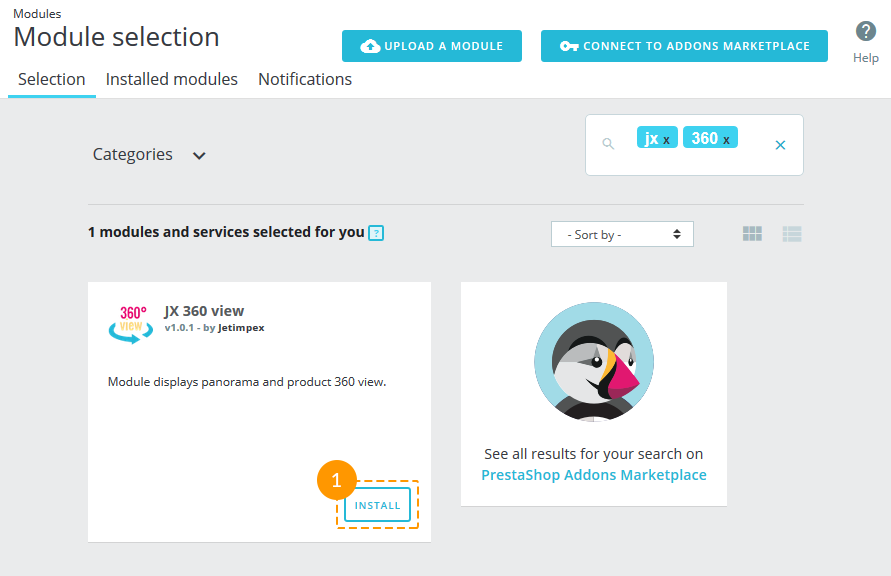
Module configuration
After the module has been successfully installed you'll see the 'Configure' page with the default module settings.
You can find here settings for 360 view (1) and for panorama view (2).
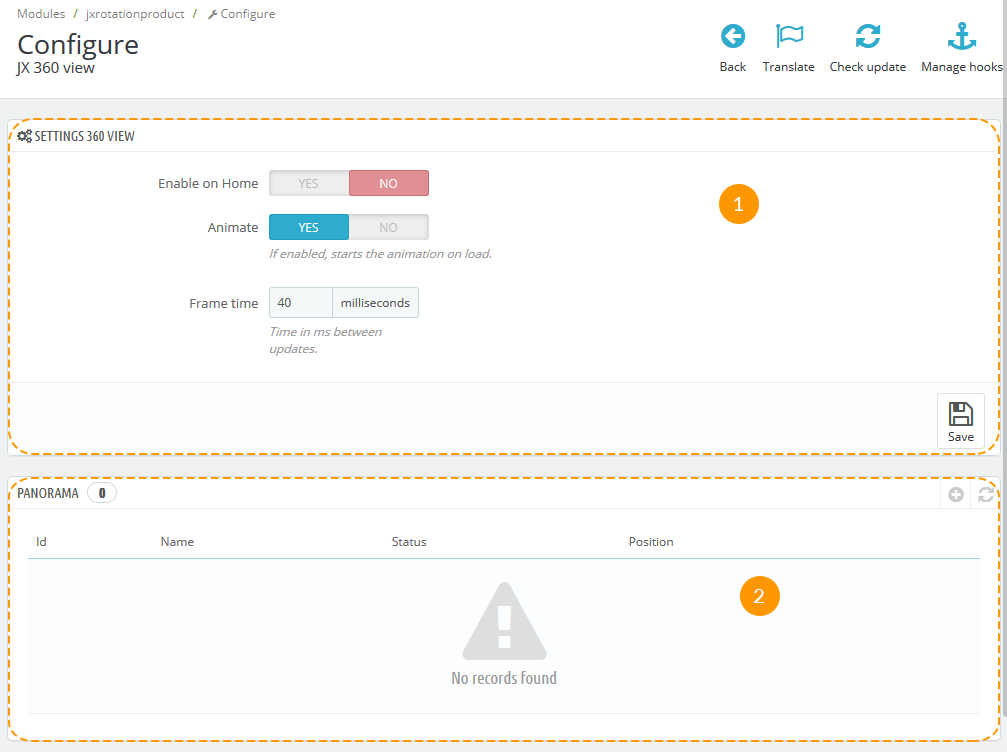
360 view
The settings are described below the screenshot. Choose them according to your needs and click the 'Save' button (1).

- Enable on Home - option to show the 360 view of the product on Homepage.
- Select a product (appears if 'Enable on Home' is set to 'Yes') - choose a product which should be displayed in 360 view.
- Animate - option to display the product automatically rotating on page load.
- Frame time (appears if 'Animate' is set to 'Yes') - time period before one image in the set will be changed to another; should be entered in milliseconds.
Adding/removing images
-
Navigate to Catalog -> Products in your admin panel (1), choose the product and click the 'Edit' button (2).
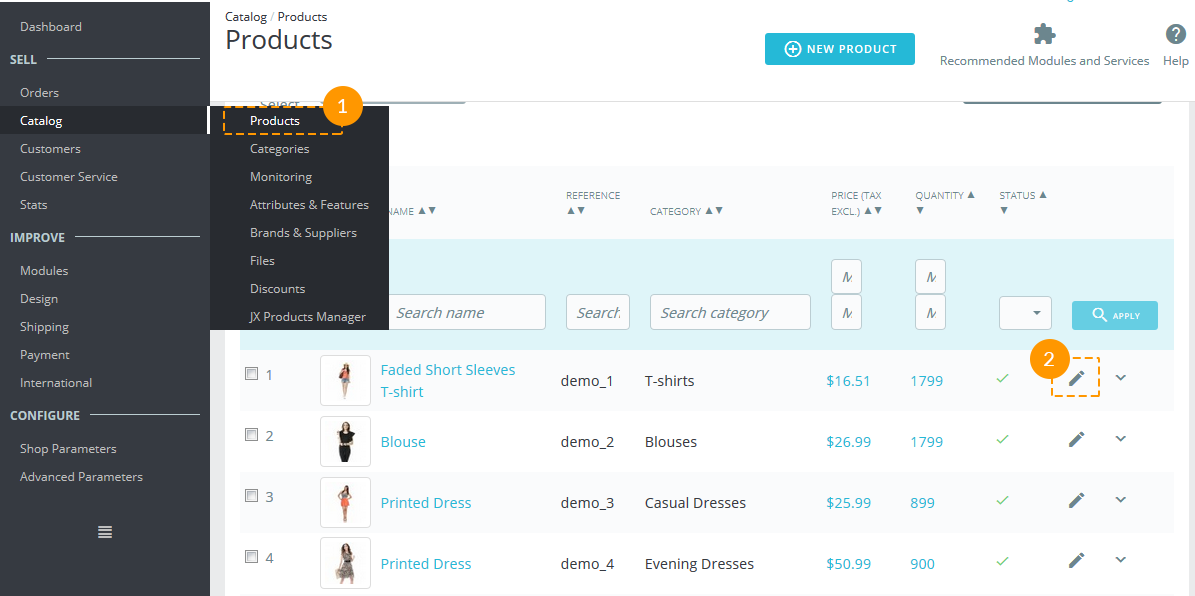
-
To add images, choose Modules tab (1) and click on the 'JX 360 view' module(2). Click 'Add files' button (3).
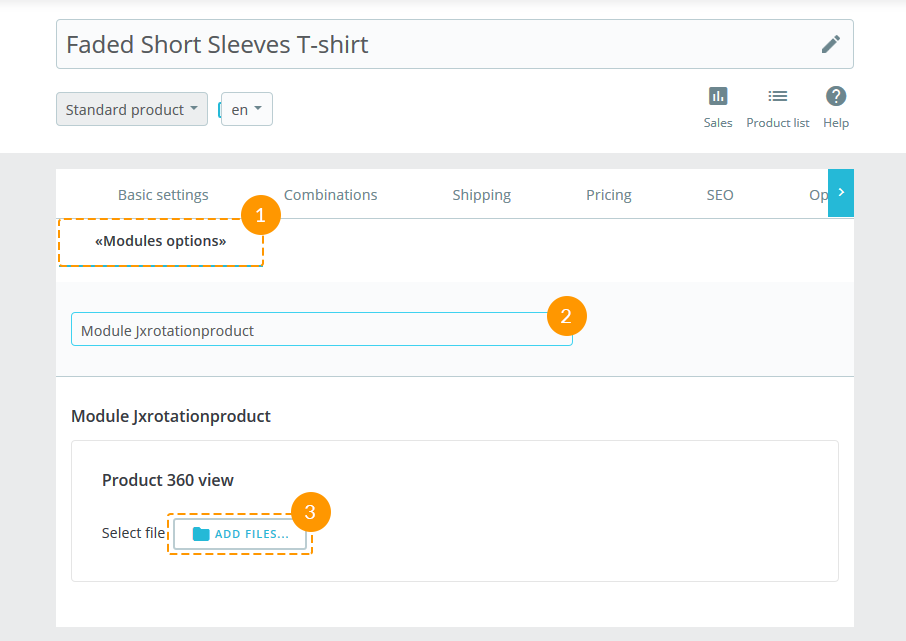
-
Then press 'Upload files' (1).
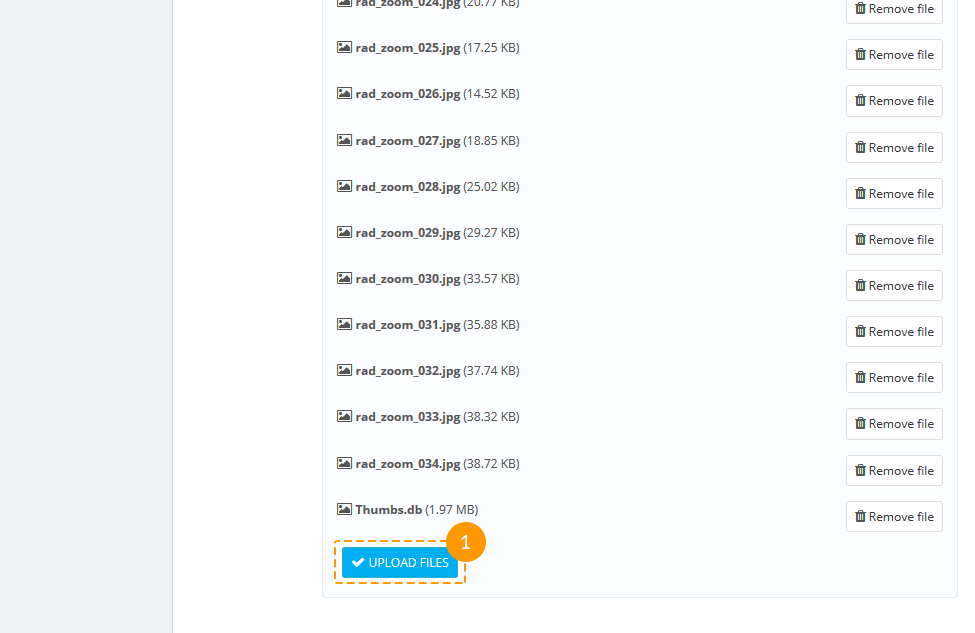
-
When the files were uploaded successfully, click the 'Save' button (1).
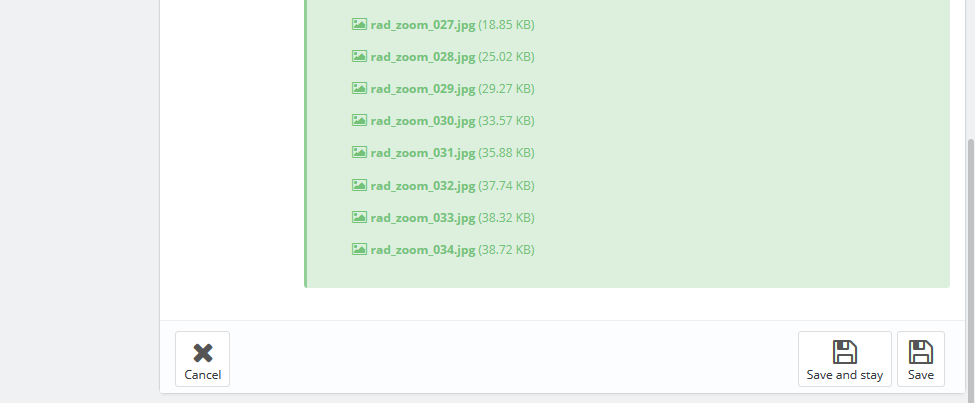
To make the rotation smooth, add more images and make a very slight change in position while making photos.
-
After you've added image pictures, the product 360 view will be shown on the Homepage *.
* It will also appear on the product page after the description. -
To disable 360 view on the Homepage, simply go to 360 view settings and switch the 'Enable on Home' option to 'No'.
-
To disable 360 view on the product page, open the 'JX 360 view' tab in product settings and remove all images.
Panorama
Using this module is also used for adding panorama view to the Homepage.
You can add as much panorama blocks as you need.
Adding panorama
-
To add new panorama open the module configuration page and click '+' ('Add new item') button (1).
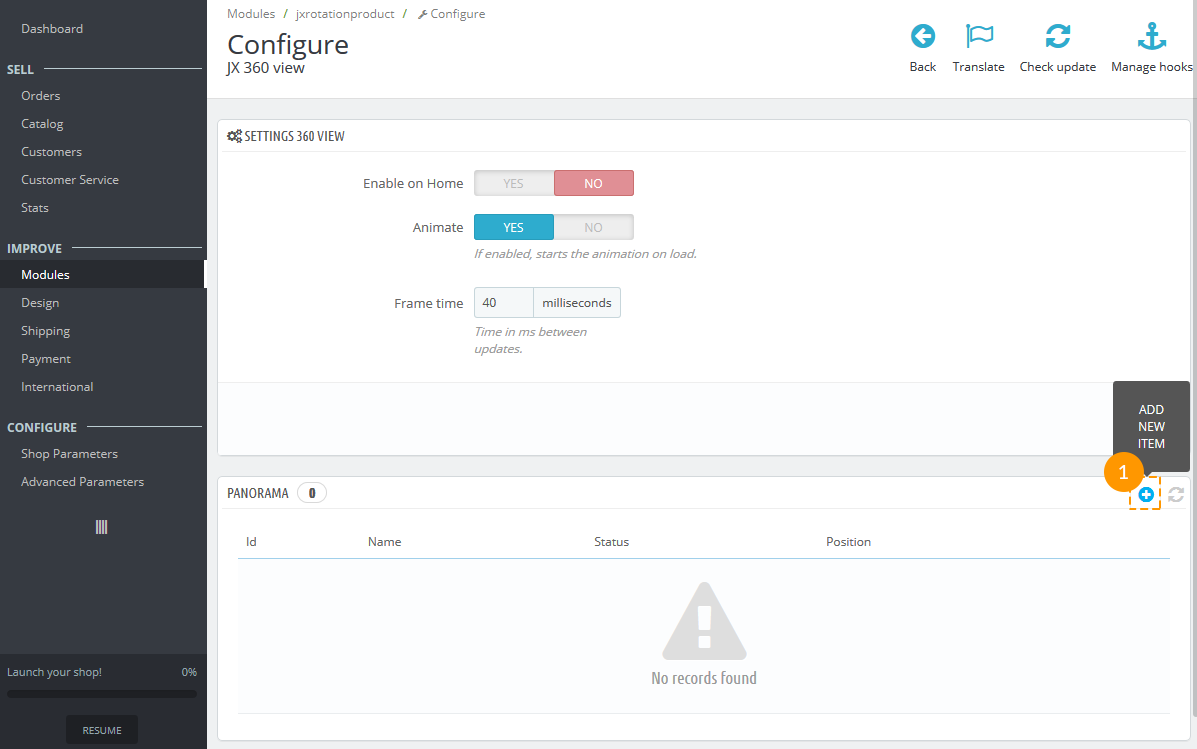
-
You'll see the panorama settings which are described below.
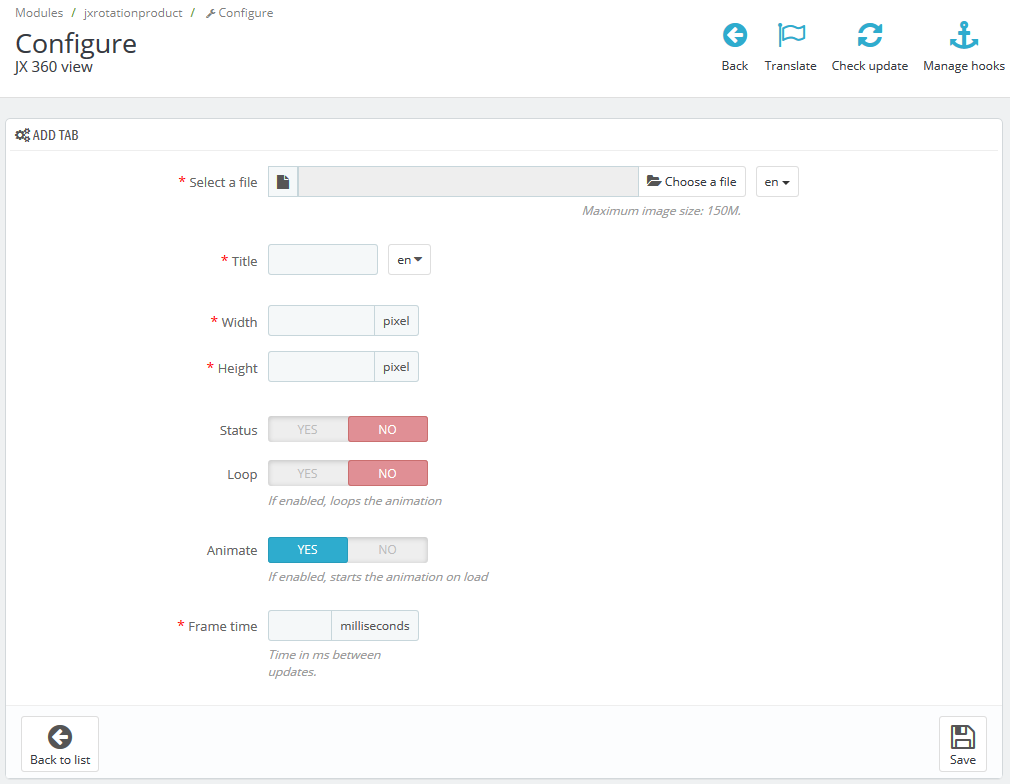
- Select a file - choose a panorama filed; this field is required (at least for the default language).
- Title - enter a title for the panorama; this field is required (at least for the default language).
- Width - panorama block width; this field is required.
- Height - panorama block height; this field is required.
- Status - enable/disable panorama item on Homepage.
- Loop - start rotating the image from the beginning after it's end.
- Animate - option to display the panorama automatically rotating on page load.
- Frame time (appears if 'Animate' is set to 'Yes') - time period during which the panorama image makes a full circle; should be entered in milliseconds; this field is required.
-
Click the 'Save' button and your panorama image will appear on the Homepage.
Removing panorama
-
To remove the panorama - choose the item, click the arrow down button (1) and then click 'Delete' (2).
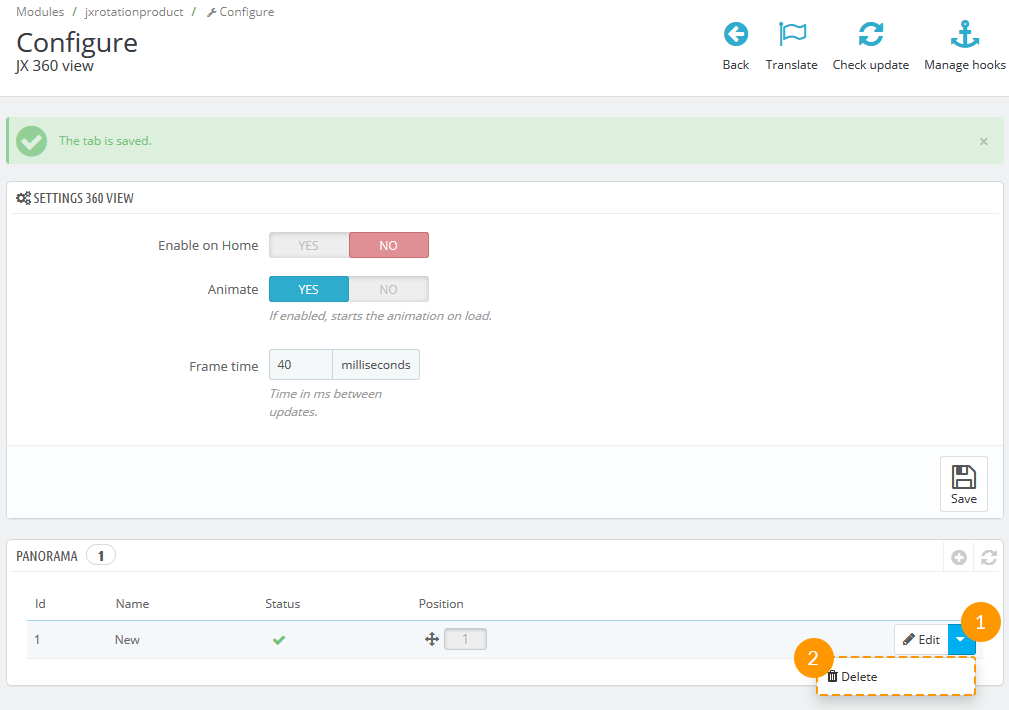
-
Then confirm the deleting.
JX Accelerated Mobile Page
AMP is an open source library that provides a straightforward way to create web pages.
The module allows improving the functionality of PrestaShop online store on mobile devices and increasing the loading speed of the web pages. It provides the opportunity to create web pages that are compelling, smooth, and load near momentary for users.
Installation and Deleting
The module can be installed and deleted like any other PrestaShop module.
SSL/HTTPS sites are preferable for Google, giving them better indexing and position in search results.
Module configuration
After the module has been successfully installed, you'll see the 'Configure' page that includes 7 tabs with the module settings.

AMP Pages Settings
You can easily create the AMP pages of the store homepage, category page, product page and others. The module will display the limited data of the pages and automatically affects the loading speed of these pages on mobile.
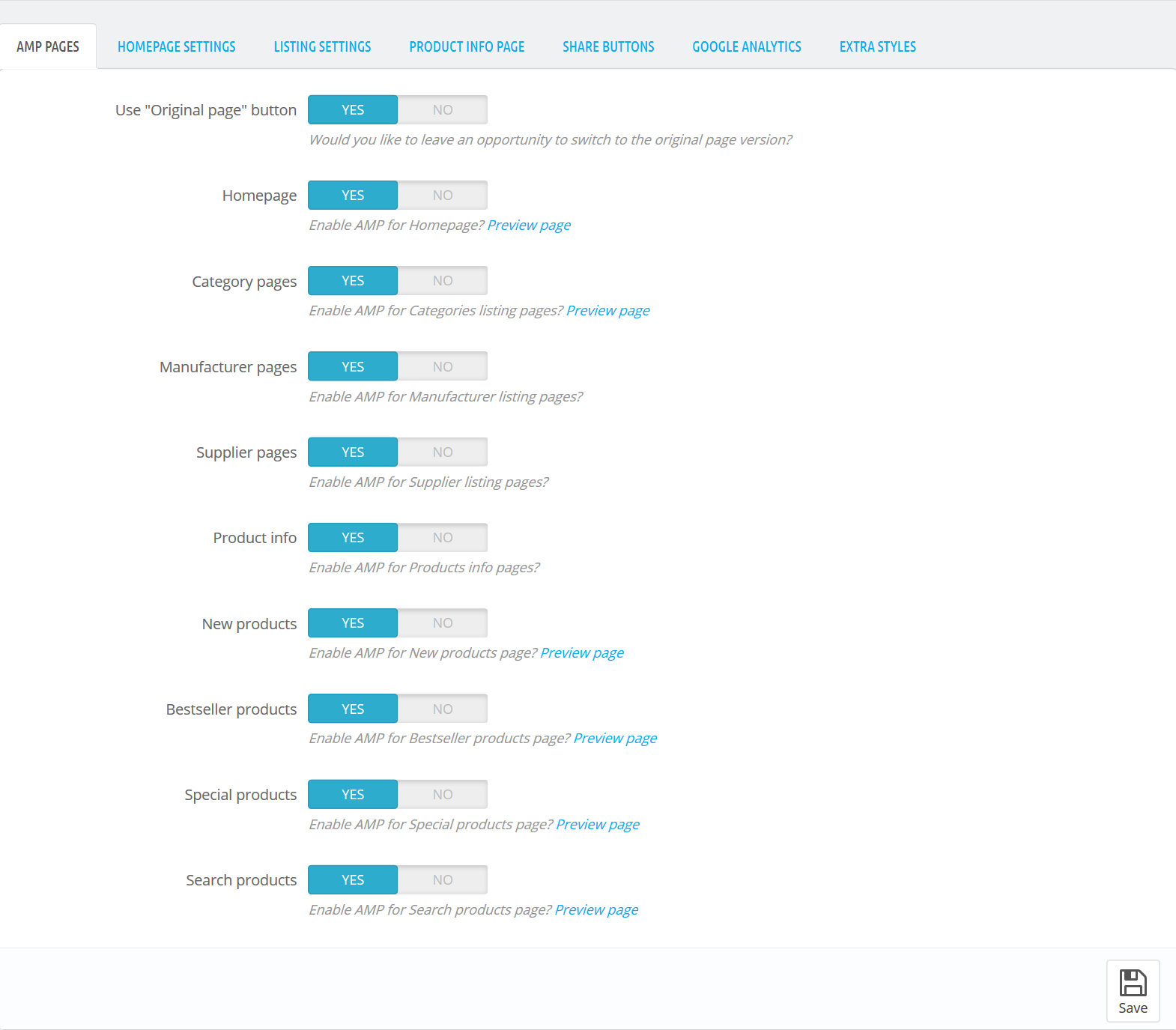
- Use "Full page" button - get back to the original view of the page.
- Homepage - enable/disable AMP for the Homepage.
- Category pages - enable/disable AMP for the Category Listing Page.
- Manufacturer pages - enable/disable AMP for the Manufacturer Page.
- Supplier pages - enable/disable AMP for Supplier Page.
- Product Info - enable/disable AMP for Product Info Pages.
- New products - enable/disable AMP for new products section on the Homepage.
- Bestseller products - enable/disable AMP for bestseller products section on the Homepage.
- Special products - enable/disable AMP for special products section on the Homepage.
- Search products - enable/disable AMP for the search by products on the Homepage.
Homepage settings
You can organize the content of the AMP Homepage according to your preferences using the available settings below.
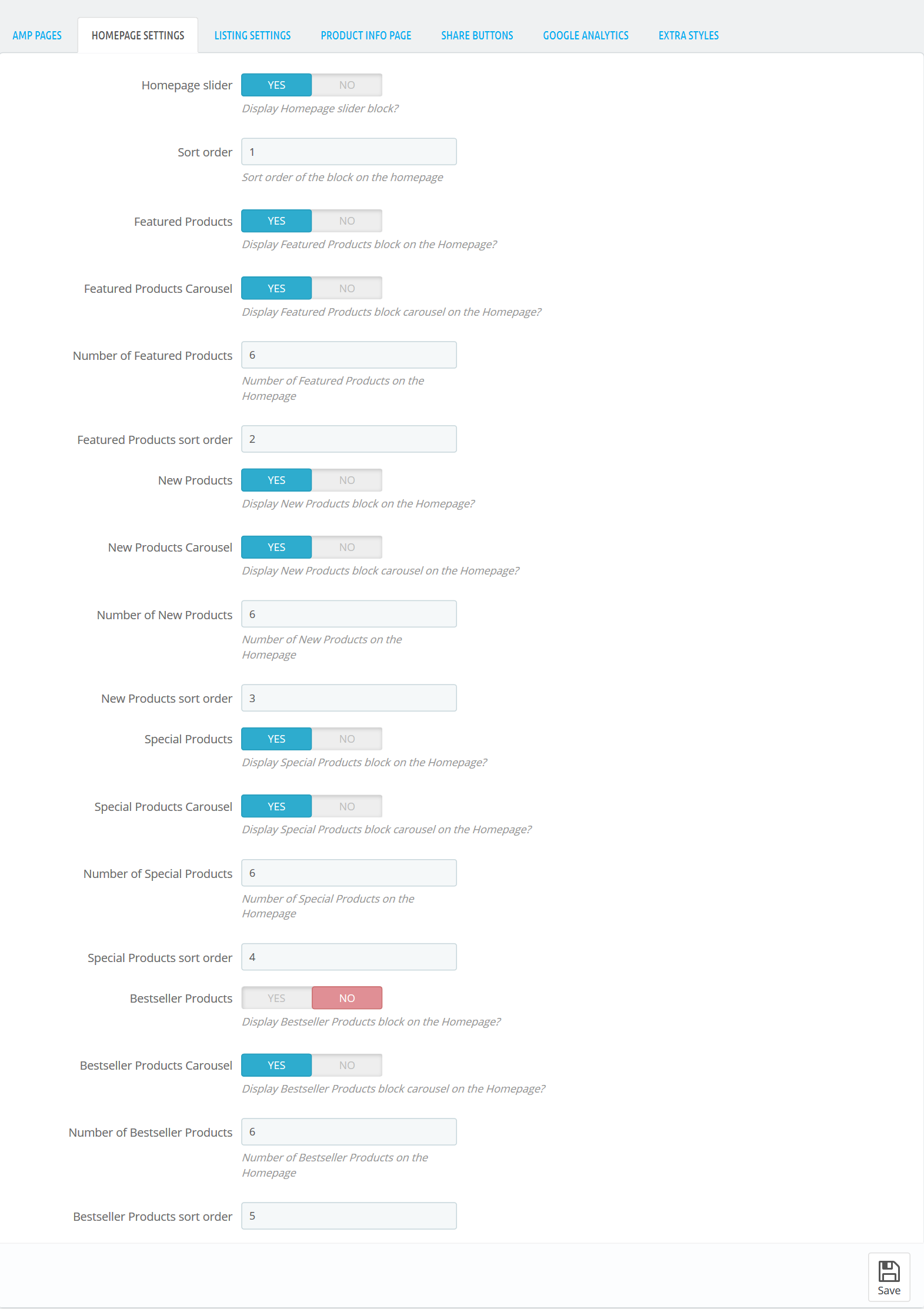
- Homepage slider - show/hide slider block on the Homepage.
- Sort order - set in what order the slider block will be displayed.
- Featured Products - show/hide the featured products block on the homepage.
- Featured Products Carousel - choose whether to display featured products block carousel on the Homepage.
- Number of Featured Products -set the number of featured products to be displayed on the Homepage.
- Featured Products sort order - set in what order the featured products block will be displayed.
- New Products - show/hide the new products block on the Homepage.
- New Products Carousel - choose whether to display the new products block carousel on the Homepage.
- Number of New Products - set the number of new products to be displayed on the Homepage.
- New Products sort order - set in what order the new products block will be displayed.
- Special Products - show/hide special products block on the Homepage.
- Special Products Carousel - choose whether to display special products block carousel on the Homepage.
- Number of Special Products - set the number of special products to be displayed on the Homepage.
- Special Products sort order - set in what order the special products block will be displayed on the Homepage.
- Bestseller Products - show/hide bestseller products block on the Homepage.
- Bestseller Products Carousel - choose whether to display bestseller products block carousel on the Homepage.
- Number of Bestseller Products - set the amount of the bestseller products that will be displayed on the Homepage.
- Bestseller Products sort order - set in what order the bestseller products block will be displayed on the Homepage.
Listing Settings
Organize the additional AMP listing settings.
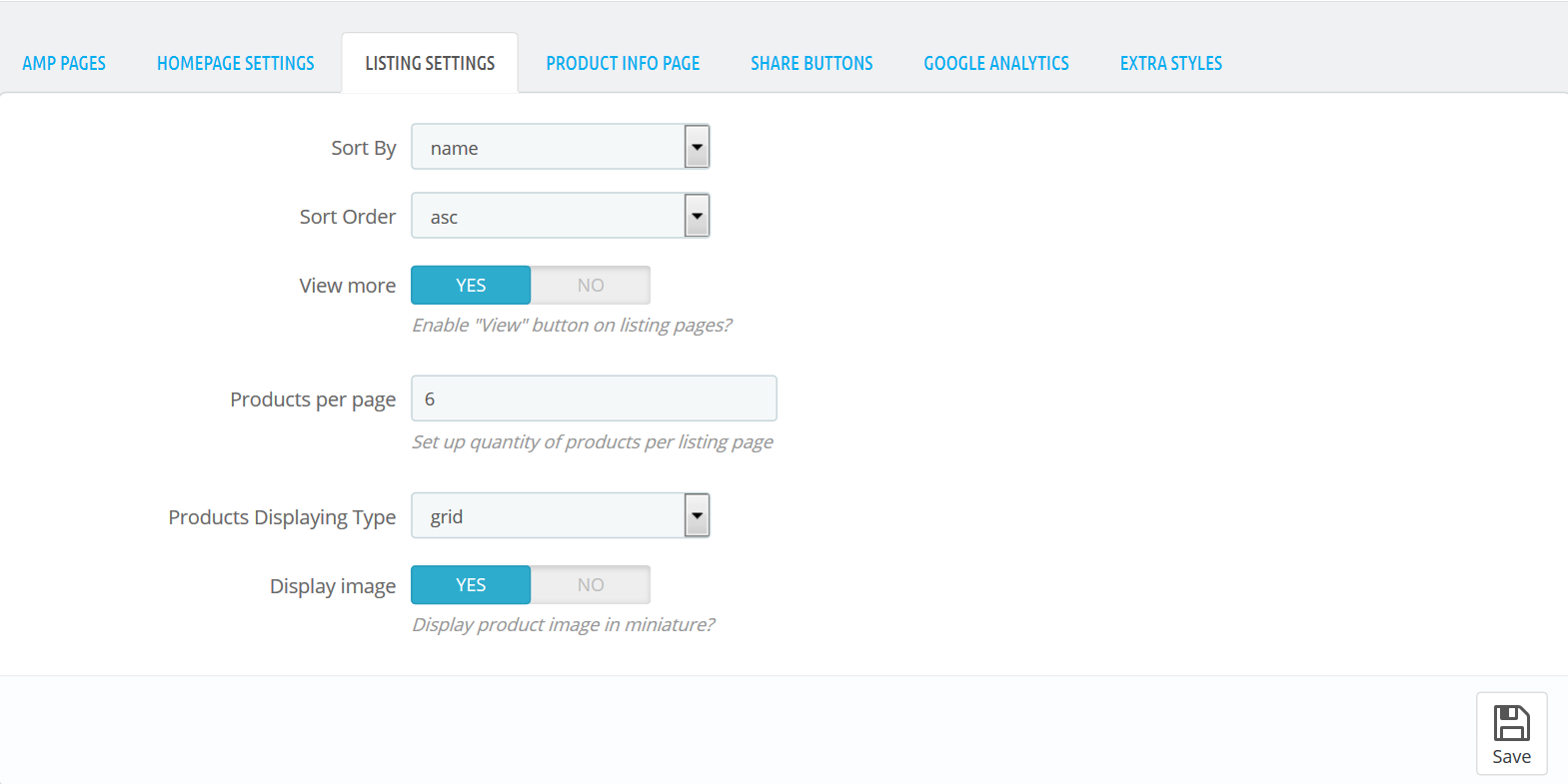
- Sort by:
- name - sort the products by their names;
- position - sort the products by their position;
- price - sort the products by the price.
- Sort Way:
- asc - sort the products in ascending order;
- desc - sort the products in descending order.
- View more - enable/disable the "Read more" button on the listing page.
- Products per page - set the quantity of the products per listing page.
- Products Displaying Type:
- list - present products vertically as a single continuous element.
- grid - present products in the form of the repeated pattern of cells arrayed vertically and horizontally.
- Display image - show/hide product image in miniature.
Product Info Page
You can set some additional settings for AMP Product Info Page.

- Extra images - display products' extra images on the product info page.
- Share buttons - enable/disable the share buttons (Facebook, Google+, Pinterest, Twitter).
Share Buttons
You may activate social share buttons on AMP pages in order to set social media sharing options on the product page.
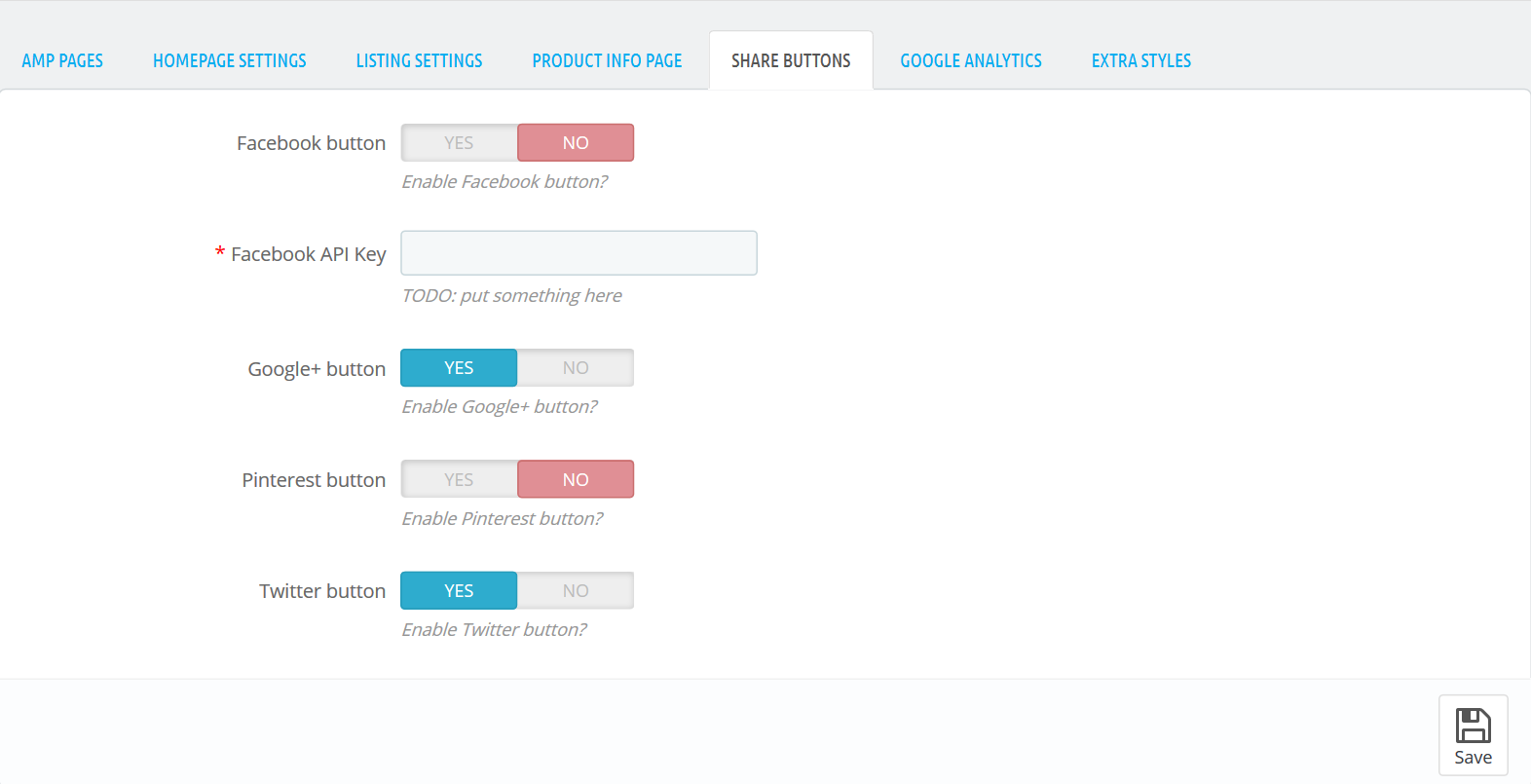
- Facebook button - enable/disable Facebook button.
- Facebook API Key - enter your Facebook API Key.
- Google+ button - enable/disable Google+ button.
- Pinterest button - enable/disable Pinterest button.
- Twitter button - enable/disable Twitter button.
Google Analytics
Make your accelerated mobile pages trackable by enabling Google Analytics.

- Status - enable/disable Google Analytics script.
- Google Analytic Key - enter your Google Analytics ID.
Extra Styles
Allows adding custom CSS styles.

- Main background color - the value can be set in any color format (rgb, hex, etc.). You can choose the color using the Color Picker tool.
JX Advanced Filter
Introduction
JX Advanced Filter module gives an opportunity to implement a quick search of the needed product based on key features. It allows creating filters with the unlimited number of search criteria, which are available in the store by default or are created when adding the products.
Filter criteria can be the following: levels of categories (by nesting), manufacturers, suppliers, attributes, features, and more. Also, the module has the following features: creating connected filters, in which needed criteria become available only after selecting the parent parameter (nesting level is unlimited); selecting the filter criteria grid for the top page filter. You can select the filter field type from the available, specify the parent filter, add its name, label, and description. All is easily set up and edited in the user-friendly admin panel. For the better speed, the module uses the products indexation algorithm by the set criteria. It can be easily and quickly inserted into a PrestaShop store of any kind.
Installing and deleting the module
The module is installed and deleted like any other PrestaShop module.
After deleting or reinstalling the module, all the module settings and filters will be discarded.
Filter setup/editing
After installing the module, you can set it up on the module configuration page. By default, you'll see the tabs with available filter types. To start creating a filter, select a tab (1) and press the 'Create filter' button (2).

In the appeared filter window, fill in all the needed fields.
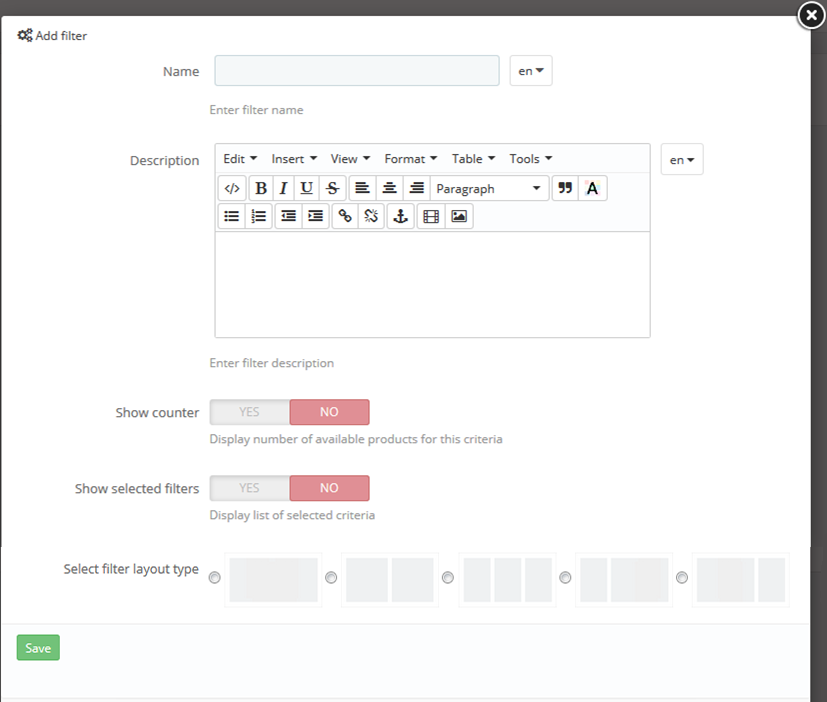
- Name - the name of the filter. It'll be displayed on the frontend as the filter block title;
- Description - the filter description. It'll be displayed on the frontend next to the filter block title;
- Show counter - allows displaying the number of products that will be available after selecting the current parameter. The number will be displayed next to the search criterion (in brackets);
- Show selected filters - allows displaying the list of the selected search criteria with the ability to unselect any of them;
- Show filter layout type - selecting filter grid (available only for the Top Filter);
Please note that there are no required fields. If you leave all the fields empty, then a one-column filter with no description and title will be created.
Editing the filter
To change the description and filter settings, press the 'Cogwheel' button in the filter menu.

In the editing mode, the form looks and works as in the setup mode.
The filter grid selection is available only for 'Top filter'.
When changing the filter grid, all the elements will be automatically transferred to the first column, keeping the nesting and display order (based on the principle: all elements of the previous column with the display order kept inside).
Deleting the filter
To change the filter description or filter settings, press the 'Cross' in the filter menu

and confirm filter deletion.
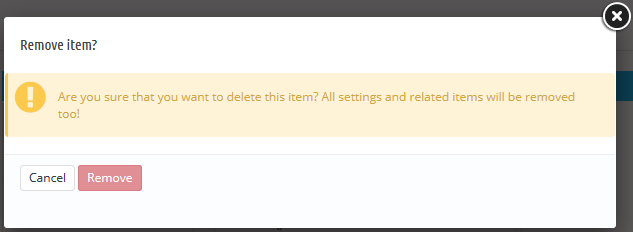
Filter indexation
Indexation - the process of creating unique tables with the data necessary for the filter, which is created for the filter-specific criteria. They allow to drastically speed up the filter work on the frontend.
The corresponding button in the filter menu is highlighted in red. If the button is not highlighted, the filter doesn't need indexation.

The re-indexation process can take some time, depending on the number of products in the store and selected filter criteria.
If the filter requires re-indexation, it won't be displayed on the frontend.
Creating/editing filter elements (criteria)
To add an element to the filter, select it in the panel of available elements (on the left) and drag it to the available area of the filter grid (it will light up after being selected. In the example, the grid has 2 columns).
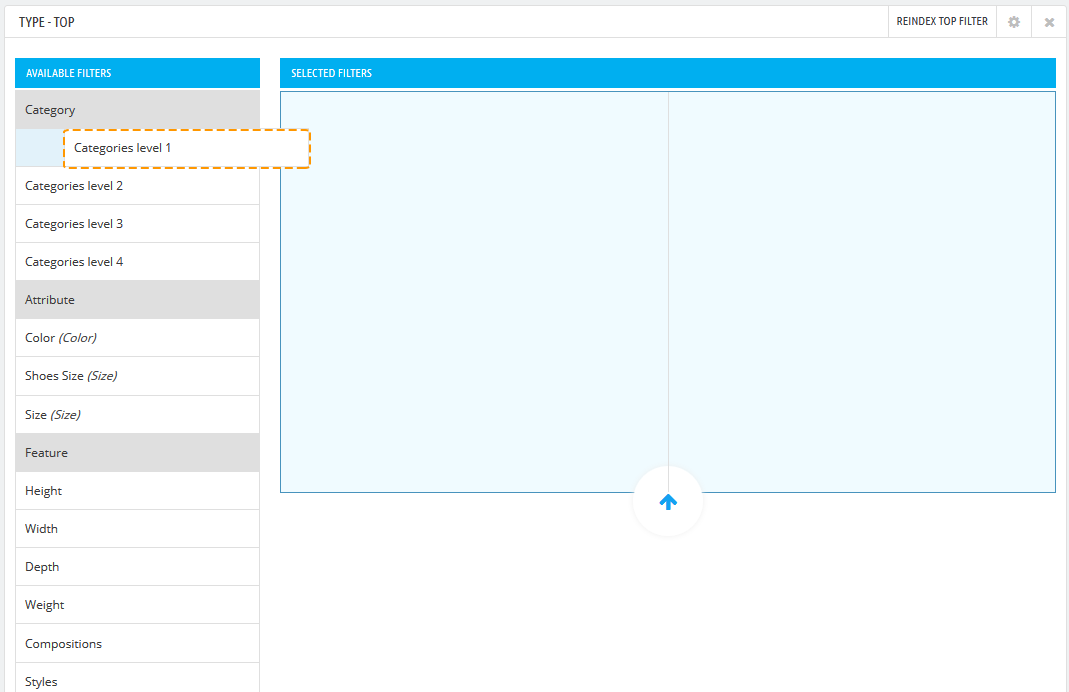
In the highlighted area select the column and position of the new element and drop the element.
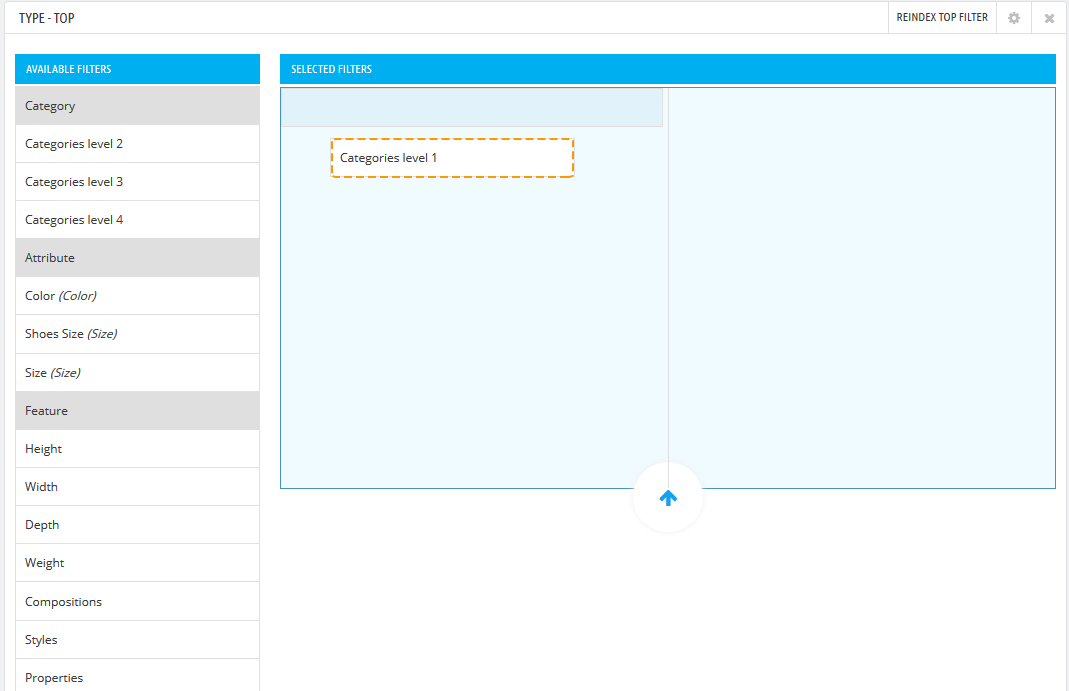
In the appeared element creation window, supply all the necessary data:
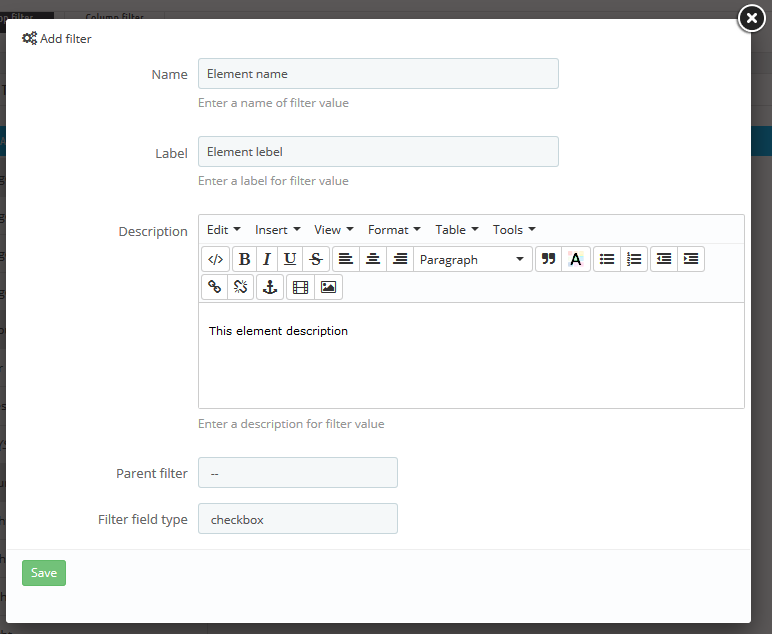
- Name - the name of the filter element on the frontend. It won't be displayed, if you leave the field empty.
- Label - the label of the filter element on the frontend. It won't be displayed, if you leave the field empty.
- Description - the filter element description on the frontend. It won't be displayed, if you leave the field empty.
- Parent filter - the filter parent element, after selecting which this element will be available. The element will be always available if the field is left empty.
- Filter field type - the way the element will be displayed on the frontend. The following types
are available:
- radio
- select
- checkbox
- range-select (only for the 'price' field type)
- range-input (only for the 'price' field type)
You can change all the data and the parent element in the filter editing mode.
After editing the element, the filter should be re-indexed, which is shown by the button in the filter menu. Do not go for reindexing the filter after editing every element, you can do this after applying changes to all the needed elements - by doing so you'll save your time.
If there is a tree of connected filters, you can add the new element as a related to this tree.
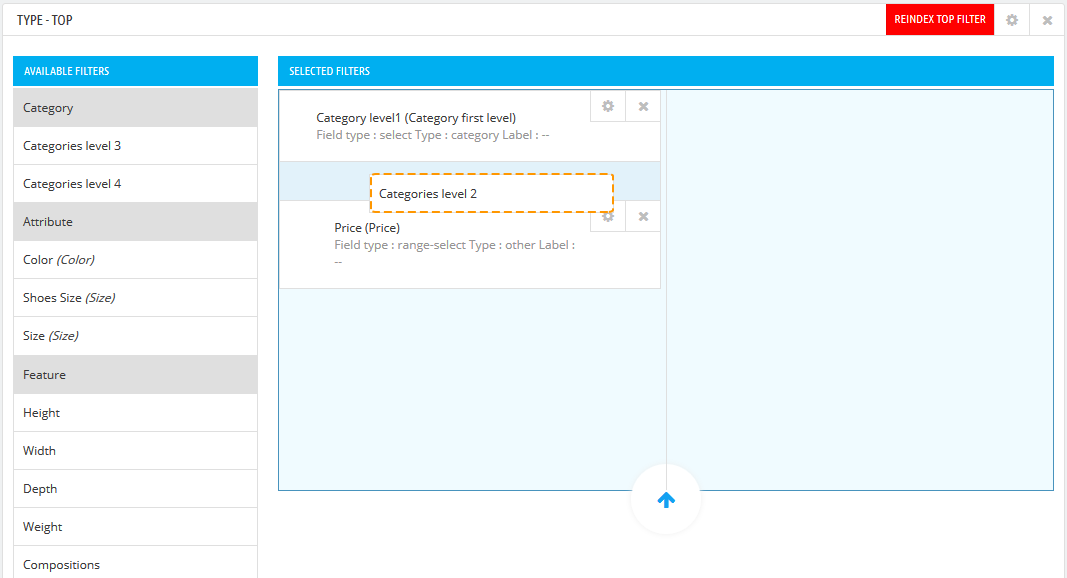
Editing the filter element
To edit a filter element, press the 'Cogwheel' button (1) in the filter upper right corner.

Sorting (display order of the filter elements)
By default, the new elements are displayed after the element in the order you've added them. If the filter is added to the tree, it'll be displayed after the existing elements in the tree.
To move the elements inside the filter, select the needed element and drag it to the needed position. You can drag elements in one column, as well as to another grid columns. You can also change the sorting inside the tree, or move the whole tree at once.
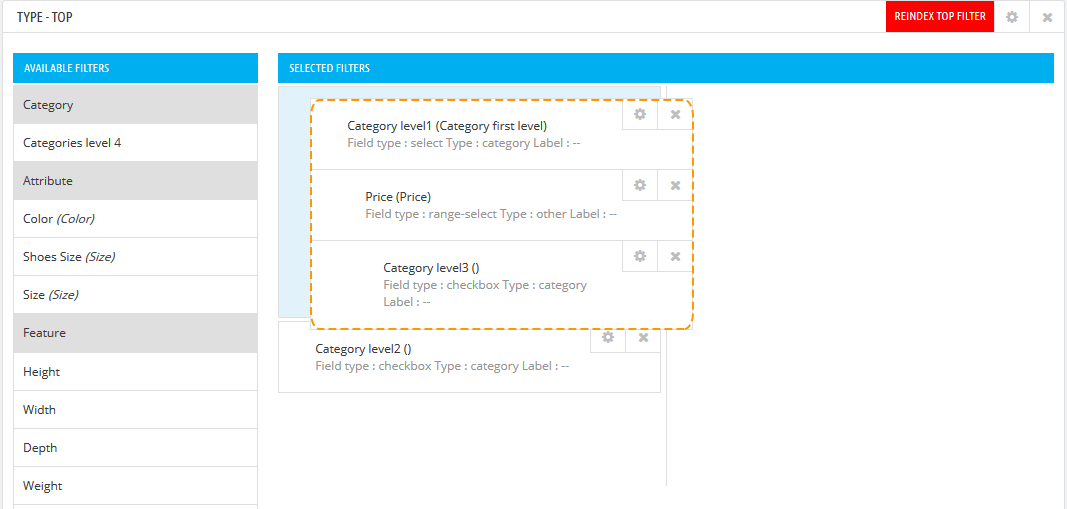
After moving the element from one column to another, the display order will change automatically in all columns.
Deleting the filter element
You can delete a filter element in two ways:
drag the element back to the column of available elements;
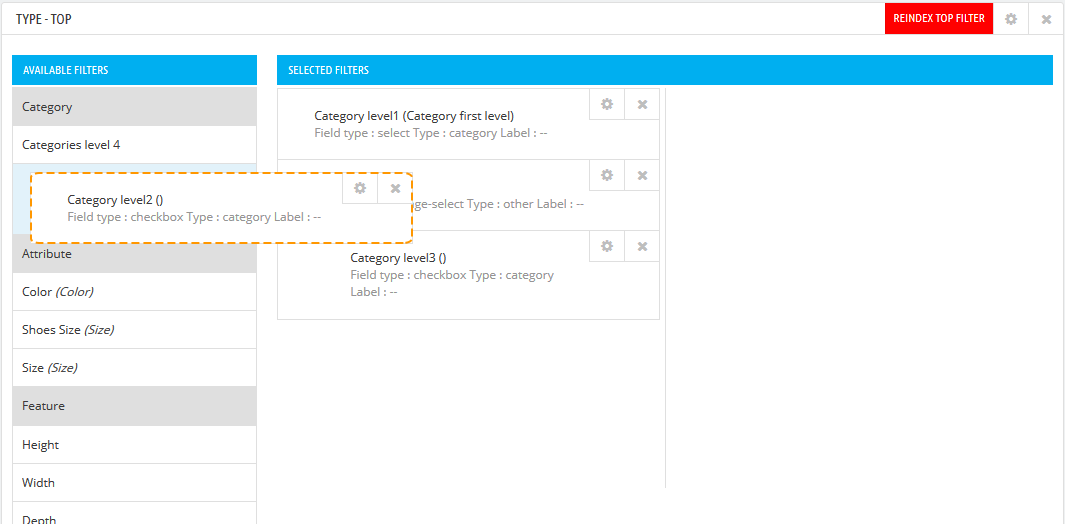
or press the 'Cross' in the upper right corner of the needed element.

Regardless of the chosen method, you'll see a window of deleting confirmation.
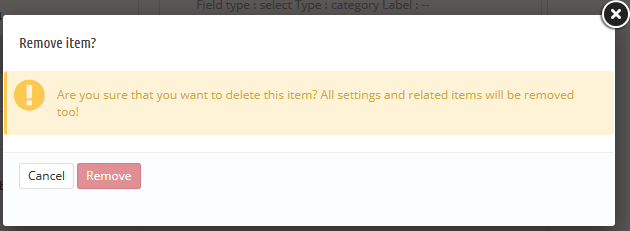
After deleting a filter with nested elements, all the nested elements will be deleted.
After deleting an element, the filter needs to be re-indexed, what is indicated by the button in the filter menu. Do not go for reindexing the filter after editing every element, you can do this after applying changes to all the needed elements - by doing so you'll save your time.
"Smart" reindexation
The module provides the automatic (smart) reindexation after making changes to the products or after some other crucial changes (manufacturer, attribute, etc.). The table fields will be reindexed if these changes affected the filter functioning.
If, after making changes, the filter did not take them automatically, enter the filter settings page and reindex it manually.
The filter won't be reindexed automatically after adding currency, that's why it should be reindexed manually.
FAQ
- I've created a filter, but I don't see it on the frontend.
- I've added the filter name and description, but they are not displayed on the frontend.
- I've added elements to the filter, but it stopped displaying on the frontend.
- I want the element to be available only after another element is selected.
- I want to swap elements.
- I want to delete a parent element, but want to keep all the nested elements. How to achieve this?
- I want to change the filter grid, but I don't want to create the filter again. What can I do?
- How to create a completely new filter, if there is already a filter for this position?
- The filter stopped displaying on the frontend.
- Why not all the elements are active on the frontend?
Make sure that there are elements in the filter and that it has been reindexed.
JX Blog
Introduction
JX Blog module allows creating a blog in your PrestaShop store in order to inform or educate the customers with helpful innovative content for your eCommerce website. You can write creative posts of new arrivals, future collections and accompany them with entertaining images; publish your posts right away or plan them to go live later.
JX Blog is the main module that contains the general settings for blog functionality.
There are additional JX Blog modules used to make the blog more functional:
-
- JX Blog Comment module
- improves the main JX Blog module with powerful comments system. It is used to display and manage the comments added to the Blog posts.
The module is compliant with official PrestaShop General Data Protection Regulation (GDPR) module, a new EU legal framework that governs how users' personal data is used.
-
- JX Blog Post Posts module
- allows binding related posts to a post.
-
- JX Blog Post Products module
- allows binding related products to posts.
-
- JX Featured Posts module
- allows defining and setting posts as featured on the homepage of your store.
Installation of the module
The module can be installed like any other PrestaShop module.
When the module has been successfully installed, the JX Blog menu tab will appear in the main menu of your admin panel.
There you can add/remove/edit categories and posts, manage the main settings of the blog.

Categories
In order to create a blog post, firstly, it is necessary to create at least one category.
-
In your PrestaShop admin panel, in JX Blog section at the bottom, choose Categories menu (1). To create a new category, press the 'plus' (2) button in the top right corner of the category panel.
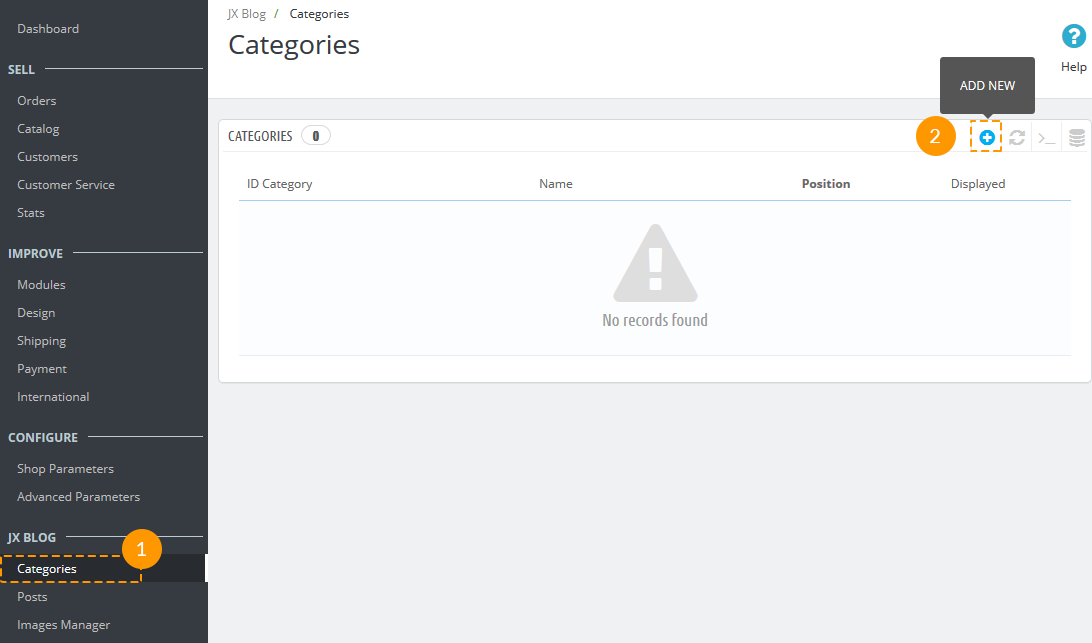
-
In the appeared form, you'll see the following options:
Name - the name of the blog category (mandatory).
Friendly URL - the blog category friendly url that will be used as a link to the category in the "Friendly URL" mode (mandatory).
Short description - brief description of the blog category.
Full description - ample description of the blog category.
Meta Keywords - keywords that will be used by search engines for better SEO optimization.
Meta Description - description of your blog category used by search engines for better SEO optimization.
Image - upload the image from your computer.
Image thumbnail - upload a smaller version of the blog category image.
Group access - custom groups that can have the access to this category.
Badge - enter the badge which will unify the category on the list.
Status - enable/disable the category.

-
Click the 'Save' button and your category will appear in the list of available categories.
In order to make changes to category, click the 'Edit' (1) button. In order to remove the category, click the 'Delete' (2) button below the 'Edit' button.

Posts
-
In your admin panel, under JX Blog section, choose Posts menu (1). To create a new post, press 'plus' (2) button in the top right corner.
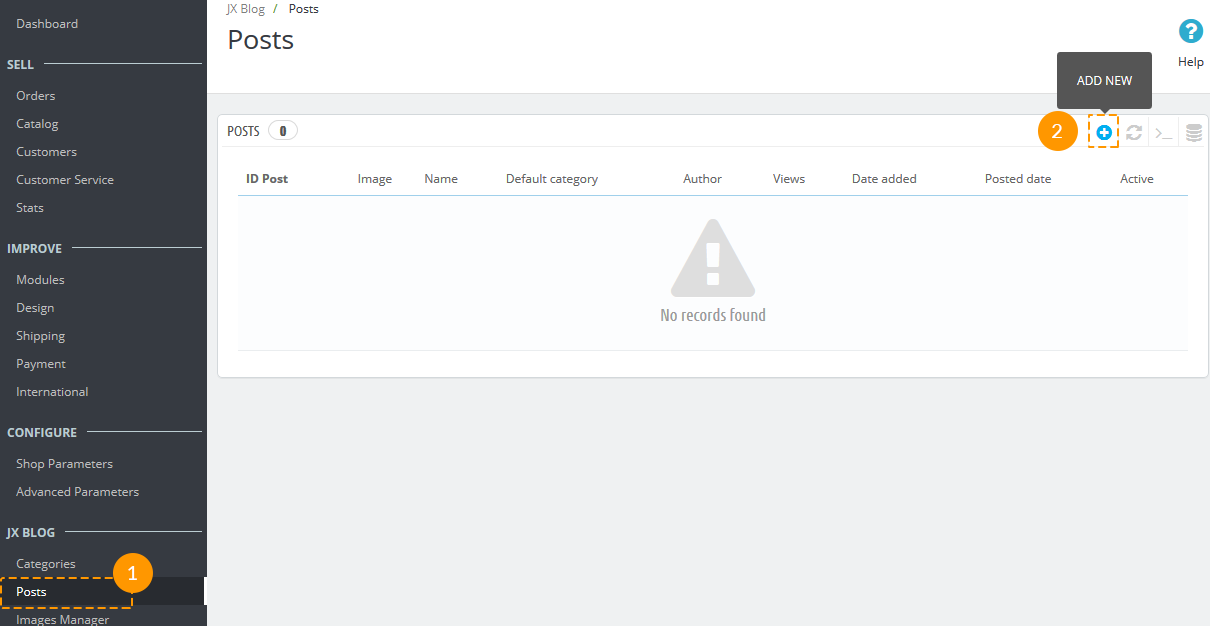
-
Set the following options in the form that appears:
Post name - the title of the post (mandatory).
Friendly URL - the blog category friendly url that will be used as a link to the category in the "Friendly URL" mode (mandatory).
Short description - brief description of the blog category.
Full description - ample description of the blog category.
Meta Keywords - keywords that will be used by search engines for better SEO optimization.
Meta Description - description of your blog category used by search engines for better SEO optimization.
Post image - upload the image of the post (only .jpg format is allowed).
Post thumbnail - upload the smaller version of the blog post image (only .jpg format is allowed).
Status - enable/disable the post.
Associated categories - the category, your post will be associated to (mandatory).
Post tags - post tags to be included.
Publishing date - specify the publishing date of the post.
Related posts - add the related posts.
Related products - add the related products.
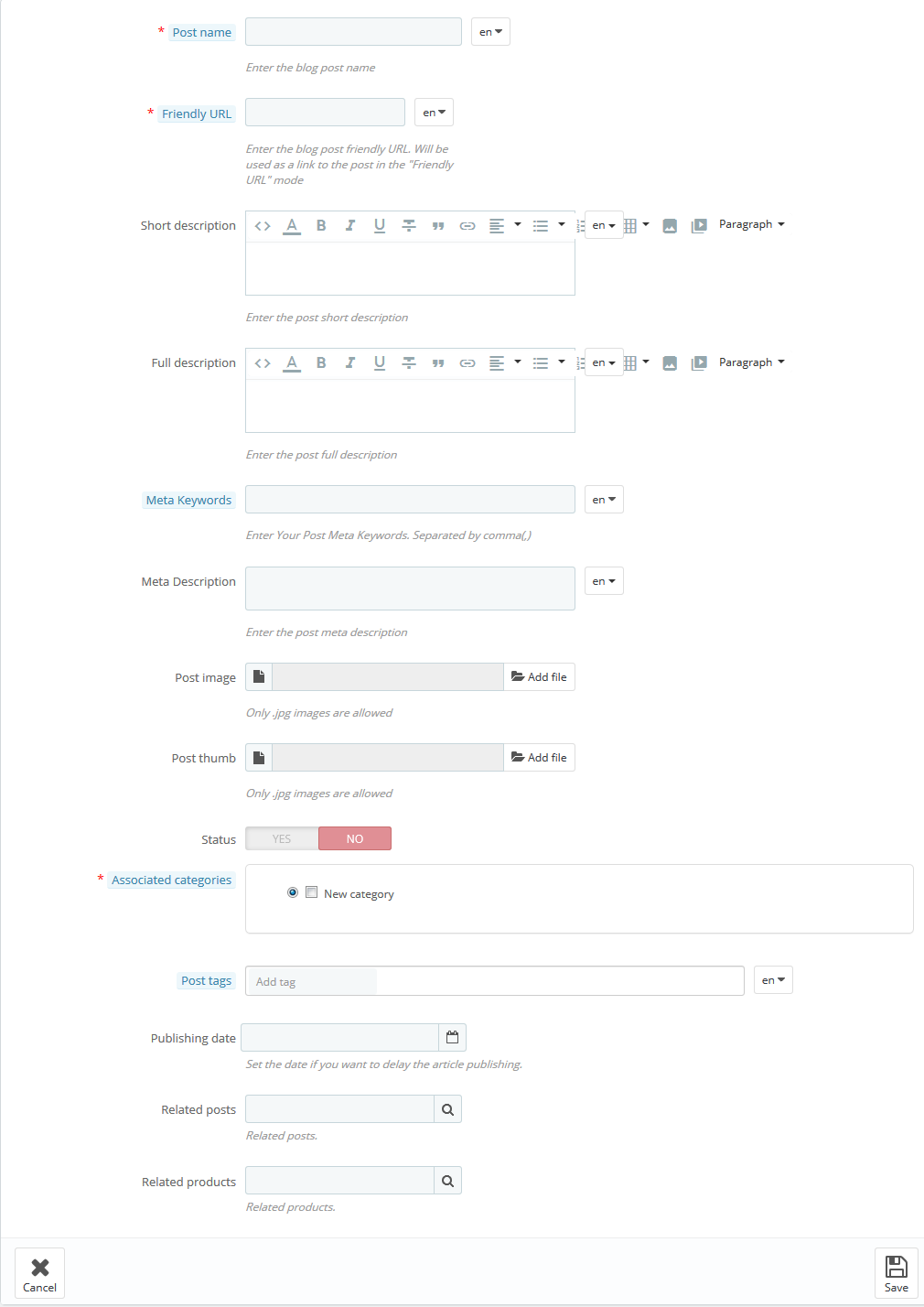
-
Click the 'Save' button to save the settings. Now, your newly created post will appear in the list of posts.
If you need to make some changes with the post, click the 'Edit' button (1) next to the needed post. To remove the post, click the 'Delete' (2) button.

Featured Posts
-
In your admin panel, under JX Blog section, choose Featured Posts menu (1). To create a new post, press 'plus' (2) button in the top right corner.
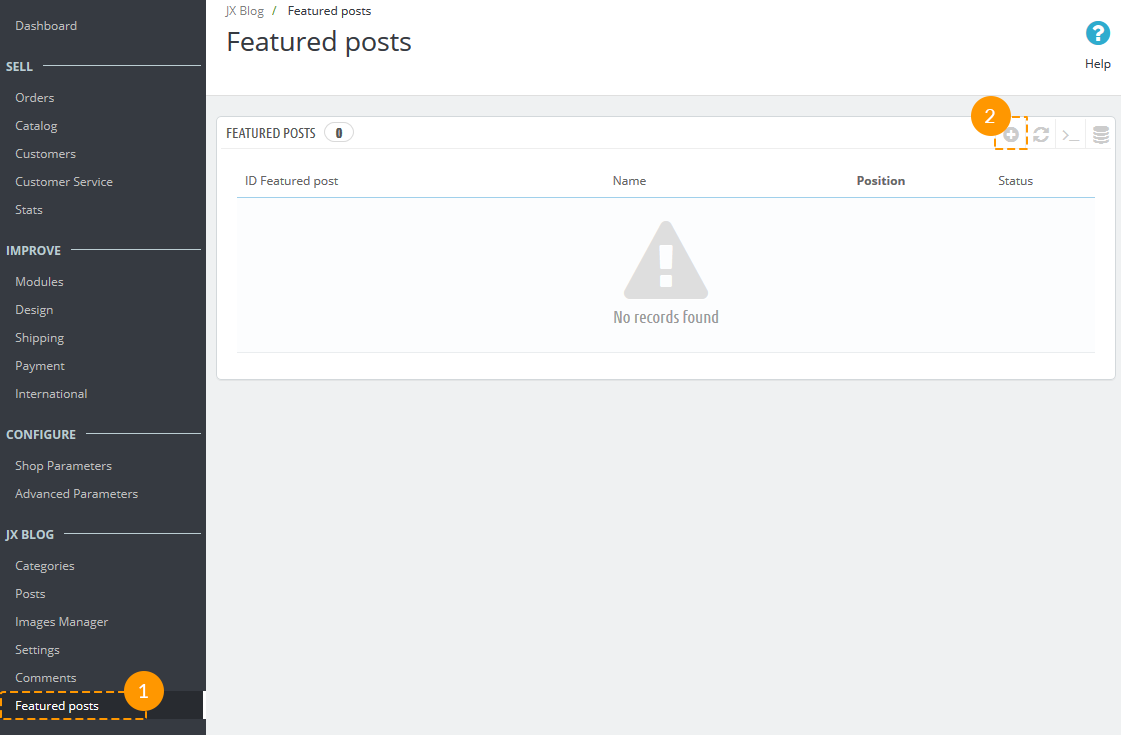
-
Set the following options in the form that appears:
Select post - choose the post(s) to be featured.
Set item position - choose the position of the featured posts on the homepage.
Status - enable/disable the featured posts.
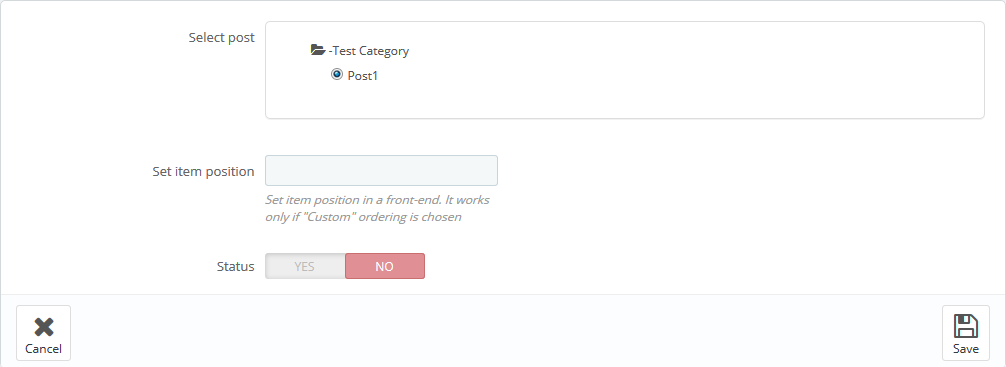
-
Click the 'Save' button to save the settings. Now, the chosen posts will appear in the list of featured posts on the Homepage.
If you need to make some changes with the featured post, click the 'Edit' button (1) next to the needed post. To remove the post, click the 'Delete' (2) button.

Images Manager
If you need to optimize website images or upload image files for your blog, in JX Blog section go to 'Images Manager' (1) section.
In Images Manager (1) section you may add additional image types with specific dimensions that will be used in your blog posts and customize them according to your needs.
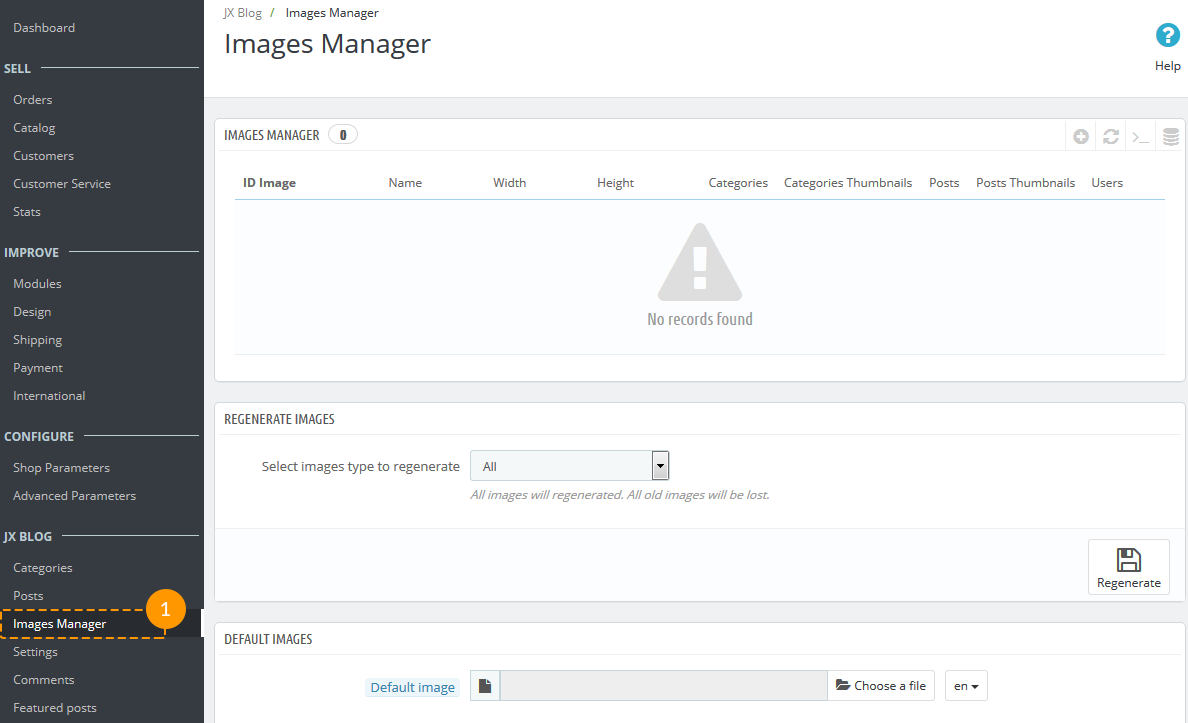
To add a new image type, press 'plus' (1) button in the Images Manager section.
Set the following options:
Name - the title of the image type (mandatory).
Width - image type width in pixels (mandatory).
Height - image type height in pixels (mandatory).
Categories - enable/disable this type for Blog categories images.
Categories Thumbnails - enable/disable this type for Blog categories thumbnails images.
Posts - enable/disable this type for Blog posts images.
Post Thumbnails - enable/disable this type for Blog posts thumbnails.
Blog users - enable/disable this type for not registered Blog users.
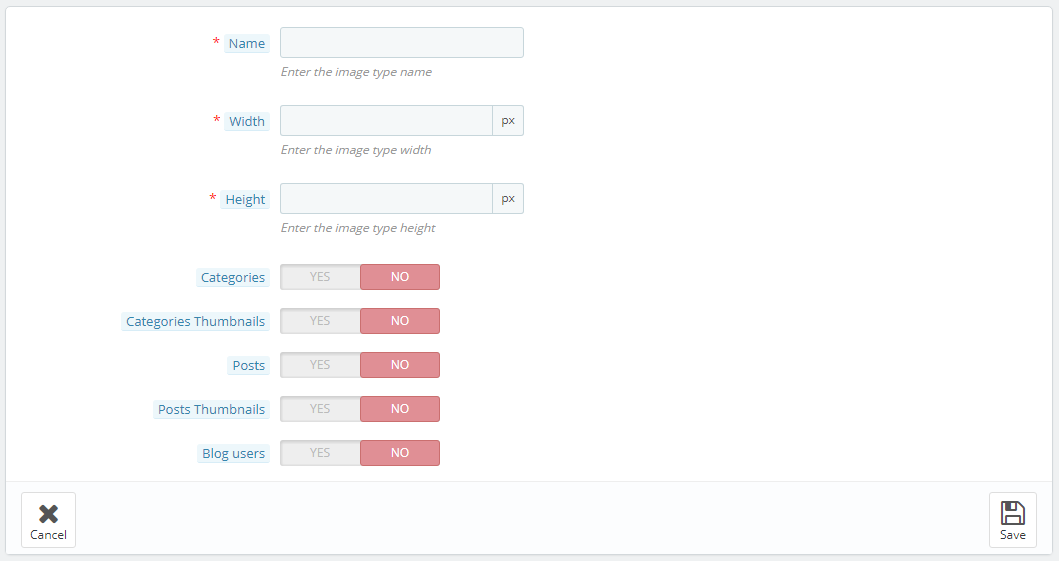

Regenerate Images
In Regenerate images section you can generate new sizes for all previously uploaded images or you can choose the particular type of the images you want to generate from the drop-down list.

Default Images
In Default Images section, you may set the following settings:
Default image - upload default image.
Categories default image - upload default image for categories.
Categories thumbnails default image - upload default image for categories thumbnails.
Post default image - upload default image for posts.
Post thumbnail default image - upload default image for posts thumbnails.
Users default image - upload default image for users.
Administrator icon - upload the administrator icon that will be displayed in the comments.
Registered users icon - upload the icon for registered users that will be displayed in the comments.
Unregistered users icon - upload the icon for unregistered users that will be displayed in the comments.
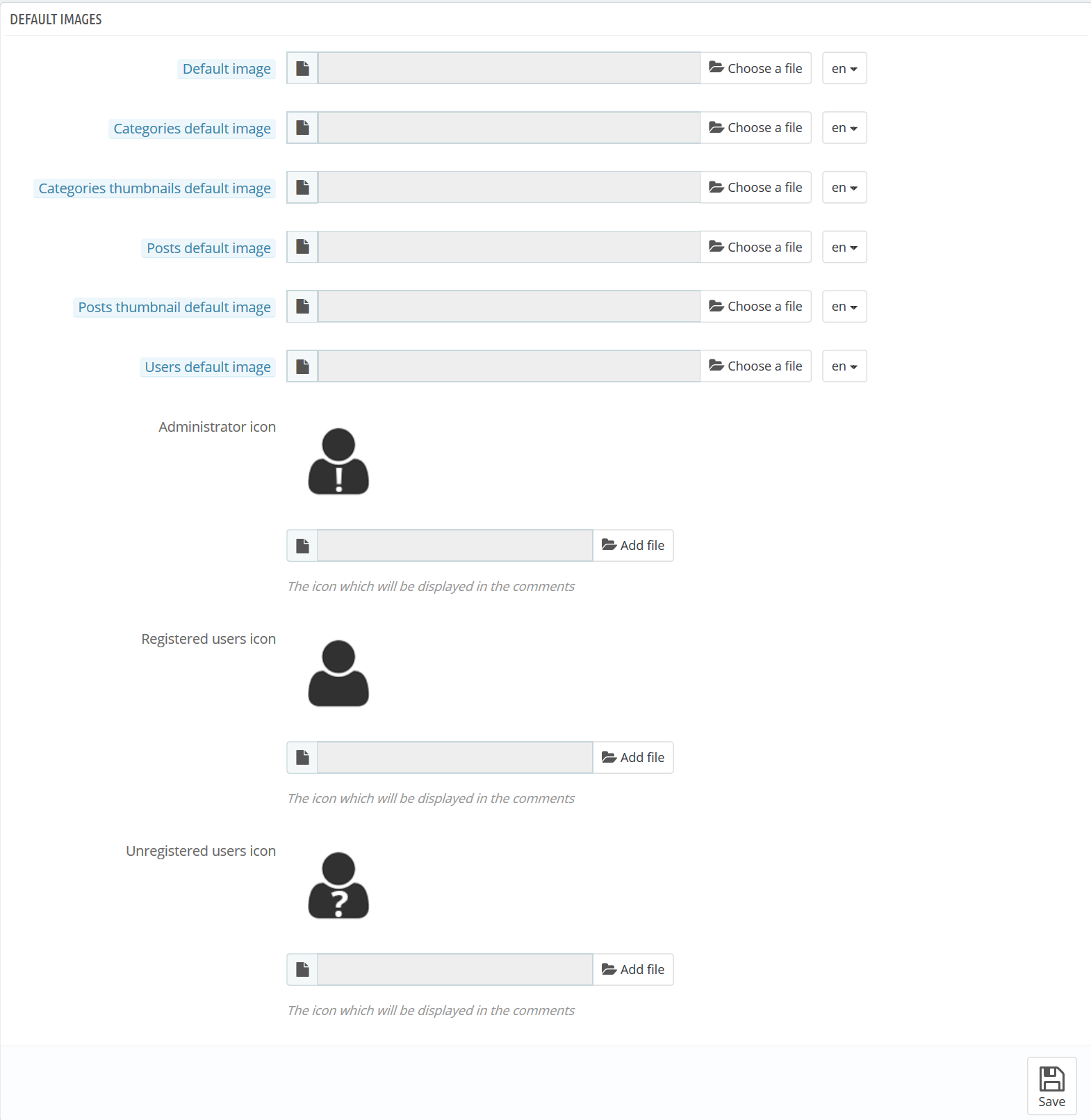
Comments
You can stay in touch with your customers using JX Blog Comments module. In Comments section, you can see the comments from your customers or site visitors, reply on them, edit or delete them.

Settings
Main settings
You can manage the main settings for blog functionality.
You may set the following options:
Image regeneration - generate new sizes for images automatically after each changing.
Display author - display the author of the post on the frond-end.
Display views - show the post views.
Items per page - the amount of items that will be displayed in listings.
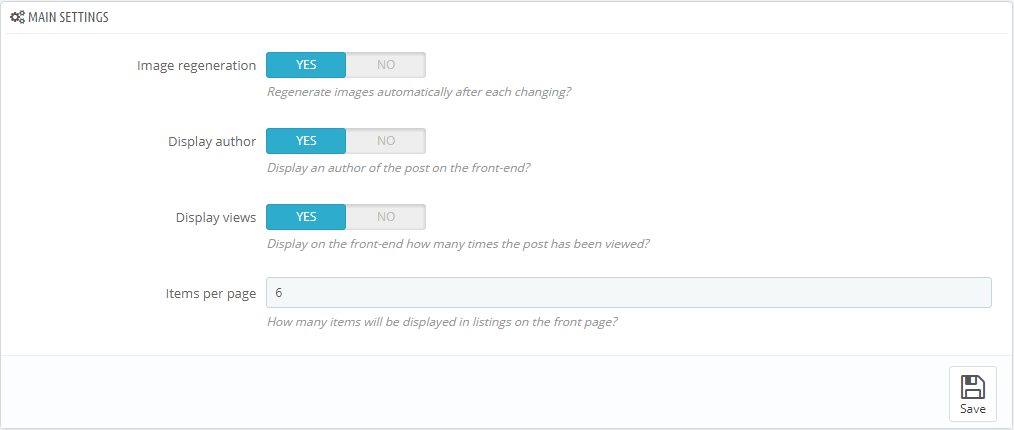
'Posts to post' settings
The block is displayed on the post single page and is used to display the related posts.
Settings:
Number of visible related posts - number of related posts shown in the block.

'Products to post' settings
The block is displayed on the post single page and is used to display the related products.
Settings:
Number of visible related products - number of related products shown in the block.

Comments settings
Who can read comments? - choose which categories of the users will be able to read comments from your blog.
Who can leave comments? - choose which categories of the users will be able to leave comments in your blog.
Moderation - choose who can leave comments without moderation.
Replying - choose who can reply to other comments.
Voting - choose who can vote for other comments.
Editing - choose from the drop-down list who can edit its own comments.
Editing confirmation - choose who can edit own comments without moderation.
Deleting - from the drop-down list choose who can delete its own comments.
Deleting comments with replies - choose who can delete its own comments which have replies.
Attachments - choose who can add attachments to comments.
Hashtags - choose who can use hashtags in comments.
Pinging - choose who can mention users in comments.
Navigation - choose who can see navigation above the comments block.
Post on enter - enable/disable the possibility to post a comment by pressing "Enter" button.

JX Categories Badges
This module allows adding badges to the sidebar categories of the default PrestaShop Categories module ("Blockcategories"). The badges can be added to the category of any level and in any language. The text field of the label is mandatory and should be filled in all languages. If this field is left blank in any language, then it will automatically take the text of the default language.
Installation and Deleting
The module is installed and deleted like any other PrestaShop module.
Module Configuration
After installation you can change its settings on the module configuration page.
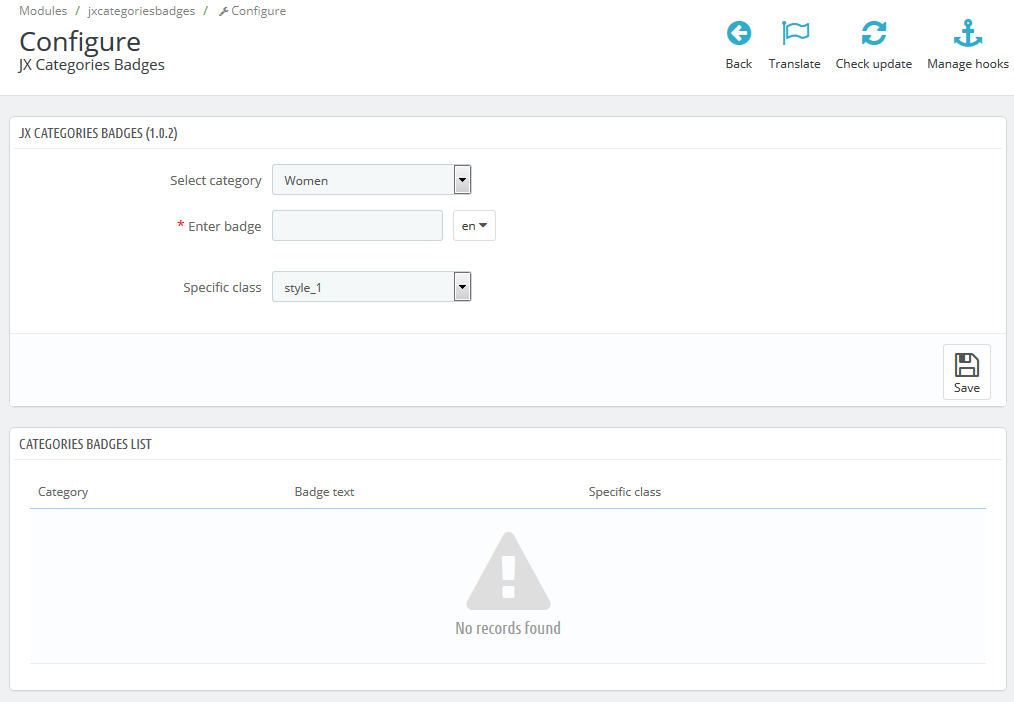
You can add badges to any category after selecting it from the drop-down list.

Attention! You can add only one badge for each category.
Then, you can add text that will show up in the badge and select the style from the drop-down list (the styles may differ in different templates).
Then press the 'Save' button (1).

You can see the list of existing badges below. Here you can edit or delete badges with the help of corresponding buttons.

The module is multilanguage and supports multi-stores. You can add badges for group of stores or all stores at once. They will show up in the list as separate elements.
JX Category Image Slider
The module allows creating multilingual slides for any category of the store. The slider will be displayed on the category pages.
Installation and Removal
The installation procedure is standard, module can be installed and deleted as a regular PrestaShop module.
Module settings
After the module installation, you can set or change the needed options on the module configuration page.
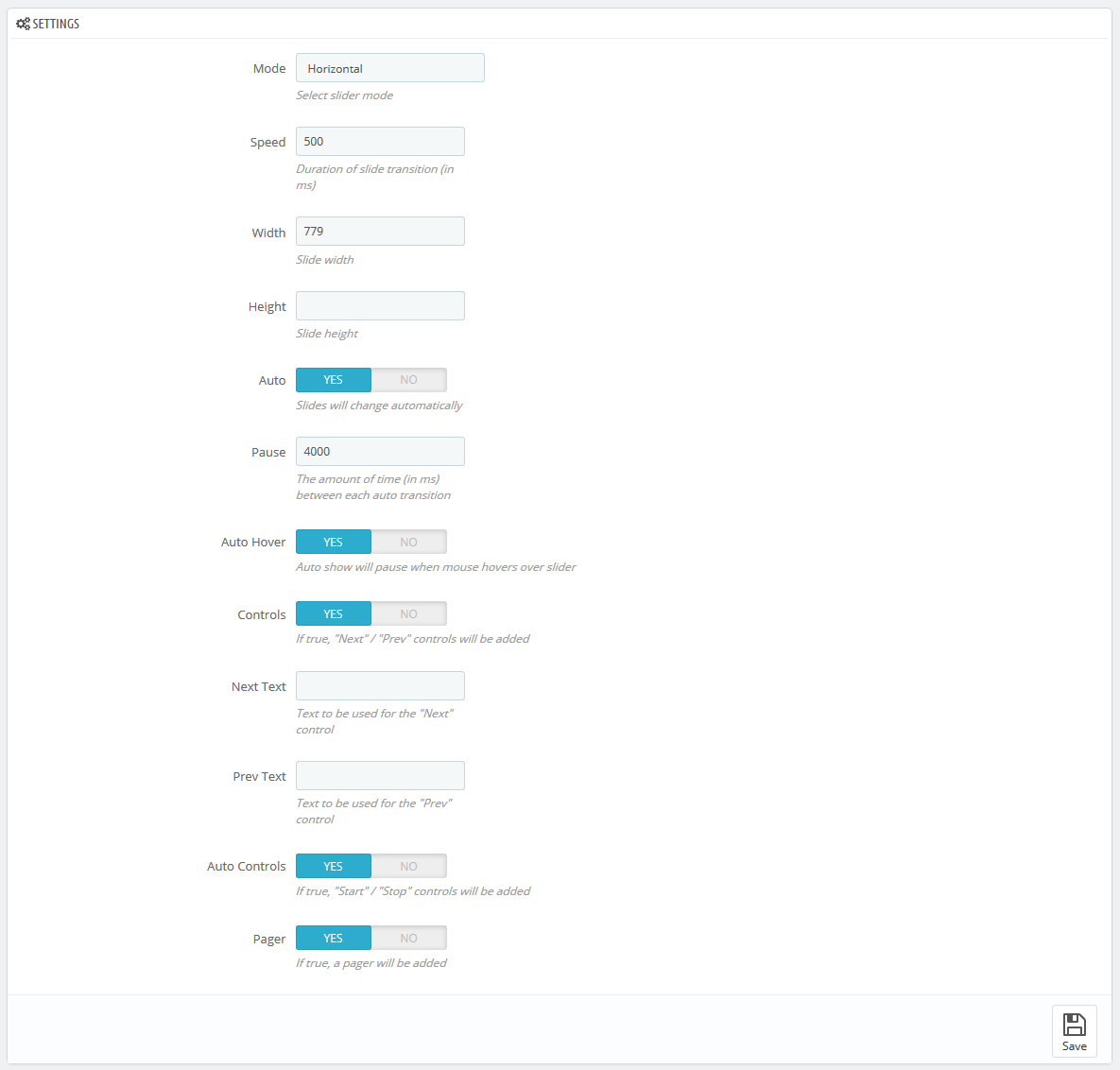
- Mode - type of animation (fade, vertical, horizontal).
- Speed - animation speed.
- Width - slides width (for the correct view, it is recommended using the actual image width).
- Height - slides height (for the correct view, it is recommended using the actual image height).
- Auto - autoplay when page is opened.
- Pause - time before transition to the next slide.
- Auto Hover - pause on hover.
- Controls - "Next"/"Previous" buttons.
- Next Text - "Next" button text.
- Prev Text -"Previous" button text.
- Auto Controls - "Play"/"Pause" buttons.
- Pager - pagination.
Adding/removing/editing slides
After the module installation, you will see the new field 'Slides' in category settings.

To add a slide, click on the 'Add new slide' button. Fill in the needed fields in the form.
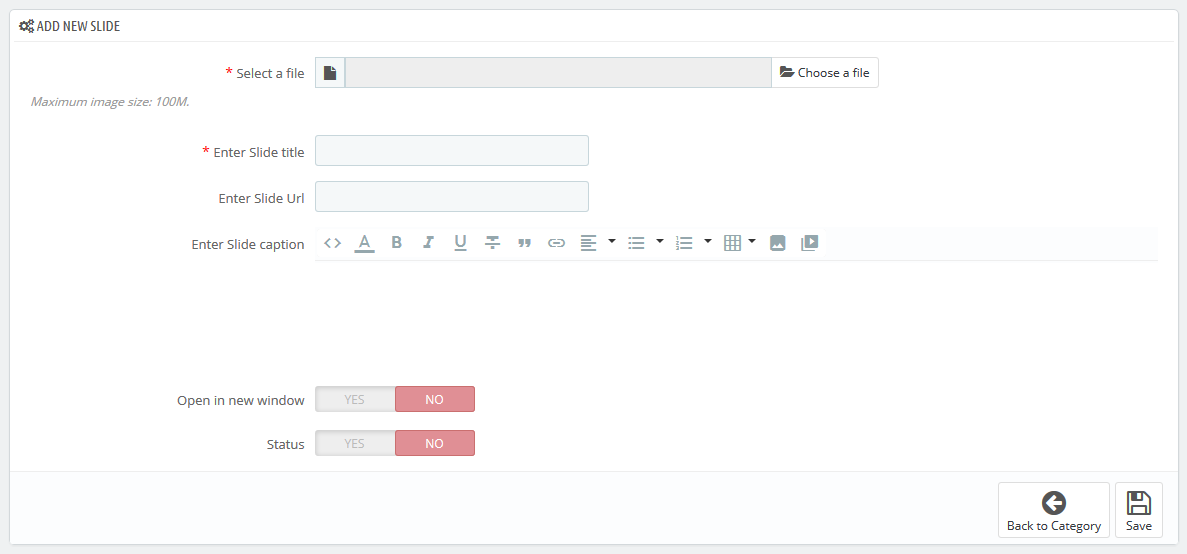
- Select a file - select your file. You can upload different images for each language. In case there is no image selected for the specific language, images set for default language will load.
- Enter Slide title - type in the slide title.
- Enter Slide Url - provide the slide URL.
- Enter Slide caption - type in the slide caption.
- Open in new window - open in new window.
- Status - enable/disable slide.
When the slide is saved, it will appear in a category slides list.
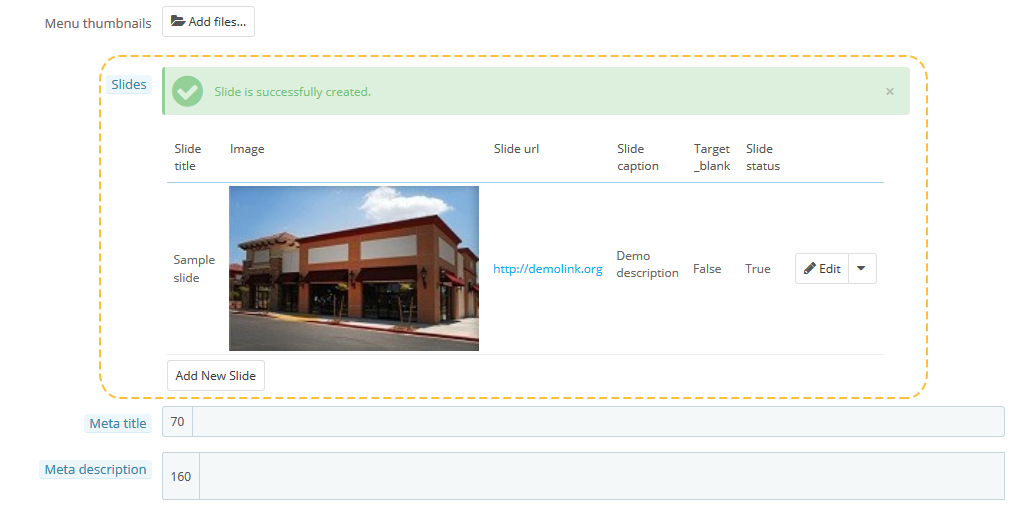
In order to make changes to slide, click the 'Edit' button.
In order to delete the slide, click on 'Delete' below the 'Edit' button.
JX Category Products 2.0.0
This module displays category products in displayHome and displayHomeTabContent hooks. The module allows displaying single products, products from a category or all products. Moreover, the module comes with a carousel that works, when the module occupies the displayHome position.
JX Category Products Main Panel
The main panel. Here you can set up the module.
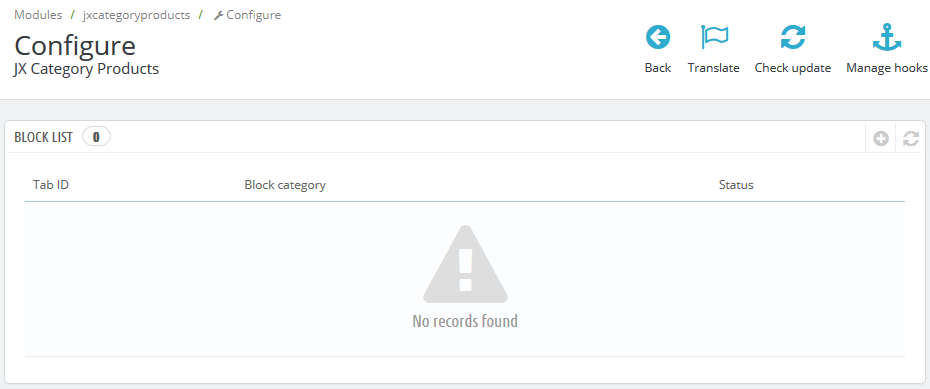
Adding a block
This block allows selecting products in displayHome position.
Access the module main panel and press the 'plus' (1) button in the blocks list.

In the appeared form, you'll find the following options:
Status - this option allows enabling/disabling the block.
Select category - the category, products of which will be displayed.
-
Use name in font - this option allows changing the displayed category name. If enabled, displays the following form:
Name - the custom tab name, displayed on the website.
-
Select products to display - if disabled, displays the 'Number of products to display' field, which sets the number of products to display. If disabled, displays the 'Add products' button that allows selecting products to display in the tab.
-
Use carousel - this option allows enabling/disabling the carousel for block products. After enabling the option, you'll see the following settings:
Visible items - the number of visible items.
Items scroll - the number of items changed with one carousel scroll.
Slide Width - the carousel list item width.
Slide Margin - the carousel list item margin.
Auto scroll - auto scroll of carousel items.
Carousel speed - speed of changing items.
Pause - pause between scrolls (if "Auto scroll" is enabled).
Random - the carousel starts with a random item.
Carousel loop - the loop: when all the carousel items have been displayed, carousel starts from the beginning.
Hide control on end - hide control buttons (Next/Prev).
Pager - display pagination.
Control - display controls (Next/Prev).
Auto control - display controls (Play/Pause).
Auto hover - carousel pauses, if the user hovers a list item.
-
After configuring all the needed options, press the 'Save' (2) button.
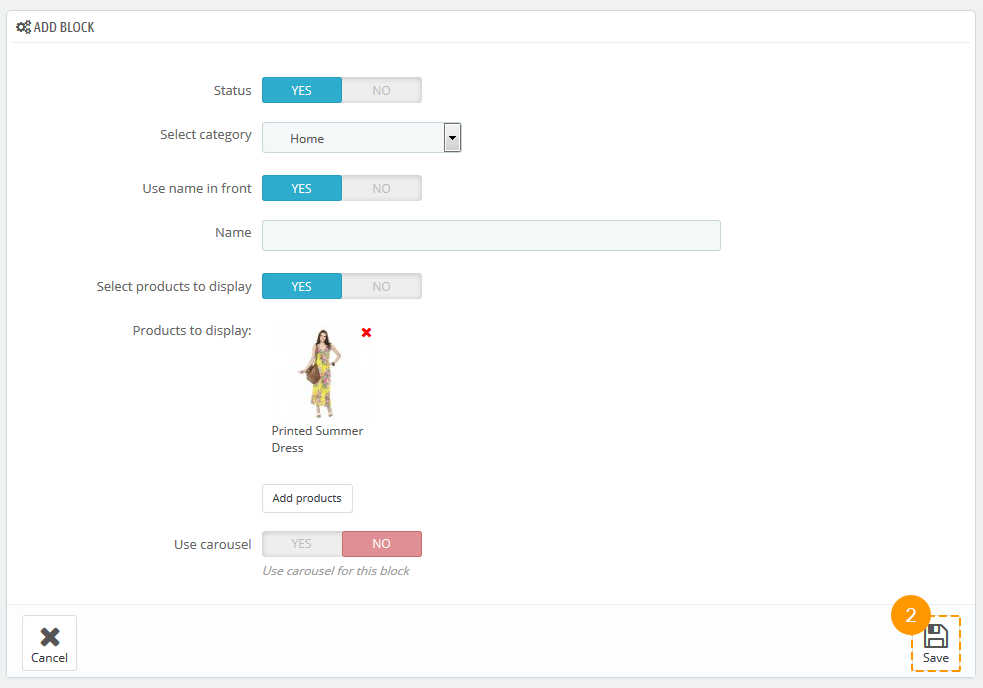
Blocks Sorting
You can sort the blocks of the module with the help of drag'n'drop. This allows to change blocks positions quickly.

Selecting Products
If you create an item and enable 'Select products to display' option, you can choose the products that you want to display. To do this:
Press the 'Add products' (1) button:

In the appeared pop-up, select the needed products (2) and press the 'Add' (3) button:
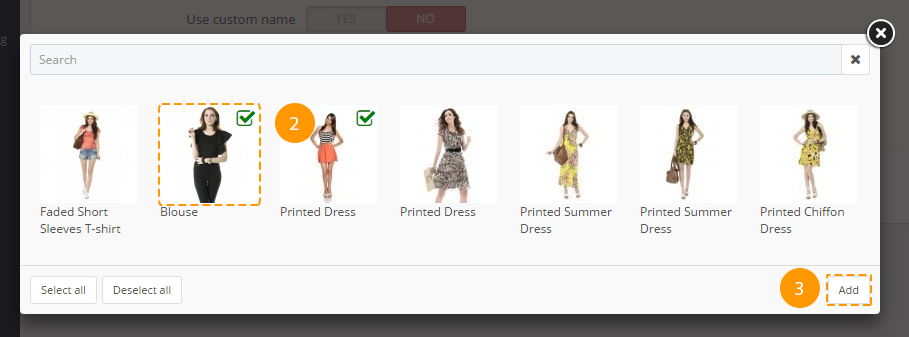
Now, you can place the added products wherever you want with the help of drag'n'drop (4):

When all the needed products are added and arranged in the desired order, press the 'Save' button.
Deleting Blocks
To delete items, press the drop-down menu next to the needed block (1) and press delete (2). The item will be deleted.

JX Compare Product
This module allows you to compare products.
Product comparison as a feature allows comparing two, three or more products at a time.
Installation and Deleting
The module can be installed and deleted like any other PrestaShop module.
Module Settings
The main panel. Here you can set up the following options of the module:

Count product - the amount of products to be compared.
Display in footer - the ability to display the feature in footer area.
Display in header info - the ability to display the feature in header area of the page.
JX Deal of the Day
This module allows you to display the list of products with the discount countdown timer. You can also add a timer to products in the home page tabs, on the category pages and single product pages.
Installation and Deleting
The module is installed and removed the same way as any other PrestaShop module.
Module Settings
After module installation you can add a product discount with the display period and a discount countdown timer.

Adding/removing/editing blocks
-
In order to add a new product, press 'Add new' button
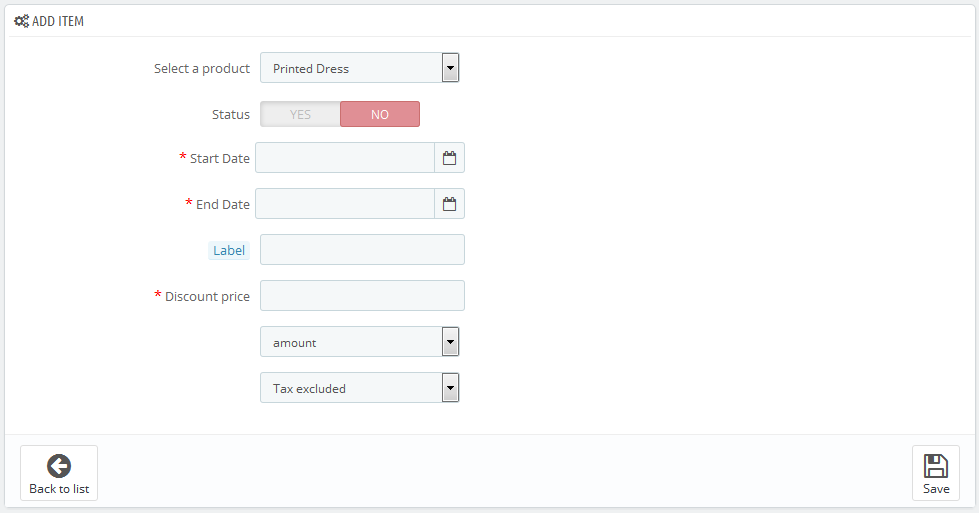
- Select a product - select a product to apply the discount and display a timer.
- Status - item status.
- Start Date - start date of the product discount period.
- End Date - end date of the product discount period.
- Label - product label.
- Discount price - discount price (absolute or percentage value).
-
After saving the item it appears in the list of items of this type.

-
In order to edit this item, press 'Edit' button.
-
In order to remove this item, press 'Delete' button.
-
If a special price valid for a certain period was set to the product previously, this product can be added to the module items list.
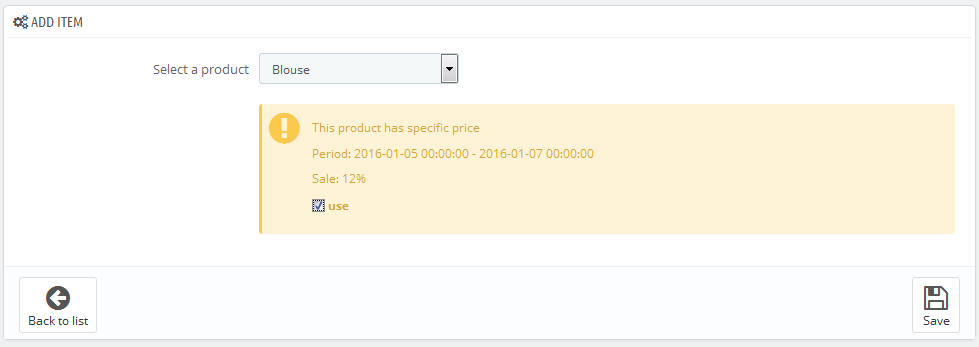
Product display configuration
-
In order to change product display mode, press 'Configuration' button.

-
Then a form with product display configuration will appear.

- Products to display - number of products to display in the home page block.
- Random products - random products display.
JX Google Map
This module allows adding Google Map with store locations and store short descriptions to the Homepage. The map will display the addresses of all the stores connected with your online store.
Installation and removal
The module is installed and removed as any other PrestaShop module.
Module settings
After installing the module, you can add stores to the map. After pressing the 'Add new store' button (1), you'll be redirected to the 'Store contacts' tab, where you can edit your stores.

To add a new store, press the 'Add new' button.
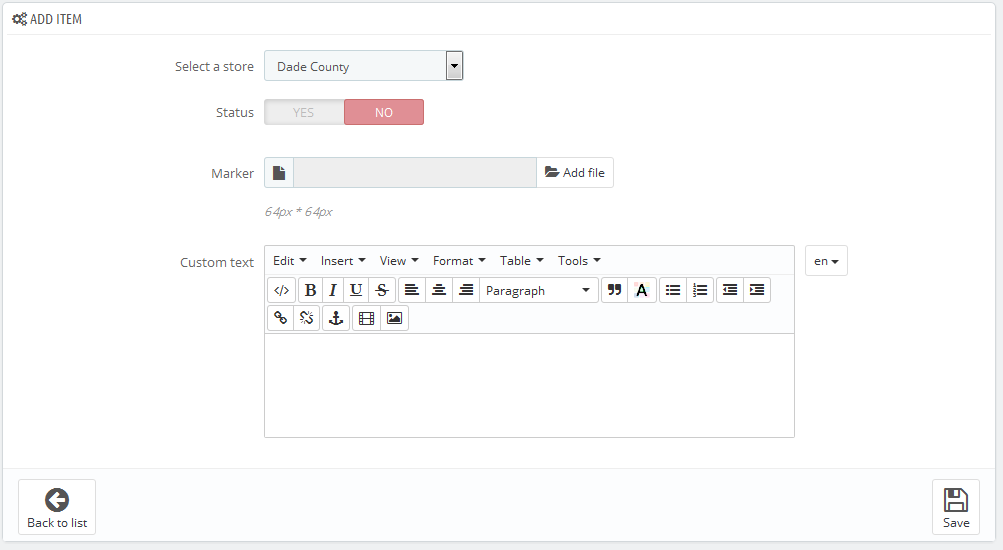
- Select a store - select the store that you want to add to the map.
- Status - the element status.
- Marker - adding a custom marker.
- Custom text - adding custom text.
Google Map display settings
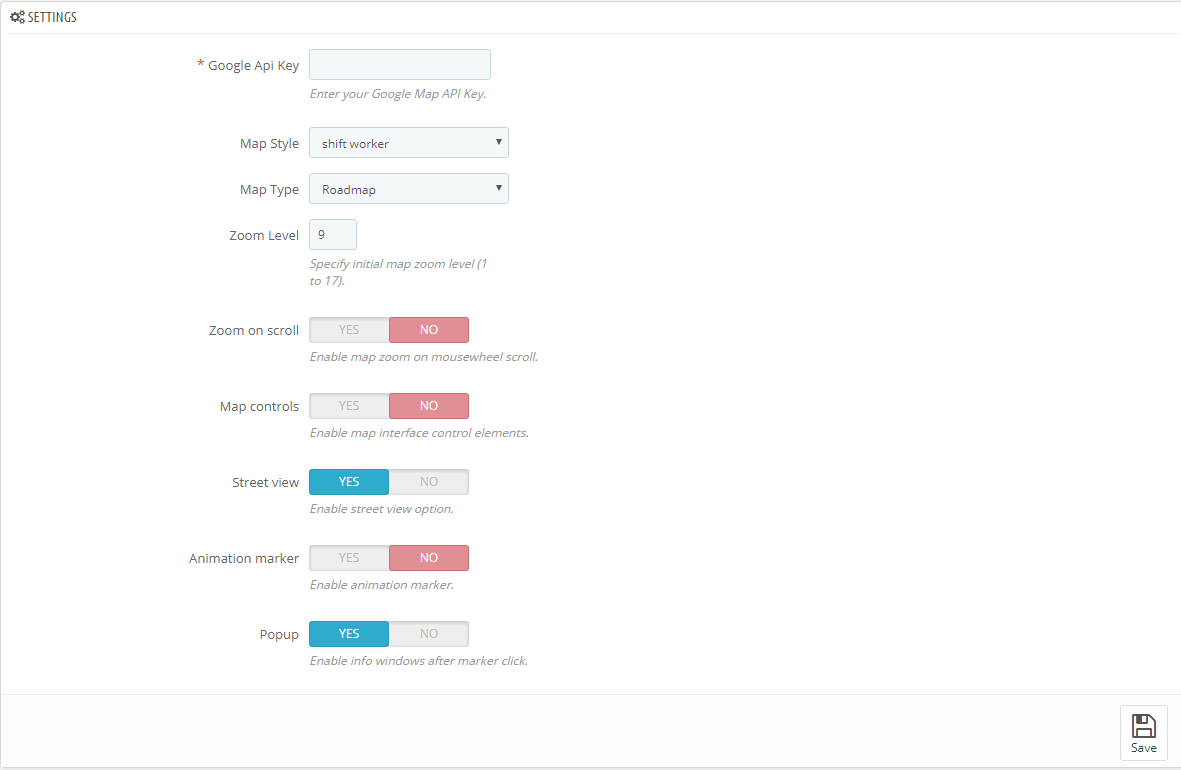
- Google Api Key - enter your Google Map API Key.
- Map Style - select the map display style.
- Map Type - select the map display type.
- Zoom Level - specify the initial level of the map zoom (from 1 to 17).
- Zoom on scroll - enable/disable map zoom on scroll.
- Map controls - enable/disable map controls.
- Street view - enable/disable street view.
- Animation marker - enable/disable animation marker.
- Popup - enable/disable popup windows with store information.
JX Header Account 2.1.0
This module displays login and registration forms on the website. It can take the following positions: website header, left and right column. The module allows to log in and register using such social networks as Facebook, Google+ and VK, which is convenient for website users. Registration or logging in proceeds without reloading the page.
The module is compliant with official PrestaShop General Data Protection Regulation (GDPR) module, a new EU legal framework that governs how users' personal data is used.
JX Header Account Main Panel
The main panel. Here you can set up the module.
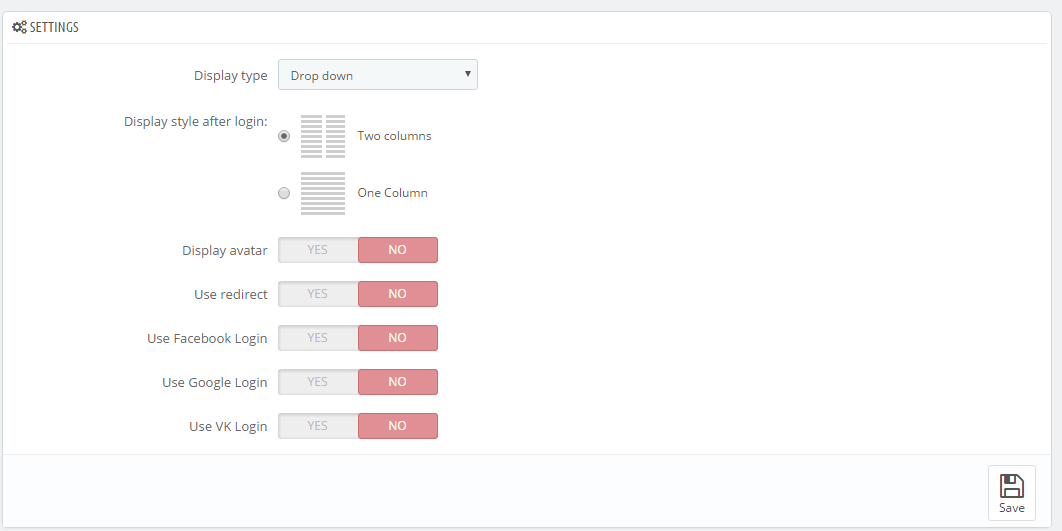
Settings
There are the following settings in the module:
Display type - this setting allows to select the way to display the registration form. It can take the following values:
- Drop-down - the form will display as a drop-down below the button opening it.

- Popup - the form will appear in a pop-up.
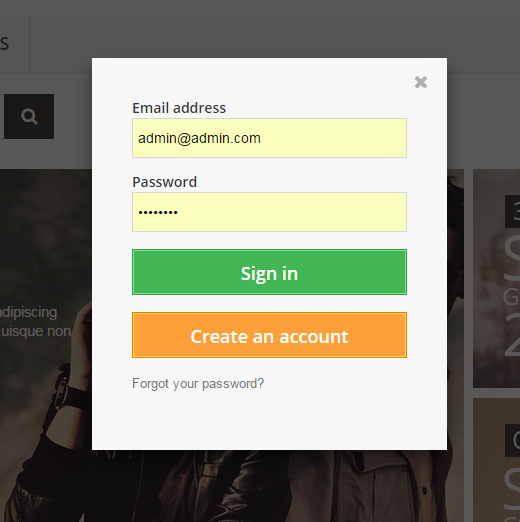
- Left side - the form will appear from the left as a sidebar.
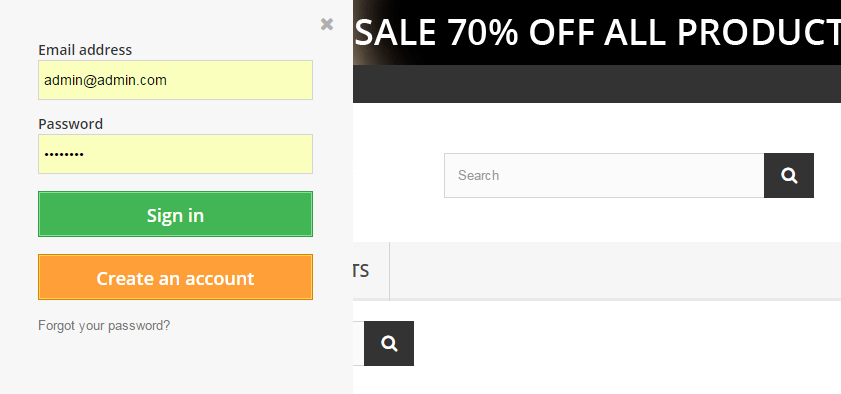
- Right side - the form will appear from the right as a sidebar.
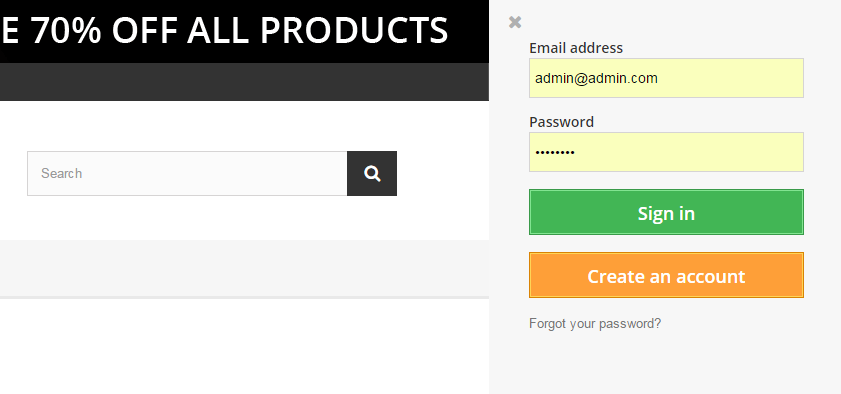
- Drop-down - the form will display as a drop-down below the button opening it.
Display style after login - this setting allows to change the form view after login/registration. You can use the following values:
- Two columns - the list is divided into two columns.

- One Column - the list of links is displayed as one column.
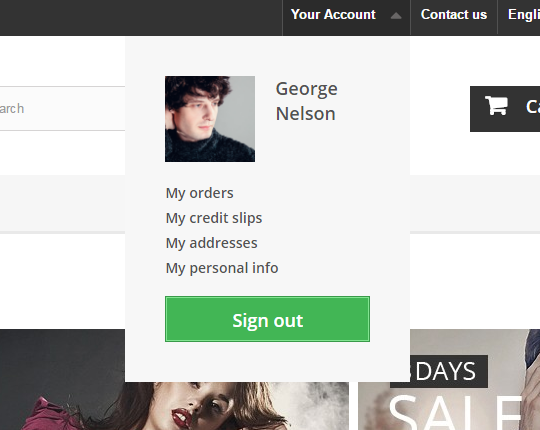
- Two columns - the list is divided into two columns.
- Default avatar - this field appears only if the 'Display avatar' option is enabled. Here you can select the default user avatar.
- Display avatar - this setting allows to enable or disable user avatar. If the user logs in to the account on the website with the help of one of the social networks, the avatar will be taken from the account in this social network, otherwise, the avatar, loaded by the website admin, will be displayed.
- Use redirect - if this setting is enabled, user registration and password recovery will take place on the default PrestaShop registration/password recovery page.
Use Facebook Login - this setting allows enabling user registration and login with the help of the Facebook social network. When you enable this option, you will see the following settings:
- App ID - your account App ID from the Facebook developer account.
- App Secret - your app secret from the Facebook developer account.
Use Google Login - this setting allows enabling user login and registration with the help of the Google+ social network. If you enable this option, you will see the following settings:
- App ID - your App id from the Google developer account.
- App Secret - your App secret from the Google developer account.
- Redirect URLs - your online-store url + index.php?fc=module&module=jxheaderaccount&controller=googlelogin
Use VK Login - this setting allows enabling user registration and login with the help of VK social network. If you enable this option, you will see the following settings:
- App ID - your App id from your VK developer account.
- App Secret - App secret from your VK developer account.
- Redirect URLs - your online-store url + index.php?fc=module&module=jxheaderaccount&controller=vk
Registering apps in social networks:
- Facebook - to get App ID and App Secret, register your app at https://developers.facebook.com/apps.
You may check the following tutorial in order to learn how to create Facebook developer account and get App ID and App Secret values.
- Google+ - to get App ID and App Secret, register your app at https://developers.google.com/accounts/docs/OAuth2/.
- VK - to get App ID and App Secret register your app at https://vk.com/dev.
JX Homepage Category Gallery
The module displays a category gallery on your store Homepage.
It should look something like this:

Here are the main parts of the Category Gallery item, which are marked on the screenshot:
- 1 - HTML content
- 2 - category name
- 3 - category description
- 4 - button
Customization details you can find below in 'Module configuration' section.
Module Installation
The module can be installed and deleted like any other PrestaShop module.
Module configuration
-
After you have installed JX Homepage Category Gallery module, you can configure it clicking the corresponding button (1).
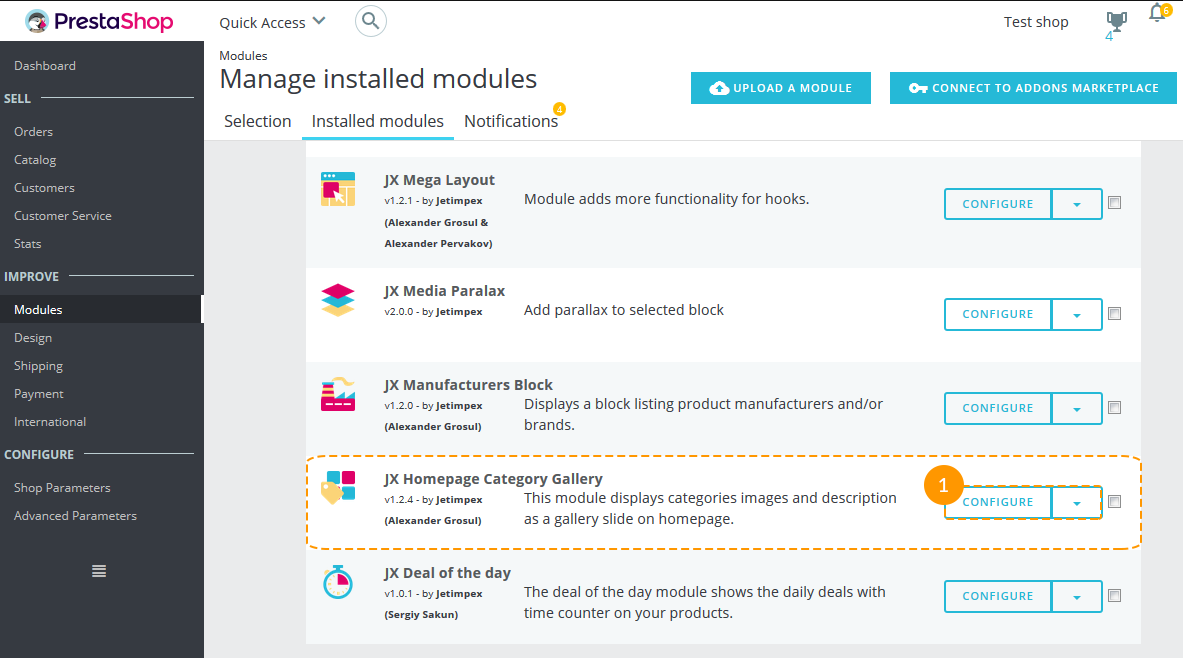
-
On the Configuration page you'll see the list of items in this module. You can edit the existing ones (1) or add new item (2).
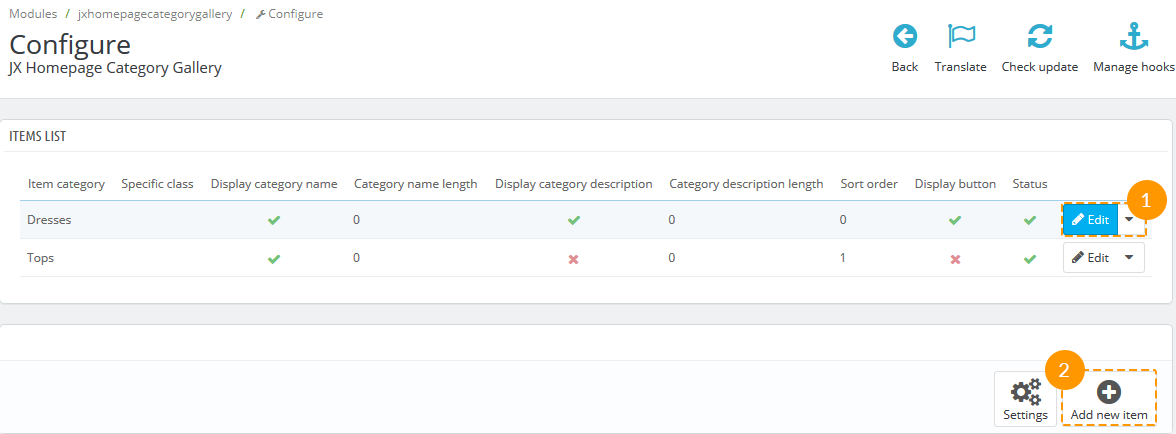
Adding/Editing item options
When you add a new item to the module (or edit the one from the list of items), you have some options to choose from. The detailed description of options you can see below the screenshot. After all options are set, click the 'Save' button (1).
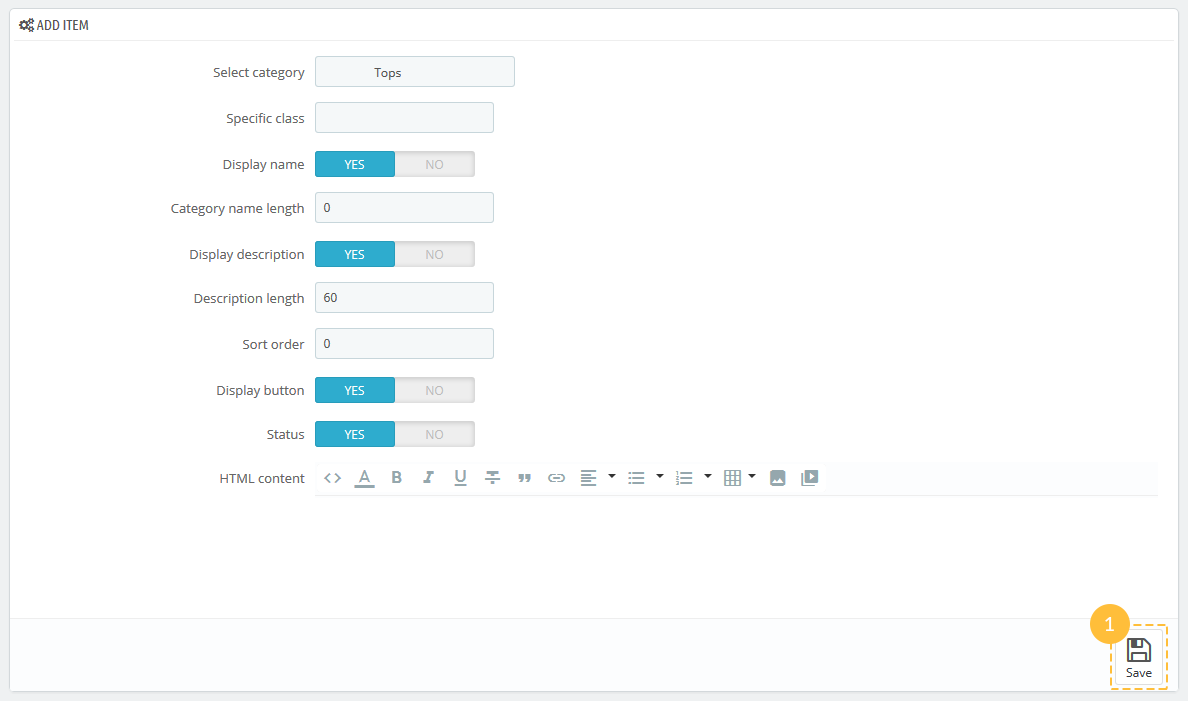
- Select category - here you choose from the drop-down list the category which should be displayed on your page.
- Specific class - the specific class can be added to the module item.
- Display name - option to show or hide the category name.
- Category name length - maximum number of symbols to be displayed in the category name. If the name is longer - the '..' symbol will be added after the number of symbols that has been set.
- Display description - option to show or hide the category description.
- Description length - maximum number of symbols to be displayed in the description. If the description is longer - the '..' symbol will be added after the number of symbols that has been set.
- Sort order - the order of item in the category gallery.
- Display button - the option to show or hide the button 'Shop now' (button text can be different depending on the template).
- Status - the option to show or hide the category
- HTML content - the field where some HTML content can be added.
JX Homepage Products Carousel
The module adds a carousel to the main page tabs.
Installation and Deleting
The module can be installed and deleted like any other PrestaShop module.
Module configuration
The installed module settings can be configured on the module configuration page.
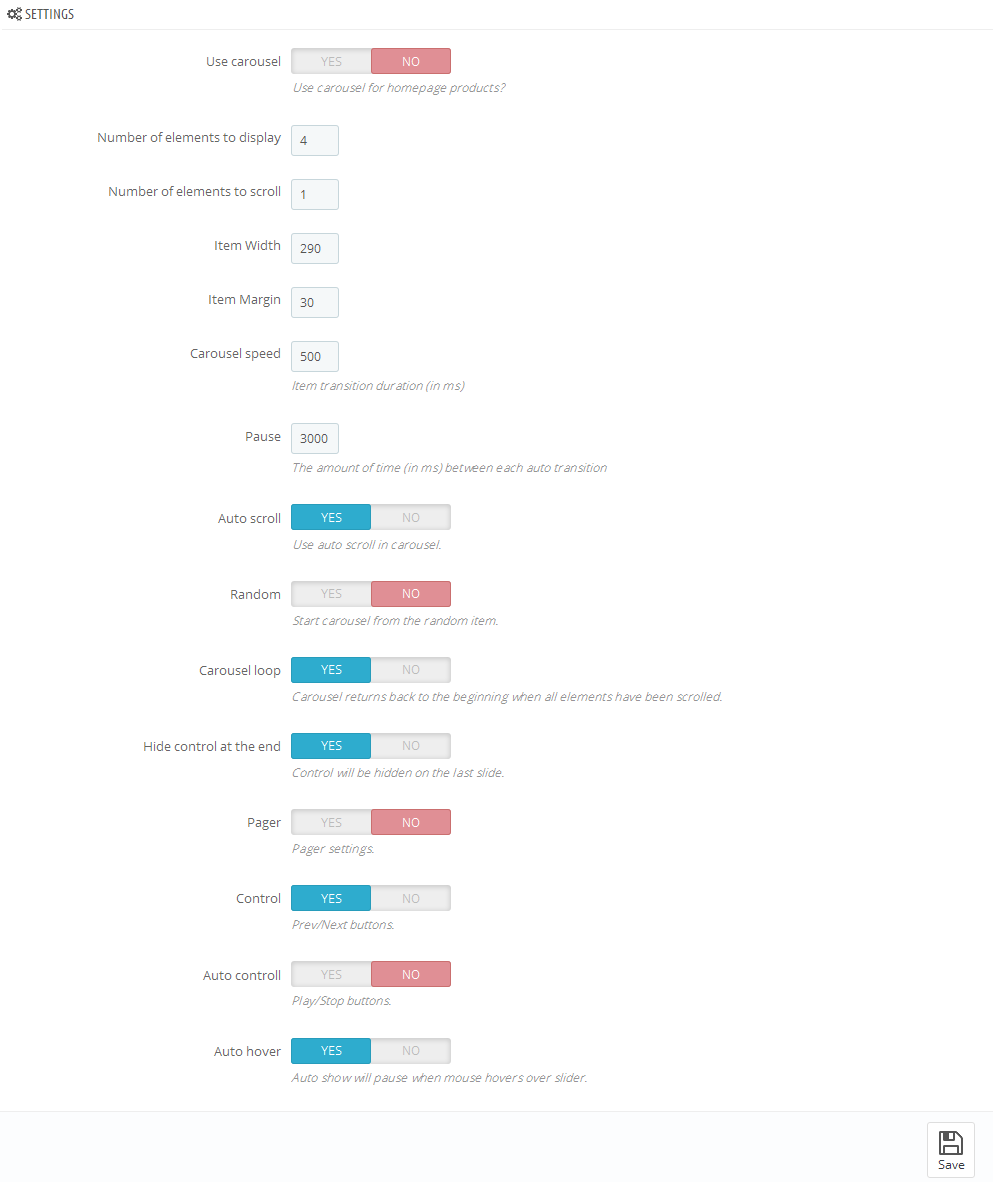
-
- Use carousel
- enable/disable carousel
-
- Number of elements to display
- the number of items to display
-
- Items scroll
- the number of items to scroll
-
- Item Width
- width of an item in the carousel list
-
- Item Margin
- margin between items in the carousel list
-
- Carousel speed
- item transition duration
-
- Pause
- the amount of time between each auto transition (if the "Auto scroll" option is enabled)
-
- Auto scroll
- enable carousel auto scroll
-
- Random
- start carousel from a random item
-
- Carousel loop
- carousel returns back to the beginning when all elements have been scrolled
-
- Hide control on end
- hide the navigation (next/previous) buttons on last slide
-
- Pager
- show pagination
-
- Control
- show next/previous buttons
-
- Auto control
- show play/pause buttons
-
- Auto hover
- pause the carousel when mouse hovers over carousel items
JX HTML Content
This module allows displaying any content (image, HTML, links, etc.) in the following positions: displayNav, home, top, topColumn, left and right (displayLeftColumn/displayRightColumn), footer. It is used to expand design opportunities and add advertisement/information blocks to your store. It is a multilanguage module and can also work on the multi-store website.
Installation and Deleting
The module can be installed and deleted like any other PrestaShop module.
Module configuration
After the module has been successfully installed, open the configuration page.
To add the content, you should follow the steps below:
- Click 'Add new' button.
- The list of available languages. You can view the available elements for all languages by switching the language tabs.
- The list of elements added for specific position and language.
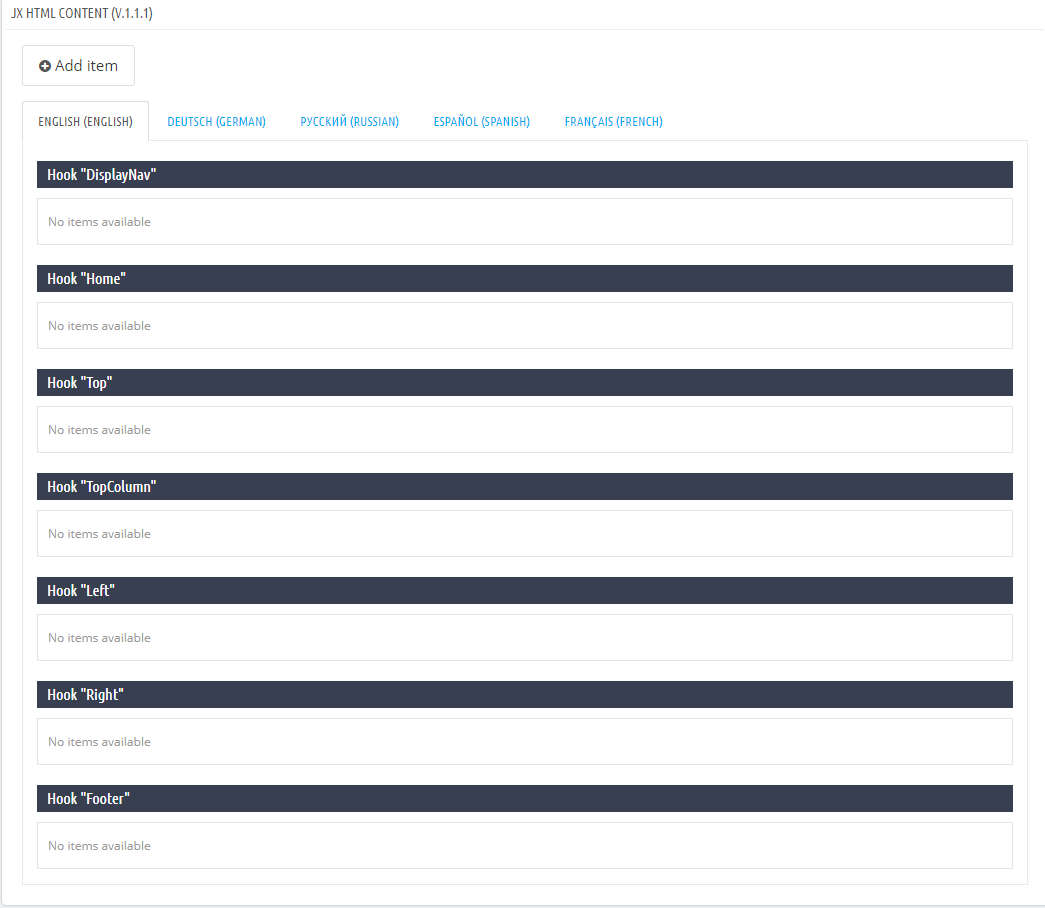
Adding the element. Click Add item button and fill in the required settings (none of the fields are mandatory).
All elements of one language added to the same position will be displayed as a list at the backend and frontend.
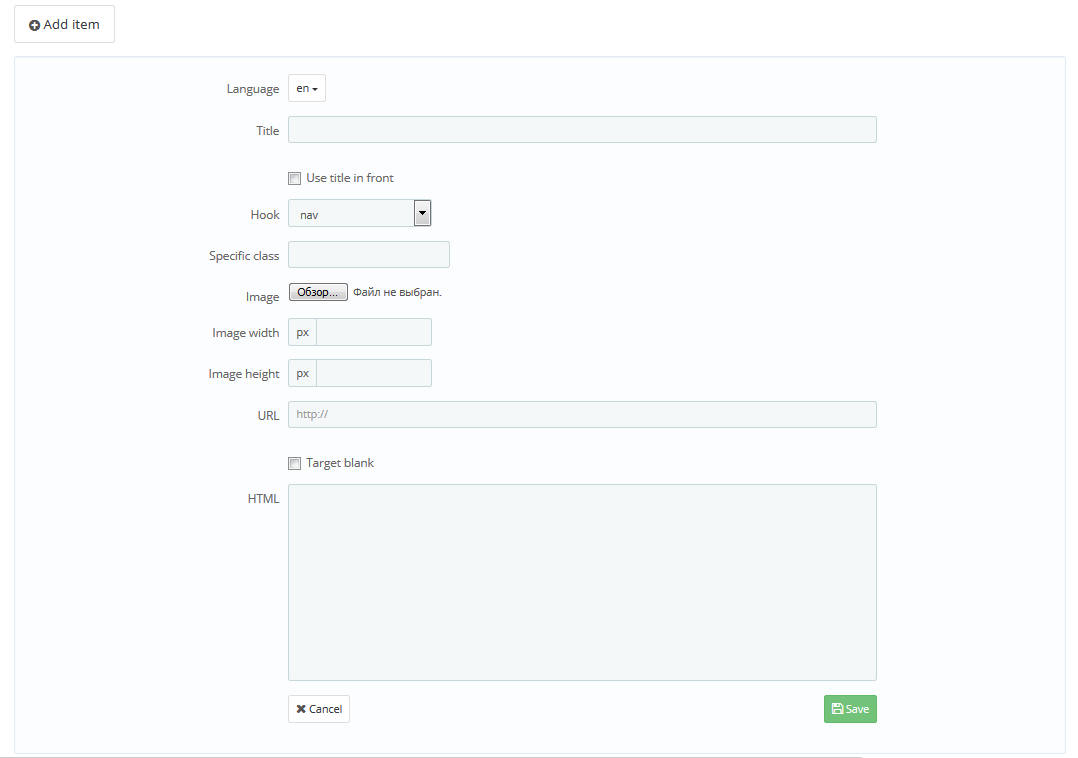
-
- Language
- select the required language from the drop-down list.
-
- Title
- title of the element.
-
- Use title in front
- display the title of the element at the frontend (the title will show up in front of the element).
-
- Hook
- position where the element is added.
-
- Specific class
- custom class defines item styling (CSS class).
-
- Image
- upload the image from your computer.
-
- Image width
- image width shown at the frontend.
-
- Image height
- image height shown at the frontend.
-
- URL
- add the link (the whole block will be wrapped in the link).
-
- Target blank
- open link in new tab.
-
- HTML
- HTML code (except the link if you have added it in the URL field) or text.
-
- Save
- click to save the element.
Editing and removing the element
When you add the element, it shows up in the corresponding list.
- The language where the elements were added.
- Position where the elements were added.
- Edit button with the drop-down list.
- Delete button.

Editing
Click Edit button to modify the element.
In the appeared screen change all the required fields.
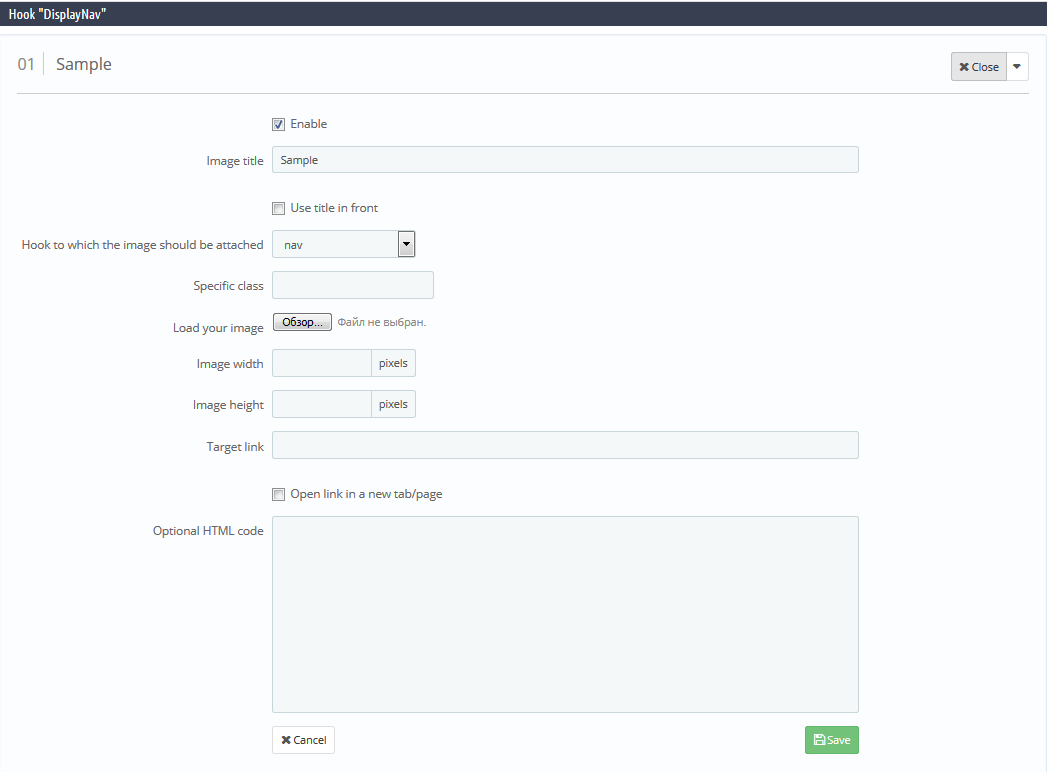
-
- Enable
- display the element at the frontend.
-
- Image title
- title of the element.
-
- Use title in front
- show up title at the frontend.
-
- Hook to which the image should be attached
- position of the element.
-
- Specific class
- custom CSS class.
-
- Load your image
- image of the element.
-
- Image width
- image width at the frontend.
-
- Image height
- image height at the frontend.
-
- Target link
- assign link to the element.
-
- Open link in a new tab/page
- Open link in new tab.
-
- Optional HTML code
- edit HTML code.
-
- Save
- save changes.
Changing order of elements in the list

To change the order of elements, you should just drag the element to the position you need.


JX Look Book
Requirements:
This module allows creating lookbooks and combining them to collections. In their turn, lookbooks allow viewing the products directly on the model. Also, if a product is marked in the lookbook, the module displays the lookbook link on the product page.
- PHP 5.4+
- PrestaShop 1.7
JX Look Book Main panel
On the main page of the module, you can delete and edit the module collections. Also, you can add, delete and edit blocks, that the module will display on the Homepage.
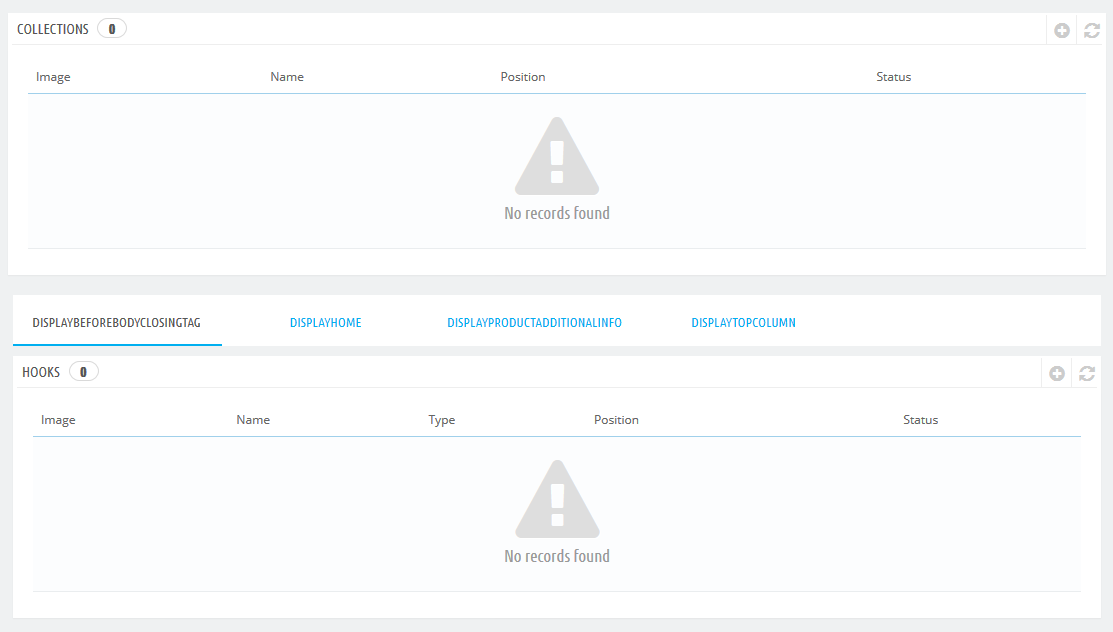
Adding and editing the collection
Collections allow combining several lookbooks on one page. To add a collection, follow the next steps.
-
In the collections table (the main module panel) click on the plus (1).

-
You will see a form with the next fields:
- Status - this option allows to disable or enable the collection display on the collections page.
- Name - the name of the collection that will be displayed on the collections page.
- Description - the collection description.
- Image - the main collection image.
- Template - the template for the lookbooks of this collection. When you select a template, you select the way the lookbooks of this collection will be displayed on the page.
-
After having filled all the fields, press the 'Save' (2) button.
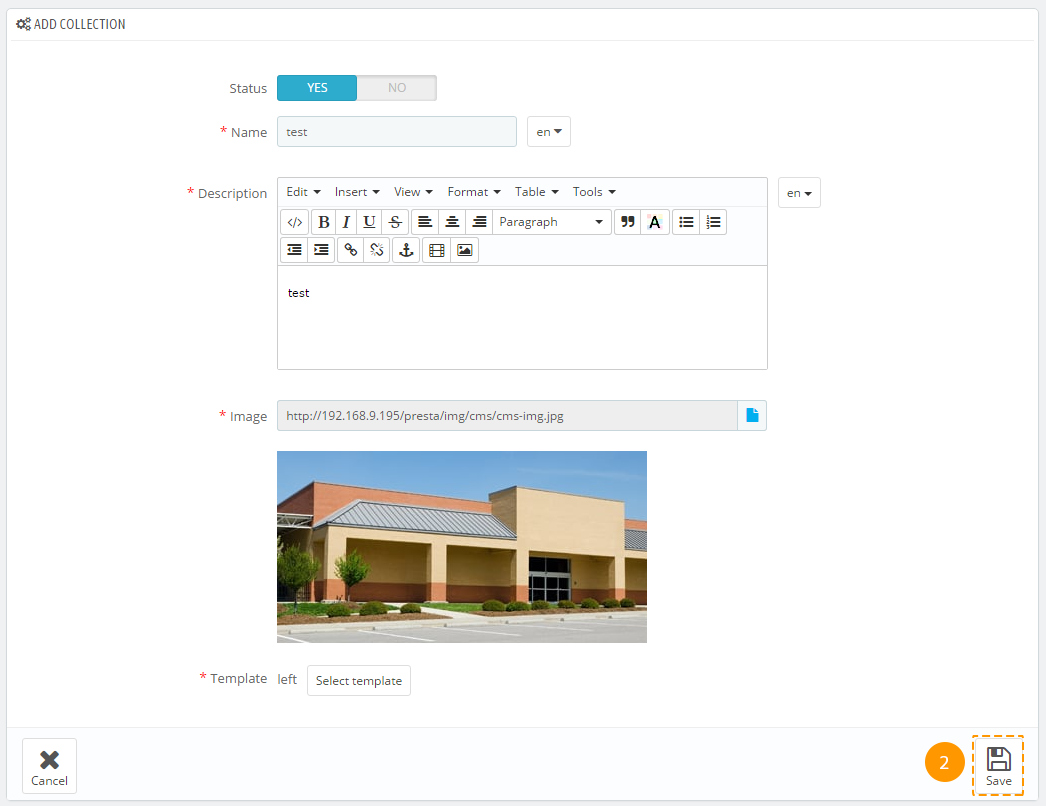
-
The collection has been created. You can edit it by pressing the 'Edit' (3) button, or you can proceed to the next step and create lookbooks for the collection.

Creating and editing lookbooks
-
After creating a lookbook, press the 'View' (1) button next to the needed collection.

-
In the appeared block press the '+' button (2).

-
You'll see a form with the following options:
- Status - the lookbook status, the option defines whether the lookbook will be displayed.
- Name - the name of the look.
- Description - the description of the look.
- Image - the main image of the look, here you can mark the products and descriptions.
-
After filling in all the fields, press the 'Save & Stay' (3) button to continue creating hotspots.
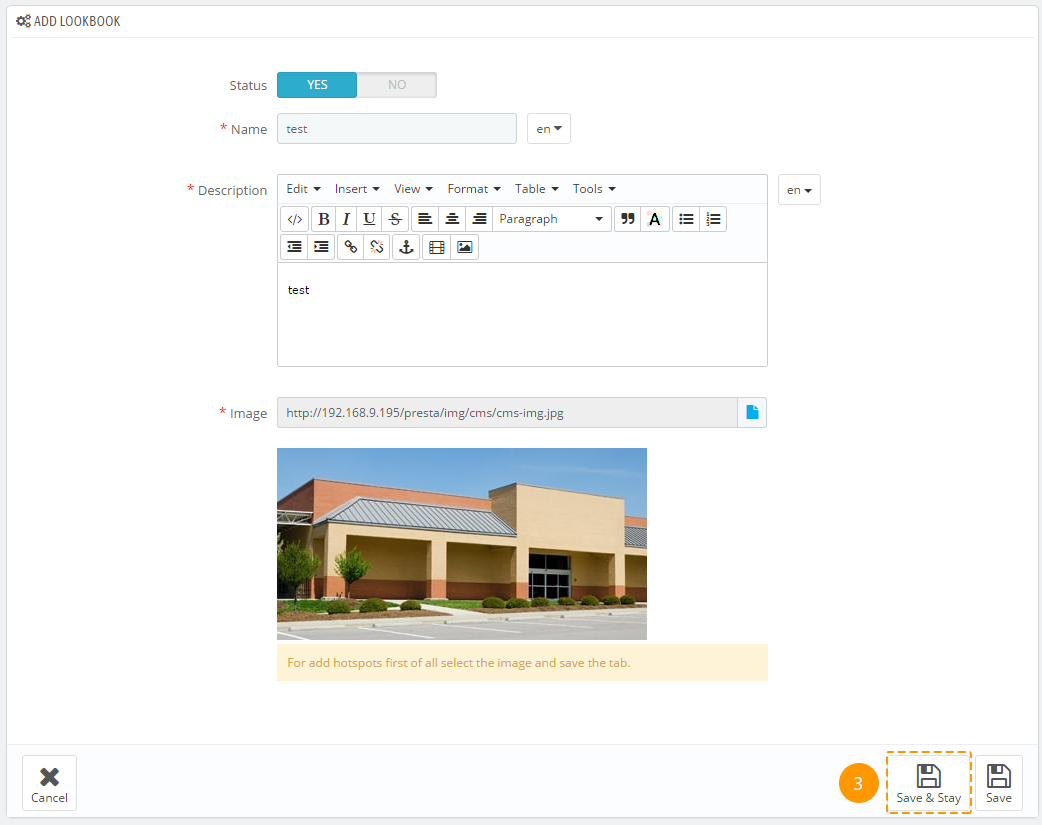
Adding and Editing Hotspots
After having saved the lookbook, you can add the hotspots.
-
Press the image (in the needed point) (1) in the lookbook form.

-
You will see a form with the following settings:
- Type - this is the point type, it has two values 'Product' and 'Content'. The product type allows to select a product that will be attached to the point, and content type allows to add content (name, description, HTML) to the point.
- Product - selecting a product for the point. It appears if the selected type is 'Product'.
- Name - the name attached to the point. This field is available, only if the type 'Content' is selected.
- Description - the point description or coding. Available only if the type 'Content' is selected.
-
After having selected the needed options, press the 'Save' (2) button, hotspot will be created and displayed on the page.
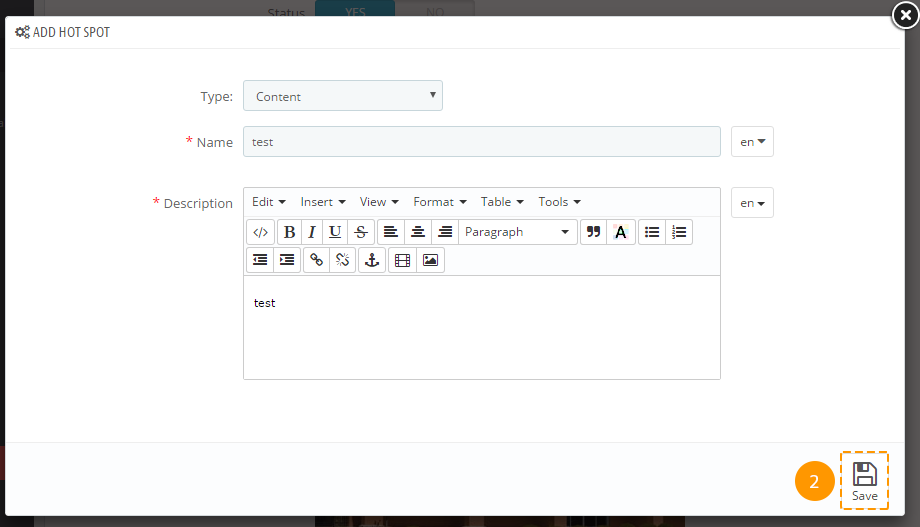
Deleting a hotspot
-
To delete a point, hover over it (1).
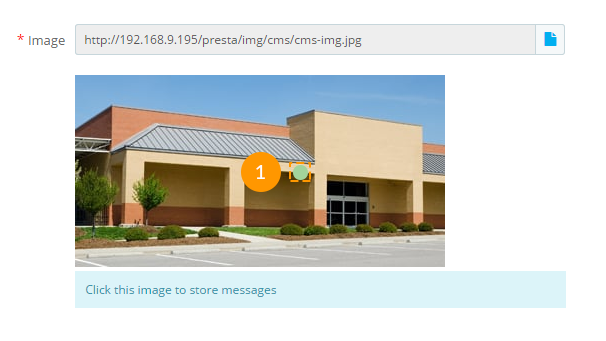
-
You'll see a button with a cross, press it (2).
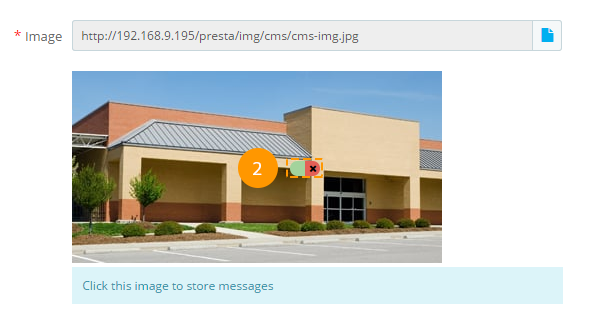
The point is deleted.
Changing the hotspot position
To change the point position, drag and drop it to the needed position.
Available positions of the module
-
The module can be displayed in 4 positions:
Displaybeforebodyclosingtag - display module at the bottom of the page;
Displayhome - display the module on the home page;
Displayproductadditionalinfo - the hook adds the additional information on the product page;
Displaytopcolumn - display module at the top of the page.

Adding a new block
-
To add a new block, enter the module main panel, choose the tab with the needed hook (1) and click the '+' (2).

-
In the appeared form, set up the following options:
- Status - the block status. This setting allows to enable or disable the block display.
- Type - allows to select the block type.
- Page - allows to select a previously selected page.
-
After setting up all options, press the 'Save' (2) button.

After the new block is created, it will be displayed on the Homepage.
JX Manufacturers Block
This module shows up manufacturers available in your store. The list of manufacturers may consist of image and title. The list can also show up as a carousel.
Installing and Deleting
The module is installed and deleted like any other PrestaShop module.
Module configuration
After installation you can change its settings on the module configuration page.
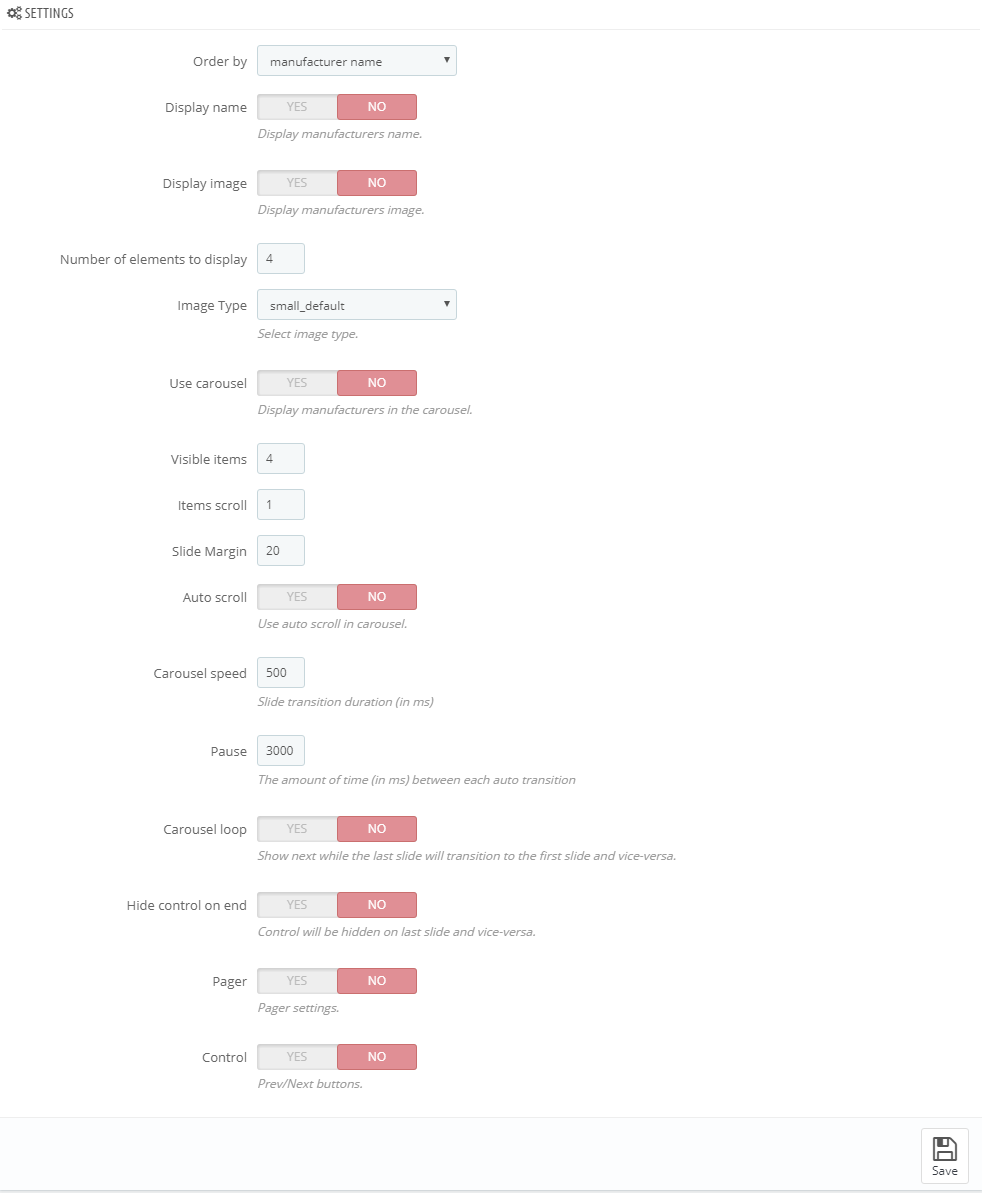
-
- Order by
- type of sorting items of the block.
-
- Display name
- show the manufacturer's name.
-
- Display image
- show the image of the manufacturer.
-
- Number of elements to display
- type the number of elements displayed in the module.
-
- Image Type
- select the image type (you can select the image from the images related to the manufacturer).
-
- Use carousel
- show up the list as a carousel.
-
- * Visible items
- number of visible manufacturers.
-
- * Items scroll
- number of manufacturers shown in one carousel scroll.
-
- * Slide Width
- the width of the element in the carousel.
-
- * Slide Margin
- the margin of the element in the carousel.
-
- * Auto scroll
- automatic scrolling.
-
- * Carousel speed
- speed of the carousel.
-
- * Pause
- pause between scrolls (if "Auto scroll" is enabled).
-
- * Carousel loop
- carousel returns to the beginning when all elements have been scrolled.
-
- * Hide control on end
- hide next/previous buttons.
-
- * Pager
- show pagination.
-
- * Control
- show next/previous buttons.
* - settings are available only if carousel is enabled.
After all options have been set, press 'Save' button (1).
The module supports multi-stores.
JX Media Parallax 2.0.0
This module is designed to let you add a parallax effect to the DOM items of the page. It allows you to create multi-layered parallax. It also provides a possibility to add a custom background video (you can upload it from your computer to server) or add a YouTube video.
JX Media Parallax Main Panel
Main module panel that allows you to add, edit or remove parallax items.

Creating a new parallax item
In order to create a new parallax item, press 'plus' (1) icon, in the top right corner of the main panel.

Then you will see the following form.
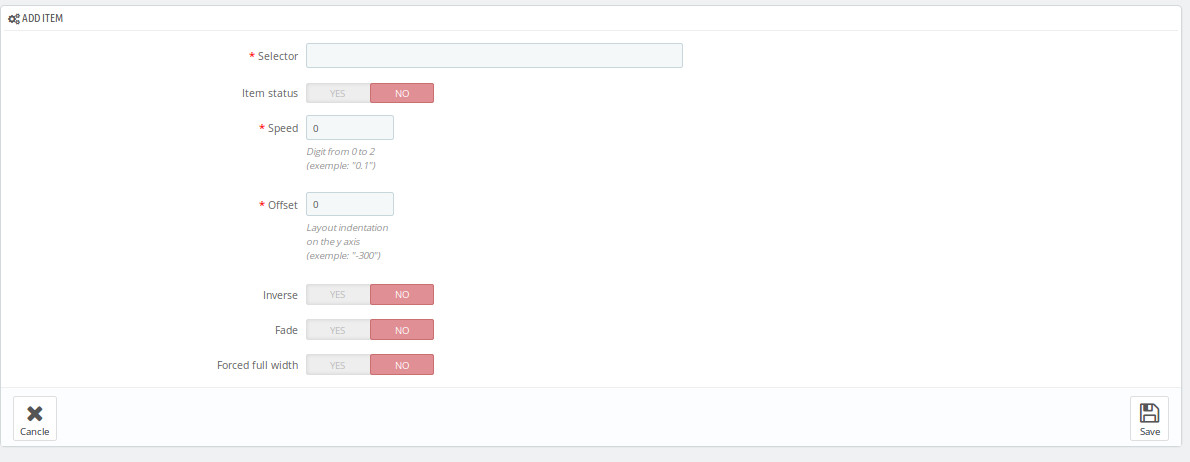
Form options for adding parallax items
- Selector - CSS selector of the item with parallax effect applied. For example, '#header .nav'
- Item status - item status (parallax will not be displayed if it's disabled)
- Speed - digit value from 0 to 2, which defines main parallax block speed
- Offset - main layer indent on the Y axis
- Inverse - parallax direction
- Fade - this option allows to configure main block fade-out on page scroll
- Forced full width - forced full width of the parallax block
Press 'Save' after filling in all the required fields.
Parallax layers list
In order to see the list of parallax layers, you should press 'View' (1) near the main parallax item.

Then you'll see a table, in which the layers are displayed after they are added.

Adding new layer
In order to create a new parallax layer, press 'plus' (1) icon in the top right corner of the layers panel.

Then you will see the following form.

Press 'Save' after filling in all the required fields.
Parallax layers types and their fields
Image-background - image used as a parallax background
- Item status - item status (parallax will not be displayed if it's disabled)
- Layout speed - digit value from 0 to 2, which defines main parallax block speed
- Offset - main layer indent on the Y axis
- Inverse - parallax direction
- Fade - this option allows configuring main block fade-out on page scroll
- Image - link to an image, to which parallax effect will be applied
- Sort order - layout position, relative to the rest of items
Video-background - video used as a parallax background
- Item status - item status (parallax will not be displayed if it's disabled)
- Layout speed - digit value from 0 to 2, which defines main parallax block speed
- Offset - main layer indent on the Y axis
- Inverse - parallax direction
- Fade - this option allows configuring main block fade-out on page scroll
- Image - link to an additional image
- Video parallax mp4 - video in mp4 format
- Video parallax webm - video in webm format
- Sort order - layout position, relative to the rest of items
Text - text layer which position can be defined with CSS
- Item status - item status (parallax will not be displayed if it's disabled)
- Layout speed - digit value from 0 to 2, which defines main parallax block speed
- Offset - main layer indent on the Y axis
- Inverse - parallax direction
- Fade - this option allows configuring main block fade-out on page scroll
- Content - layer content
- Specific class - custom CSS class for this layer
- Sort order - layout position, relative to the rest of items
Youtube-background - YouTube video used as a parallax background
- Item status - item status (parallax will not be displayed if it's disabled)
- Layout speed - digit value from 0 to 2, which defines main parallax block speed
- Offset - main layer indent on the Y axis
- Inverse - parallax direction
- Fade - this option allows configuring main block fade-out on page scroll
- Video id - YouTube video ID
- Sort order - layout position, relative to the rest of items
Image - image layer which position can be defined with CSS
- Item status - item status (parallax will not be displayed if it's disabled)
- Layout speed - digit value from 0 to 2, which defines main parallax block speed
- Offset - main layer indent on the Y axis
- Inverse - parallax direction
- Fade - this option allows configuring main block fade-out on page scroll
- Image - link to an image, to which parallax effect will be applied
- Specific class - custom CSS class for this layer
- Sort order - layout position, relative to the rest of items
Uploading video and images to server
In order to upload video or an image to server via File Manager, first you need to press 'file' (1) icon next to the needed field.

In the following window, in the 'actions' line, choose 'upload' (2).
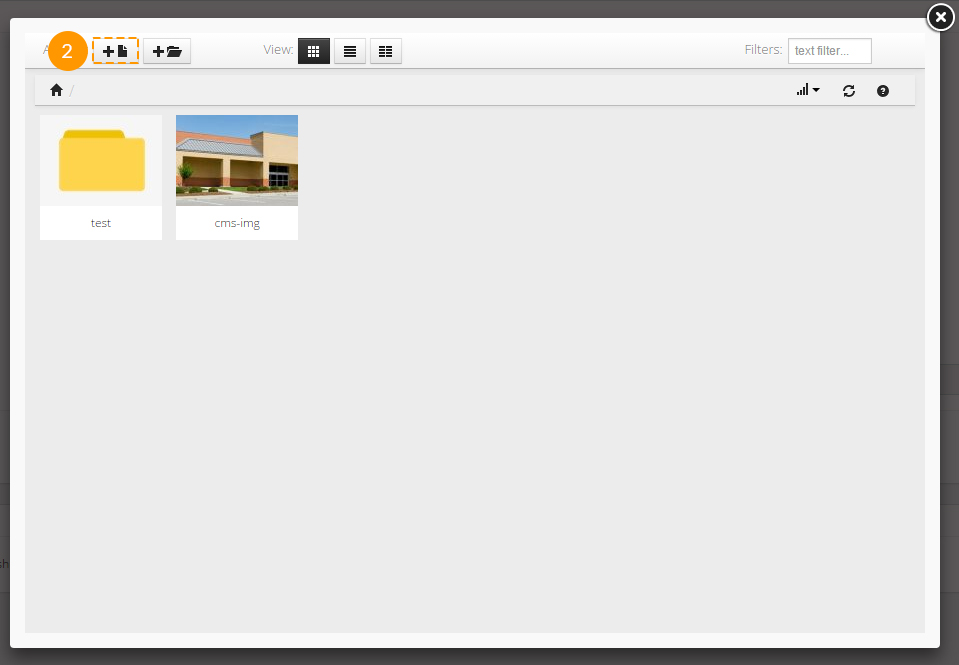
Then you'll see one more pop-up window, to upload image or video file here.
Warnings and recommendations
- Mobile devices (smartphones, tablets) have a parallax effect disabled by default, the uppermost block image layer is used as a background instead
- The forced full width of the parallax block affects page loading speed more critically than a regular full width block loading
- The smaller the size of the uploaded video, the better.
JX Mega Layout 1.1.0
This module is designed to allow creating custom layouts (presets) for hooks and displaying them at site instead of the default positions. This module advantage is allowing you to create different hook markups and modify them up to your needs.
Functional characteristics and features of the module
-
Requirements:
PrestaShop 1.6+
PHP 5.4+
-
Features:
Module includes 5 hooks: 'Header', 'Top Column', 'Home', 'Footer' and 'Product Footer'.
In case module is not present in the hook, it can't be added to the preset.
Module can be displayed in the preset only once, the same as in a hook.
Module position in 'Modules and Services -> Positions' section does not affect the preset.
The module does not allow you to configure different modules. You cannot set different modules configuration for various presets.
Module provides you with an option for changing module position and setting up the grid for 3 hooks: displayTopColumn, displayHome, displayFooter. Changing the modules position in 'Modules and Services -> Positions' section will not affect the modules position in the preset. In case the module was not added to the hook, it can't be added to the preset either.
Integrating module to the theme
Integrating module to the THIRD-PARTY theme your presets won't be displayed at the frontend without this step.
NOTE: for third-party sources only if JX Mega Layout module is not included by default. The codes below have already been integrated into ZEMEZ template.
Header. In order to add custom preset to the Header hook, you need to perform the following steps:
- Open the /templates/_partials/header.tpl file for editing.
- Locate the following code:
{block name='header_banner'} <div class="header-banner"> {hook h='displayBanner'} </div> {/block} {block name='header_nav'} <nav class="header-nav"> <div class="container"> <div class="row"> <div class="hidden-sm-down"> <div class="col-md-5 col-xs-12"> {hook h='displayNav1'} </div> <div class="col-md-7 right-nav"> {hook h='displayNav2'} </div> </div> <div class="hidden-md-up text-sm-center mobile"> <div class="float-xs-left" id="menu-icon"> <i class="material-icons d-inline"></i> </div> <div class="float-xs-right" id="_mobile_cart"></div> <div class="float-xs-right" id="_mobile_user_info"></div> <div class="top-logo" id="_mobile_logo"></div> <div class="clearfix"></div> </div> </div> </div> </nav> {/block} {block name='header_top'} <div class="header-top"> <div class="container"> <div class="row"> <div class="col-md-2 hidden-sm-down" id="_desktop_logo"> <a href="{$urls.base_url}"> <img class="logo img-responsive" src="{$shop.logo}" alt="{$shop.name}"> </a> </div> <div class="col-md-10 col-sm-12 position-static"> {hook h='displayTop'} <div class="clearfix"> </div> </div> </div> <div id="mobile_top_menu_wrapper" class="row hidden-md-up" style="display:none;"> <div class="js-top-menu mobile" id="_mobile_top_menu"> </div> <div class="js-top-menu-bottom"> <div id="_mobile_currency_selector"></div> <div id="_mobile_language_selector"></div> <div id="_mobile_contact_link"></div> </div> </div> </div> </div> {hook h='displayNavFullWidth'} {/block} - And replace it with:
{assign var='displayMegaHeader' value={hook h='jxMegaLayoutHeader'}} {if $displayMegaHeader} {$displayMegaHeader nofilter} {else} {block name='header_banner'} <div class="header-banner"> {hook h='displayBanner'} </div> {/block} {block name='header_nav'} <nav class="header-nav"> <div class="container"> <div class="row"> <div class="hidden-sm-down"> <div class="col-md-5 col-xs-12"> {hook h='displayNav1'} </div> <div class="col-md-7 right-nav"> {hook h='displayNav2'} </div> </div> <div class="hidden-md-up text-sm-center mobile"> <div class="float-xs-left" id="menu-icon"> <i class="material-icons d-inline"> </i> </div> <div class="float-xs-right" id="_mobile_cart"></div> <div class="float-xs-right" id="_mobile_user_info"></div> <div class="top-logo" id="_mobile_logo"></div> <div class="clearfix"></div> </div> </div> </div> </nav> {/block} {block name='header_top'} <div class="header-top"> <div class="container"> <div class="row"> <div class="col-md-2 hidden-sm-down" id="_desktop_logo"> <a href="{$urls.base_url}"> <img class="logo img-responsive" src="{$shop.logo}" alt="{$shop.name}"> </a> </div> <div class="col-md-10 col-sm-12 position-static"> {hook h='displayTop'} <div class="clearfix"></div> </div> </div> <div id="mobile_top_menu_wrapper" class="row hidden-md-up" style="display:none;"> <div class="js-top-menu mobile" id="_mobile_top_menu"></div> <div class="js-top-menu-bottom"> <div id="_mobile_currency_selector"></div> <div id="_mobile_language_selector"></div> <div id="_mobile_contact_link"></div> </div> </div> </div> </div> {hook h='displayNavFullWidth'} {/block} {/if}
Top column. In order to add custom preset to the topColumn hook, you need to perform the following steps:
- Open the /templates/_partials/header.tpl file for editing.
- Locate the following code
{hook h="displayNavFullWidth"} - And replace it with:
{hook h="displayNavFullWidth"} {assign var='displayMegaTopColumn' value={hook h='jxMegaLayoutTopColumn'}} {if $displayMegaTopColumn} {$displayMegaTopColumn nofilter} {/if}
Home. In order to add custom preset to the Home hook, you need to perform the following steps:
- Open the /templates/layouts/layout-both-columns.tpl file for editing.
- Locate the following code:
<section id="wrapper"> {hook h="displayWrapperTop"} <div class="container"> {block name="breadcrumb"} {include file='_partials/breadcrumb.tpl'} {/block} {block name="left_column"} <div id="left-column" class="col-xs-12 col-sm-4 col-md-3"> {if $page.page_name == 'product'} {hook h='displayLeftColumnProduct'} {else} {hook h="displayLeftColumn"} {/if} </div> {/block} {block name="content_wrapper"} <div id="content-wrapper" class="left-column right-column col-sm-4 col-md-6"> {hook h="displayContentWrapperTop"} {block name="content"} <p> Hello world! This is HTML5 Boilerplate.</p> {/block} {hook h="displayContentWrapperBottom"} </div> {/block} {block name="right_column"} <div id="right-column" class="col-xs-12 col-sm-4 col-md-3"> {if $page.page_name == 'product'} {hook h='displayRightColumnProduct'} {else} {hook h="displayRightColumn"} {/if} </div> {/block} </div> {hook h="display wrapperBottom"} </section> - And replace it with:
<section id="wrapper"> {assign var='displayMegaHome' value={hook h='jxMegaLayoutHome'}} {if $page.page_name == 'index' && $displayMegaHome} {$displayMegaHome nofilter} {else} {hook h="displayWrapperTop"} <div class="container"> {block name="breadcrumb"} {include file='_partials/breadcrumb.tpl'} {/block} {block name="left_column"} <div id="left-column" class="col-xs-12 col-sm-4 col-md-3"> {if $page.page_name == 'product'} {hook h='displayLeftColumnProduct'} {else} {hook h="displayLeftColumn"} {/if} </div> {/block} {block name="content_wrapper"} <div id="content-wrapper" class="left-column right-column col-sm-4 col-md-6"> {hook h="displayContentWrapperTop"} {block name="content"} <p>Hello world! This is HTML5 Boilerplate.</p> {/block} {hook h="displayContentWrapperBottom"} </div> {/block} {block name="right_column"} <div id="right-column" class="col-xs-12 col-sm-4 col-md-3"> {if $page.page_name == 'product'} {hook h='displayRightColumnProduct'} {else} {hook h="displayRightColumn"} {/if} </div> {/block} </div> {hook h="displayWrapperBottom"} {/if} </section>
Footer. In order to add custom preset to the Footer hook, you need to perform the following steps:
- Open the /templates/layouts/layout-both-columns.tpl file for editing.
- Locate the following code:
{block name="footer"} {include file="_partials/footer.tpl"} {/block} - And replace it with:
{assign var='displayMegaFooter' value={hook h='jxMegaLayoutFooter'}} {if $displayMegaFooter} {$displayMegaFooter nofilter} {else} <div class="container"> {block name="footer"} {include file="_partials/footer.tpl"} {/block} </div> {/if}
Product footer. In order to add custom preset to the Product footer hook, you need to perform the following steps:
- Open the /templates/catalog/product.tpl file for editing.
- Locate the following code:
{block name='product_footer'} {hook h='displayFooterProduct' product=$product category=$category} {/block} - And replace it with:
{block name='product_footer'} {assign var='displayMegaProductFooter' value={hook h='jxMegaLayoutProductFooter' product=$product category=$category}} {if $displayMegaProductFooter} {$displayMegaProductFooter nofilter} {else} {hook h='displayFooterProduct' product=$product category=$category} {/if} {/block}
Hooks
The module has 5 hooks available by default:
- 'Header' is a hook that combines 2 standard hooks: displayNav and displayTop. This hook corresponds to the website header.
- 'Top Column' corresponds to the original displayTopColumn hook. This hook comes right after the Header hook.
- 'Home' corresponds to the original displayHome hook. This hook is present only on the main page.
- 'Footer' corresponds to the original displayFooter hook.
- 'Product Footer' corresponds to the original displayFooterProduct hook, which is displayed in product page footer.
JX Mega Layout Main Panel
Main Layouts
The main JX Mega Layout module configuration panel that allows you to add a preset to the required hook and configure the preset.

Adding the preset
-
Press '+ Add Preset' (1) in the needed tab.

-
Next, fill in the 'Enter layout name' field in the popup typing the new preset (2) title there and press 'Save' (3).
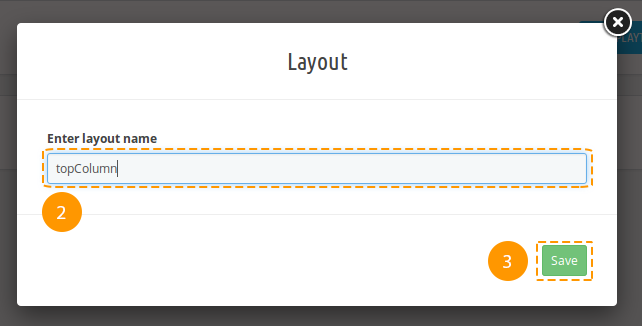
-
Preset was successfully created, it's listed among the available presets (4) now. Newly created preset is selected for editing (5).

Preset activation
-
First of all, select the needed preset from the list (1).

-
Press the 'Use as default' (2) switcher.

-
The preset was activated. If you need to display this preset only on some pages, open the drop-down (3) and select the pages you need. To apply changes, click outside the list area. A preset that is displayed on all pages will be marked with a filled star in the presets list, and the one that is displayed only on some pages will be marked with a partially filled star.

Removing the preset
There is no option to restore the preset after removing.
-
In order to remove the preset, choose the required preset among the list (1).

-
Next, press a cart (2) near the preset title.

-
Preset was successfully removed.
Renaming the preset
-
In order to rename the preset, choose the required preset among the list (1).

-
Next, press a pencil icon (2) next to the preset title.

-
Specify the new preset title (3) in a popup and press 'Rename layout' (4).
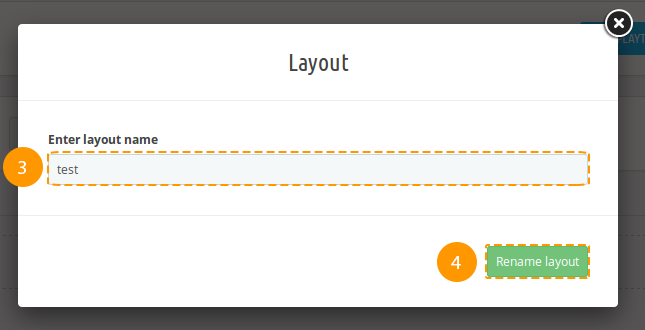
-
Preset was successfully renamed.
Wrapper
Wrapper has no class by default, it's not a mandatory item.
Adding the wrapper
-
In order to create a wrapper, press '+ Add wrapper' (1).

-
Wrapper was added (2).

Adding the custom CSS class to the wrapper
Adding the custom class will let you create a specific styling for your wrapper by using CSS rules.
-
In order to add wrapper class, press the button (1).

-
You'll see a pop-up window, fill in the 'Enter wrapper classes' (2) field there and press a 'Confirm' (3) button.
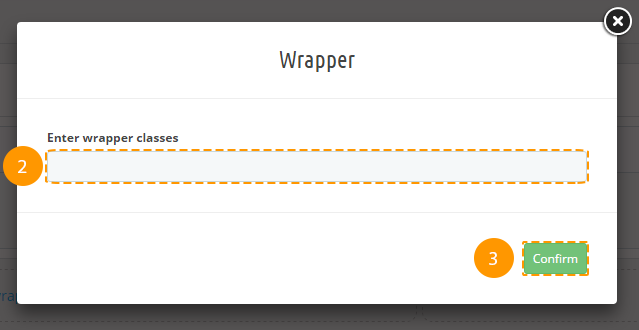
-
Custom class was added successfully.
Deleting the wrapper
Deleting the preset item will also cause all of its child items and their styles removing.
-
In order to remove the wrapper, press the cart button (1).

-
Wrapper was removed successfully.
Styling the wrapper
-
In order to add custom styles to the wrapper, press the 'pencil' (1) icon in the wrapper block.

-
In the following pop-up window fill in all the needed fields (you may refer to the documentation 'Styling' section), and press 'Save' (2) button.
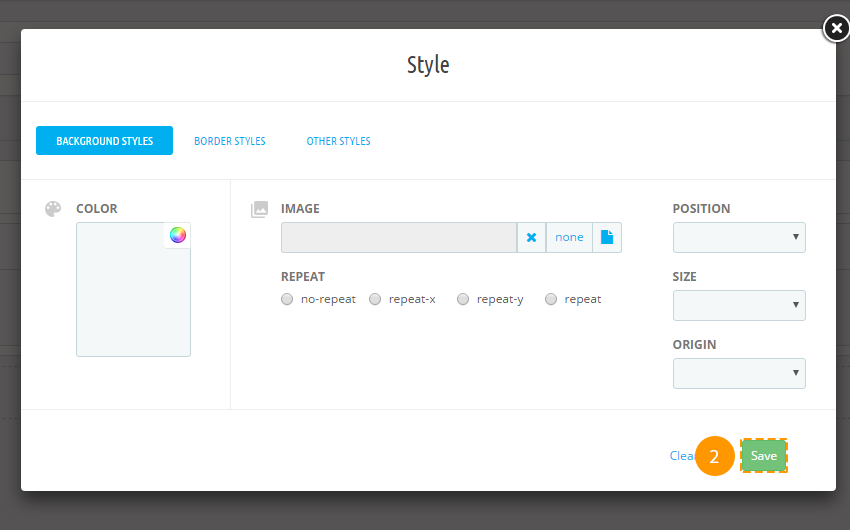
-
If all the fields are filled in correctly, styles will be saved.
Row
Row item from the Bootstrap grid. It's a required item.
Adding the row
-
In order to insert a new row, press '+ Add row' (1) into the wrapper block, or '+ Add row' (2) in the main preset block, or '+ Add row' (3) in the column drop-down list.

-
The row was added successfully.
Adding custom CSS class to the row
Custom class adding allows you to create custom row styling using CSS rules.
-
In order to add the class to the row, you should press the 'ellipsis' button (1).

-
Choose the 'Edit row' (2) in a drop-down list.

-
Fill in the 'Enter row classes' (3) field in the pop-up window and press 'Confirm' (4) button.
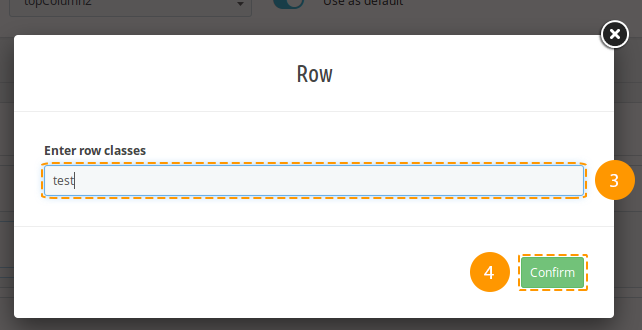
-
Custom class was added successfully.
Deleting the row
Removal of preset item will also cause removal of its child items and their styles.
-
In order to remove the row, open the menu (the 'ellipsis' icon) in the row block.

-
Choose 'Delete' (2) option in the drop-down.

-
The row was successfully removed.
Adding styles to the row
-
In order to add row styles, open the menu (the 'ellipsis' icon) (1) in a row block.

-
Press 'Stylize' (2) in the drop-down.

-
You will see the pop-up window, fill in all the needed fields there (you may refer to the documentation 'Styling' section) and press 'Save' (3) button.
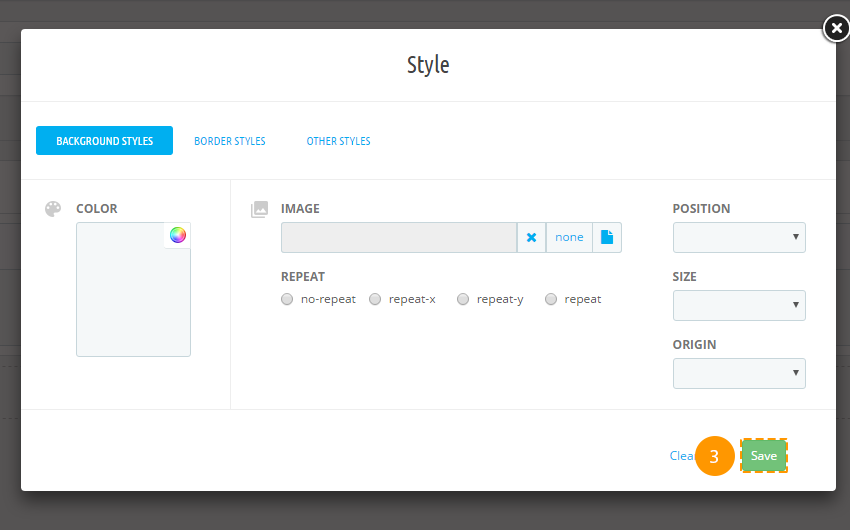
-
If all the fields are filled in correctly, styles will be saved.
Column
It is an item with configurable block width for different dimensions, based on Bootstrap grid.
Adding the column
-
In order to insert a column into a needed 'row', open the menu (the 'ellipsis' icon) (1)

-
Choose the '+ Add Col' (2) among the list.

-
Fill in the fields (col-xs*, col-sm*, col-md*, col-lg - bootstrap classes) in the pop-up window and press 'Confirm' (3) button.
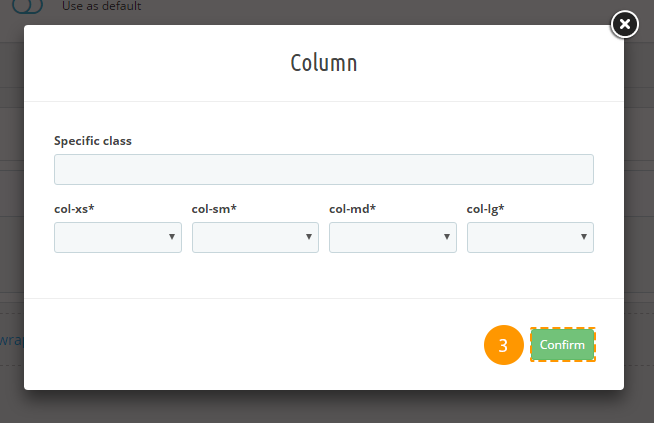
-
The column was added successfully.
Removing the column
Preset item removing will also cause its child items and their styles deleting.
-
In order to remove the column, open the menu (the 'ellipsis' icon) in a column block (1)

-
Press 'Delete' (2) in the list.

-
The column and all of its child items were removed.
Editing the column
-
In order to edit the column, open the menu (the 'ellipsis' icon) (1) in the column block.

-
Press 'Edit column' (2) in the list.

-
Fill in the fields (col-xs*, col-sm*, col-md*, col-lg - bootstrap classes) in the pop-up window and press 'Confirm'.
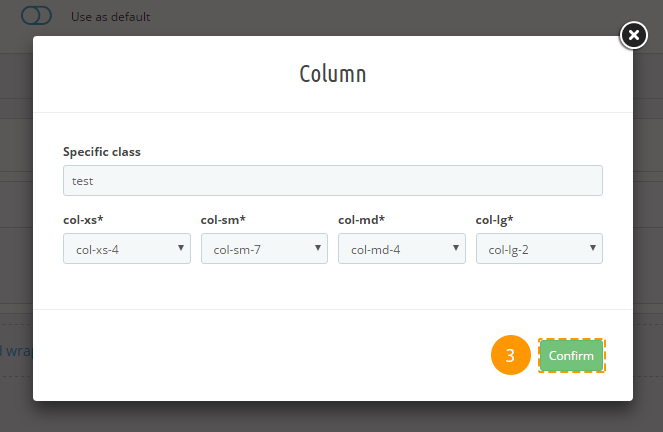
-
The column was successfully edited.
Adding styles to the column
-
In order to add column styles, open the menu (the 'ellipsis' icon) (1) in a column block.

-
Press 'Stylize' (2) in the list of options.

-
You will see the pop-up window, fill in all the needed fields there (you may refer to the documentation 'Styling' section) and press 'Save' (3) button.
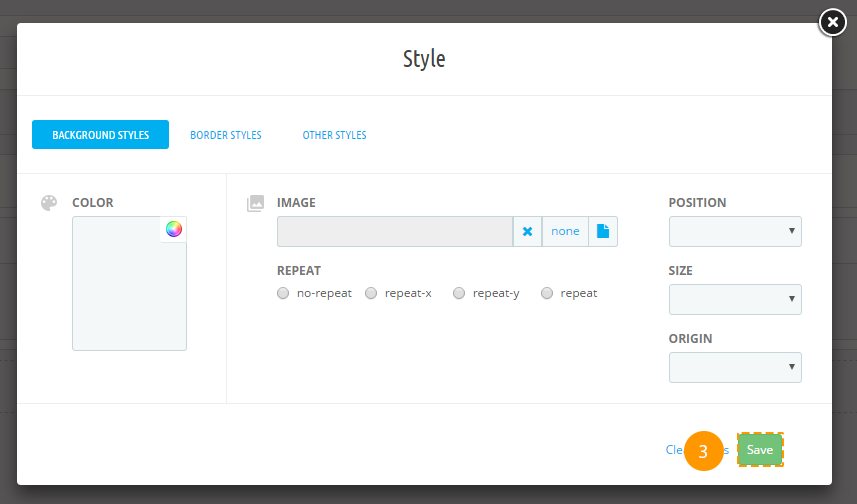
-
If all the fields are filled in correctly, styles will be saved.
Module
Module assigned to this hook.
Adding the module
Be careful when adding modules to the preset, some modules are desirable to use if they do not change the visible layout, e.g., 'Data mining for statistics' module.
-
In order to add the module to the preset in a column block, open the menu (the 'ellipsis' icon) (1).

-
Press the '+ Add Module' (2) in the list of options available.

-
If needed, you can enter the custom class (3) in the pop-up window and select the module (4), next press 'Confirm' (5).
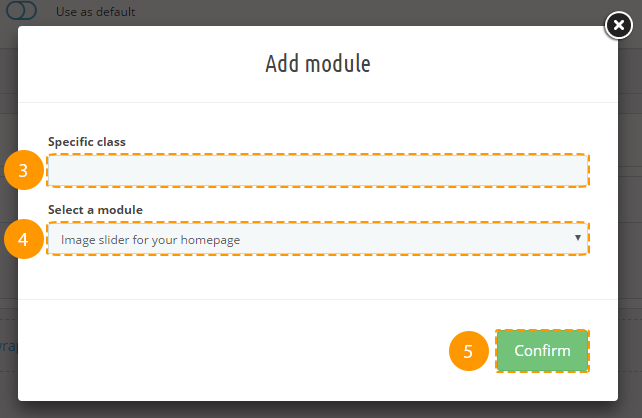
-
The module was successfully added.
-
In this version of JX Mega Layout you can add 'Homepage tabs' module in Home hook.

It can also be customized like all other modules in Mega Layout.
Deleting the module
Removal of preset item will also cause removal of its child items and their styles.
-
In order to remove the module, open the menu (the 'ellipsis' icon) (1) in the module block.

-
Press 'Delete' (2) in the list of options available.

-
The module is removed.
Adding custom class to the module
Custom class adding allows to create module styling using CSS rules.
-
In order to specify custom class for the module, open the menu in the module block (the 'ellipsis' icon) (1).

-
Press 'Edit Settings' (2) then.

-
Specify custom class (3) in the pop-up window and press 'Confirm' (4) button.

-
Custom class was added.
Logo, Copyright
Logo and Copyright blocks are edited the same way as modules, except for the fact that Logo can be placed only in Header or Footer position, and the Copyright block can be placed only in Footer position.
Product Page
Product Info tab
By means of this tab you can switch the layouts of product page. It will appear in the admin panel after making some simple actions described below.
Creating layout
Layouts are created and edited manually.
Create folder 'product_pages' in your theme folder.

- In theme folder find the file 'product.tpl', copy it to the created folder 'product_pages' and rename to 'default.tpl'. To create several layouts - duplicate this file, rename it (e.g. 'layout_1.tpl', 'layout_2.tpl') and change the structure according to your needs.
- Create file 'config.json' in this folder. Copy the following code into it:
{ "default": { "name": "Default", "preview": "default.jpg", "default": 1 } }- "default" - name of .tpl file containing the product page structure.
- "name": "Default" - title of product page layout in module settings.
- "preview": "default.jpg" - preview picture of product page layout in module settings; image should be located in 'product_pages' folder.
"default": 1 - set to '1' if the layout should be set as default
One of the layouts should contain '1' value to be set as default.
This code should be duplicated for each created layout, and contain corresponding values. For example:
{ "default": { "name": "Default", "preview": "default.jpg", "default": 0 }, "layout_1": { "name": "Layout 1", "preview": "layout_1.jpg", "default": 0 }, "layout_2": { "name": "Layout 2", "preview": "layout_2.jpg", "default": 1 } } - Open the 'product.tpl' file in the theme folder. Delete everything and paste the following code:
{include file="$tpl_dir./errors.tpl"} {if $errors|@count == 0} {if isset($megalayoutProductInfoPage) && $megalayoutProductInfoPage} {assign var='path' value="./product_pages/`$megalayoutProductInfoPage`"} {include file=$path} {else} {include file='./product_pages/default.tpl'} {/if} {/if} - To add/edit styles of any product page layout, go to your_theme_folder/css/ and add new folder 'product_pages'. In this folder create file with the layout name and .css extension (e.g. 'default.css', 'layout_1.css', 'layout_2.css'). These files should contain styles of the corresponding product page layout.
- To add scripts to any product page layout, go to your_theme_folder/js/ and add new folder 'product_pages'. In this folder create file with the layout name and .js extension (e.g. 'default.js', 'layout_1.js', 'layout_2.js'). These files should contain scripts of the corresponding product page layout.
Switching layouts
Select 'Product Page' from the drop-down list (1) and click the 'Product Info' tab (2).

In this tab you can switch the layouts of product page. The layout image with the gray border is set as default.
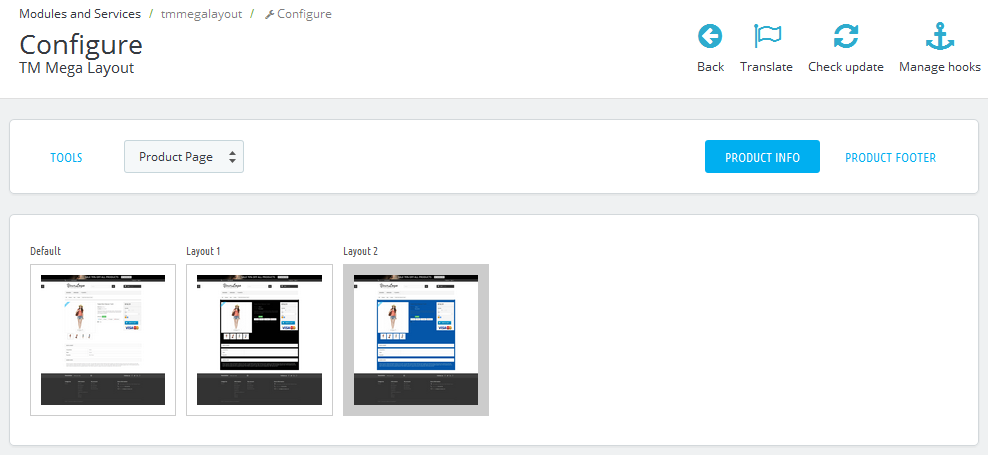
Presets export
Export tool allows you to export presets for the further import into different shops.
-
Navigate to the 'Tools' (1) tab in the main configurations panel.

-
Choose 'Export' (2) in the form.

-
You'll see the list of the existing presets in site hooks.
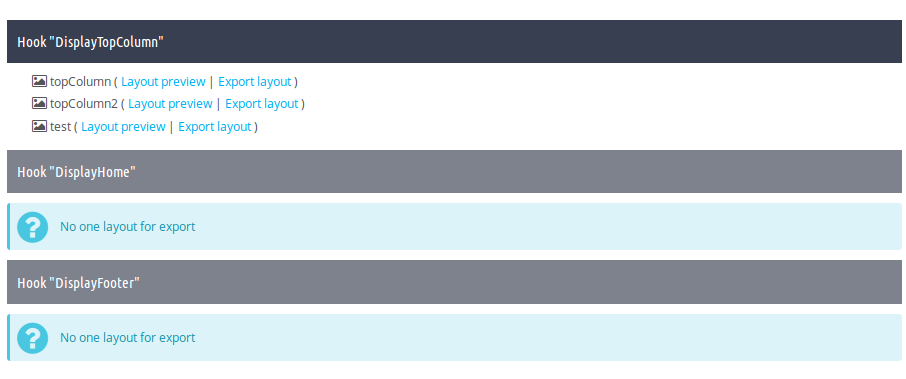
-
In order to preview the preset, press 'Layout preview' (3) button next to the preset you need, in order to export, please press 'Export layout' (4) button.

-
Then you'll be able to download this preset as a zip archive.
Preset import
Import tool accepts only the presets *.zip files that were previously generated with the same module Export tool.
-
In order to import your preset, you should open the Tools (1) tab and choose 'Import' (2).

-
Next, press the Add file (3) button and select the zip file of your exported preset. In case this archive is the exported preset, you will see this preset preview.

-
If this preset meets your needs, press 'Import' (4). The preset will be imported and added to the list of available presets.
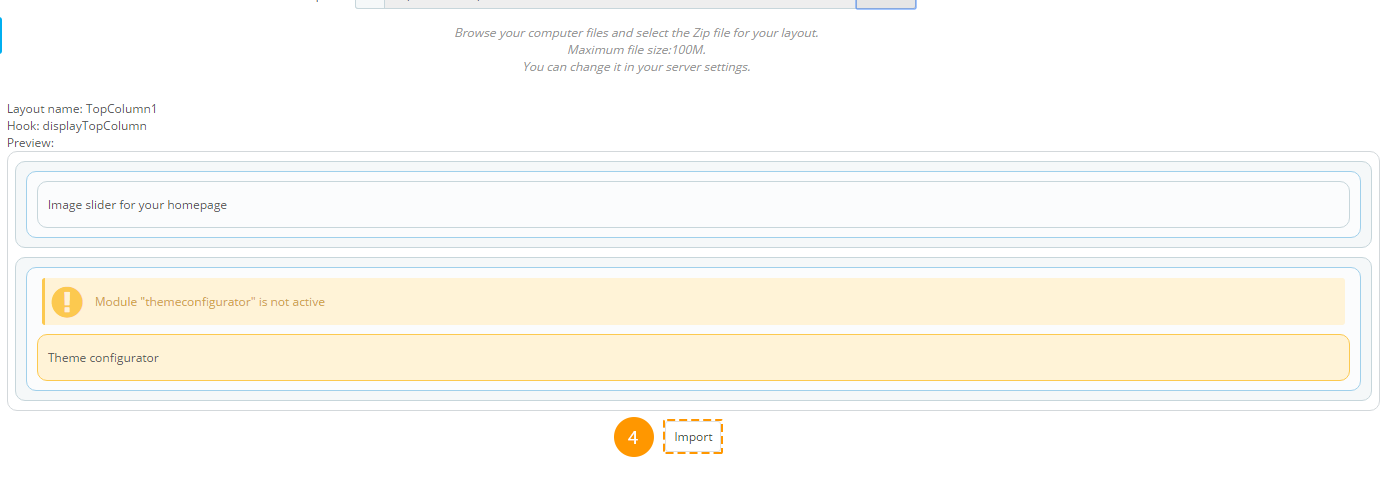
Reset
'Reset' reverts all the presets to initial state (to the way they came with the template), and discards all the created presets.
Attention! After reverting presets to default state, all the custom presets will be discarded!
-
To reset presets, navigate to the 'Tools' (1) tab. In the appeared block open the 'Options' (2) tab.

-
Press the 'Reset' button.

-
That's it! All presets are reset to initial state.
Styles and Scripts Optimization
Styles and scripts optimization adds exclusions for modules in Header section, based on their use in presets. This allows speeding up the page loading speed. Optimization works in test mode.
Enabling optimization:
-
To enable optimization, open the 'Tools' (1) tab and select the 'Options' (2) tab.

-
In the appeared window, you can enable optimization (3).

If optimization is enabled when editing and enabling presets, optimization gets discarded, but you'll see a window offering to run optimization. There is no need to optimize scripts and styles every time you change presets. It's better to optimize them when you're done editing.

Styling
-
Background styles. Fields description:
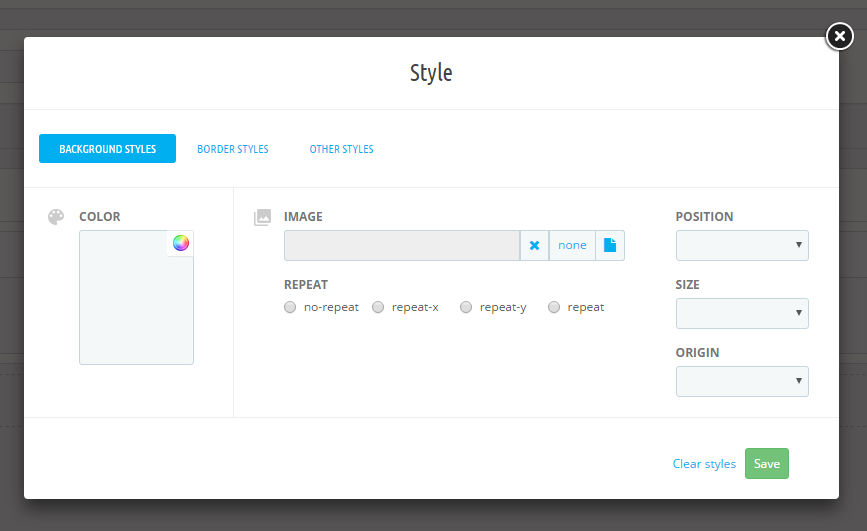
- background-image (background image) - the image URL or 'none' value. The image is picked from the ~/images/cms/ folder.
- background-color (background color) - the value can be set in any color format (rgb, hex, etc.). You can choose the color using the Color Picker tool.
- background-repeat (background repeat) - all the available options are listed in the radio buttons.
- background-position (background position) - all the available options are listed in the drop-down.
- background-size (background size) - all the available options are listed in the drop-down.
- background-origin (background image positioning region) - all the available options are listed in the drop-down.
Border styles.
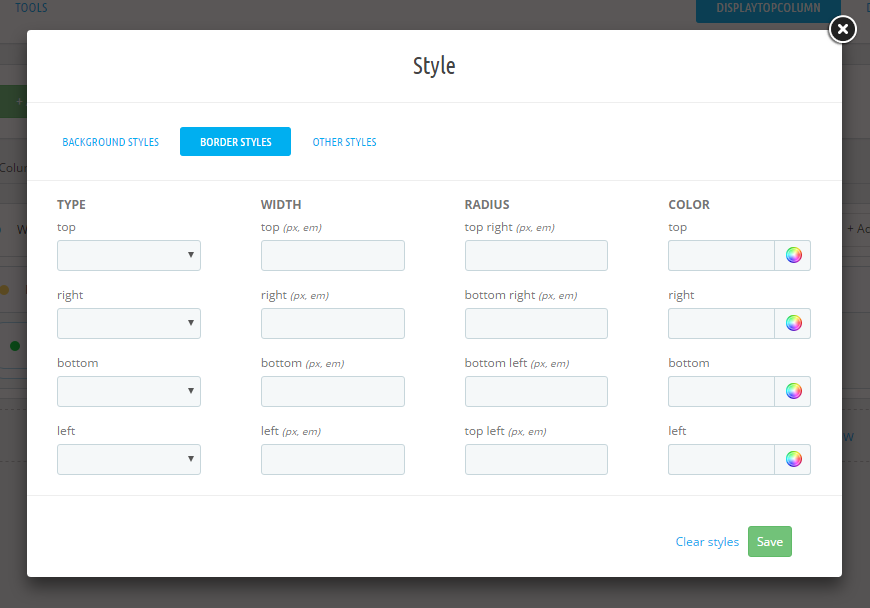
- border-top-style, border-right-style, border-left-style, border-bottom-style (border styles) - all the available options are listed in the drop-down.
- border-top-width, border-right-width, border-left-width, border-bottom-width (borders width) - should be set in pixels.
- border-top-сolor, border-right-color, border-left-color, border-bottom-color (borders color) - the value can be set in any color format (rgb, hex, etc.). You can choose the color using the Color Picker tool.
- border-top-right-radius, border-top-left-radius, border-bottom-right-radius, border-bottom-left-radius (border radius) - should be set in pixels.
Other styles.
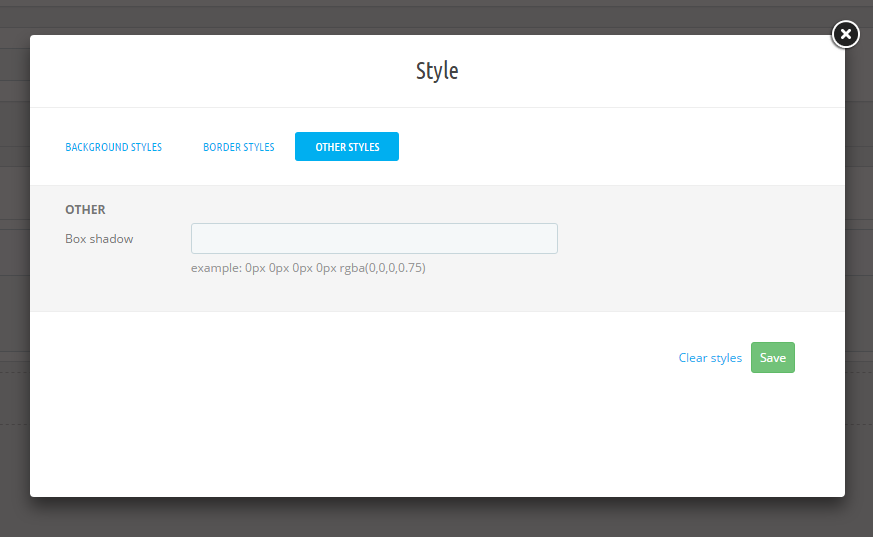
- box-shadow (box shadow) - example:0px 0px 0px 0px rgba(0,0,0,0.75).
Items styles removing
-
In order to remove items styles, open the items styling section and press 'Clear styles' (1)
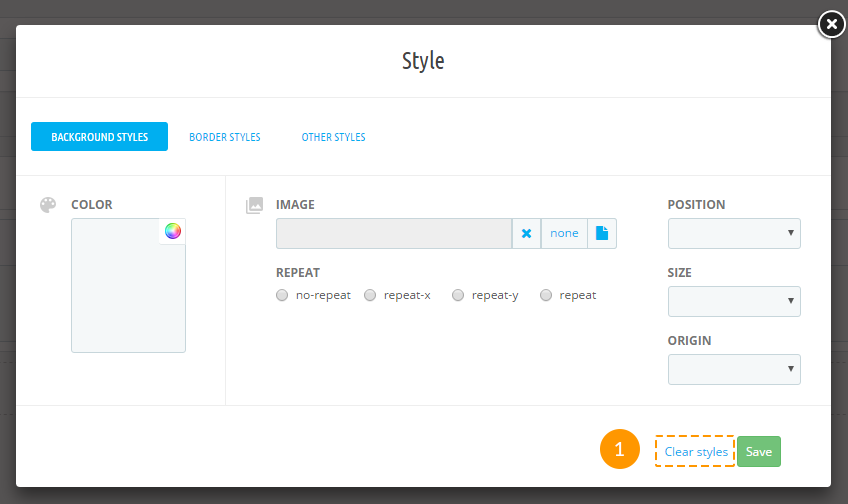
Warnings
If the following message appears in the module item block, you should enable the mentioned module.

If the following message appears in the module item block, you should install the mentioned module.

In case you remove or deactivate the 'JX Mega Layout' module, all the active presets will be disabled and you will see the positions (hooks) in their original appearance.
JX Mega Layout 1.5.0
The module allows building multiple homepage layouts (presets) for hooks. This module advantage is allowing you to create different hook markups and modify them up to your needs.
Module requirements
PrestaShop 1.7+
PHP 5.4+
Hooks
The module has 5 hooks available by default:
- 'Header' is a hook that combines such standard hooks: displayTop, displayNav, displayNav1, displayNav2. This hook corresponds to the website header.
- 'Top Column' corresponds to the displayTopColumn and displayNavFullWidth hooks. This hook comes right after the Header hook.
- 'Home' corresponds to such hooks: displayHome, displayWrapperTop, displayWrapperBottom, displayContentWrapperTop, displayLeftColumn, displayRightColumn. This hook is present only on the main page.
- 'Footer' corresponds to the displayFooterBefore, displayFooter and displayFooterAfter hooks.
- 'Product Footer' corresponds to the original displayFooterProduct hook, which is displayed in product page footer.
Integrating module to the theme
Integrating module to the THIRD-PARTY theme your presets won't be displayed at the frontend without this step.
NOTE: for third-party sources only if JX Mega Layout module is not included by default. The codes below have already been integrated into ZEMEZ template.
Header. In order to add custom preset to the Header hook, you need to perform the following steps:
- Open the /templates/_partials/header.tpl file for editing.
- Locate the following code:
{block name='header_banner'} <div class="header-banner"> {hook h='displayBanner'} </div> {/block} {block name='header_nav'} <nav class="header-nav"> <div class="container"> <div class="row"> <div class="hidden-sm-down"> <div class="col-md-5 col-xs-12"> {hook h='displayNav1'} </div> <div class="col-md-7 right-nav"> {hook h='displayNav2'} </div> </div> <div class="hidden-md-up text-sm-center mobile"> <div class="float-xs-left" id="menu-icon"> <i class="material-icons d-inline"></i> </div> <div class="float-xs-right" id="_mobile_cart"></div> <div class="float-xs-right" id="_mobile_user_info"></div> <div class="top-logo" id="_mobile_logo"></div> <div class="clearfix"></div> </div> </div> </div> </nav> {/block} {block name='header_top'} <div class="header-top"> <div class="container"> <div class="row"> <div class="col-md-2 hidden-sm-down" id="_desktop_logo"> <a href="{$urls.base_url}"> <img class="logo img-responsive" src="{$shop.logo}" alt="{$shop.name}"> </a> </div> <div class="col-md-10 col-sm-12 position-static"> {hook h='displayTop'} <div class="clearfix"> </div> </div> </div> <div id="mobile_top_menu_wrapper" class="row hidden-md-up" style="display:none;"> <div class="js-top-menu mobile" id="_mobile_top_menu"> </div> <div class="js-top-menu-bottom"> <div id="_mobile_currency_selector"></div> <div id="_mobile_language_selector"></div> <div id="_mobile_contact_link"></div> </div> </div> </div> </div> {hook h='displayNavFullWidth'} {/block} - And replace it with:
{assign var='displayMegaHeader' value={hook h='jxMegaLayoutHeader'}} {if $displayMegaHeader} {$displayMegaHeader nofilter} {else} {block name='header_banner'} <div class="header-banner"> {hook h='displayBanner'} </div> {/block} {block name='header_nav'} <nav class="header-nav"> <div class="container"> <div class="row"> <div class="hidden-sm-down"> <div class="col-md-5 col-xs-12"> {hook h='displayNav1'} </div> <div class="col-md-7 right-nav"> {hook h='displayNav2'} </div> </div> <div class="hidden-md-up text-sm-center mobile"> <div class="float-xs-left" id="menu-icon"> <i class="material-icons d-inline"> </i> </div> <div class="float-xs-right" id="_mobile_cart"></div> <div class="float-xs-right" id="_mobile_user_info"></div> <div class="top-logo" id="_mobile_logo"></div> <div class="clearfix"></div> </div> </div> </div> </nav> {/block} {block name='header_top'} <div class="header-top"> <div class="container"> <div class="row"> <div class="col-md-2 hidden-sm-down" id="_desktop_logo"> <a href="{$urls.base_url}"> <img class="logo img-responsive" src="{$shop.logo}" alt="{$shop.name}"> </a> </div> <div class="col-md-10 col-sm-12 position-static"> {hook h='displayTop'} <div class="clearfix"></div> </div> </div> <div id="mobile_top_menu_wrapper" class="row hidden-md-up" style="display:none;"> <div class="js-top-menu mobile" id="_mobile_top_menu"></div> <div class="js-top-menu-bottom"> <div id="_mobile_currency_selector"></div> <div id="_mobile_language_selector"></div> <div id="_mobile_contact_link"></div> </div> </div> </div> </div> {hook h='displayNavFullWidth'} {/block} {/if}
Top column. In order to add custom preset to the topColumn hook, you need to perform the following steps:
- Open the /templates/_partials/header.tpl file for editing.
- Locate the following code
{hook h="displayNavFullWidth"} - And replace it with:
{assign var='displayMegaTopColumn' value={hook h='jxMegaLayoutTopColumn'}} {if $displayMegaTopColumn} {$displayMegaTopColumn nofilter} {/if}
Home. In order to add custom preset to the Home hook, you need to perform the following steps:
- Open the /templates/layouts/layout-both-columns.tpl file for editing.
- Locate the following code:
<section id="wrapper"> {hook h="displayWrapperTop"} <div class="container"> {block name="breadcrumb"} {include file='_partials/breadcrumb.tpl'} {/block} {block name="left_column"} <div id="left-column" class="col-xs-12 col-sm-4 col-md-3"> {if $page.page_name == 'product'} {hook h='displayLeftColumnProduct'} {else} {hook h="displayLeftColumn"} {/if} </div> {/block} {block name="content_wrapper"} <div id="content-wrapper" class="left-column right-column col-sm-4 col-md-6"> {hook h="displayContentWrapperTop"} {block name="content"} <p> Hello world! This is HTML5 Boilerplate.</p> {/block} {hook h="displayContentWrapperBottom"} </div> {/block} {block name="right_column"} <div id="right-column" class="col-xs-12 col-sm-4 col-md-3"> {if $page.page_name == 'product'} {hook h='displayRightColumnProduct'} {else} {hook h="displayRightColumn"} {/if} </div> {/block} </div> {hook h="display wrapperBottom"} </section> - And replace it with:
<section id="wrapper"> {assign var='displayMegaHome' value={hook h='jxMegaLayoutHome'}} {if $page.page_name == 'index' && $displayMegaHome} {$displayMegaHome nofilter} {else} {hook h="displayWrapperTop"} <div class="container"> {block name="breadcrumb"} {include file='_partials/breadcrumb.tpl'} {/block} {block name="left_column"} <div id="left-column" class="col-xs-12 col-sm-4 col-md-3"> {if $page.page_name == 'product'} {hook h='displayLeftColumnProduct'} {else} {hook h="displayLeftColumn"} {/if} </div> {/block} {block name="content_wrapper"} <div id="content-wrapper" class="left-column right-column col-sm-4 col-md-6"> {hook h="displayContentWrapperTop"} {block name="content"} <p>Hello world! This is HTML5 Boilerplate.</p> {/block} {hook h="displayContentWrapperBottom"} </div> {/block} {block name="right_column"} <div id="right-column" class="col-xs-12 col-sm-4 col-md-3"> {if $page.page_name == 'product'} {hook h='displayRightColumnProduct'} {else} {hook h="displayRightColumn"} {/if} </div> {/block} </div> {hook h="displayWrapperBottom"} {/if} </section>
Footer. In order to add custom preset to the Footer hook, you need to perform the following steps:
- Open the /templates/layouts/layout-both-columns.tpl file for editing.
- Locate the following code:
{block name="footer"} {include file="_partials/footer.tpl"} {/block} - And replace it with:
{assign var='displayMegaFooter' value={hook h='jxMegaLayoutFooter'}} {if $displayMegaFooter} {$displayMegaFooter nofilter} {else} <div class="container"> {block name="footer"} {include file="_partials/footer.tpl"} {/block} </div> {/if}
Product footer. In order to add custom preset to the Product footer hook, you need to perform the following steps:
- Open the /templates/catalog/product.tpl file for editing.
- Locate the following code:
{block name='product_footer'} {hook h='displayFooterProduct' product=$product category=$category} {/block} - And replace it with:
{block name='product_footer'} {assign var='displayMegaProductFooter' value={hook h='jxMegaLayoutProductFooter' product=$product category=$category}} {if $displayMegaProductFooter} {$displayMegaProductFooter nofilter} {else} {hook h='displayFooterProduct' product=$product category=$category} {/if} {/block}
Module configuration
After JX Mega Layout module installation, you can configure it by clicking the Configure button (2).
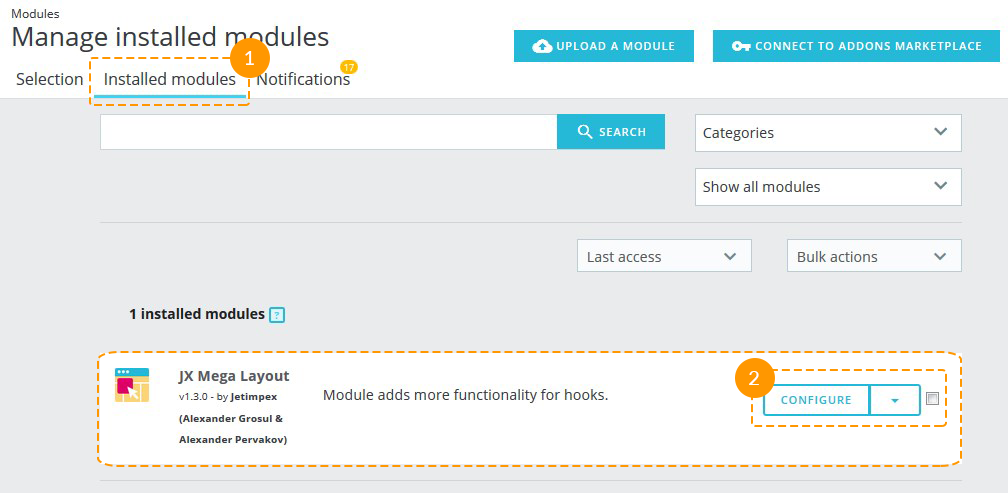
JX Mega Layout Main Panel
Main Layouts
On the main JX Mega Layout module configuration page you are allowed to create Main Layouts and Product Page, add a preset to the required hook and configure it correspondingly.

In Main Layouts, four hooks are available: Header, Top Column, Home, Footer.

In Product Page - Product Footer hook is available.

Adding the preset
-
Press '+ Add a Preset' (1) in the needed tab.

-
Next, fill in the 'Enter layout name' field in the popup typing the new preset (2) title there and press 'Save' (3).

-
Preset was successfully created, it's listed among the available presets (4) now. Newly created preset is selected for editing (5).

Preset activation
-
First of all, select the needed preset from the list (1).

-
Press the 'Use as default' (2) switcher.

-
The preset was activated. If you need to display this preset only on some pages, open the drop-down (3) and select the pages you need. To apply changes, click outside the list area. A preset that is displayed on all pages will be marked with a filled star in the presets list, and the one that is displayed only on some pages will be marked with a partially filled star.

Removing the preset
There is no option to restore the preset after removing.
-
In order to remove the preset, choose the required preset among the list (1).

-
Next, press a cart (2) near the preset title.

-
Preset was successfully removed.
Renaming the preset
-
In order to rename the preset, choose the required preset among the list (1).

-
Next, press a pencil icon (2) next to the preset title.

-
Specify the new preset title (3) in a popup and press 'Rename layout' (4).

-
Preset was successfully renamed.
Wrapper
Wrapper has no class by default, it's not a mandatory item.
Adding the wrapper
-
In order to create a wrapper, press '+ Add wrapper' (1).

-
Wrapper was added (2).

Adding the custom CSS class to the wrapper
Adding the custom class will let you create a specific styling for your wrapper by using CSS rules.
-
In order to add wrapper class, press the button (1).

-
You'll see a pop-up window, fill in the 'Enter wrapper classes' (2) field there and press a 'Confirm' (3) button.

-
Custom class was added successfully.
Deleting the wrapper
Deleting the preset item will also cause all of its child items and their styles removing.
-
In order to remove the wrapper, press the cart button (1).

-
Wrapper was removed successfully.
Styling the wrapper
-
In order to add custom styles to the wrapper, press the 'pencil' (1) icon in the wrapper block.

-
In the following pop-up window fill in all the needed fields (you may refer to the documentation 'Styling' section), and press 'Save' (2) button.

-
If all the fields are filled in correctly, styles will be saved.
Row
Row item from the Bootstrap grid. It's a required item.
Adding the row
-
In order to insert a new row, press '+ Add row' (1) into the wrapper block, or '+ Add row' (2) in the main preset block, or '+ Add row' (3) in the column drop-down list.
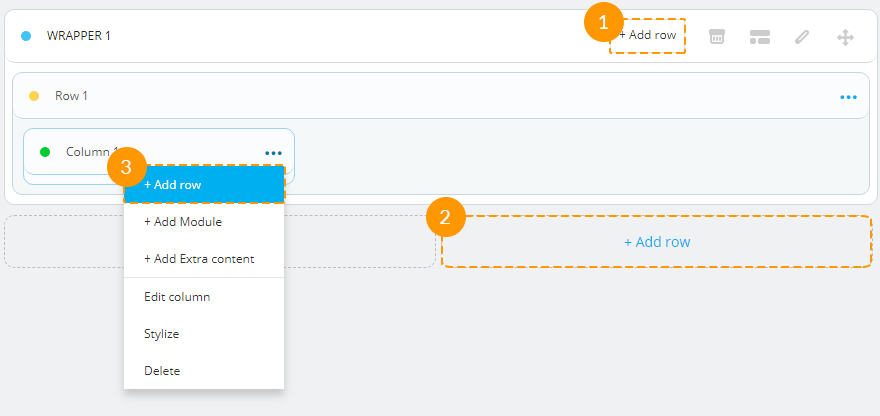
-
The row was added successfully.
Adding custom CSS class to the row
Custom class adding allows you to create custom row styling using CSS rules.
-
In order to add the class to the row, you should press the 'ellipsis' button (1).

-
Choose the 'Edit row' (2) in a drop-down list.

-
Fill in the 'Enter row classes' (3) field in the pop-up window and press 'Confirm' (4) button.

-
Custom class was added successfully.
Deleting the row
Removal of preset item will also cause removal of its child items and their styles.
-
In order to remove the row, open the menu (the 'ellipsis' icon) in the row block.

-
Choose 'Delete' (2) option in the drop-down.

-
The row was successfully removed.
Adding styles to the row
-
In order to add row styles, open the menu (the 'ellipsis' icon) (1) in a row block.

-
Press 'Stylize' (2) in the drop-down.

-
You will see the pop-up window, fill in all the needed fields there (you may refer to the documentation 'Styling' section) and press 'Save' (3) button.

-
If all the fields are filled in correctly, styles will be saved.
Column
It is an item with configurable block width for different dimensions, based on Bootstrap grid.
Adding the column
-
In order to insert a column into a needed 'row', open the menu (the 'ellipsis' icon) (1)

-
Choose the '+ Add Col' (2) among the list.

-
Fill in the fields (col*, col-sm*, col-md*, col-lg*, col-xl*, col-xxl* - in accordance with bootstrap 4 requirements) in the pop-up window and press 'Confirm' (3) button.
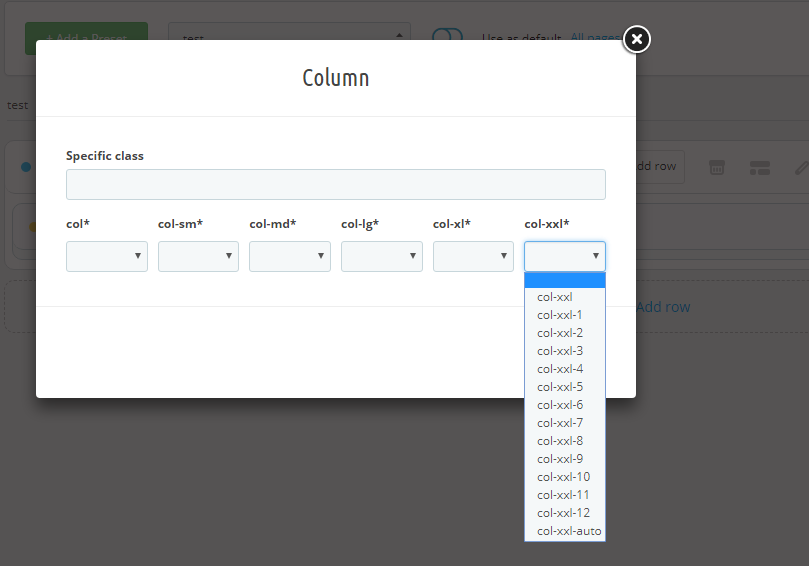
-
The column was added successfully.
Removing the column
Preset item removing will also cause its child items and their styles deleting.
-
In order to remove the column, open the menu (the 'ellipsis' icon) in a column block (1)

-
Press 'Delete' (2) in the list.
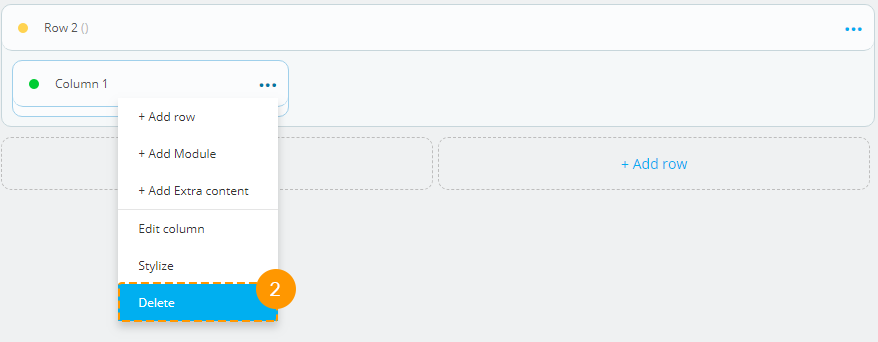
-
The column and all of its child items were removed.
Editing the column
-
In order to edit the column, open the menu (the 'ellipsis' icon) (1) in the column block.

-
Press 'Edit column' (2) in the list.
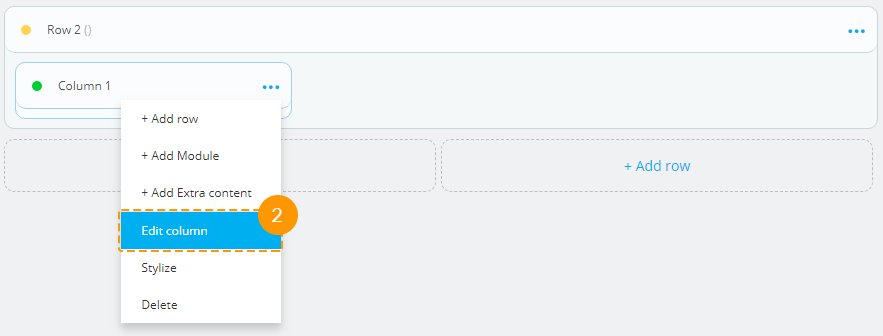
-
Fill in the fields (col*, col-sm*, col-md*, col-lg*, col-xl*, col-xxl* - in accordance with bootstrap 4 requirements) in the pop-up window and press 'Confirm'.
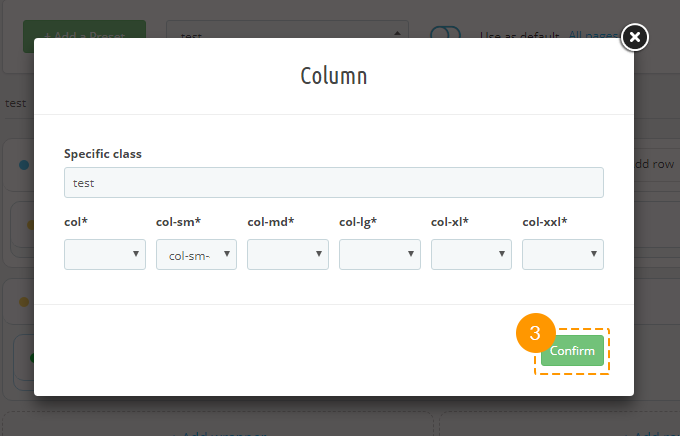
-
The column was successfully edited.
Adding styles to the column
-
In order to add column styles, open the menu (the 'ellipsis' icon) (1) in a column block.

-
Press 'Stylize' (2) in the list of options.

-
You will see the pop-up window, fill in all the needed fields there (you may refer to the documentation 'Styling' section) and press 'Save' (3) button.

-
If all the fields are filled in correctly, styles will be saved.
Module
Module assigned to this hook.
Adding the module
Be careful when adding modules to the preset, some modules are desirable to use if they do not change the visible layout, e.g., 'Data mining for statistics' module.
-
In order to add the module to the preset in a column block, open the menu (the 'ellipsis' icon) (1).

-
Press the '+ Add Module' (2) in the list of options available.
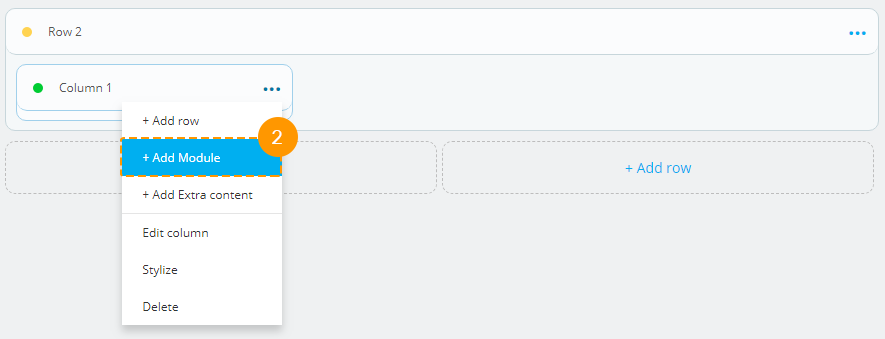
-
If needed, you can enter the custom class (3) in the pop-up window and select the module (4), next press 'Confirm' (5).

-
The module was successfully added.
-
In this version of JX Mega Layout you can add 'Homepage tabs' module in Home hook.
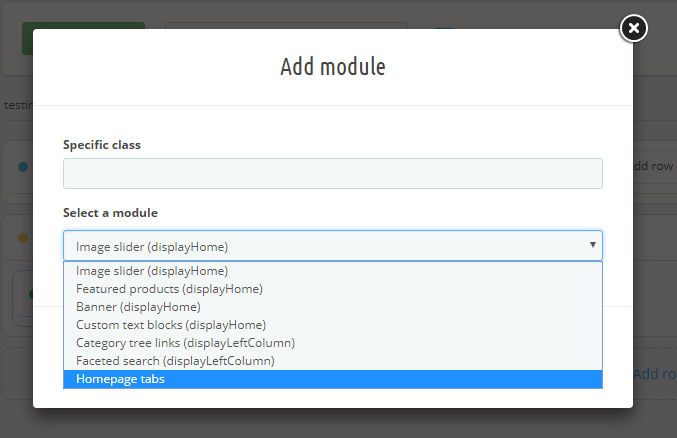
It can also be customized like all other modules in Mega Layout.
Deleting the module
Removal of preset item will also cause removal of its child items and their styles.
-
In order to remove the module, open the menu (the 'ellipsis' icon) (1) in the module block.

-
Press 'Delete' (2) in the list of options available.

-
The module is removed.
Adding custom class to the module
Custom class adding allows to create module styling using CSS rules.
-
In order to specify custom class for the module, open the menu in the module block (the 'ellipsis' icon) (1).

-
Press 'Edit Settings' (2) then.

-
Specify custom class (3) in the pop-up window and press 'Confirm' (4) button.

-
Custom class was added.
Extra content
Additional custom content in any position.
Adding extra content
-
In order to add extra content in a column block, open the menu (the 'ellipsis'icon) (1).

-
Press 'Add Extra content' (2).
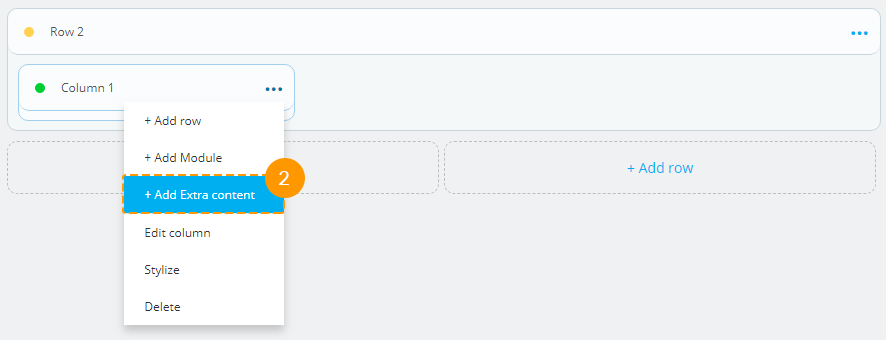
-
The pop-up window will appear. Specify the custom class (3), if needed. You need to select the content type (product or post) (4) and identify product ID number (5). Press 'Confirm' (6) button.
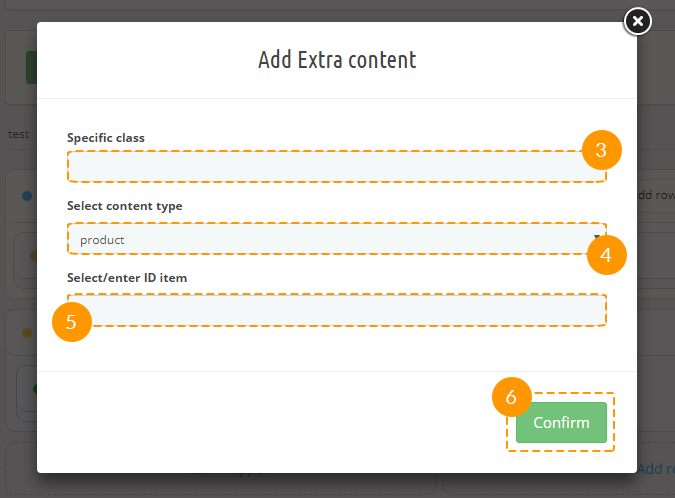
-
Extra content was successfully added.

Deleting extra content
-
To remove the extra content, open the menu (the 'ellipsis' icon) (1) in the corresponding block.

-
Press 'Delete' (2) button.

Adding custom class to the extra content
-
In order to add the custom class for the extra content, open the menu in the corresponding block (the 'ellipsis' icon) (1).

-
Press 'Edit settings' (2) button.

-
Specify the custom class in the appeared pop-up window. Press 'Confirm' button.

- Custom CSS class was added.
Logo, Copyright
Logo and Copyright blocks are edited the same way as modules, except for the fact that Logo can be placed only in Header or Footer position, and the Copyright block can be placed only in Footer position.
Presets export
Export tool allows you to export presets for the further import into different shops.
-
Navigate to the 'Tools' (1) tab in the main configurations panel.

-
Choose 'Export' (2) in the form.
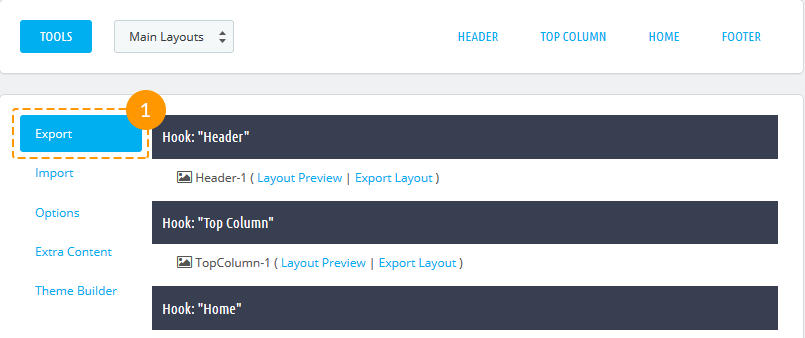
-
You'll see the list of the existing presets in site hooks.

-
In order to preview the preset, press 'Layout preview' (3) button next to the preset you need, in order to export, please press 'Export layout' (4) button.

-
Then you'll be able to download this preset as a zip archive.
Preset import
Import tool accepts only the presets *.zip files that were previously generated with the same module Export tool.
-
In order to import your preset, you should open the Tools (1) tab and choose 'Import' (2).
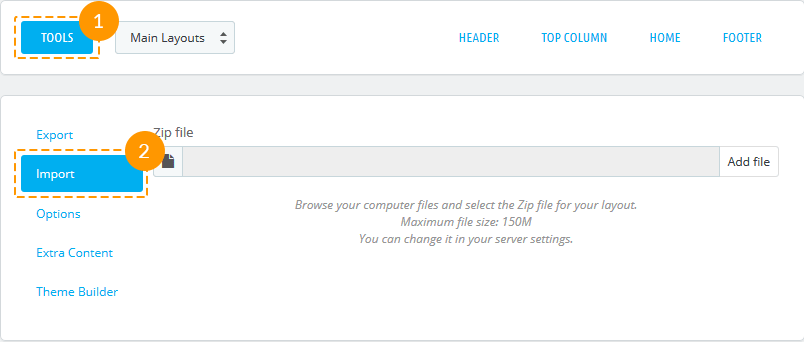
-
Next, press the Add file (3) button and select the zip file of your exported preset. In case this archive is the exported preset, you will see this preset preview.

-
If this preset meets your needs, press 'Import' (4). The preset will be imported and added to the list of available presets.

Reset
'Reset' reverts all the presets to initial state (to the way they came with the template), and discards all the created presets.
Attention! After reverting presets to default state, all the custom presets will be discarded!
-
To reset presets, navigate to the 'Tools' (1) tab. In the appeared block open the 'Options' (2) tab.

-
Press the 'Reset' button.

-
That's it! All presets are reset to initial state.
Styles and Scripts Optimization
Styles and scripts optimization adds exclusions for modules in Header section, based on their use in presets. This allows speeding up the page loading speed. Optimization works in test mode.
Enabling optimization:
-
To enable optimization, open the 'Tools' (1) tab and select the 'Options' (2) tab.

-
In the appeared window, you can enable optimization (3).

If optimization is enabled when editing and enabling presets, optimization gets discarded, but you'll see a window offering to run optimization. There is no need to optimize scripts and styles every time you change presets. It's better to optimize them when you're done editing.

Styling
-
Background styles. Fields description:

- background-image (background image) - the image URL or 'none' value. The image is picked from the ~/images/cms/ folder.
- background-color (background color) - the value can be set in any color format (rgb, hex, etc.). You can choose the color using the Color Picker tool.
- background-repeat (background repeat) - all the available options are listed in the radio buttons.
- background-position (background position) - all the available options are listed in the drop-down.
- background-size (background size) - all the available options are listed in the drop-down.
- background-origin (background image positioning region) - all the available options are listed in the drop-down.
Border styles.

- border-top-style, border-right-style, border-left-style, border-bottom-style (border styles) - all the available options are listed in the drop-down.
- border-top-width, border-right-width, border-left-width, border-bottom-width (borders width) - should be set in pixels.
- border-top-сolor, border-right-color, border-left-color, border-bottom-color (borders color) - the value can be set in any color format (rgb, hex, etc.). You can choose the color using the Color Picker Tool.
- border-top-right-radius, border-top-left-radius, border-bottom-right-radius, border-bottom-left-radius (border radius) - should be set in pixels.
Other styles.

- box-shadow (box shadow) - example:0px 0px 0px 0px rgba(0,0,0,0.75).
Items styles removing
-
In order to remove items styles, open the items styling section and press 'Clear styles' (1)

Extra content
On the module base there is the ability to create one of the available content types (HTML block, Banner block, YouTube block or Slider block) blocks and, also, output the products or posts as slides. You can also Export all the extra content you have created in one click only or import it from your computer.
-
In order to add extra content, you should open the Tools (1) tab and choose 'Extra content' (2.)

-
Press 'Add content' button.
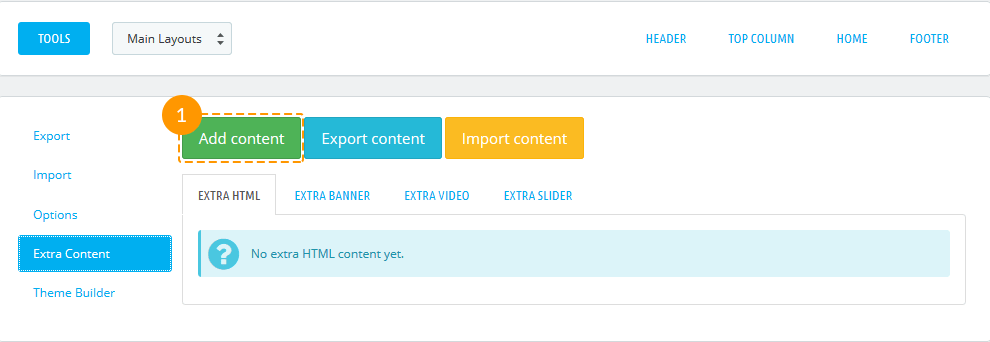
-
There are 4 available types of content that you can create: HTML block, Banner block, Video block, Slider block.

Extra HTML content
-
To create extra HTML content, press 'Create HTML block' tab.

-
In the form that appears, fill in the required fields.
-
- Enter HTML item name
- HTML block name, is mandatory to be filled in for the default language.
-
- HTML content
- HTML content.
-
- Enter Specific Class
- block CSS class.

-
-
To delete HTML block, press 'Remove' (1) button. In order to edit block, press 'Edit'(2) button.

Extra Banner content
-
To create extra Banner content, press 'Create Banner block' (1) tab.

-
In the form that appears, fill in the required fields.
-
- Enter Banner item name
- banner title, is mandatory to be filled in for the default language.
-
- Enter Banner item link
- a link that is assigned to this banner.
-
- Add banner image
- upload an image for the banner.
-
- Banner content
- set the content of the banner.
-
- Enter Specific class
- block CSS class.
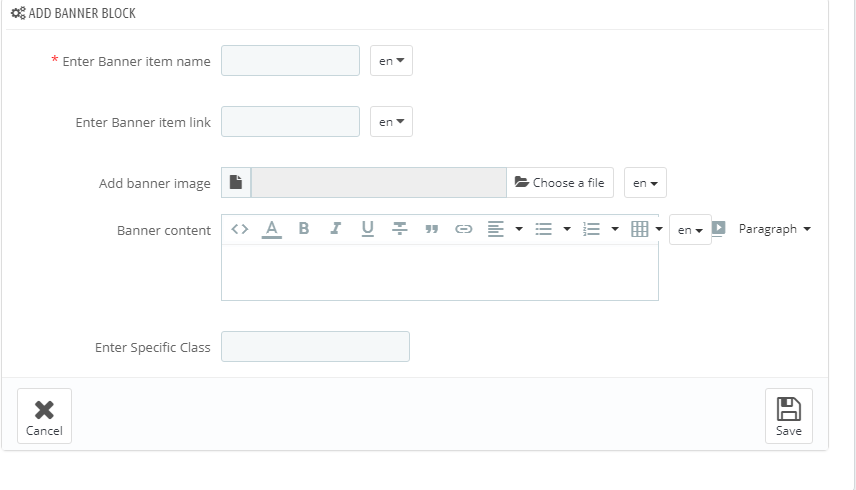
-
-
To delete Banner block, press 'Remove' (1) button. In order to edit block, press 'Edit'(2) button.

Extra Video content
-
In order to create extra Video content, press 'Create Video block' (1) tab.

-
In the form that appears, fill in the required fields.
-
- Enter Video item name
- the title of the video (mandatory).
-
- Preview
- the video will be displayed before it will be published.
-
- Enter Video item URL
- add video link in the YouTube video format.
-
- HTML content
- the field where some HTML content can be added.
-
- Enter Specific Class
- block CSS class.
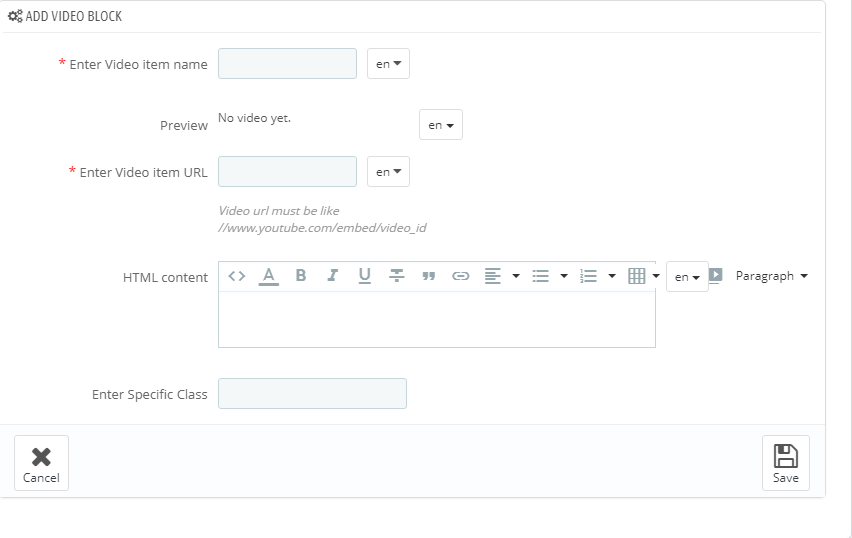
-
-
To delete Video block, press 'Remove' (1) button. In order to edit block, press 'Edit'(2) button.
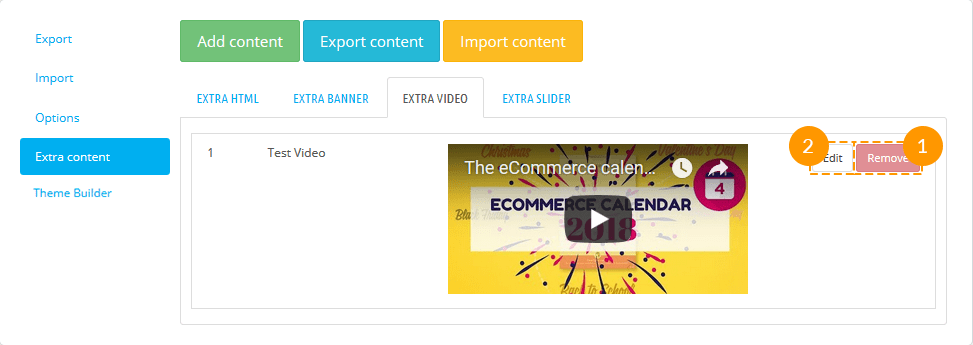
Extra Slider content
-
In order to create extra Slider content, press 'Create Slider block' (1) tab.

-
In the form that appears, fill in the required fields.
-
- Enter Slider item name
- the title of the slider (mandatory).
-
- Slider description
- set the description of the slider.
-
- Enter Specific class
- block CSS class.
-
- Slides
- the content of the slide: html, banner, video, product, post.
-
- Visible items
- the number of visible items (mandatory).
-
- Items scroll
- the number of items changed with one scroll (mandatory).
-
- Slide margin
- the carousel list item margin (mandatory).
-
- Slider speed
- speed of changing speed (mandatory).
-
- Auto scroll
- turns on/off slider autoplay.
-
- Pause
- pause between scrolls (if 'Auto scroll' is enabled).
-
- Slider Loop
- allow repeating slides from the beginning after all the slides were shown.
-
- Pager
- show/hide slider pagination.
-
- Controls
- show/hide slider navigation.
-
- Auto height
- slides height.
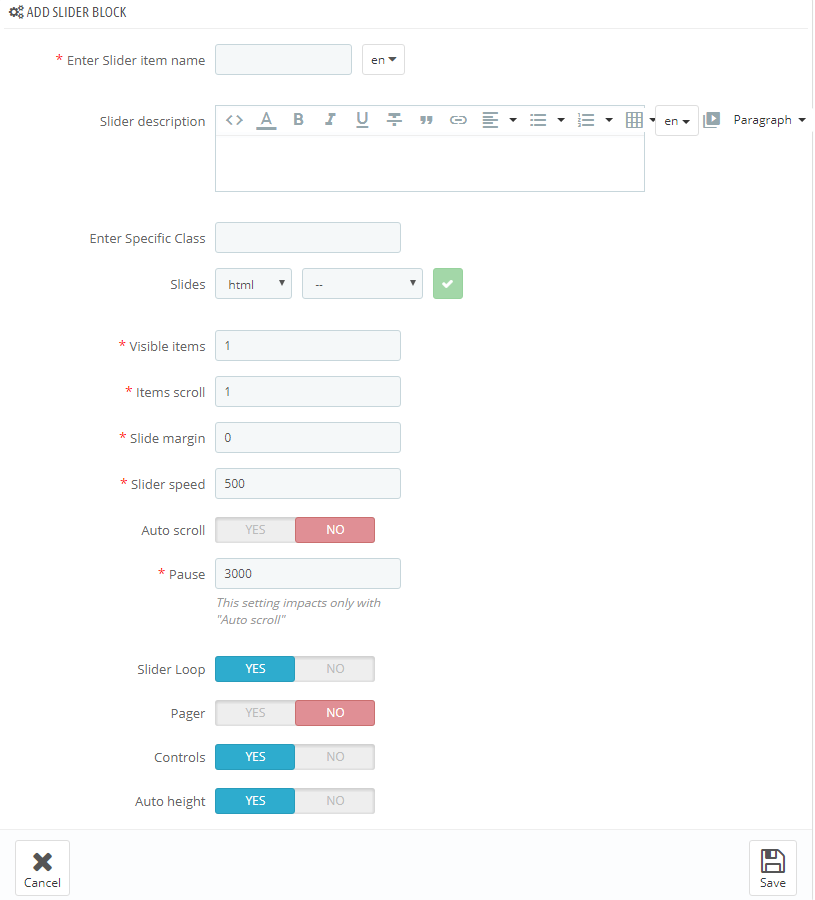
-
-
To delete Slider block, press 'Remove' (1) button. In order to edit block, press 'Edit'(2) button.

Export content
You may export all the extra content you've created to your computer as a zip file with one click only.
To download extra content, simply press "Export content"(1) tab. The downloading process will start automatically.

Import content
You can also import your own custom content from your computer, but zip files only!
To upload extra content, press "Import content" tab.

Press "Add file" (1) button and upload from your computer archive that contains extra content only.

Theme Builder
You may create different variations of the child themes on the parent theme basis with the help of Theme Builder option.
To create a child theme, click the "Add new child theme" button.
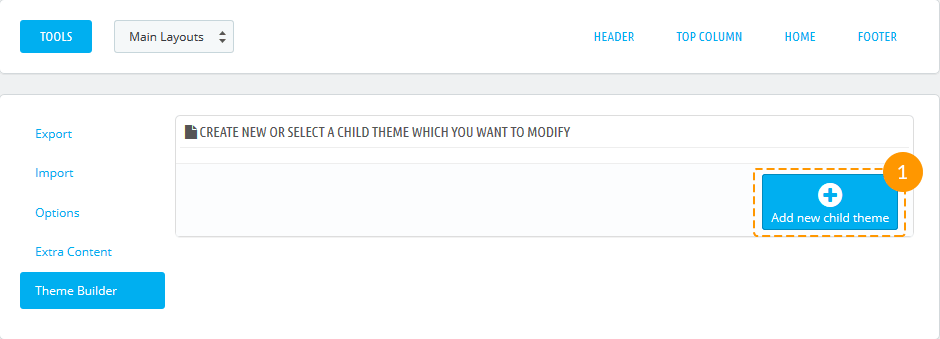
- In the appeared window, fill in the "Theme public name" and the "Theme name".
- Theme public name - the public theme name will be displayed in the admin panel (the given name you won't be able to change).
- Theme name - the name theme (the given name you won't be able to change).
- Choose the variants of "Catalog Page", "Product Info Page" and "Quick View Page" from the available below.
- Click the "Save" button to save the changes.
- The successfully created child theme will appear on the list. You may edit the child theme simply hovering the preview image and clicking "Modify this child theme" button. You can change the variants of Catalog, Product Info, and Quick View Pages.
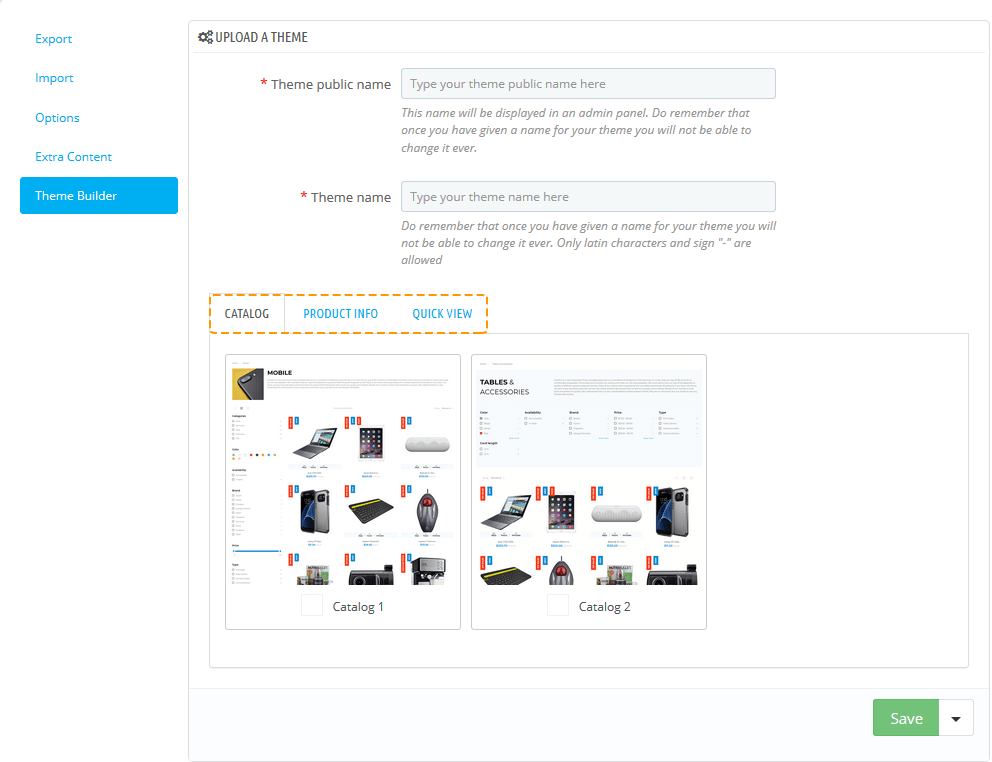
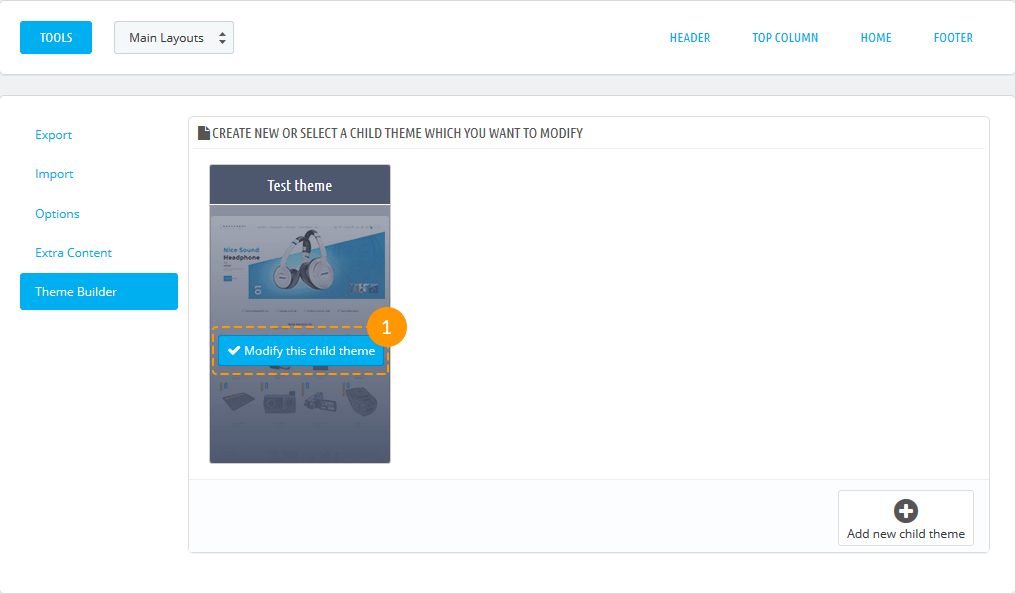
Warnings
If the following message appears in the module item block, you should enable the mentioned module.

If the following message appears in the module item block, you should install the mentioned module.

In case you remove or deactivate the 'JX Mega Layout' module, all the active presets will be disabled and you will see the positions (hooks) in their original appearance.
JX Mega Menu
The module is designed to create complex menus. The module provides the ability to display one item (without sub-menu), a menu item with a sub-menu and a menu item with sub-menu by means of a multi-row and multi-column block. The module can be used in different positions, but it will display the same content. Available positions: top (displayTop), left (displayLeftColumn), right (displayRightColumn), footer (displayFooter). You can add categories (with subcategories), CMS categories (with subcategories), manufacturers (one or a list), suppliers (one or a list), stores (if multi-store is used), links to any product, information block about the product, custom links (not limited in quantity), custom HTML blocks (not limited in number) and banners. See below for more details.
The module includes 6 main tabs that allow customizing the menu.

JX Mega Menu Items
JX Mega Menu items are the basic items which appear in the menu.
In order to create a new item, open the JX Mega Menu module and click Add item button from the top menu or click "+" button in the top right of the table.

In the form that appears, fill in the required fields.
-
- Enter item name
- the tab title which is mandatory to be filled in for the default language, if the additional languages fields are not filled in, the tab takes its name from the default language.
-
- Active
- active/inactive tab.
-
- Link
- a link that is assigned to this tab. You can enter a custom link, or choose from existing options (categories, CMS categories). If you leave the field blank, the link of this tab is inactive.
-
- Sort order
- the order of tabs to be displayed.
-
- Specific Class
- the class which is added to emphasize the item (CSS class).
-
- Enter item badge
- is filled in depending on multi-languages.
-
- It is Mega Menu
- given tab sub-menu is a Mega Menu. *
-
- Use simple menu
- given tab sub-menu is a simple menu. **
* It is Mega Menu. If this option is selected, there will be a form to create a complex menu (Mega Menu).
** Use simple menu. If this option is selected, there will be a form to create a simple menu. This is a menu that displays the selected content in a single column. If the menu has embedded content, the new column is added.
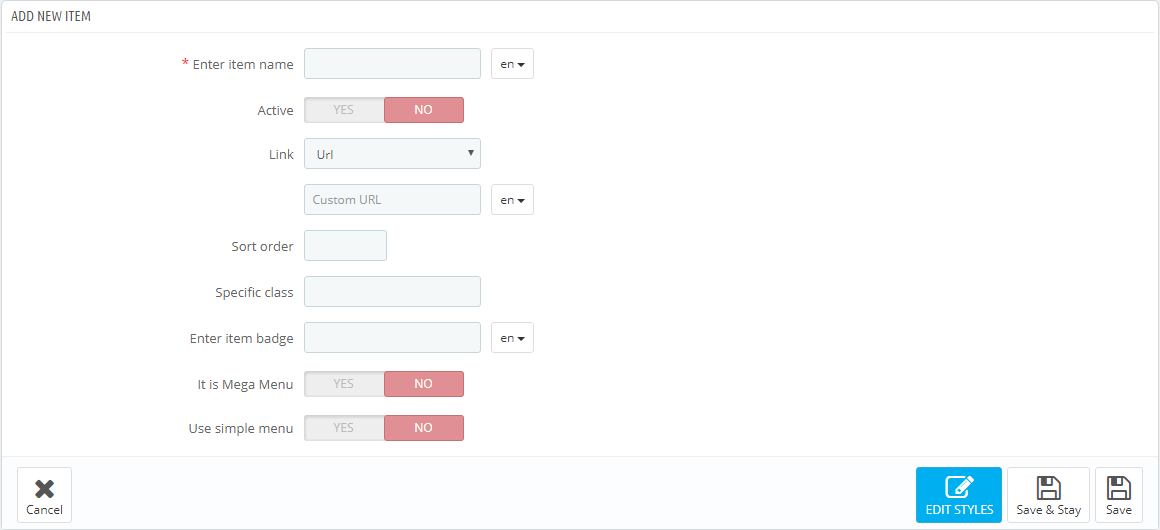
Complex menu consists of rows and columns in rows.
The Row is a part of the Mega Menu structure. It includes the menu columns. The existing row can be removed by clicking the appropriate button. The row will be removed with the content it includes. The rows quantity is not limited.
The Column is a part of the Mega Menu structure, which is placed inside the rows. (The Class) The width of the column cannot be less than 2 and more than 12. In order to make the menu display properly, the total column width cannot exceed 12. The width (class) is a Bootstrap column type, corresponds to the same values.
In order to create the menu, click the 'Add row' button.

In the form appeared, click 'Add column' button.

In the pop up window you need to specify the column class (from 2 to 12). The column itself appears next where you need to set the required settings.
Here you can change the column class, CSS class and the content from the list provided. You can add/remove content by double clicking the item, or by highlighting the items and clicking the corresponding button.
Block can be removed by clicking 'Remove block' button in the footer of the block.
By removing the row, the included columns are also removed.
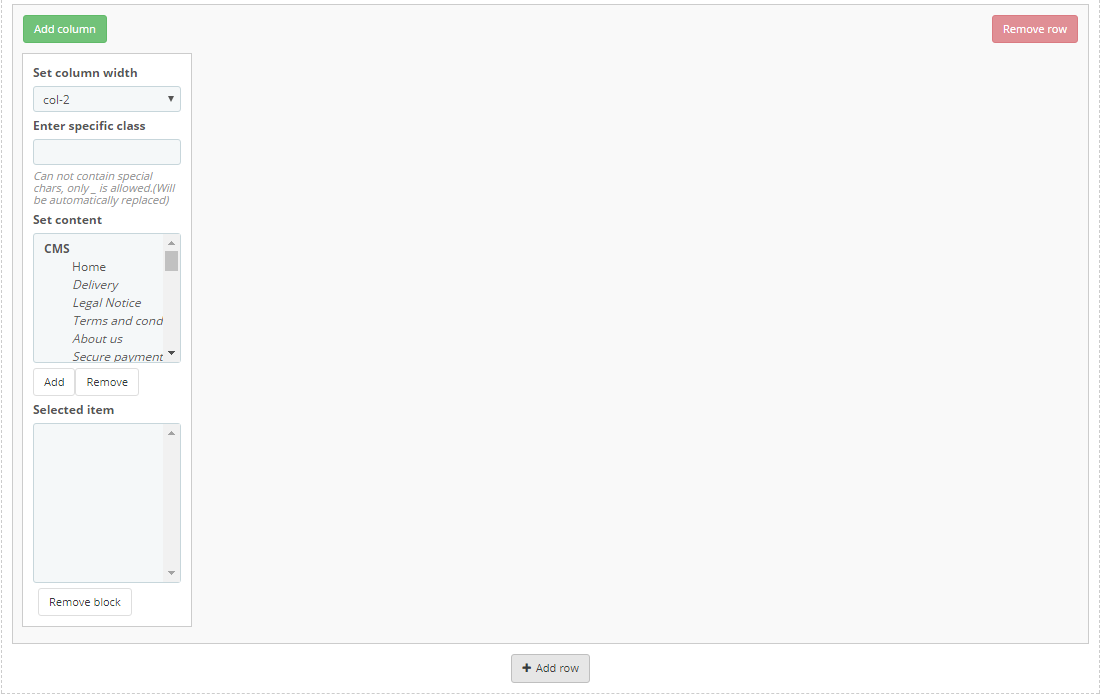
In order to move the content available in the selected menu, double-click or highlight the desired content and press the corresponding button.
Inactive menu information is saved while switching between menu types and you can always change the type of menu.
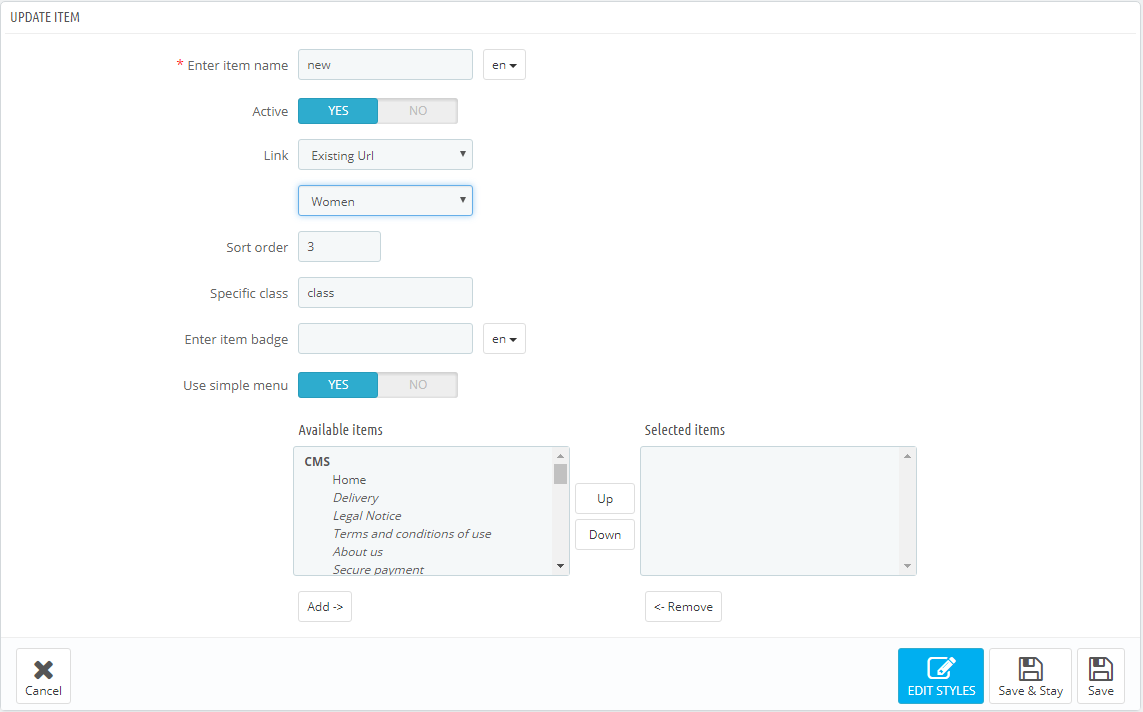
JX Mega Menu HTML
In this section we will explain how to create a custom HTML block in the Mega Menu.
The module has a table listing all the available blocks. You can also add a new block by clicking the '+' button in the top right of the table.
In the form that appears, fill in the required fields.
-
- Enter HTML item name
- HTML block name, is mandatory to be filled in for the default language.
-
- Specific class
- block's CSS class.
-
- HTML content
- HTML content.
Added block will appear in the list of blocks, as well as in the list of available content while creating menu blocks.
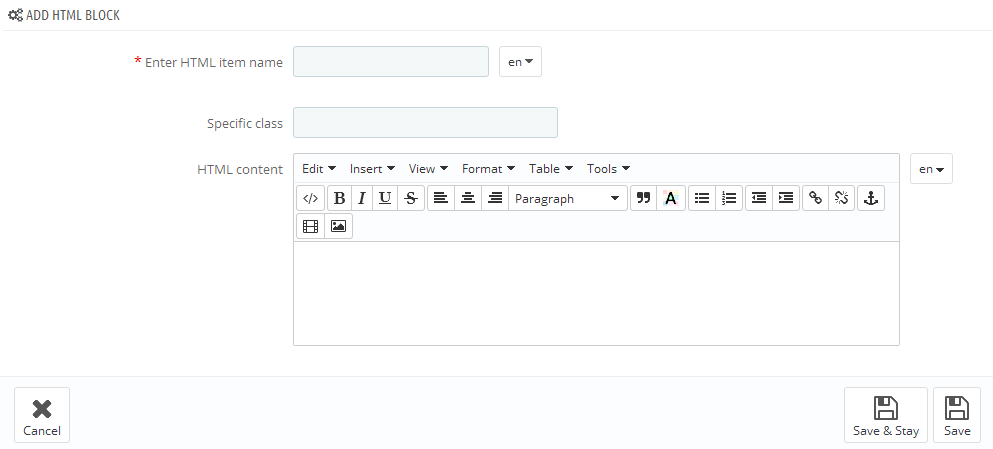
JX Mega Menu Links
In this section we will show how to create custom links in the Mega Menu.
The module has a table listing all the available links. You can also add a new link by clicking the '+' button in the top right of the table.
In the form that appears, fill in the required fields.
-
- Enter Link name
- link name, is mandatory to be filled in for the default language.
-
- Enter Link URL
- link URL, is mandatory to be filled in for the default language.
-
- Specific class
- block's CSS class.
-
- Open in new window
- open link in a new window.
Added link will appear in the list of links, as well as in the list of available content while creating menu blocks.

JX Mega Menu Banners
In this section we will explain how to create banners in the Mega Menu.
The module has a table listing all the available banners. You can also add a new banner by clicking the '+' button in the top right of the table.
In the form that appears, fill in the required fields.
-
- Select a file
- select a file, is mandatory to be filled in for the default language.
-
- Enter Banner name
- banner title, is mandatory to be filled in for the default language.
-
- Enter Banner URL
- link URL, is mandatory to be filled in for the default language.
-
- Specific class
- block's CSS class.
-
- Public Title
- public banner title.
-
- Description
- set the description of the banner.
-
- Open in new window
- open link in a new window.
Added banner will appear in the list of banners, as well as in the list of available content while creating menu blocks.
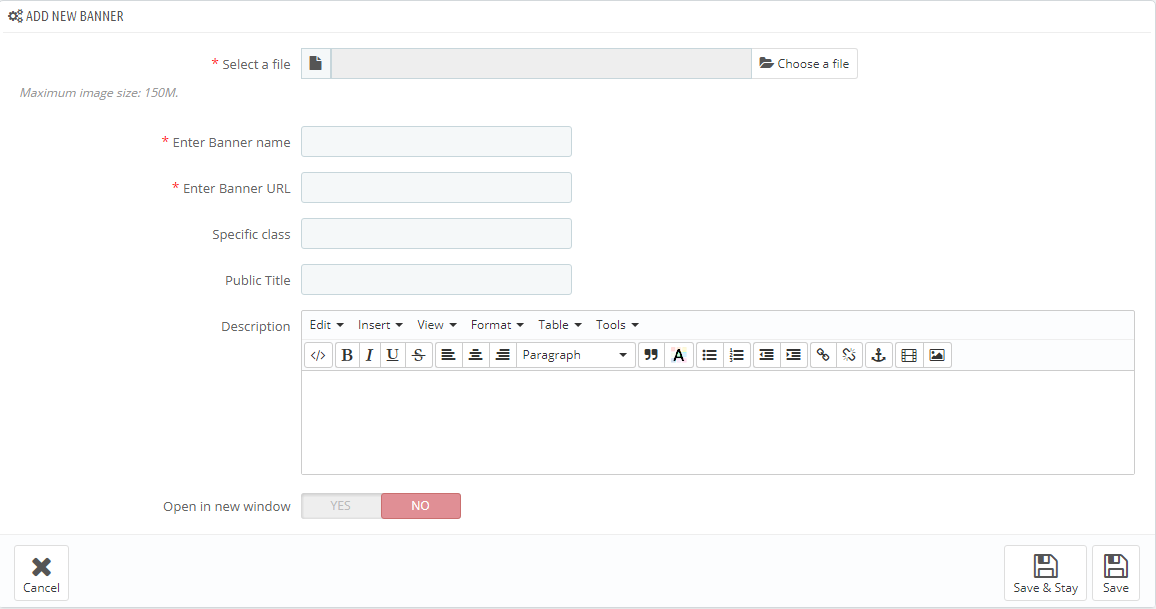
JX Mega Menu Video
In this section we will explain how to add a video in the Mega Menu.
The module has a table listing all the available videos. You can also add a new video by clicking the '+' button in the top right of the table.
In the form that appears, fill in the required fields.
-
- Enter Video Name
- video title (the field is required).
- Enter Video URL - add video link in the formats described below:
- If this is a YouTube video, click on Embed and copy the code between the quotes for https://www.youtube.com/embed/video_id
- If this is a Vimeo video, click on Share icon and in the Embed section copy the source code between the quotes for http://player.vimeo.com/video/video_id
Added video will appear in the list of videos, as well as in the list of available content while creating menu blocks.

JX Mega Menu Map
In this section we will explain how to add a map in the Mega Menu.
The module has a table listing all the available maps. You can also add a new map by clicking the '+' button in the top right of the table.
In the form that appears, fill in the required fields.
-
- Enter Map item name
- the title of the map.
-
- Enter Map latitude
- set a latitude value.
-
- Enter Map longitude
- set a longitude value.
-
- Marker
- adding a custom marker.
-
- Enter Map scale
- the scale of the map (used 8 by default).
-
- Map description
- set the description of the map.
Added map will appear in the list of maps, as well as in the list of available content while creating menu blocks.
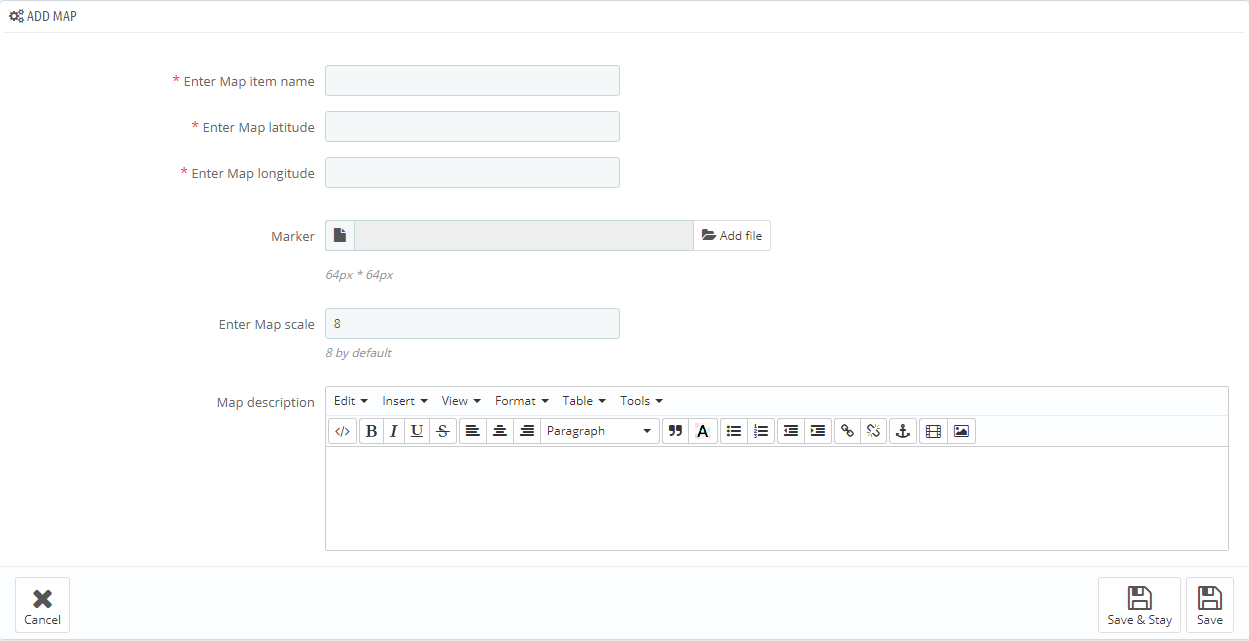
JX Mosaic Products
This module allows you to display categories with products, banners, video (YouTube, Vimeo and custom video), HTML content, various sliders with different number of slides and dimensions in any row on the site home page.
Installation and Deleting
The module is installed and deleted like any other PrestaShop module.
Module settings
After module has been installed, you can add the required blocks with category products, previously added banners, video and HTML content.

Adding/removing/editing Blocks
In order to add a new category, press the "Add new" button.
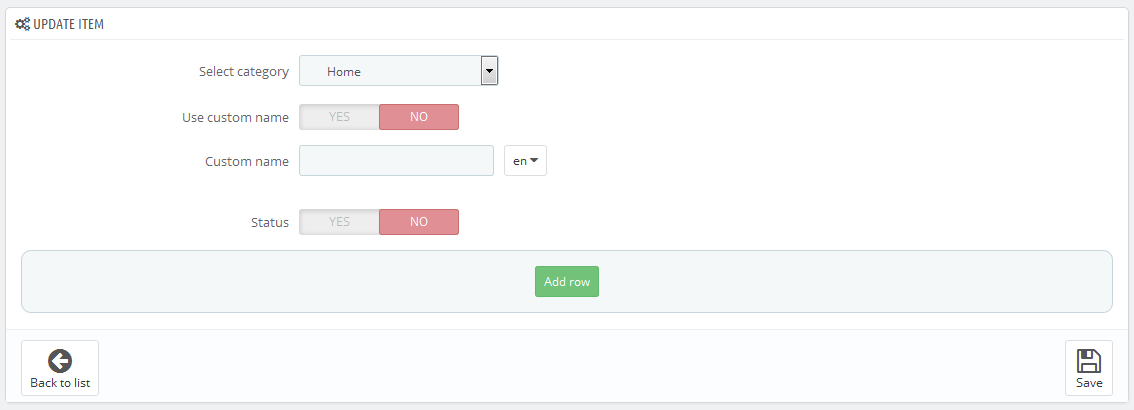
- Select category - choose a category to add products, banners, video and HTML content to.
- Use custom name - custom category status.
- Custom name - category title.
- Status - item status.
In order to add the new row, press the "Add row" button. Then choose one of the eight layouts presented in the following window.
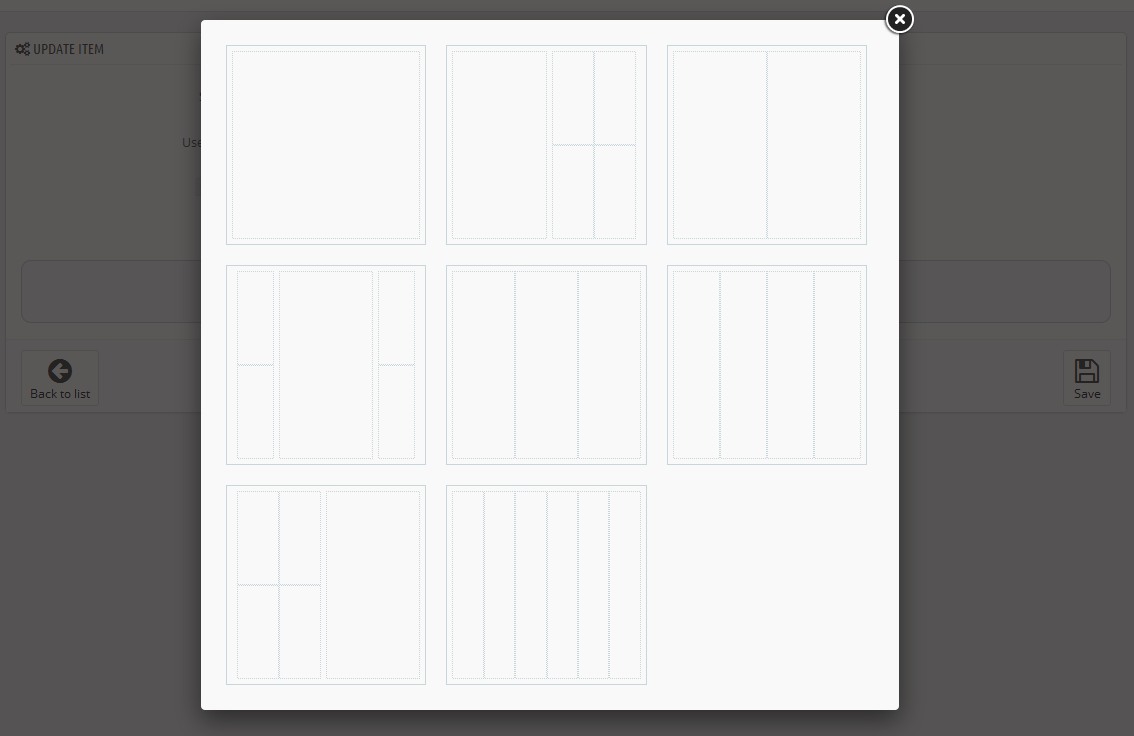
In order to add the layout, click on one of the eight options to pick it, and it will be added to the form.
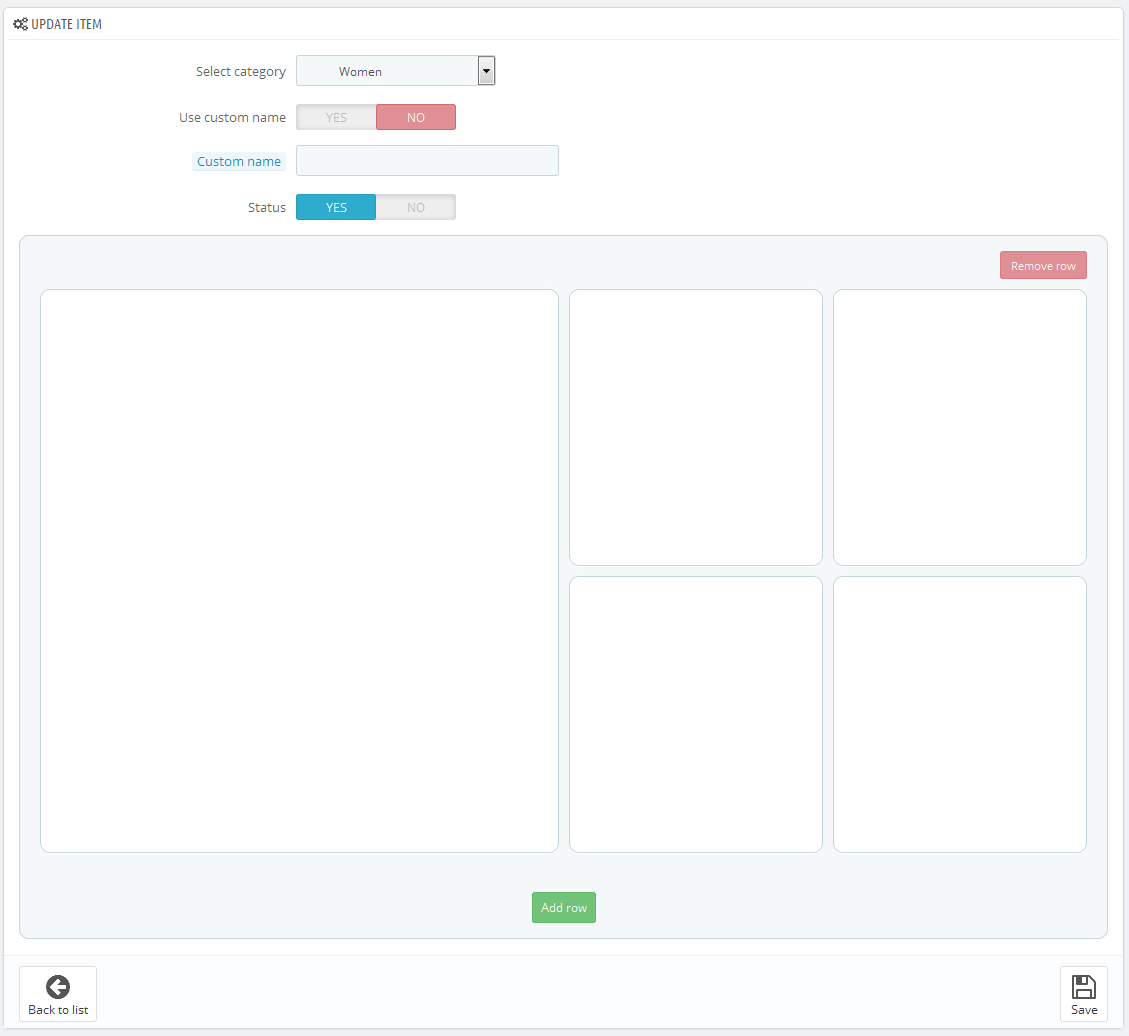
In order to add items, click on one of the layout cells. You'll see five buttons listing the available items of certain type.
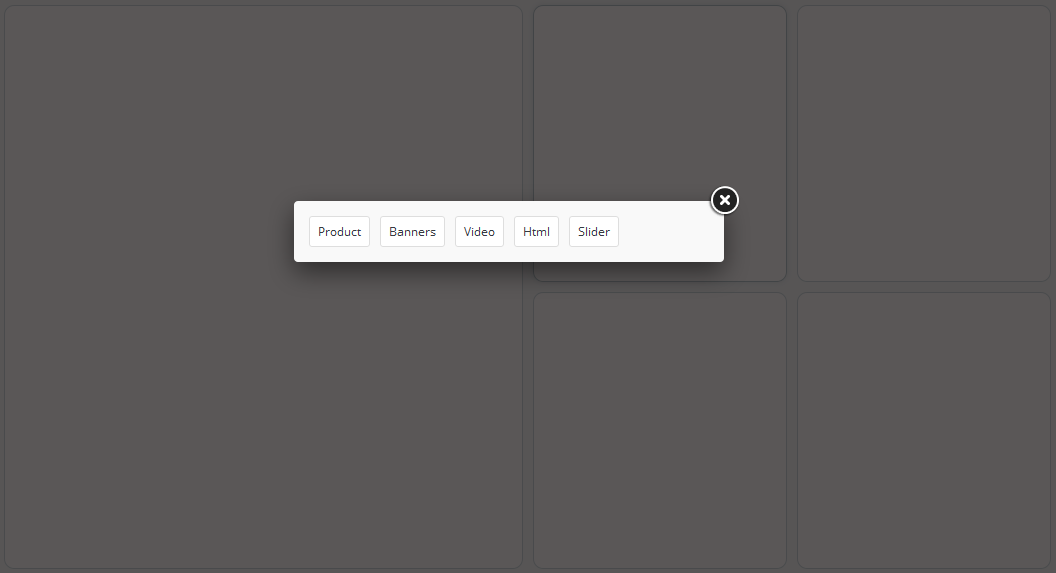
After pressing one of the buttons you will see the form to pick the item of chosen type.
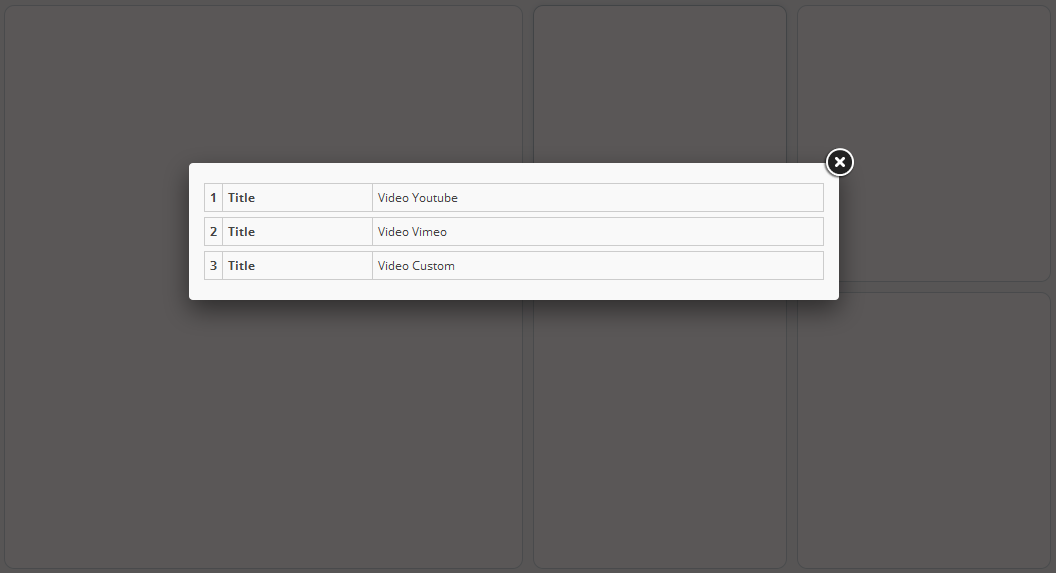
After clicking on one of the items, it will be added to the layout cell. You can fill in the layout with different blocks this way.
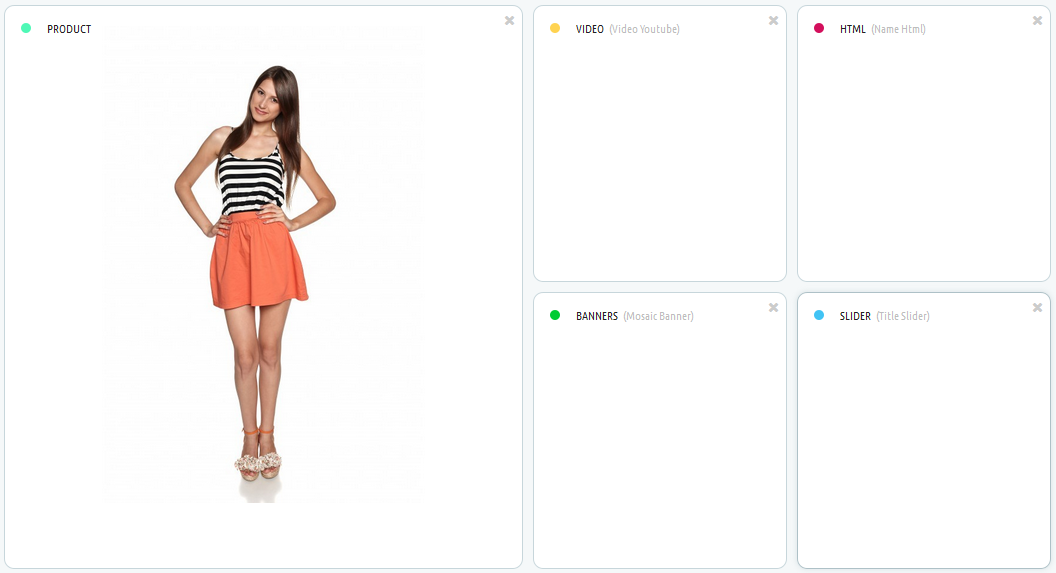
After saving the category with chosen layouts, it will show up in the form of the added categories.

In order to remove the item, press the 'Delete' button.
Banner adding/removing/editing
In order to add a new banner, click the 'Add new banner' button. Next, fill in the required fields in the form that appears.
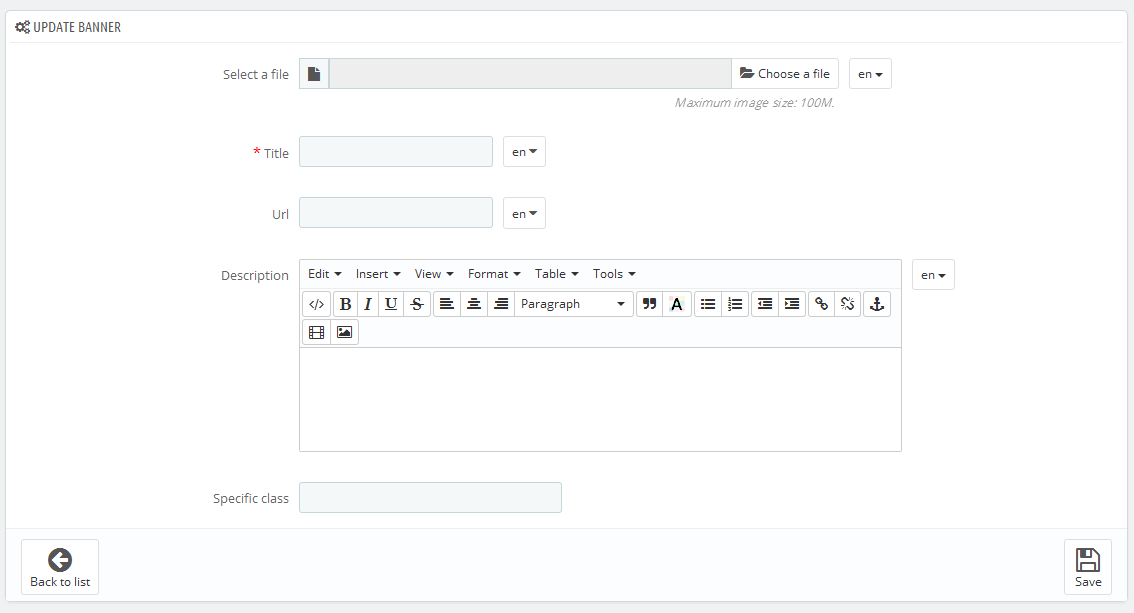
- Select a file - choose a file, this field is required (at least for the default language).
- Title - banner title, this field is required (at least for the default language).
- Url - link path, this field is required (at least for the default language).
- Description - banner description (at least for the default language).
- Specific class - block's CSS class.
Adding/removing/editing Video
In order to add a new video, click the 'Add new video' button. Next, fill in the required fields in the form that appears.
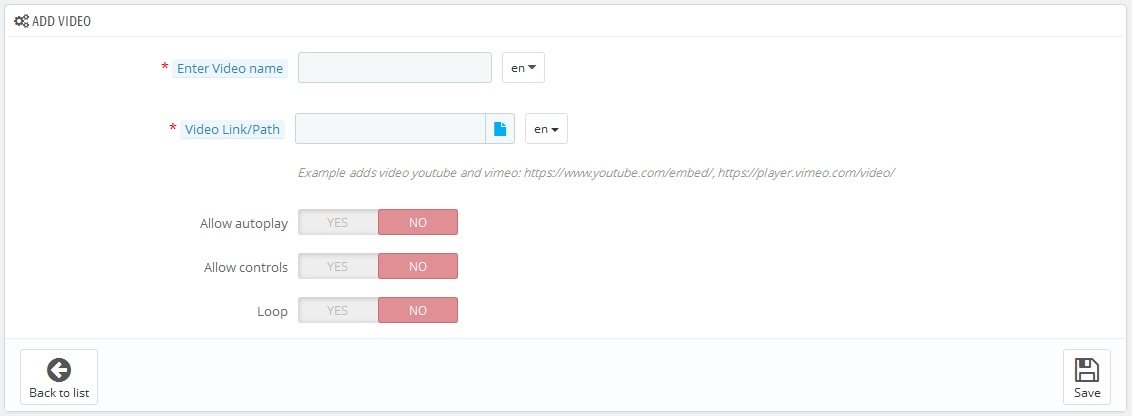
- Enter Video name - video title, this field is required (at least for the default language).
- Video Link/Path - link to the video (YouTube, vimeo or custom video), this field is required (at least for the default language).
- Allow autoplay - defines if video starts automatically right after the player has been loaded.
- Allow controls - defines if player controls are displayed.
- Loop - defines if the video playback is in the infinite loop.
In order to add custom video, press the 'file' button. Next, you'll be able to add a video via file manager.
Adding/removing/editing HTML content
In order to add new HTML content, press the 'Add new HTML' button. Next, fill in the required fields in the form that appears.

- Enter HTML item name - HTML content title, this field is required (at least for the default language).
- Specific class - block's CSS class.
- HTML content - the content.
Adding/removing/editing Slider
In order to add a new slider, press the 'Add new slider' button. Next, fill in the required fields in the form that appears.
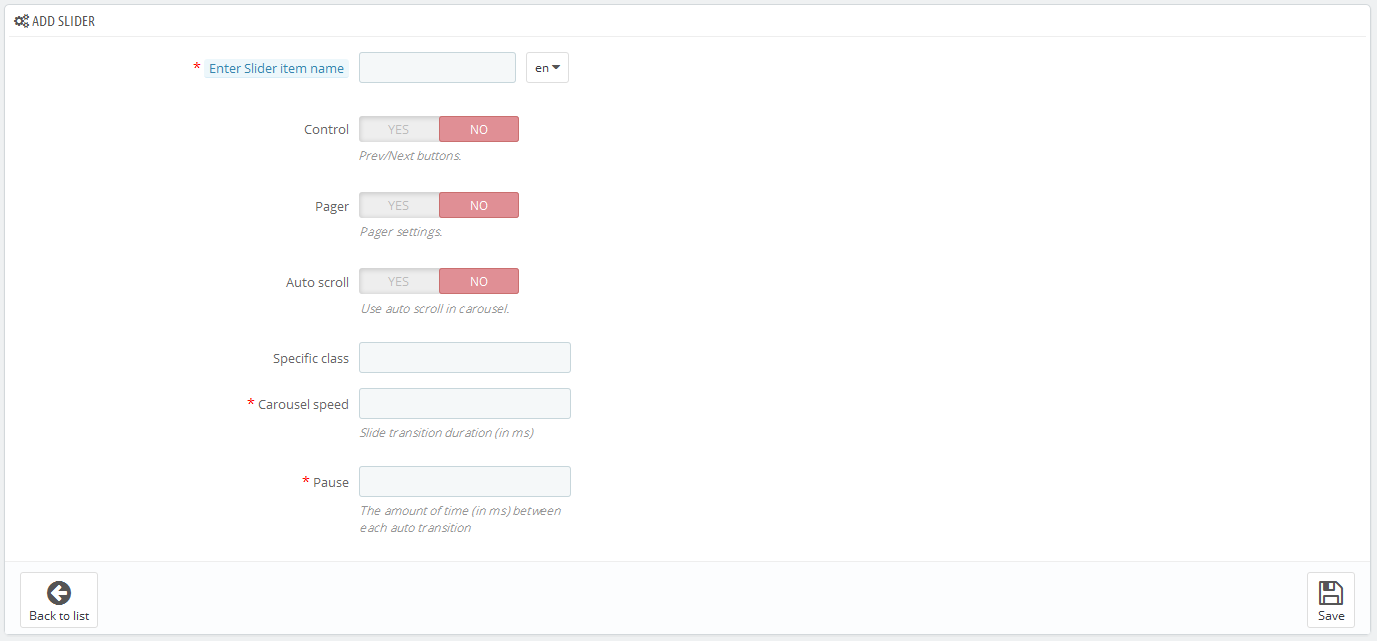
- Enter Slider item name - slider title, this field is required (at least for the default language).
- Control - show/hide slider navigation.
- Pager - show/hide slider pagination.
- Auto scroll - turns on/off slider autoplay.
- Specific class - block's CSS class.
- Carousel speed - slides transition duration (in ms), this field is required.
- Pause - the period between slides switching (in ms), this field is required.
Adding/removing/editing Slides
In order to add a new slide, click the 'View' button in the slider form and then press the 'Add new' button in a window that appears. Then fill in the required fields.

- Type - choose the slide type, this field is required.
- Banner/Video/Html list - choose the element of the previously selected type, this field is required.
- Sort order - slide position.
- Item status - status of the element.
JX Newsletter
The module displays a notification with a proposal to subscribe to store newsletter in a pop-up window. The email check can be enabled in module settings by means of confirmation email. You can also adjust the timeout between reminders for registered and non-registered users. Registered users can permanently give up on reminders.
The module is compliant with official PrestaShop General Data Protection Regulation (GDPR) module, a new EU legal framework that governs how users' personal data is used.
Module install/uninstall
This module can be installed/uninstalled like any other PrestaShop module.
Module settings
After module has been installed you can set Registered User Settings and Guest Settings below.
There are the following settings that you can set for Registered Users.
- Live mode - enable/disable the module.
- Verification email - choose if you want to send a verification email after the subscription.
- Popup title - write down a newsletter popup title.
- Popup message - write down a newsletter popup message.
- Timeout for customers - set a timeout for popup reminding subscription for customers.
- First delay - set a time that the user should spend on the site to see popup for the first time.
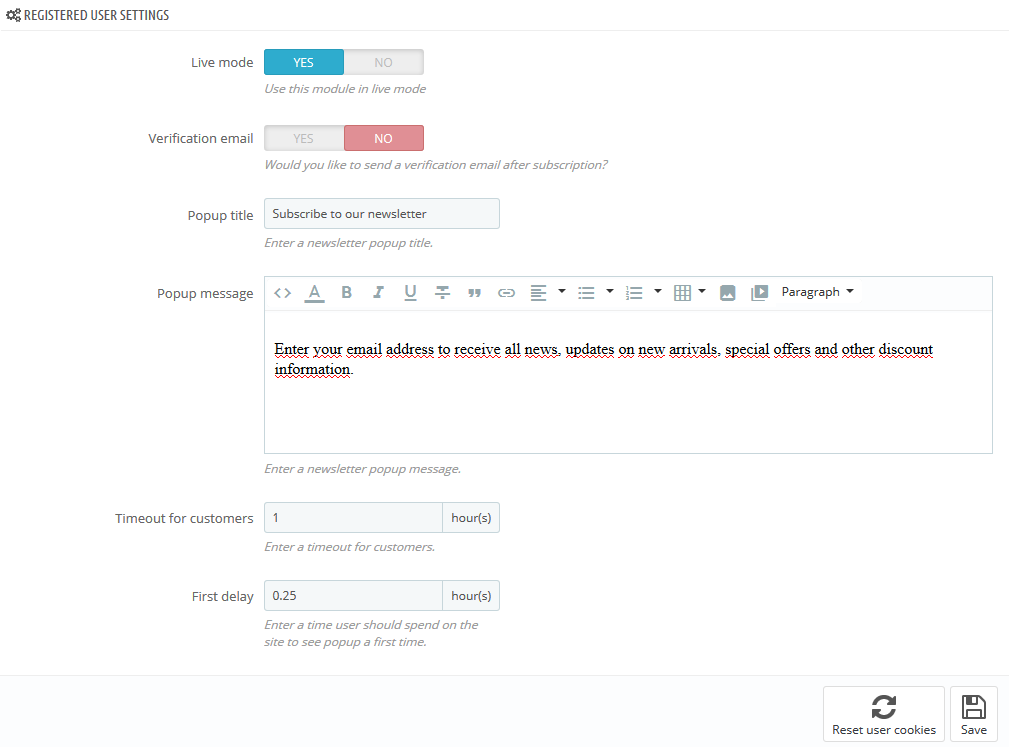
Here you can set the settings for Guests.
- Live mode - enable/disable the module.
- Verification email - choose if you want to send a verification email after the subscription.
- Popup title - write down a newsletter popup title.
- Popup message - write down a newsletter popup message.
- Timeout for guests - set a timeout for not registered users.
- First delay - set a time that the guest should spend on the site to see popup for the first time.

It is necessary to install and enable 'Newsletter block' for proper work of module.
JX Olark Chat
Module to display Olark Chat on your store front-end.
Module install/uninstall
This module can be installed/uninstalled as any other PrestaShop module.
Module settings
After module has been installed you can configure it on the module configuration page.
In order to configure Olark Chat, which you can see on the live demo of the template, you need to register on the official website and to get the ID for your website. Input your ID to the field "Olark site ID" and set module under "Live mode". Now save settings by clicking 'Save' button.

JX One Click Order
Module is used to make the process of making an order much faster and easier than it was before.
It simplifies the procedure from five steps to one and makes it more appealing for the customers who want to save
their time while making an order.
By means of this feature, you can get more spontaneous purchases that will have a positive impact on your business.
The module is compliant with official PrestaShop General Data Protection Regulation (GDPR) module, a new EU legal framework that governs how users' personal data is used.
Installation
Navigate to Modules (1) -> Modules and Settings (2) in your admin panel and find the JX One Click Order module (2). Then click the 'Install' button (3).
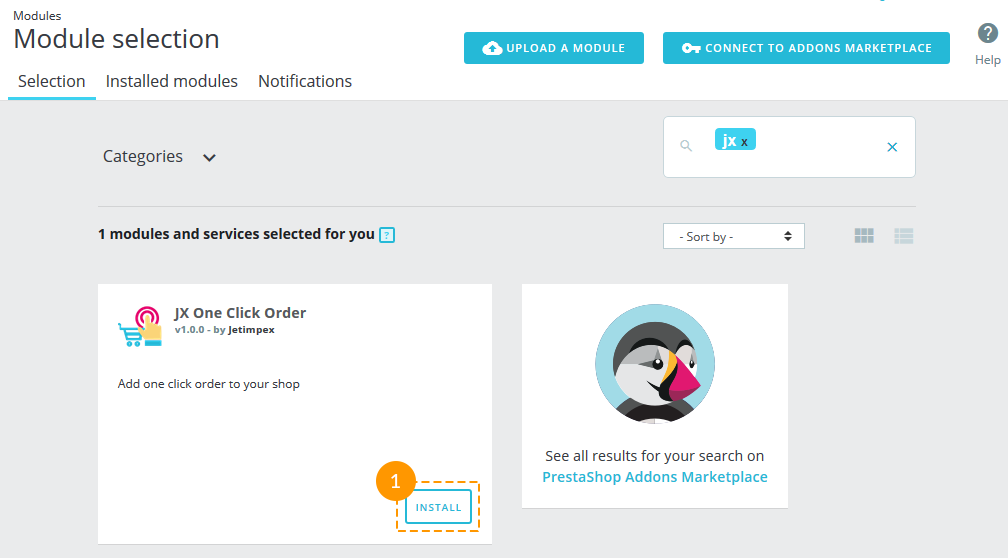
Module configuration
After the module has been successfully installed, the 'Configure' page with the module settings will be opened.
You'll also see the new menu item 'Quick Orders' (2).
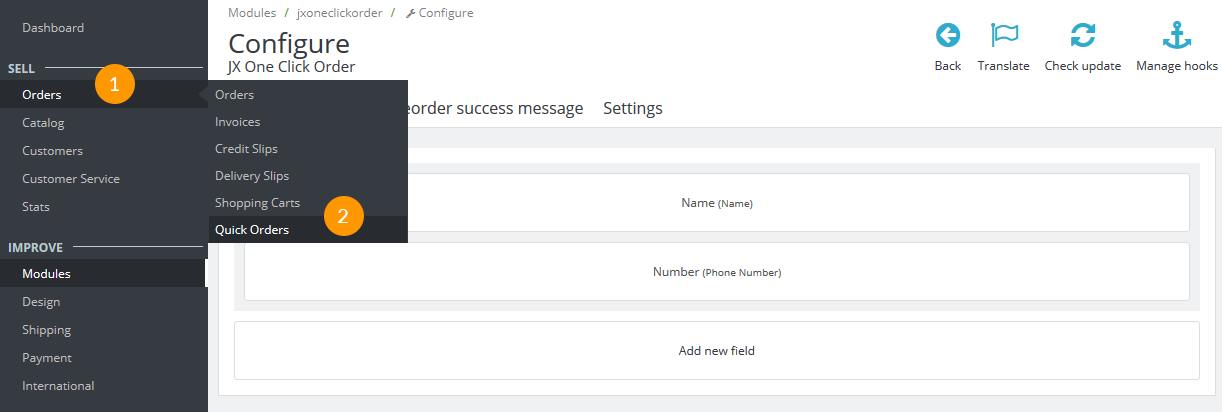
The settings are divided into three tabs - Preorder template (1), Preorder success message (2) and Settings (3).
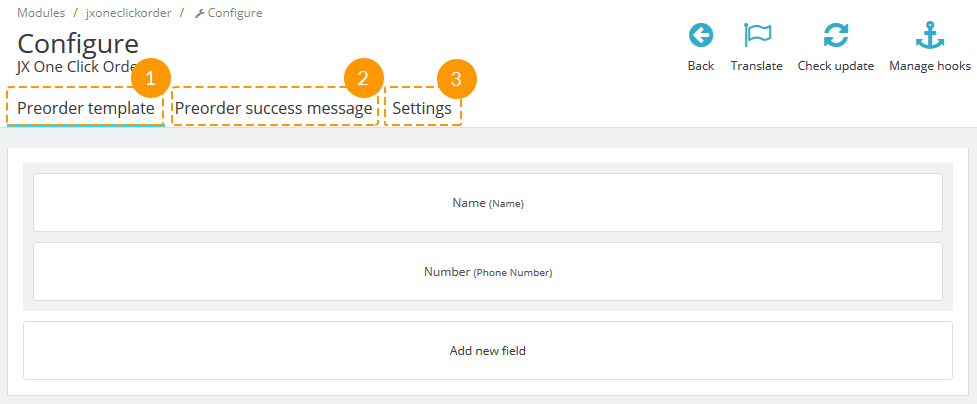
Preorder template
Here you can add a new field by pressing the corresponding button (1):
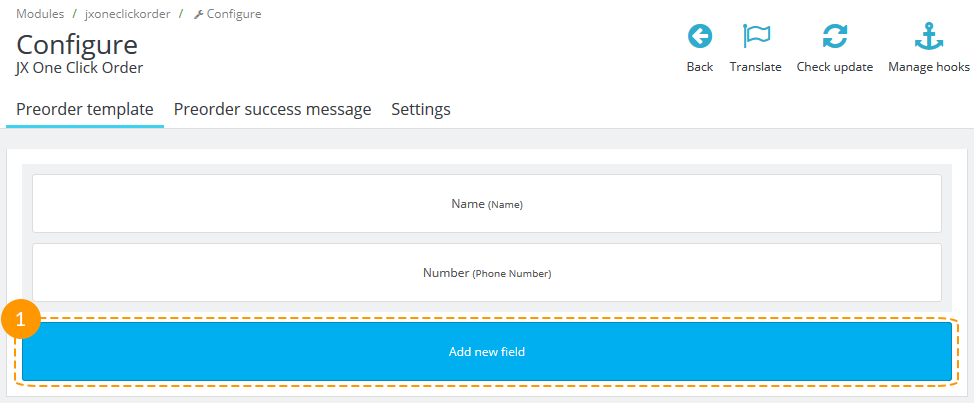
Choose the options for the new field and click the 'Save' button (1):
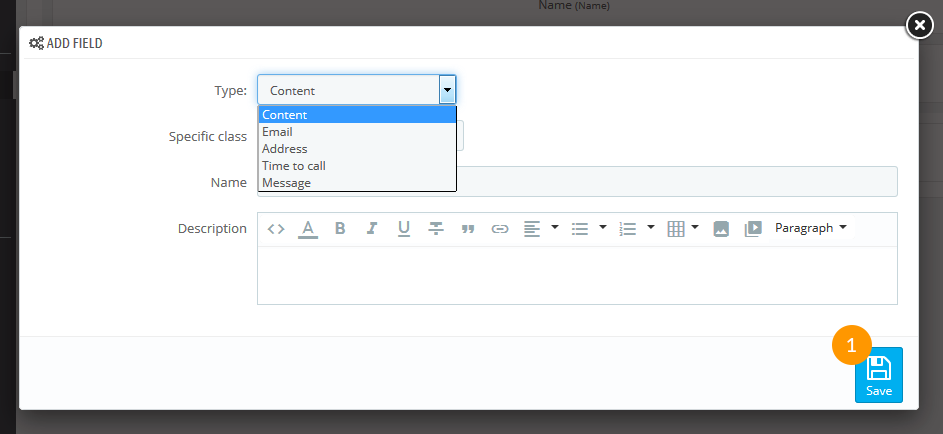
- Type - choose the type of field.
- Specific class - add the custom class for the current field.
- Name - field name.
- Description - field description; appears below the input.
-
Edit the existing field.
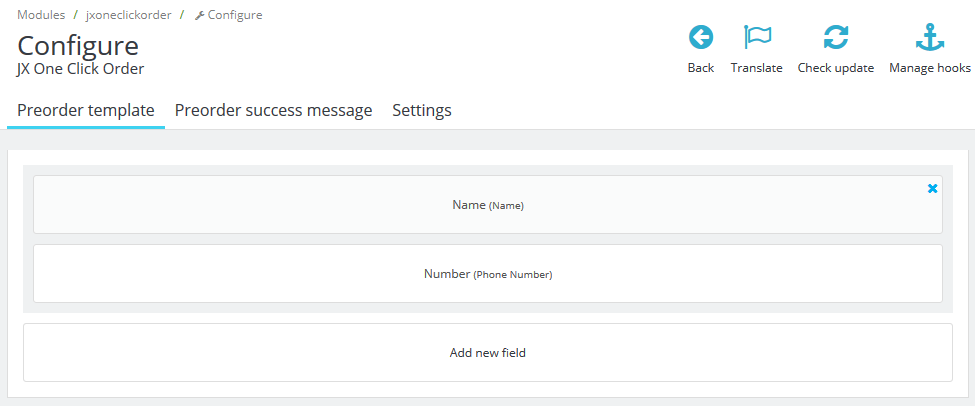
Click on the field you want to edit. The settings are the same as for adding new field.
-
Delete the fields from the form.
Click the 'Delete' button (1) in the top right corner of the field.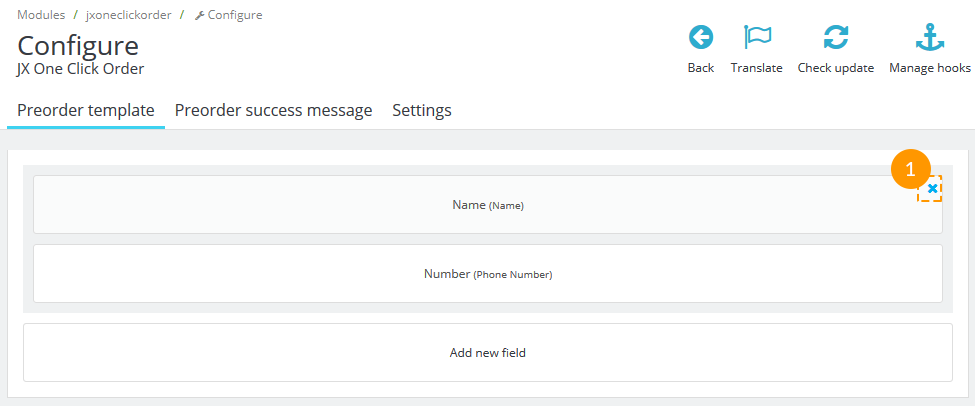
Preorder success message
The tab allows editing the message for the alert window that appears after the user clicks 'Send' button in quick order form.
Add the text/button you want to be shown and click the 'Save' button (1).
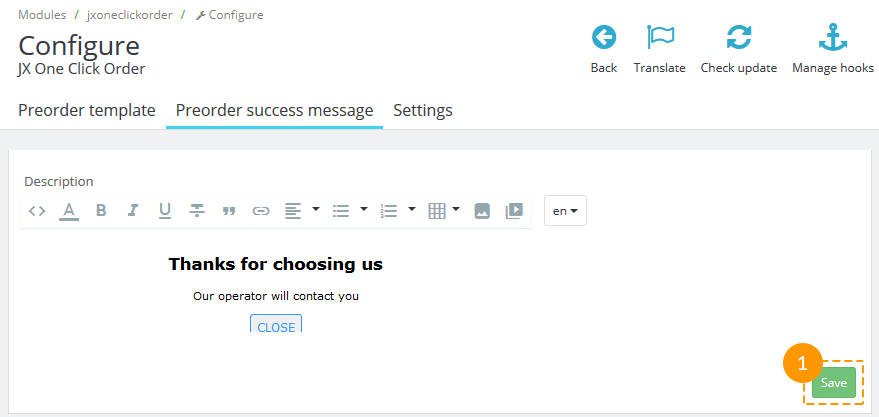
Settings
The tab allows switching the 'Ajax order' option and the 'Notify the owner' option on and off.
It helps the administrator to see the new quick orders which were submitted while processing the existing orders.

If the 'Ajax order' option is enabled, the additional option 'Ajax order timeout' appears.
The value is set in milliseconds and means the time period between each check for new quick orders.
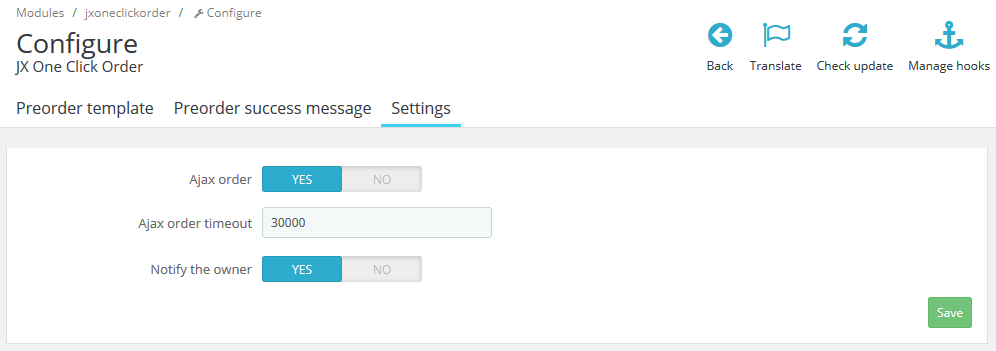
This option helps to open new preorders without page reloading. To see them in the list of quick orders, click the 'Load new orders' link (1) in Orders -> Quick Orders menu.
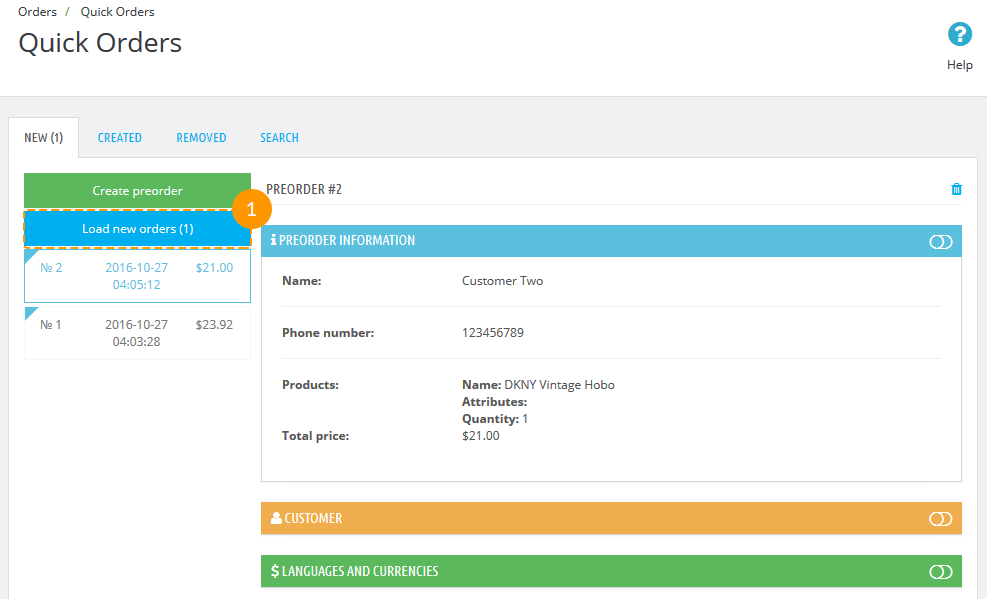
Order processing
Navigate to Orders -> Quick Orders (1) in your admin panel.
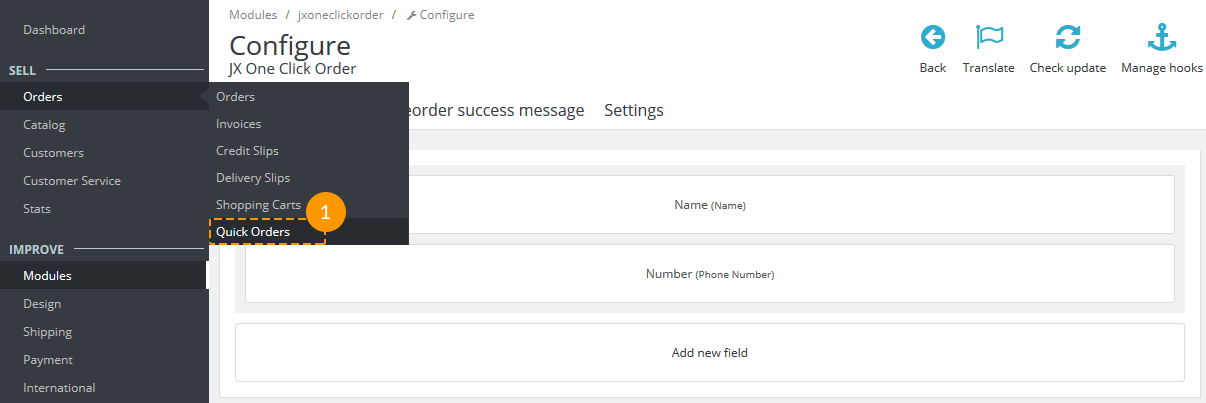
It has four tabs - New, Created, Removed and Search.
-
New - new preorders that have been submitted by the customers.
In the left part there's a button to create a new preorder (1) and a list of preorders (2).
In the right side you can see the preorder details (3) divided into tabs (Preorder information, Customer, Languages and currencies, Cart, Vouchers, Addresses, Shipping, Summary).
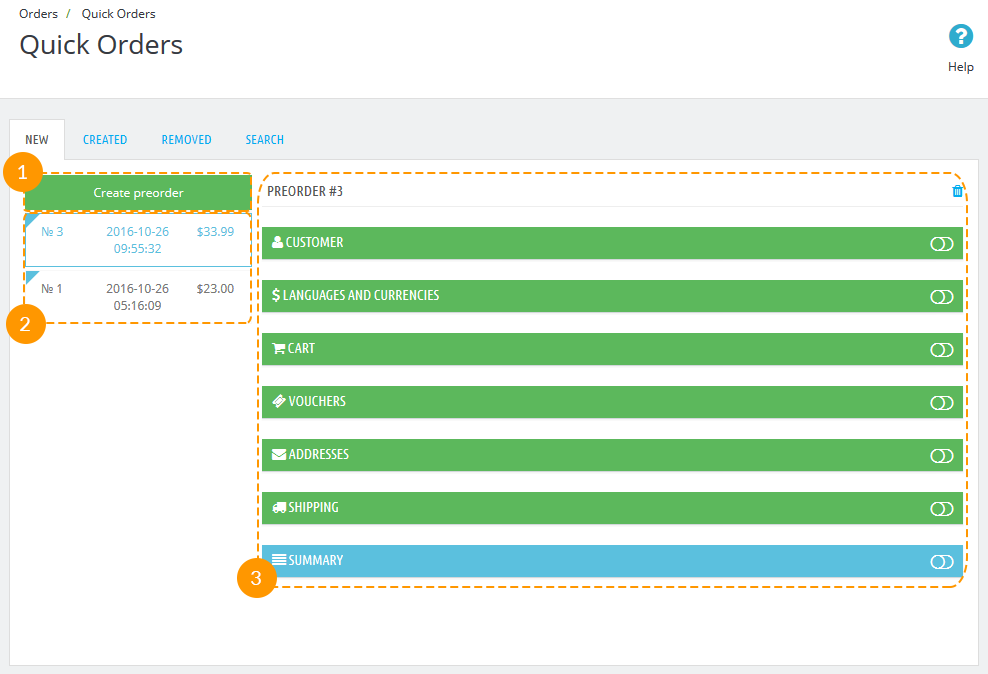
If the order has just been created, you'll see only three of them - Preorder information, Customer, Languages and currencies.
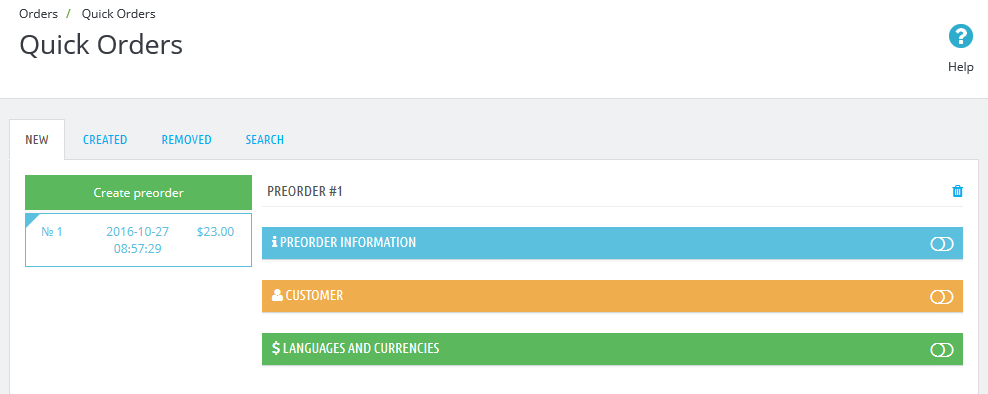
When you fill in the info about the customer, three more tabs will appear - Cart, Vouchers, and Address. When the address info is added, Shipping and Summary tabs will be shown. Tabs where all required information has been successfully added, are colored with green. Yellow colored tabs require some more order details. Blue ones are informational, they are generated automatically.
When the Summary tab appears, there's a button 'Create the order' in the Summary tab (1).
After clicking it the preorder will be transferred from 'New' to the 'Created' preorders list (1).
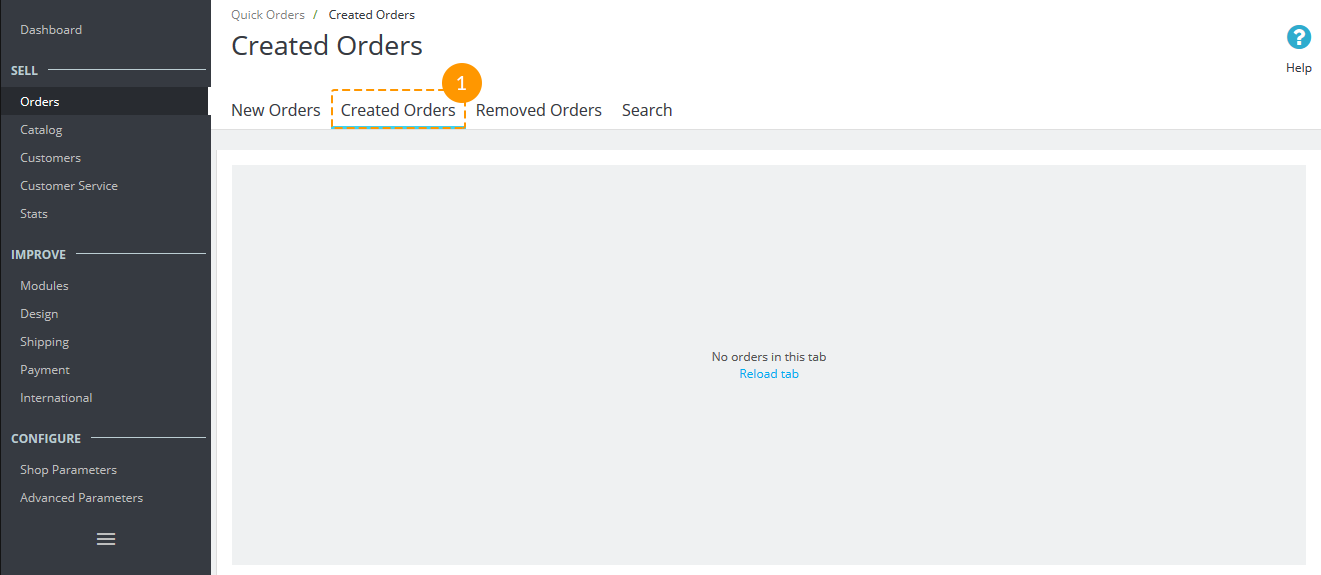
If you need to delete the order, there's a trash sign in the top right corner (1).
Press it and the preorder will be transferred to 'Removed' orders tab.
-
Created - preorders that have been already processed by the administrator.
Choose the order in the left side and click on it to see the detailed info in the right side.
You can also click the 'Show' link to see full information about the customer (1), about the order (2) and the employee (3).
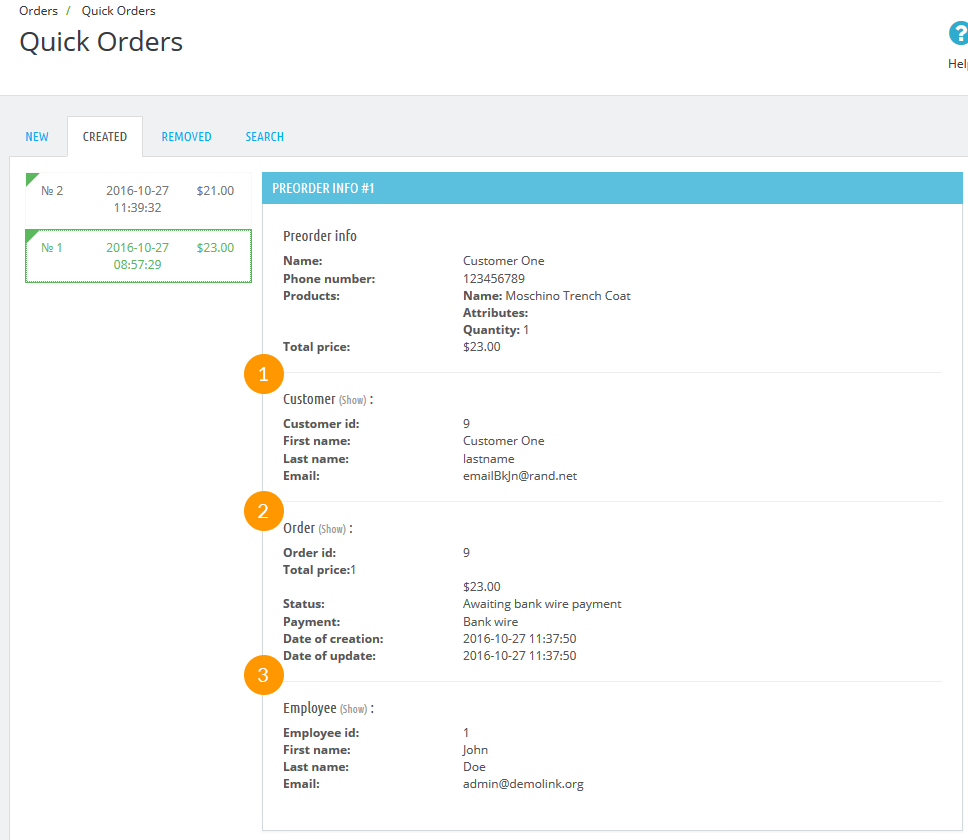
-
Removed - preorders that have been cancelled.
The preorder in this tab can still be recovered by clicking the '+' button (1). Then it will be transferred back to 'New' preorders tab.
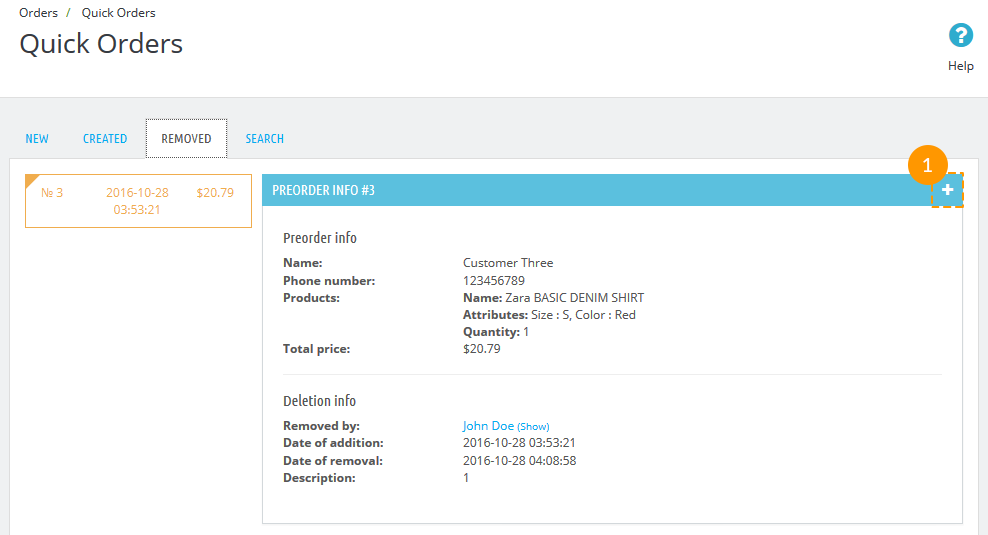
-
Search - preorders search. Enter the search (by customer info, employee info, order id, preorder id); you can also enter the specific date/date period when preorders were created.
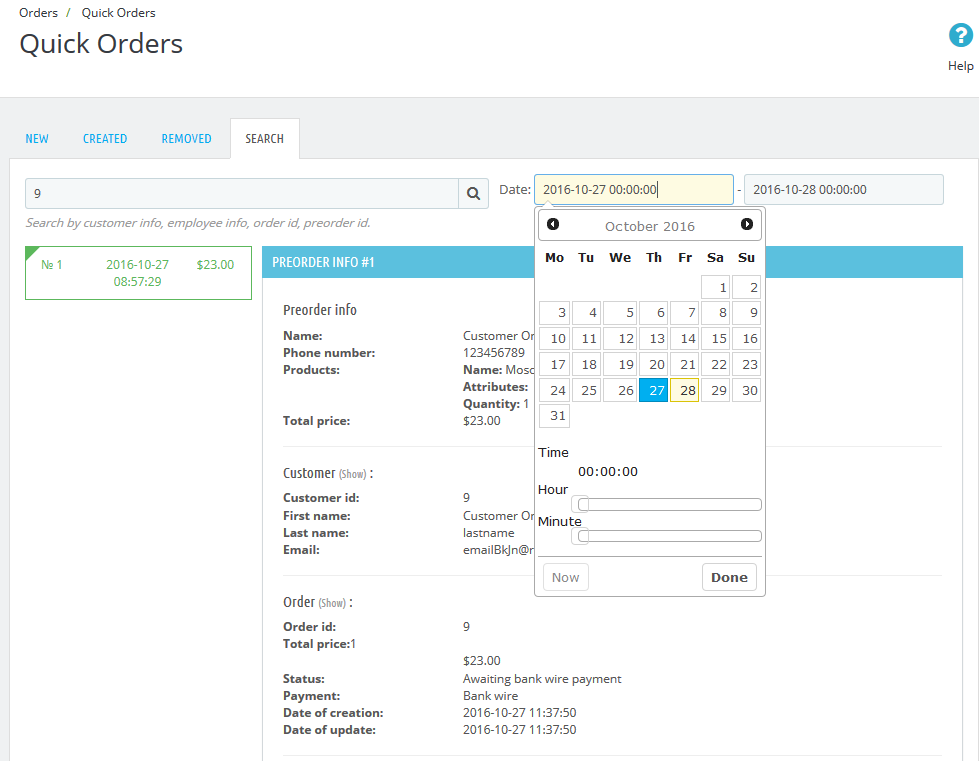
JX Pop-Up Manager
Pop-Up is a form of online advertising that can play an effective role in supplementing your eCommerce business. The aim of pop-ups is to leave a lasting impression on your potential customers to encourage them to buy from your online store.
JX Pop-Up Manager module allows adding versatile informative and on promo pop-ups in your store to increase conversion and the attractiveness of your business.
Installation and Deleting
The module can be installed and deleted like any other PrestaShop module.
When the module is successfully installed, JX Pop-Up Manager menu tab will appear in the main menu of your admin panel with the main module settings.
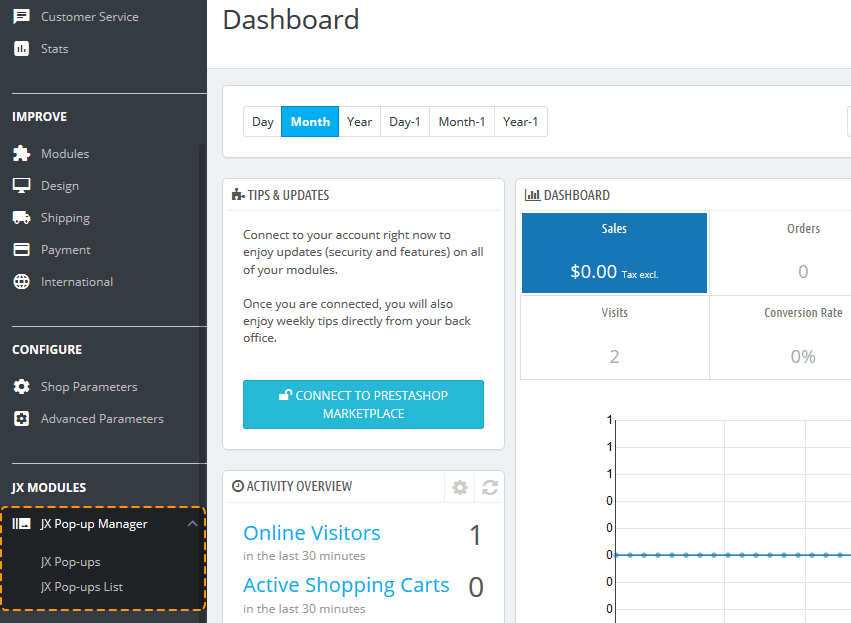
Module configuration
In this section you are able to create informative and on promo pop-ups with different designs.
JX Pop-Ups
Informative Pop-Up - allows announcing your site visitors about special offers, sales, new arrivals.
- In order to create an informative pop-up, choose JX Pop-ups option (1), click the "New block" button at the top.
- In the field "Pop-up type" choose "classic" one.
- Fill in the following settings:
- Title - the name of the pop-up.
- Sub-title - a secondary title of the pop-up.
- Content - write down a pop-up message text.
- Extra Content - additional custom content.
- Background color - pick the main background color.
- Display button - enable/disable the pop-up on the front-end.
- In order to make changes to a pop-up, click the "Edit" button (a pencil (1)). To make the exact copy of a pop-up, click "Duplicate" (2) button. To remove it, click the "Delete" (3) button correspondingly.
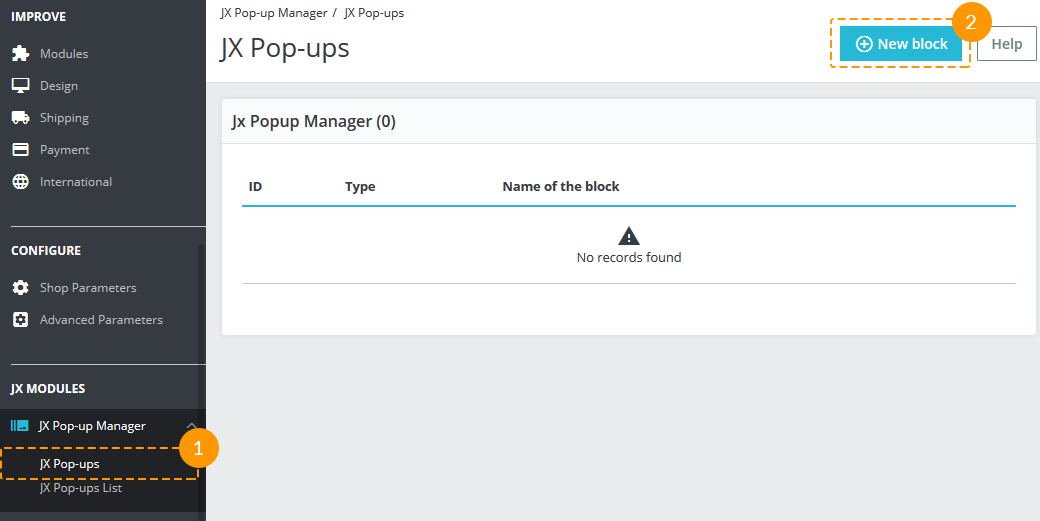

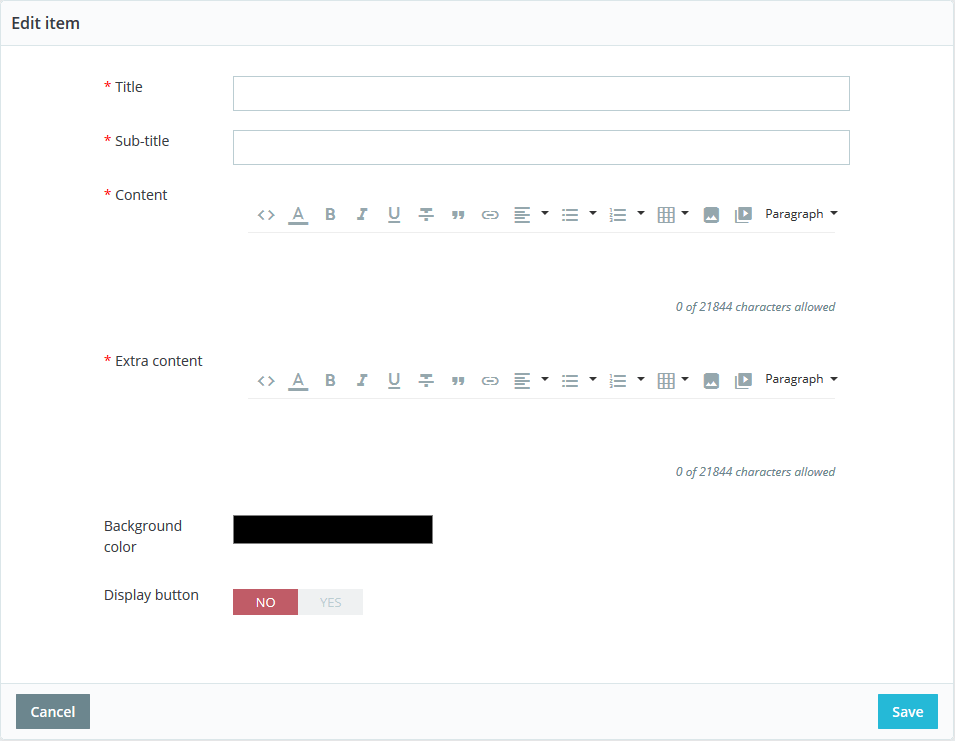

Promo Pop-Up - allows creating an advertising promotion of new arrivals, interesting offers, best deals etc.
- In order to create an on promo pop-up, choose JX Pop-ups option (1), click "New block" button at the top.
- In the field "Pop-up type" choose "promo" one. Click the "Continue" button.
- Fill in the following settings:
- Title - the name of the pop-up.
- Sub-title - a secondary title of the pop-up.
- Link - add the link to the page you want to pay attention to.
- Label - set the specific label (new, special) to emphasize more attention to the needed content.
- Content - write down a pop-up message text.
- Extra Content - additional custom content.
- Background - choose the background image for your pop-up.
- Template type - choose the sample of the pop-up from the drop-down list.
- In order to make changes to a pop-up, click the "Edit" button (a pencil (1)). To make the exact copy of a pop-up, click "Duplicate" (2) button. To remove it, click the "Delete" (3) button.


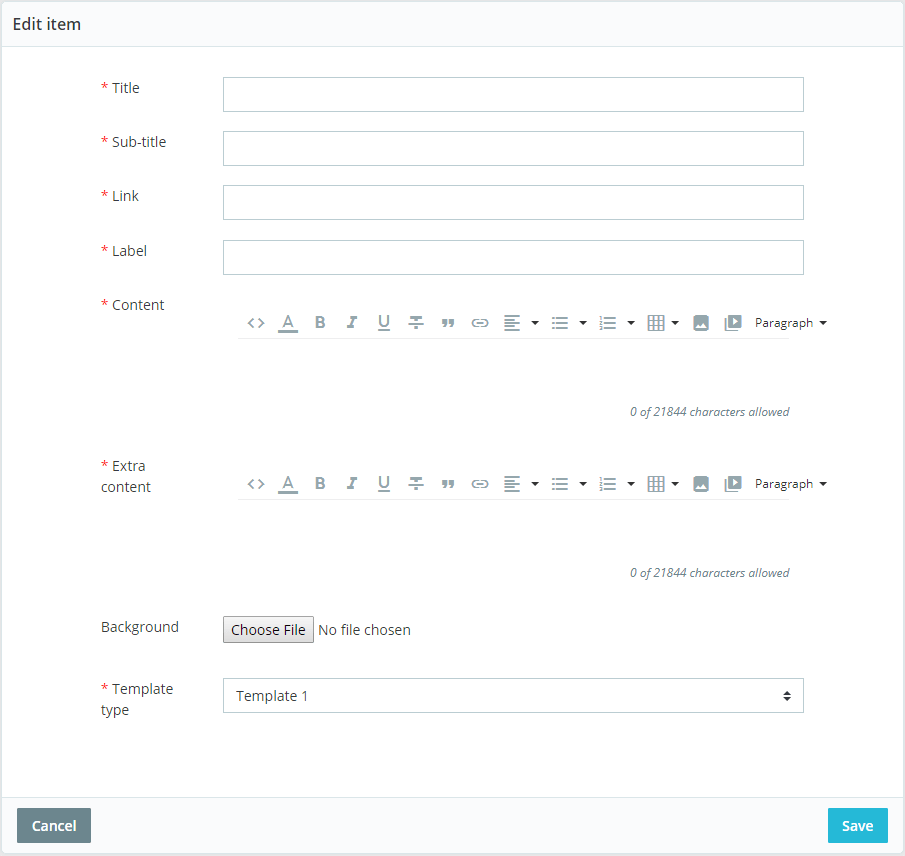

JX Pop-Ups List
In the following section, you can make different operations on the pop-ups that were created.
In order to make some operations on the chosen pop-up, in JX Pop-Ups List section, click "New block" button.
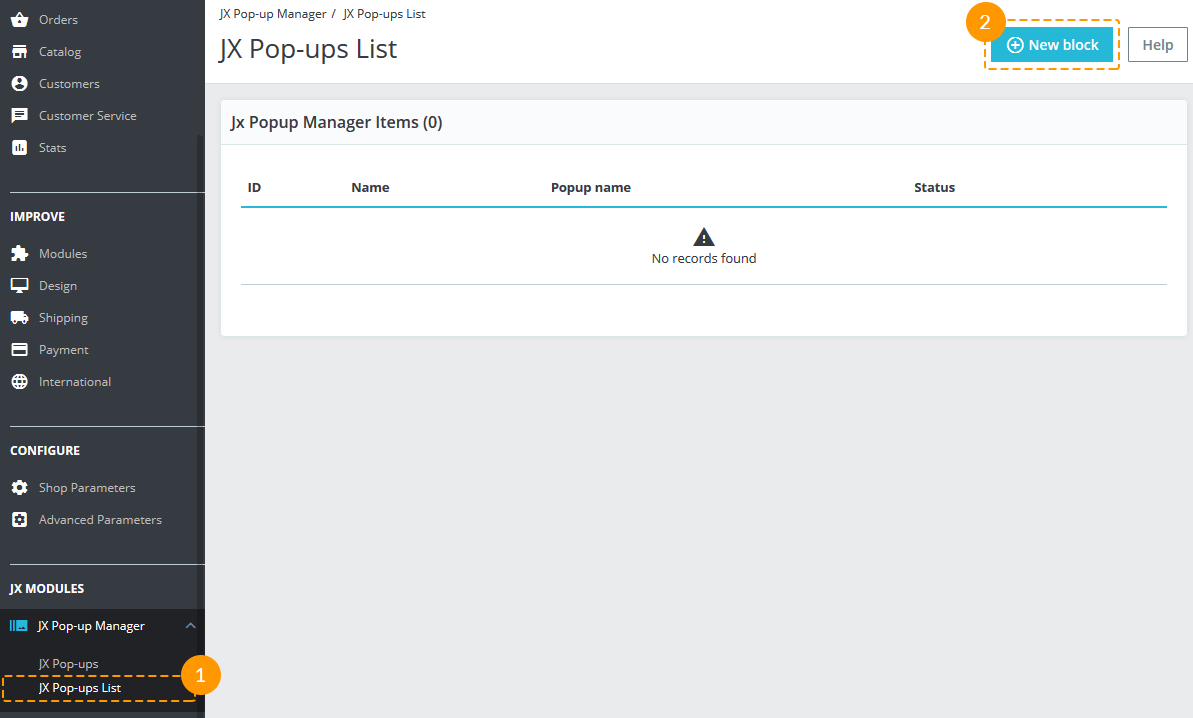
The settings are divided into 6 tabs: Main Info, Settings, User groups, Stores, Pages, and Categories.

Main Info
Here you can set the pop-up you want to make the operations on and fill in the general information about the chosen pop-up.
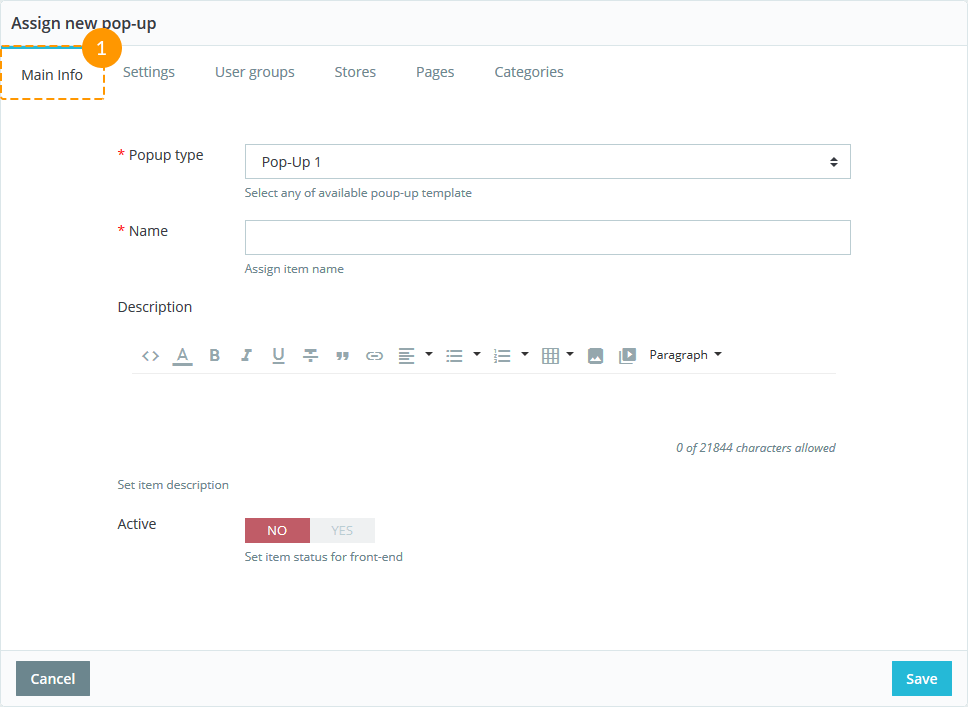
- Pop-Up type - choose one of the created pop-up from the available.
- Name - set the name of the item.
- Description - write the description of the item.
- Active - set the status of the pop-up. Enabled or disabled.
Settings
In this section, you are able to set all the technical settings for the pop-up.

- Delay - set the delay before the pop-up appears and it will not be shown up right away, but only after the time you have specified passes since the client visits your site.
- Frequency - set the frequency (in minutes) with that the pop-up will appear all the next time.
- Load delay - set the delay (in milliseconds) after which the pop-up will appear after the page reload.
- Active from - choose the date from which the pop-up will be visible for users.
- Active to - choose the date to which the pop-up will be visible for users.
- Disposable - set if a user can disable the pop-up next appearances.
User groups
Here you can choose which users group(s) will be allowed to see the pop-up. You may check Visitor, Guest, Customer groups separately, or check all groups at once. But note, if you won't select any of the group, all groups will be allowed to see the pop-up.
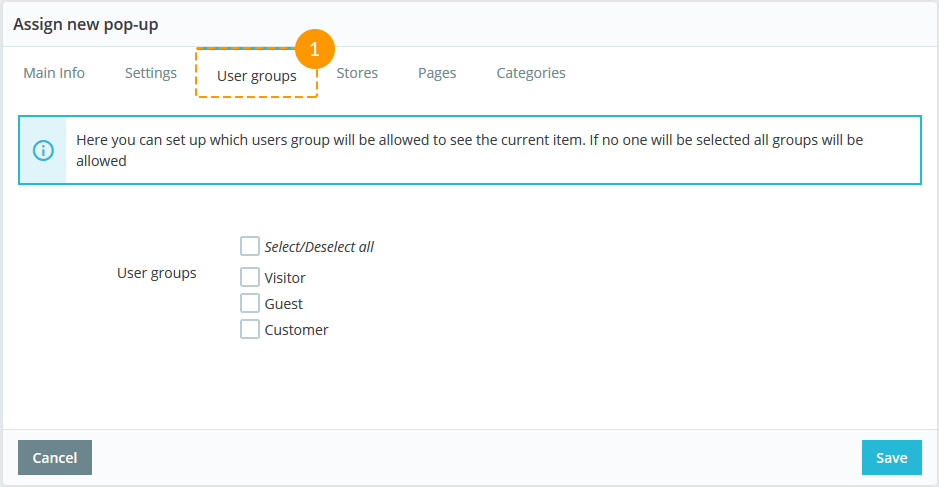
Stores
You can settle which store users will be allowed to see the pop-up. Simply check/uncheck the stores you want to allow seeing the pop-up.
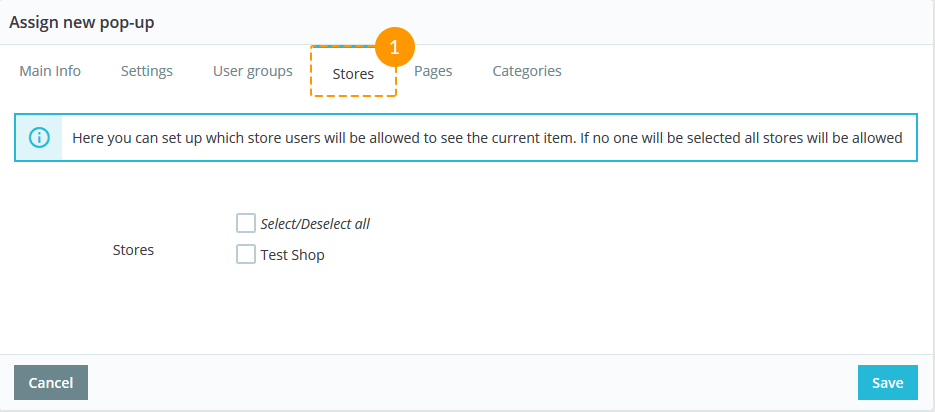
Pages
You can choose the pages where to display the pop-up from the list below. Check some definite or select all of them.
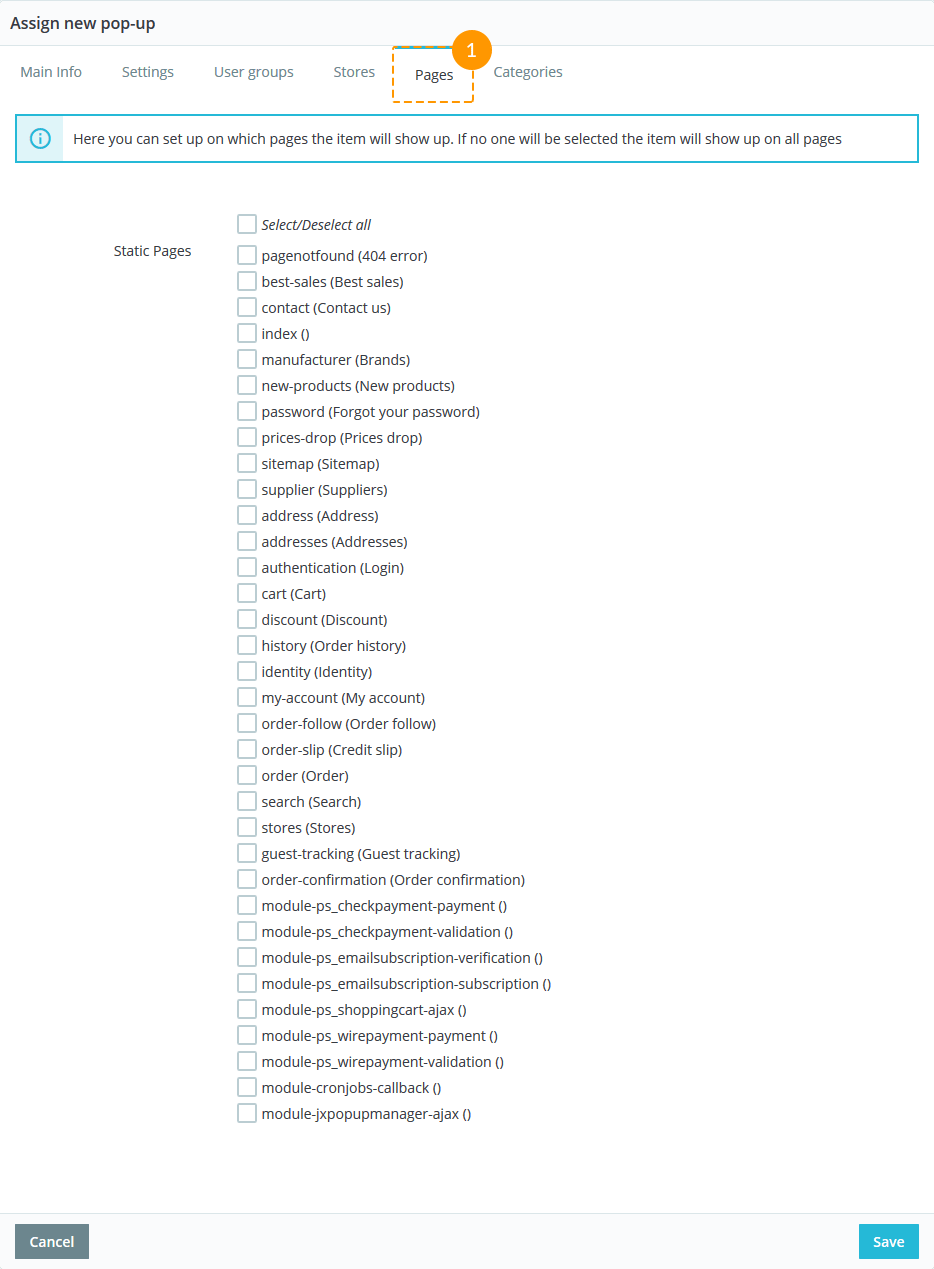
Categories
This section allows you to choose on which categories pages the pop-up may be displayed. You may enable this option for all the categories at once.
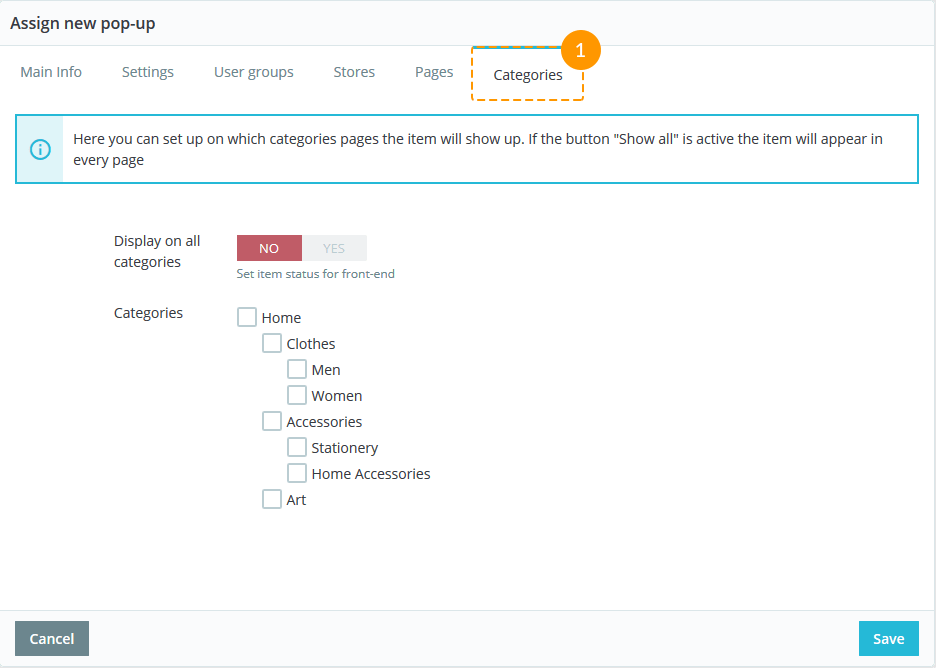
After saving the settings, the created pop-up appears on the front-end.
In order to change some settings for the pop-up, click the "Edit" (1) button. To remove it, click the "Delete" button correspondingly (2).

JX Product Custom Tab
The module serves to create an additional tab on the product page for displaying additional information. The module has an advantage over the existing functionality, due to the ability to add images, text, video, links, etc.
Installation and removal
The module is installed and removed as any other PrestaShop module.
Module settings
After installing the module, you can add new tabs for the products at the module configuration page, as well as at the product editing page.
Adding tabs through the module configuration:
To add a new tab, press the 'Add new' button (1).
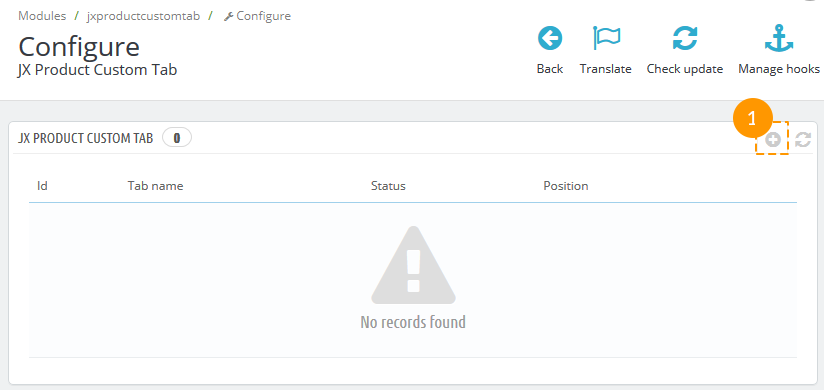
-
Adding a tab to one or several products of a previously selected category.
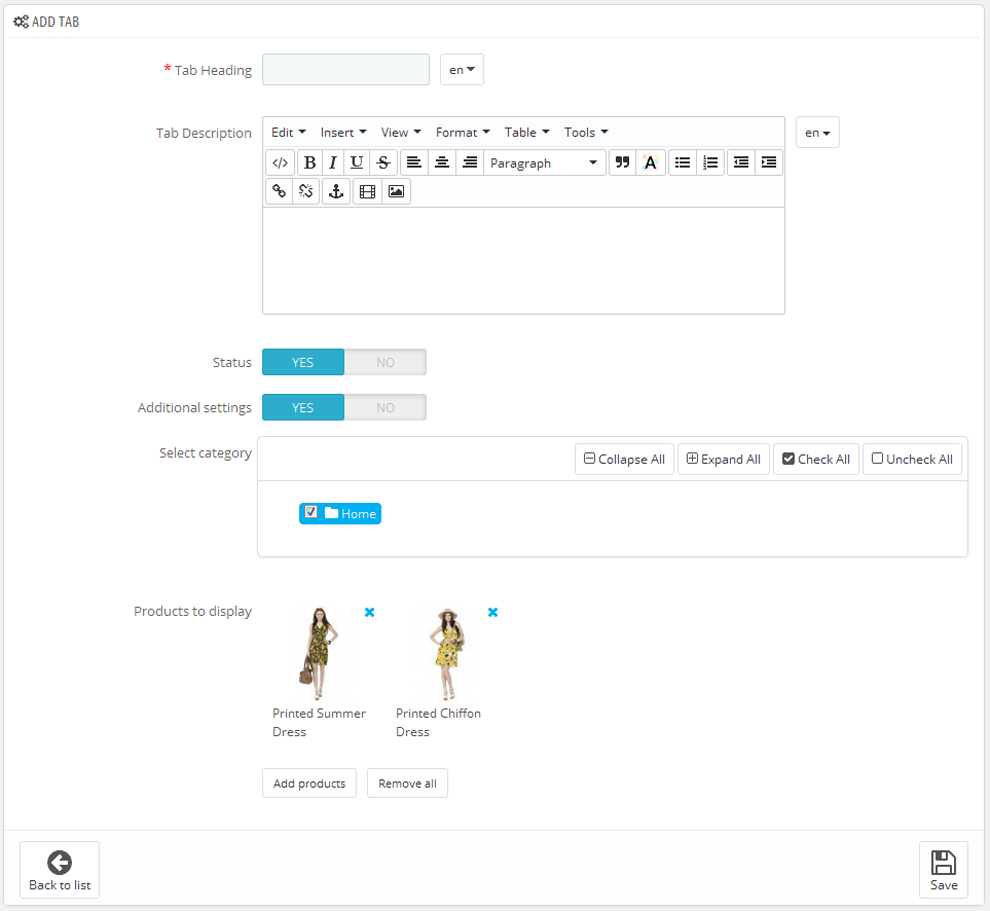
- Tab Heading - name of the tab, required.
- Tab Description - information about the tab, can include data in the format of an image, text, video, links, etc.
- Status - the element status.
- Additional settings - enabling/disabling additional settings.
- Select category - choosing categories for which the tab should be displayed.
- Products to display - selecting the products from the previously selected categories.
-
Adding the tab to the products that belong to selected categories.
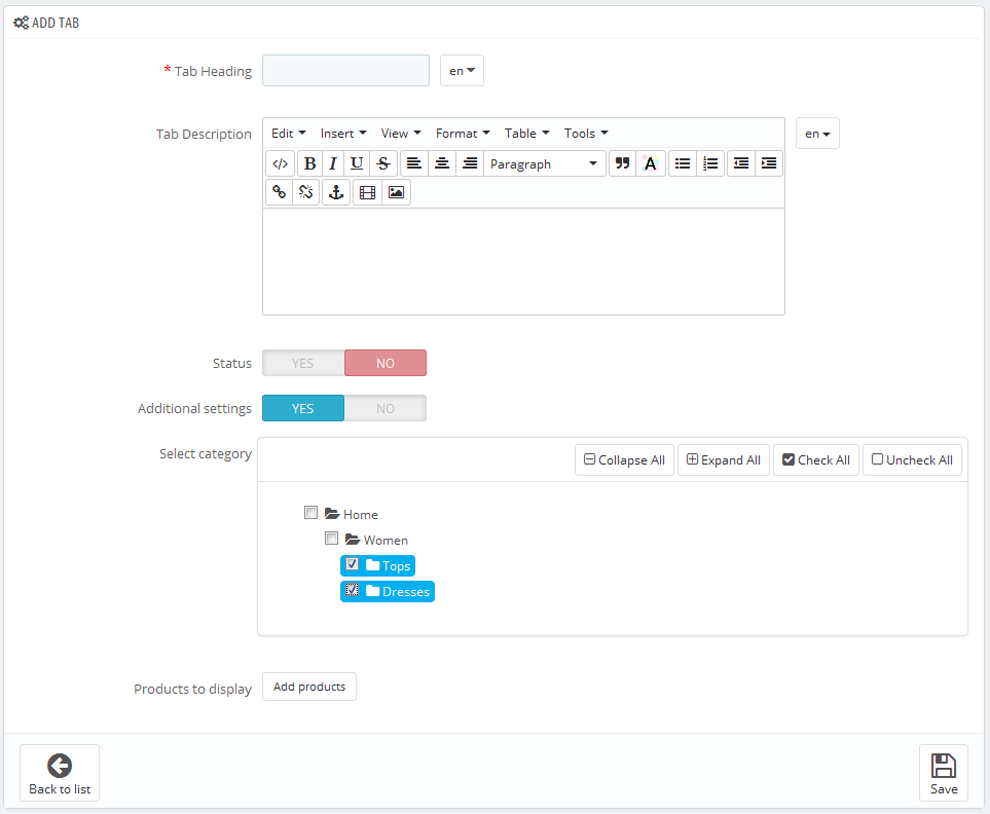
-
To add a tab to all products, disable the 'Additional settings' option.

Changing the tab display position
Drag and drop the needed tab to change its position.

Adding tabs through the product settings:
Navigate to the product page and click the 'JX Product Custom Tab' link in the "Modules options".
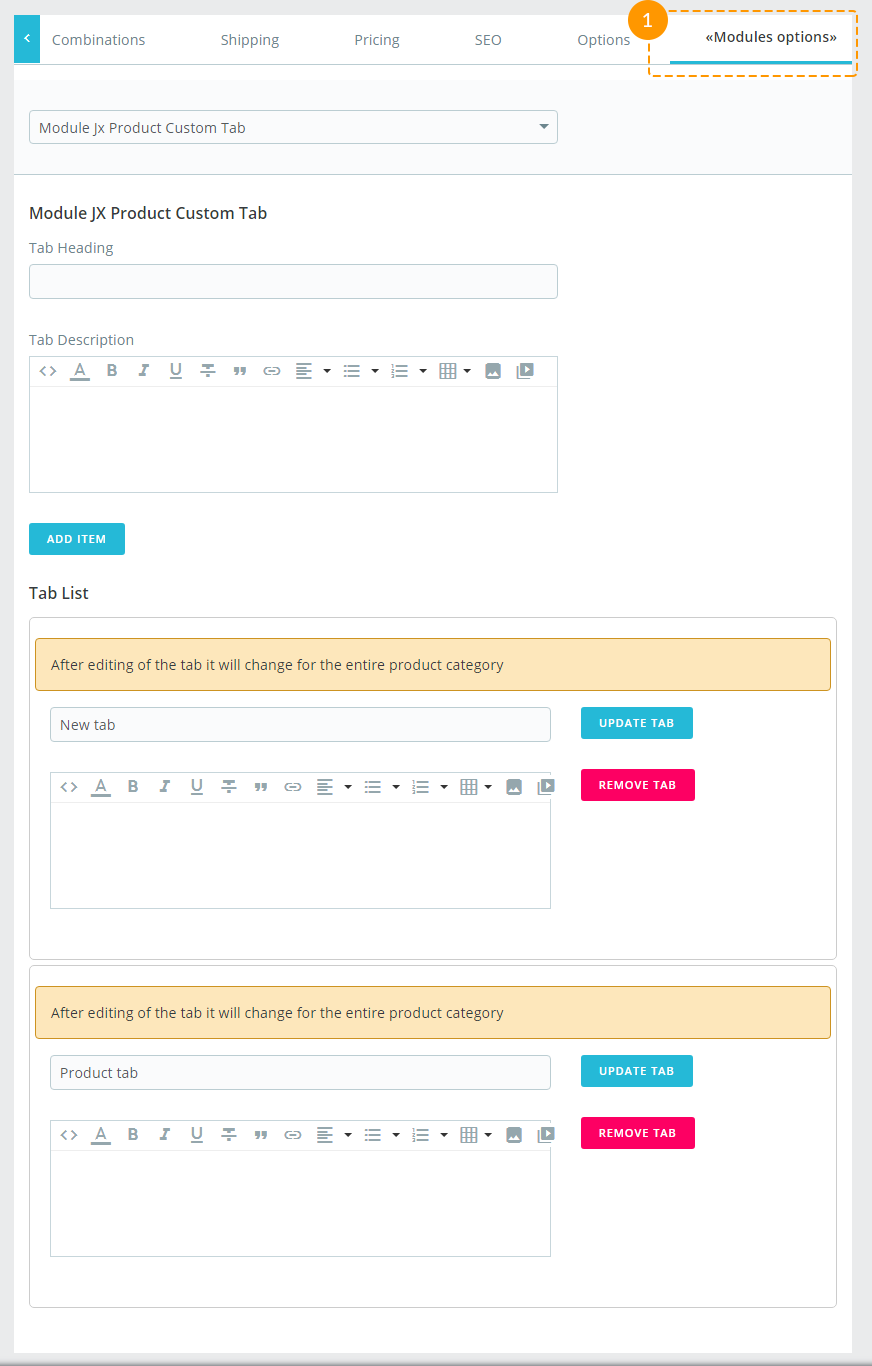
If the 'Additional settings' option is disabled, the tab will be added to the product that was edited earlier. You can also add the tab to the products that belong to selected categories, or you can add it to several products that belong to the previously selected category.
To change the tabs display position, drag-and-drop the blocks. You can edit or remove tabs as well.
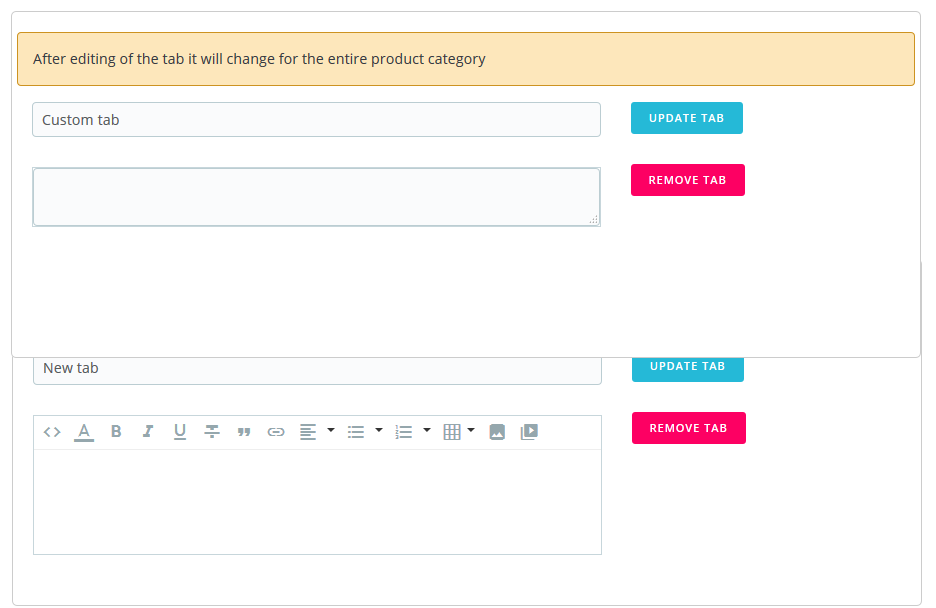
JX Product List Gallery 2.0.0
This module displays all the available product images in form of a gallery on product listing pages. Depending on what settings you choose, the module can display images in form of a rollover or slideshow.
Module Installation and Deleting
This module can be installed and deleted like any other PrestaShop module.
Module settings
After the module is installed, navigate to \themes\classic\templates\catalog\_partials\miniatures\product.tpl. Open this
file and find the following code:
{block name='product_thumbnail'}
{if $product.cover}
<a href="{$product.url}" class="thumbnail product-thumbnail">
<img src="{$product.cover.bySize.home_default.url}" alt="{if !empty($product.cover.legend)}{$product.cover.legend}{else}{$product.name|truncate:30:'...'}{/if}" data-full-size-image-url="{$product.cover.large.url}">
</a>
{else}
<a href="{$product.url}" class="thumbnail product-thumbnail">
<img src="{$urls.no_picture_image.bySize.home_default.url}">
</a>
{/if}
{/block}
and replace it with:
{block name='product_thumbnail'}
{if $product.cover}
<a href="{$product.url}" class="thumbnail product-thumbnail">
{capture name='displayProductListGallery'}{hook h='displayProductListGallery' product=$product}{/capture}
{if $smarty.capture.displayProductListGallery && count($product.images) > 1}
{hook h='displayProductListGallery' product=$product}
{else}
<img src="{$product.cover.bySize.home_default.url}" alt="{if !empty($product.cover.legend)}{$product.cover.legend}{else}{$product.name|truncate:30:'...'}{/if}" data-full-size-image-url="{$product.cover.large.url}">
{/if}
</a>
{else}
<a href="{$product.url}" class="thumbnail product-thumbnail">
<img src="{$urls.no_picture_image.bySize.home_default.url}">
</a>
{/if}
{/block}
After installing and connecting the module, you can set it up on the module configuration page.
The module has the following main settings:
- Live mode - ability to use the module in live mode.
- Type - select display type: rollover, gallery or slideshow.
If you choose rollover, you can choose the animation effect:
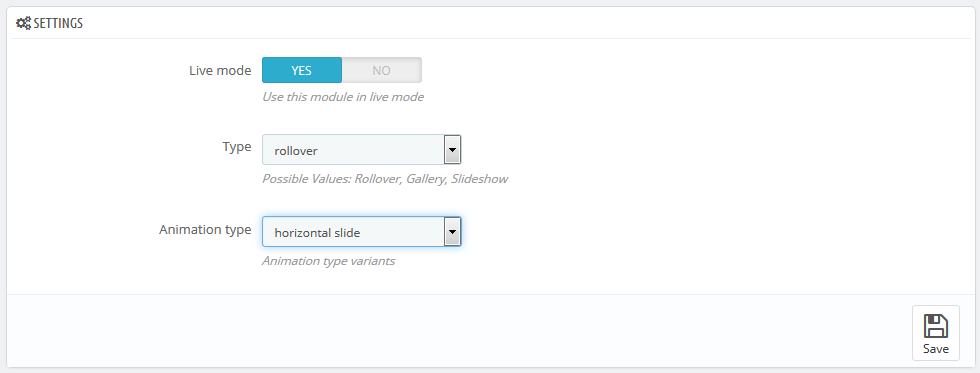
- Opacity slide - opacity changes;
- Horizontal slide - horizontal;
- Vertical slide - vertical.
If you choose gallery, you will find the following settings available:
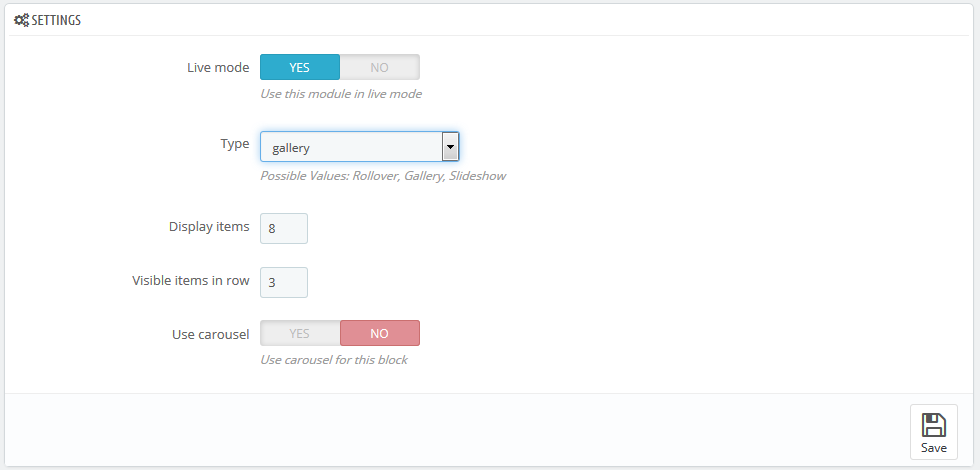
- Display items - the number of items displayed;
- Visible items in row - the number of items in a row;
- Use carousel - enable/disable the carousel for this block.
If you choose slideshow, you will find the following settings available:
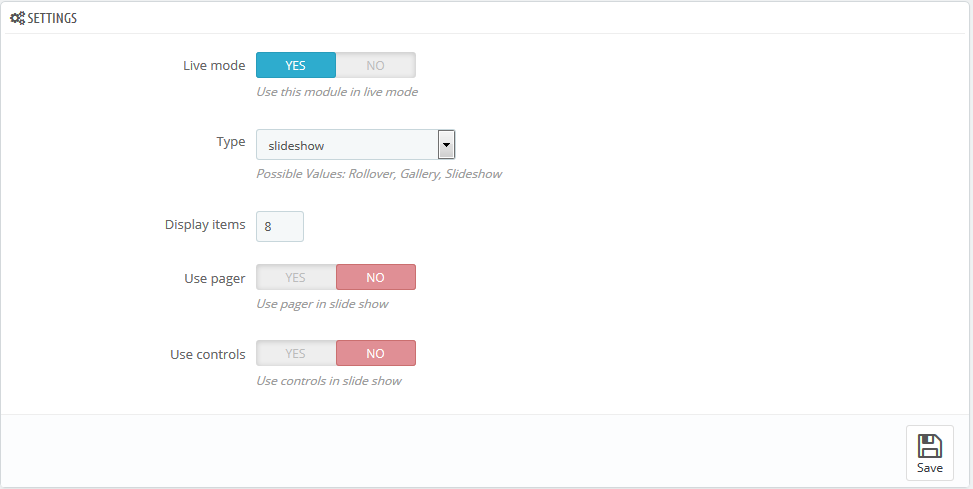
- Display items - the number of items displayed;
- Use pager - pager display in slide show;
- Use controls - controls display in slide show.
JX Products Manager
Introduction
The module is created for managing online shops, especially shops with a big amount of products. Using this module you can easily filter your products and make different operations on them.
Installation and removal of the module
The module is installed and removed as any PrestaShop module.
Removal or re-installation of the module will not reset the changes you made using it.
When the module has been successfully installed, go to Catalog -> JX Products Manager (1) to see the module's main menu.
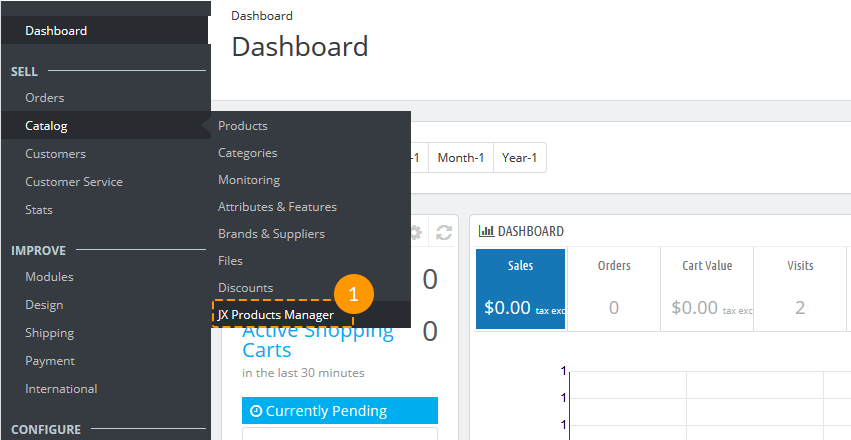
Performance
The main module menu is divided into two main parts: 'Choose section' (1) and 'Choose option' (2).
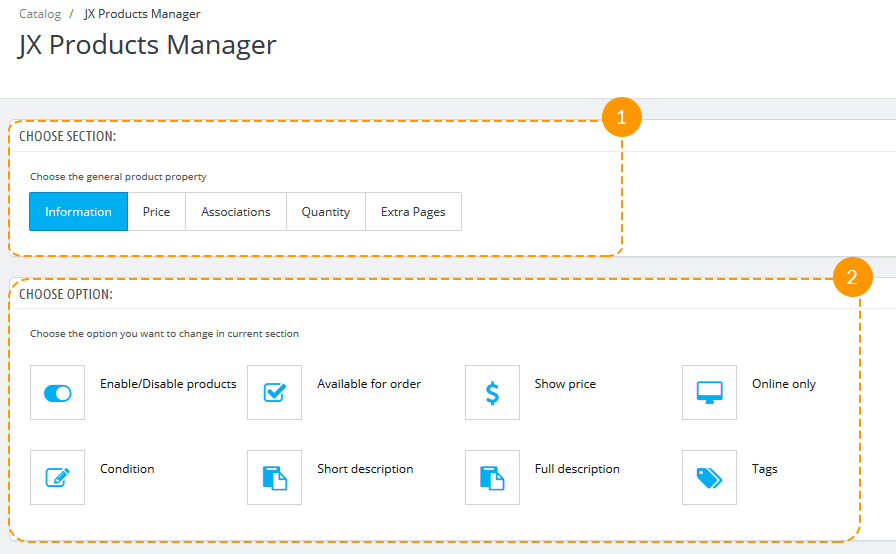
The first part is created in the form of tabs - Information, Price, Associations, Quantity and Extra Pages.

- Information - options concerning product availability and description.
- Price - price and tax rules settings.
- Associations - ability to change brand, category or accessories of several products.
- Quantity - changing products' quantity.
- Extra Pages - ability to add a new page.
-
Click each tab to see the available options in this section. They will be described further.
Each option has a hint - short description, which appears in the right when you hover the option (1).
-
Choose the needed option and click it.
-
The next step is filtering products. Set the filtering options according to your needs and click the 'Select' button (1). To clear the selected filters click the 'Reset' button (2).

You can also cancel each of the filters after you've selected them. Simply click the cross (1) near the product property value and it will be removed.
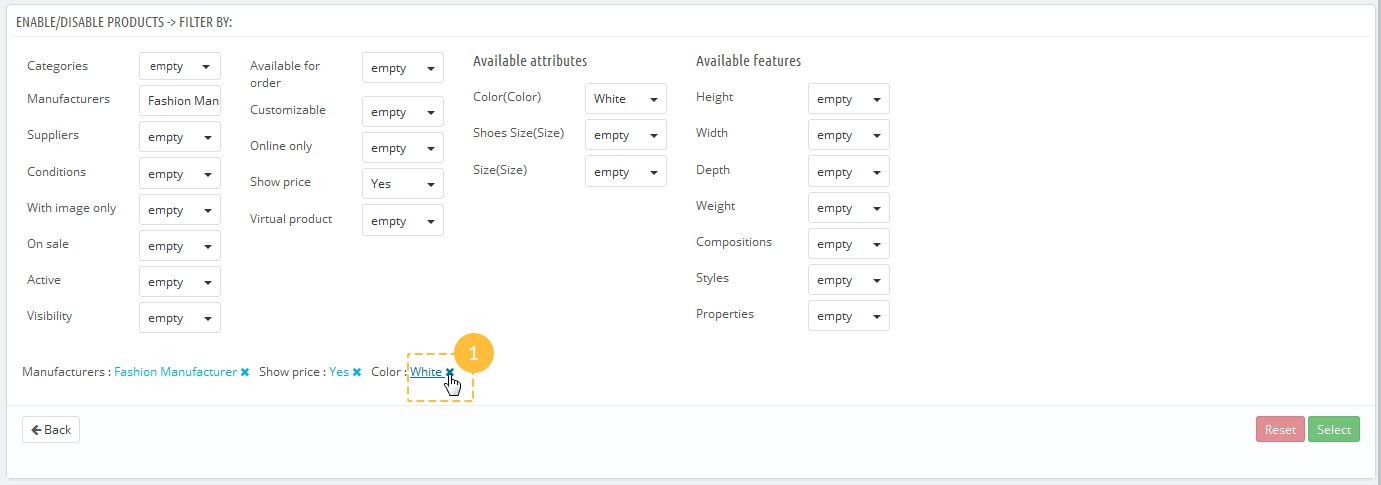
-
Below the filters there's a list of products matching the selected criteria. You can edit it if you need to delete some products from the list. Each product can be removed separately by clicking 'Remove from the list' button (1). To remove all products from the list, click the 'Select all' (2) and 'Remove selected' (3) buttons. If you checked a large number of products and need to uncheck them, click the 'Unselect all' button (4).

-
When the list of selected products complies with all requirements, click the 'Process' button (1).
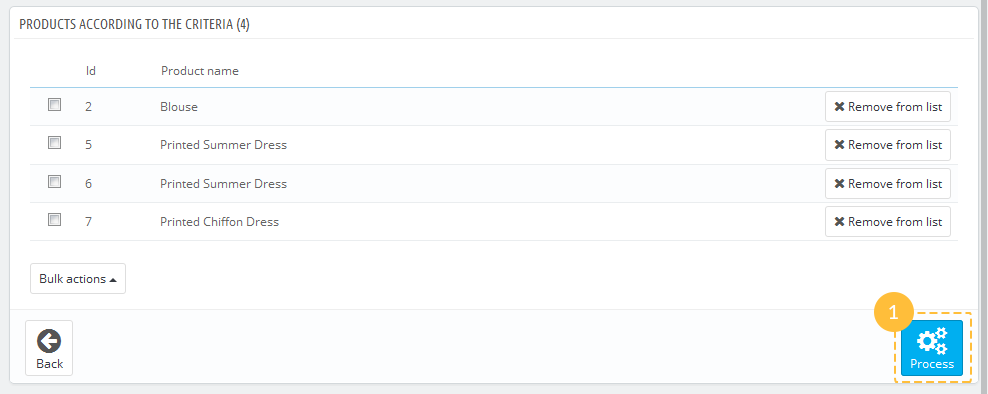
-
Set the option/options according to your needs and click the 'Save' button (1). If you need to make some changes in products list, click 'Back to filter' button (2).
Please note, that you won't be able to undo these changes the same way.

Available options
Information
The section allows to configure the following options:

- Enable/Disable products - set the on/off status of your products.
- Available for order - make some products available or unavailable for order.
NOTE: if 'Available for order' is set to 'Yes' for the products with hidden prices, their prices will automatically become visible again.
- Show price - show or hide product price.
NOTE: if you set 'Show price' to 'No' for the products, which are available for order, they will be automatically changed to unavailable.
- Online only - apply the 'Online only' mark to the selected items.
- Condition - change the condition of multiple products.
- Short description - add a short description which should be applied to all selected products.
- Full description - add a description to selected products with an ability to place it before the main description, after it, or replace the whole description with the new one.
- Tags - add more tags to the chosen products.
Price
In this section you can change options concerning product price.
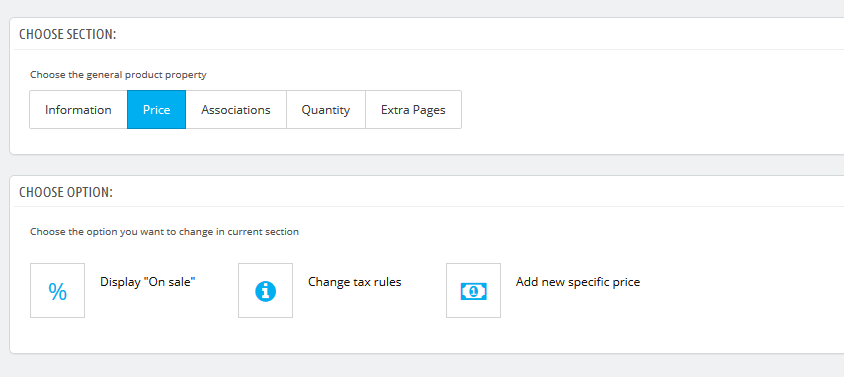
- Display "On sale" - display the selected items with 'On sale' mark.
- Change tax rules - choose the tax rules which will be applied to several products.
- Add new specific price - set the special price for selected products with an ability to add the price activation period.
Associations
Here you can change options connected with product relations.

- Change brand - change brand of selected items.
- Change default category - choose the category which will be set as default for some products.
NOTE: You can choose only one default category. Keep in mind that your current default category will be replaced with the new one.
- Change related categories - set the related categories to multiple products with an ability to save or remove old relations.
- Add accessories - add the accessories suitable for the chosen products.
Quantity
This option allows to set the product quantity or increase/decrease current quantity by a certain amount.

- Change quantity - set the required quantity of some products.
Extra Pages
This option allows to add a new page.
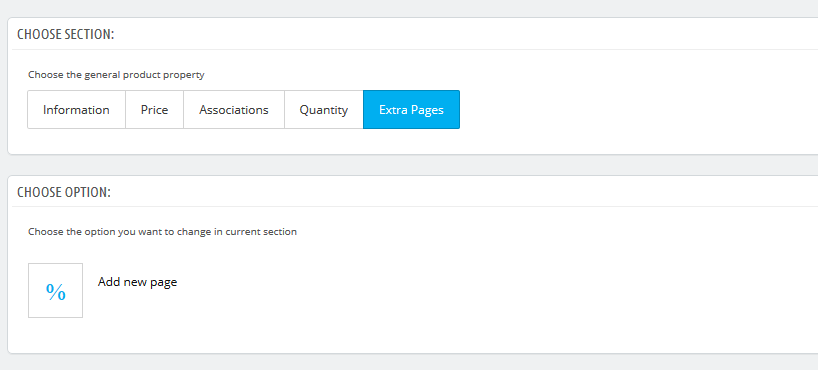
- Add new page - create a new product page.
JX Products Slider 2.0.2
Introduction
This module serves for creating galleries, based on product data and displaying them in form of slides on the website frontend. The module supplies 4 methods of displaying the gallery with individual settings and appearance. Each method has pre-defined functionality. Advanced configuration is also available. The module can display an unlimited amount of products with diverse information.
Installation and removal of the module
The module is installed and removed as any default PrestaShop module.
After removal or re-installation of the module, all the settings and filters are discarded.
Adding/deleting/editing a slide
Adding a slide
To add a product to the gallery, go to the needed product in the Catalog -> Products section. Then press the 'Edit' button (2) next to the needed product.

In the appeared window for editing information about the product choose Modules tab (1), navigate to the JX Products Slider.
Mark (2) that you want the product to be displayed in slider. Save changes by pressing 'Save'
button (4).

Slide removal
There are two ways of deleting a slide.
-
To exclude a product from the gallery, navigate to the needed product in Catalog -> Products section. Then press the 'Edit' button (2) next to the needed product.

In the appeared window for editing information about the product choose Modules tab (1), navigate to the JX Products Slider tab and remove the check mark (2) which means that you don't want the product to be displayed in slider. Click the Save button:

-
The second way is to navigate to the JX Products Slider module configuration page, find the needed product in the Slides list table and press the Delete button (1) next to it.

Then confirm the deletion.
Slides display order
By default, the slides are displayed in the order they were added. To change the display order, navigate to the module configuration page and drag the slide to the needed place in Slides list table.

Disabling slides
Moreover, you can temporarily disable a slide (for the time period that a product is out of stock or for any other reason) without removing it completely. To do this, navigate to the module configuration page and click a tick next to the needed product (if it's active now) or click crosses (if it's inactive) in the Slides list table:

Gallery types and recommended settings
There are four types of gallery display (standard, list, grid, full width). Each of them can be set up independently and you can switch between them if needed.
By default, the gallery uses the following product image types: large_default - for the main image; medium_default - for thumbnails.
Standard
Recommended settings:
- image size (px) - 435*435
- Gallery Width - 1170px
- Gallery Height - 580px
- Extended Settings - off
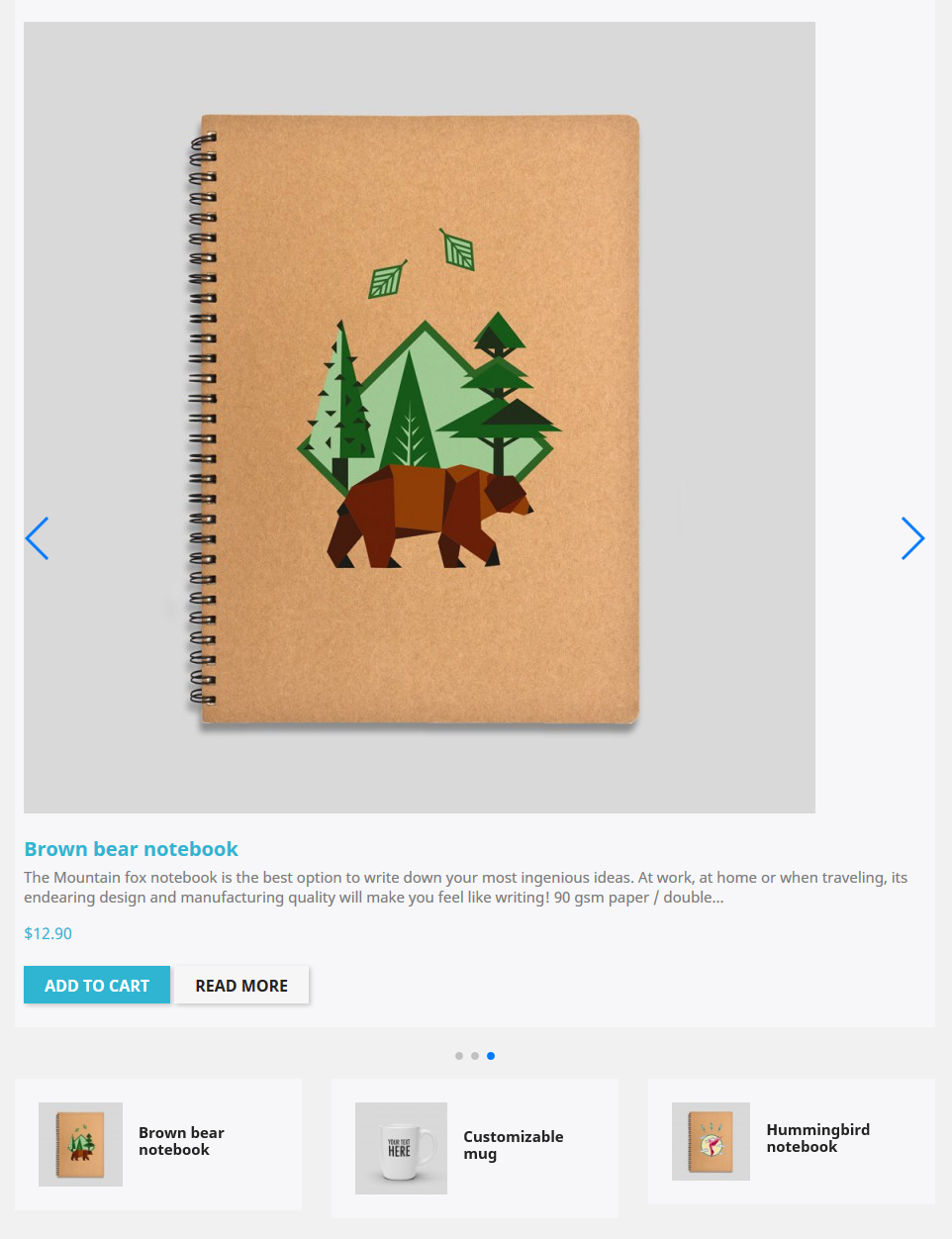
List
Recommended settings:
- image size (px) - 435*520
- Gallery Width - 1170px
- Gallery Height - 520px
- Extended Settings - off
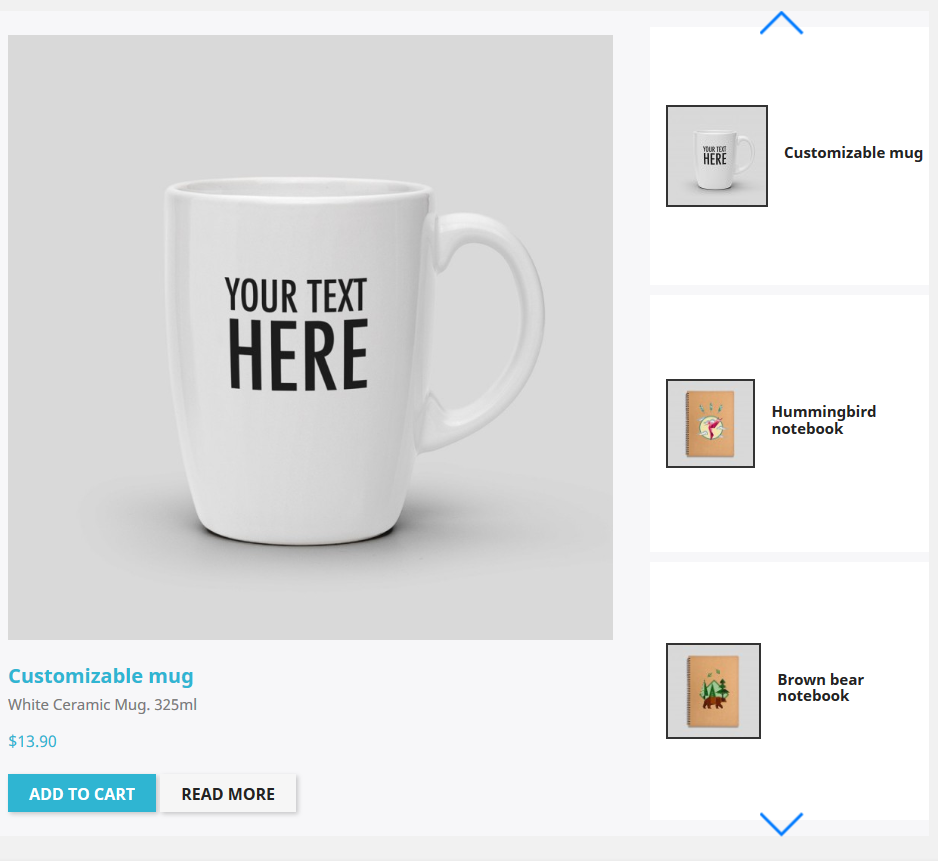
Grid
Recommended settings:
- image size (px) - 585*750
- Gallery Width - 1170px
- Gallery Height - 750px
- Extended Settings - off
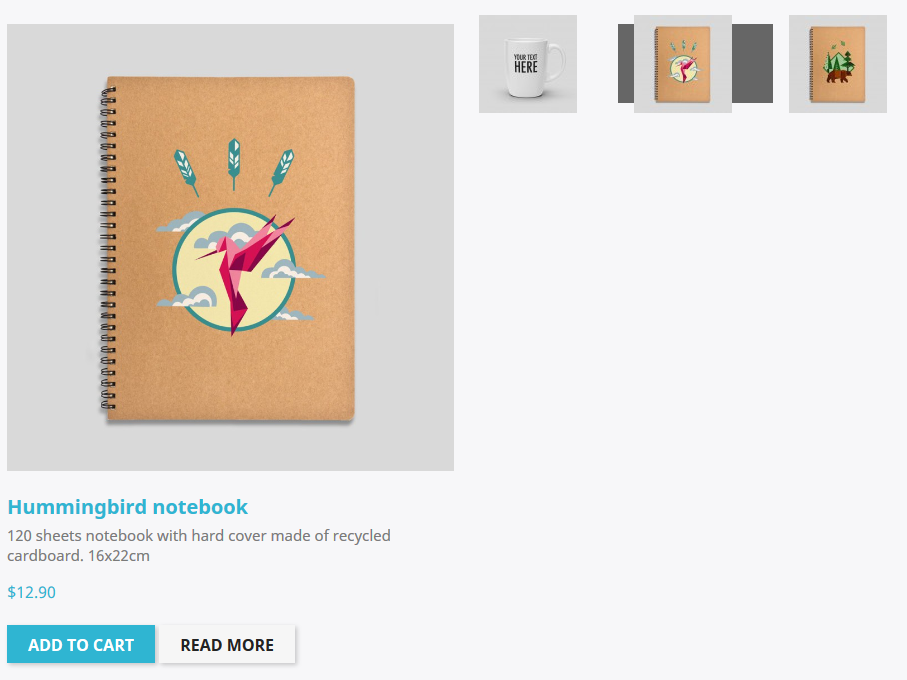
Full width
Recommended settings:
- image size (px) - 435*435
- Gallery Width - 1920px
- Gallery Height - 450px
- Extended Settings - off
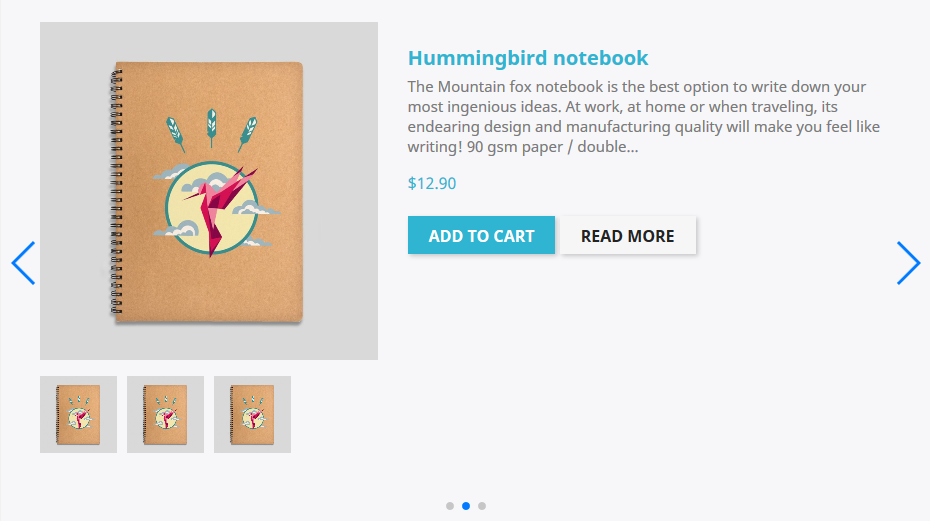
Advanced settings
To access extended settings, move the Extended Settings slider to the Yes position.
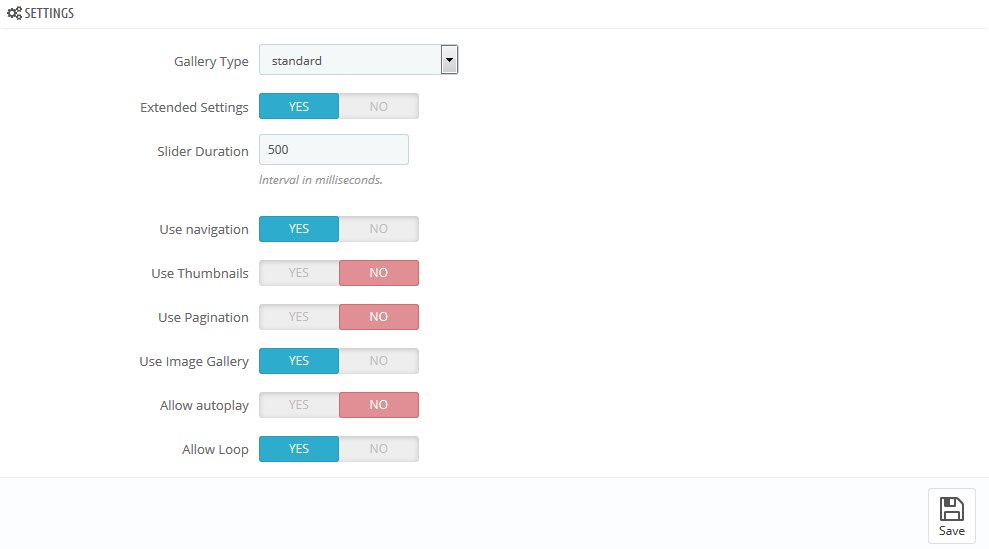
- Gallery Type - active gallery type
- Standard - displays centered content.
- List - displays products vertically as a single continuous element.
- Grid - displays products in the form of the repeated pattern of cells arrayed vertically and horizontally.
- Full width - removes width from the content wrapper which makes wide content.
- Gallery Width - active gallery width
- Gallery Height - active gallery height
- Extended Settings - advanced settings; if the option is moved to 'No' position, all the advanced settings will be saved and you can restore them at any time. At the same time, at frontend it will be displayed as by default.
- Slider Duration - the speed of slide changing
- Use navigation - the display of the Prev/Next buttons for slide switching
- Use Thumbnails - using thumbnails with additional information about slides as an element for switching the current slide
- Use Pagination - using pagination as an element for switching the current slide
- Use Image Gallery - using additional product images inside the slides
- Allow autoplay - allow automatic slide switching
- Gallery Interval - the interval between slides showing (available only if 'Allow autoplay' is active)
- Allow Loop - allow repeating slides from the beginning after all the slides were shown
After switching the gallery, all the setup of the previously used gallery is saved.
After disabling/enabling advanced settings, the settings are saved and you can go back to them at any time.
FAQ
- Why the gallery does not display on the frontend?
- I change gallery advanced settings, but I don't see changes on the frontend. What can be done?
JX Product Zoomer
This module is an alternative solution for the standard product image zoom on the single product page. It's fully compatible with the standard additional products thumbnail carousel and product attributes changes. It allows you to choose among the three available options (window/lens/inner) for image zoom with the advanced plugin settings. The module is based on the Elevatezoom Plus plugin.
Installation and removing
The module is installed and deleted like any other PrestaShop module.
Module configuration
After the module has been installed you can configure it on the module configuration page.
By default, the configuration page shows a simplified set of options.
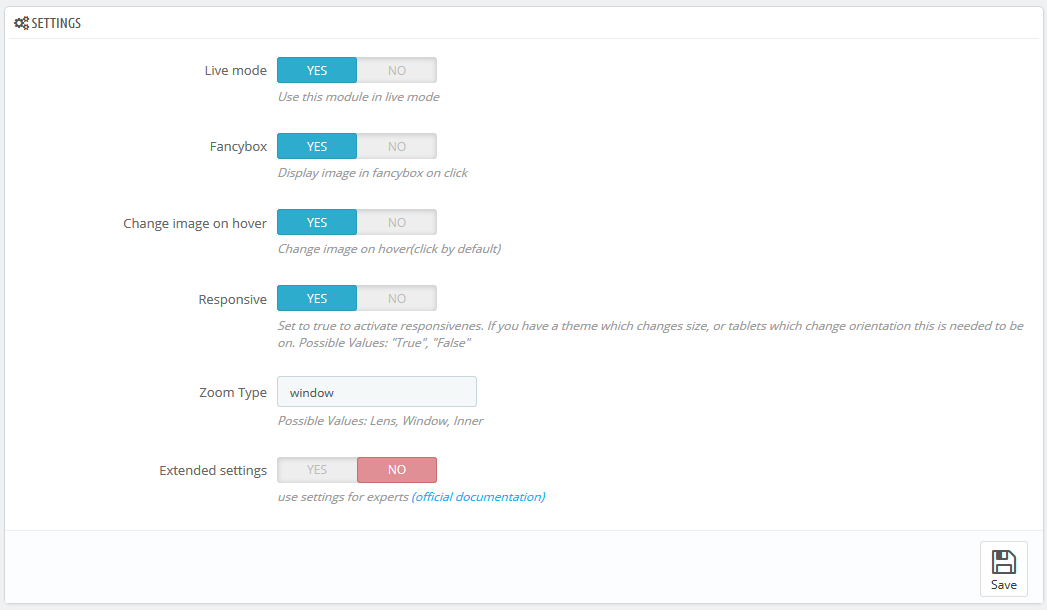
- Live mode - module is on/off.
- Fancybox - whether to show the enlarged image in the Fancybox on click.
- Change image on hover - switch the main image on thumbnail hover (by default is set to switch on click).
- Responsive - allows to the use adaptive functionality for plugin display on the mobile devices.
- Zoom Type - choose the type of the enlarged image display mode
- window - the enlarged image shows up next to the main image in one of the available (16) positions
- lens - the image is zoomed in the lens container, on top of it
- inner - the image is zoomed inside of main image container, fully covering it.
The mobile devices (< 768) have "lens" mode activated instantly. - Extended settings - enables advanced settings for the experienced users. You can see the link to the official documentation for more details next to it.
Extended module configuration
- Scroll Zoom - zoom ratio change on the mousewheel scroll (available for all types).
- Cursor - cursor type on the magnified image hover. The following options are available: default, cursor, crosshair (available for all types).
- Zoom settings - available for all types, if the 'Scroll Zoom' is enabled.

- Zoom Level - the zoom level on the initial hover.
- Min Zoom Level - a minimum zoom level.
- Max Zoom Level - a maximum zoom level.
- Scroll Zoom Increment - magnifying scroll increment.
- Easing - the magnified image appearance effect (available for all types).

- Zoom Easing - effect on/off.
- Easing Amount - effect delay value.
- Image Crossfade - main image blur outside the hover area (the lens) - available for window, lens.
- Magnified image window settings - available for window.
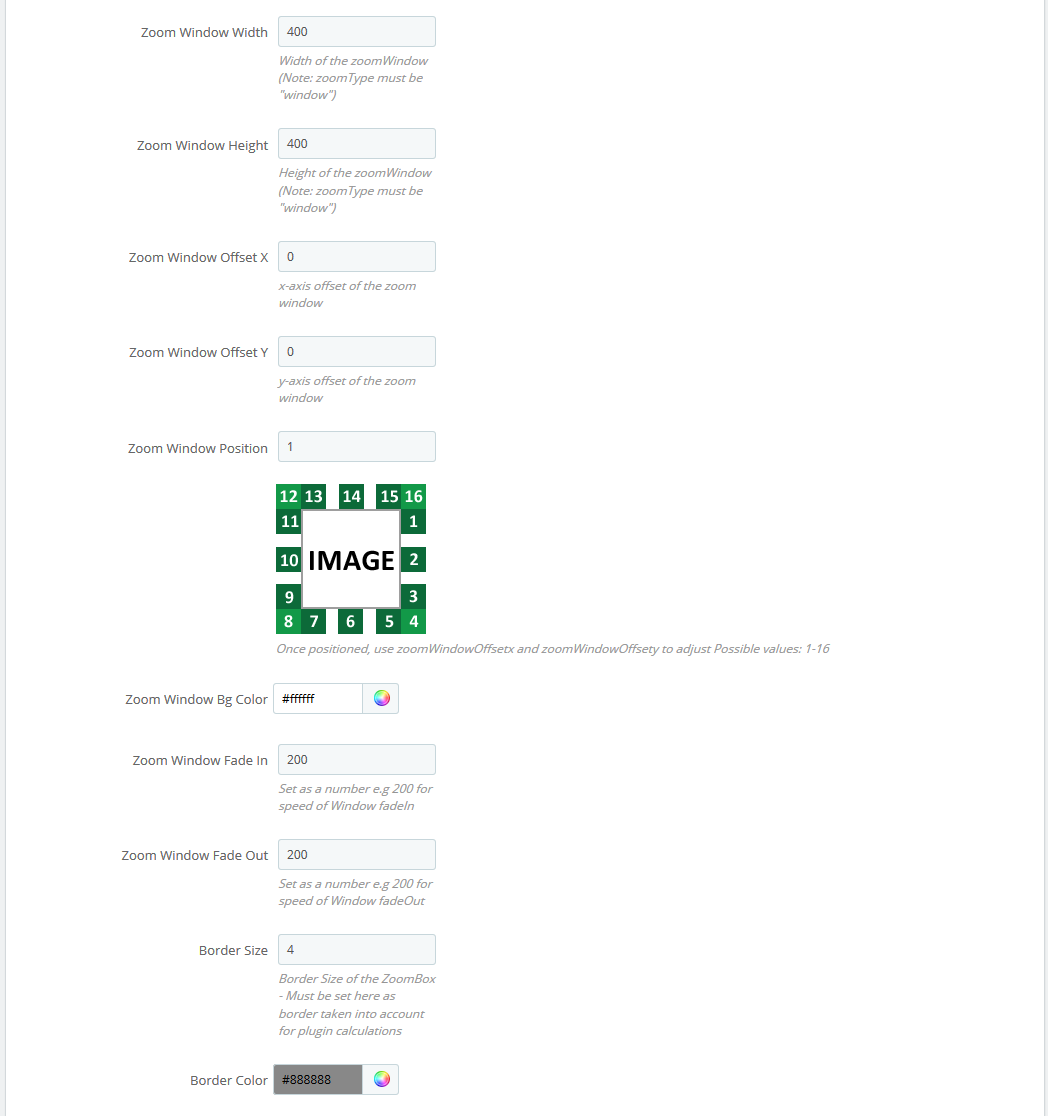
- Zoom Window Width - window width in px.
- Zoom Window Height - window height in px.
- Zoom Window Offset X - window offset on the X axis.
- Zoom Window Offset Y - window offset on the Y axis.
- Zoom Window Position - window position choice relatively to the main image (the positions available are presented on the image below this field).
- Zoom Window Bg Color - window background image (for transparent images only).
- Zoom Window Fade In - the effect of slowing the window appearance.
- Zoom Window Fade Out - the effect of slowing the window disappearance.
- Border Size - window border width in px.
- Border Color - window border color.
- Zoom Lens - zoom lens (available for window, lens).
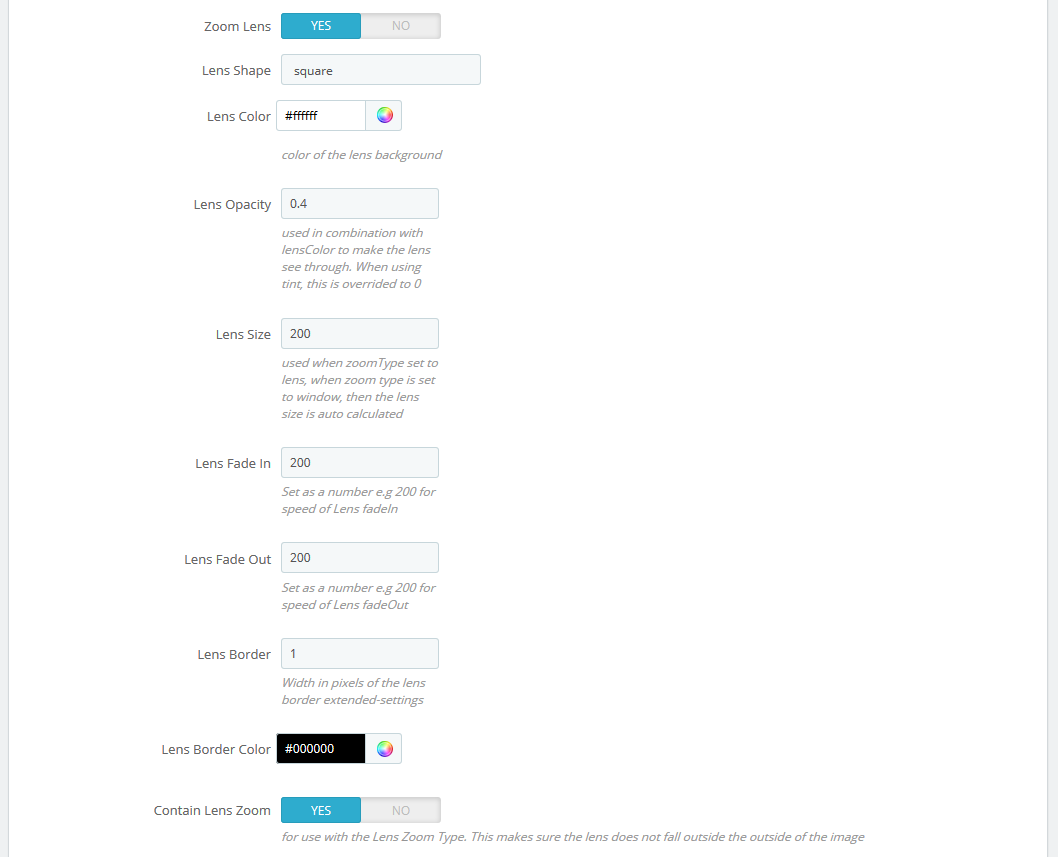
- Zoom Lens - on/off.
- Lens Shape - lens type. It can take the following values: circular/rounded or squared/rectangular.
- Lens Color - lens inner background color.
- Lens Opacity - lens inner background opacity.
- Lens Size - lens size in px.
- Lens Fade In - the speed of lens appearance effect.
- Lens Fade Out - the speed of lens disappearance effect.
- Lens Border - lens border width.
- Lens Border Color - lens border color.
- Contain Lens Zoom - the restriction of the lens overflow outwards the main image container.
- Tint - the shade effect on the area outside the lens (available for window).
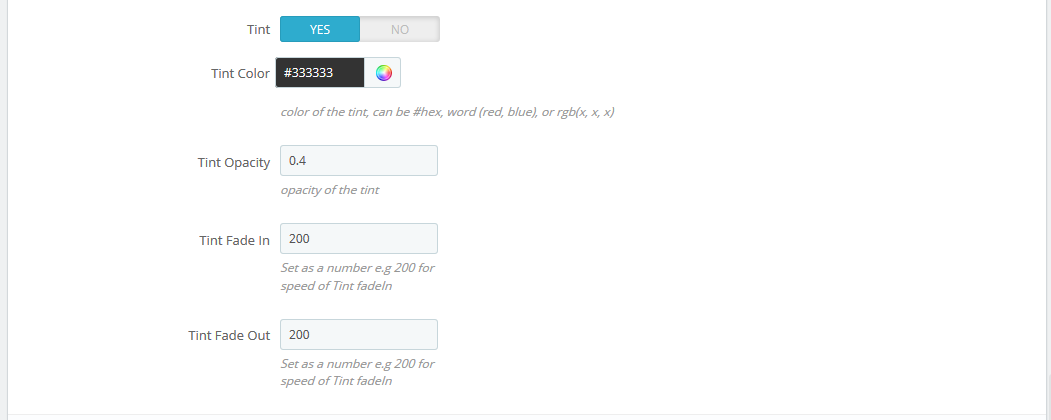
- Tint - effect on/off.
- Tint Color - the lens outer area background.
- Tint Opacity - the lens outer area opacity.
- Tint Fade In - the appearance effect speed.
- Tint Fade Out - the disappearance effect speed.
JX Search 1.1.0
This module is an extended search version that allows you to select a specific category for searching within its content. You can also change the category after defining the query. It also provides a possibility to set the additional product information display (description/price/manufacturer, etc.), and define the search results container layout, e.g., you can divide the results into a few sections with the controls (pagination, next/previous/show all). All the module settings are available in the main admin panel.
Installation and Deleting
The module is installed and deleted like any other PrestaShop module.
Module configuration
After module has been installed you can set it up on the module configuration page.
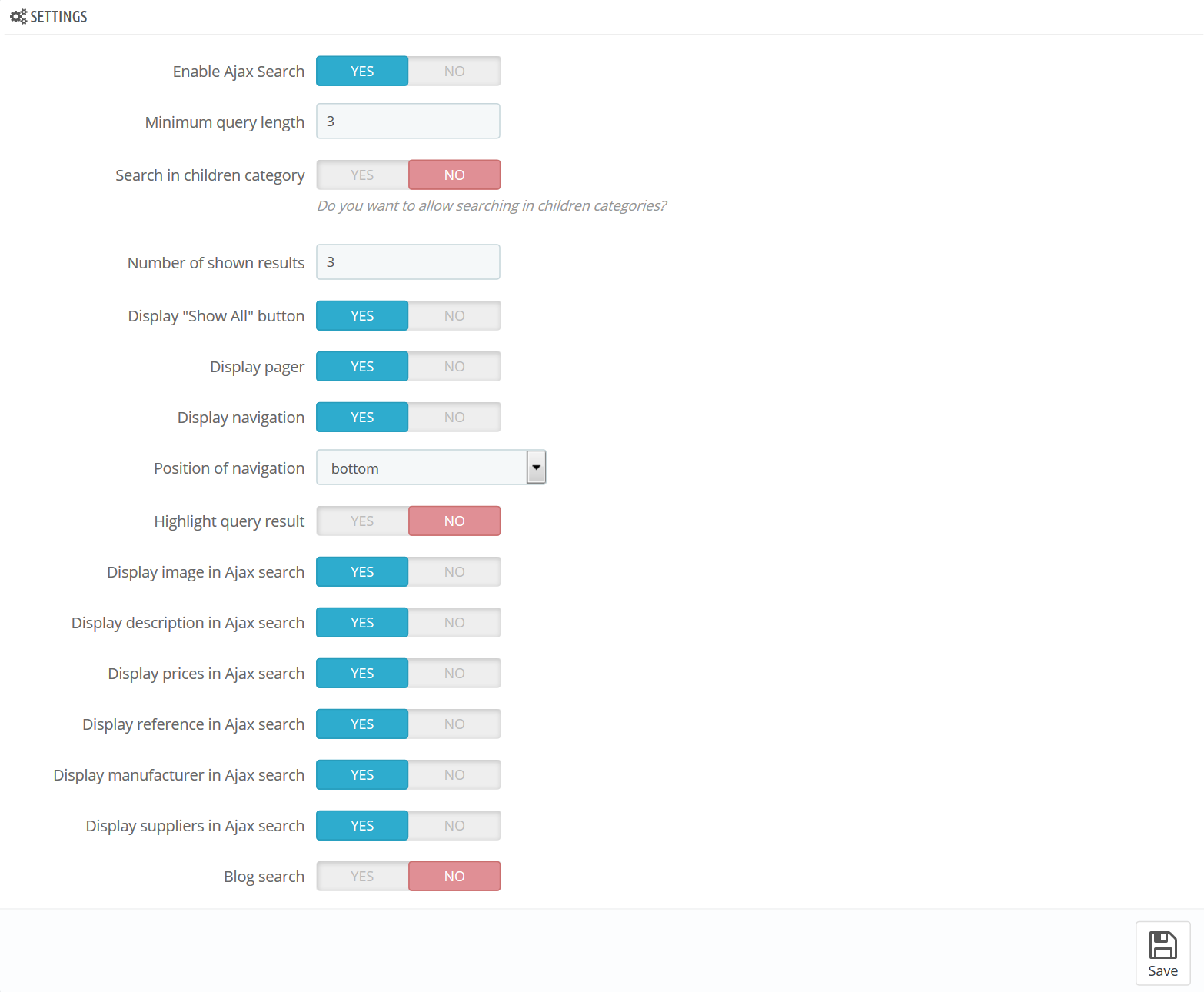
- Enable Ajax Search - enables live search in a drop-down.
- Minimum query length - number of symbols to start the result display.
- Search in children category - enable/disable searching in children categories.
- Number of shown results - number of products that shows up in the results section (number of products per page for the "pager" or "navigation" mode).
- Display "Show All" button - displays the 'Show all' button below the results section, then click on it displays all found results.
- Display pager - divides results into pages (depends on the 'Number of shown results' field value) and displays links to them.
- Display navigation - shows the Previous/Next buttons.
- Position of navigation - hook(s), to show the navigation (top/both/bottom options are available).
- Highlight query result - highlights the text that matches search query.
- Display image in Ajax search - shows product images in the results section.
- Display description in Ajax search - shows product description in the results section.
- Display prices in Ajax search - shows product price in the results section.
- Display reference in Ajax search - shows product reference in the results section.
- Display manufacturer in Ajax search - shows product manufacturer in the results section.
- Display suppliers in Ajax search - shows product suppliers in the results section.
- Blog search - enable/disable search by blog posts.
Some parameters might differ depending on the combination used.
JX Security Pack
JX Security Pack is a set of modules that allows improving the shop's safety. It brings the best security settings that you can see on your website. The module enables safety by lowering the risks of usage of different web application vulnerabilities.
Introduction
JX Security Package includes:
- JX Security Panel - provides a high level of online store protection.
- JX Security User - helps to control users activity.
- JX Security Watermark - allows safeguarding images from unauthorized use.
JX Security Panel
JX Security Panel module is used to increase the level of store protection. It blocks the possibility of publishing content, editing the URL in the attempt to copy it.
Module Installation
То install the module navigate to Admin panel -> Modules -> Modules and Services section, find the JX Security Panel module and click the ‘Install' button (1).
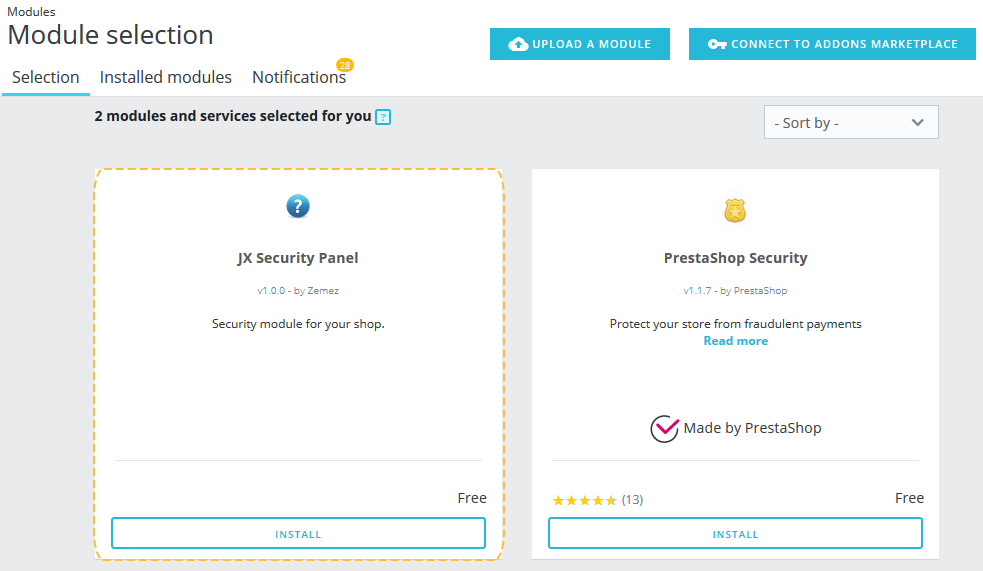
Content Configuration
After the successful module installation, the main settings page will appear.
The main module menu includes: Content and Watermark settings.
On the "Content" (1) page you can set the following main settings:

- Disable context menu by right-clicking - the ability to disable the click with a right mouse button.
- Disable text selection with the mouse - the ability to disable text selection.
- Disable Drag&Drop - enable/disable the drag and drop option.
- Prevent Hotlinking - the ability to prevent image hotlinking.
- Copyright - add copyright (or simple text) to copied text from your resource.
It is possible to enable/disable the following Hot Keys.
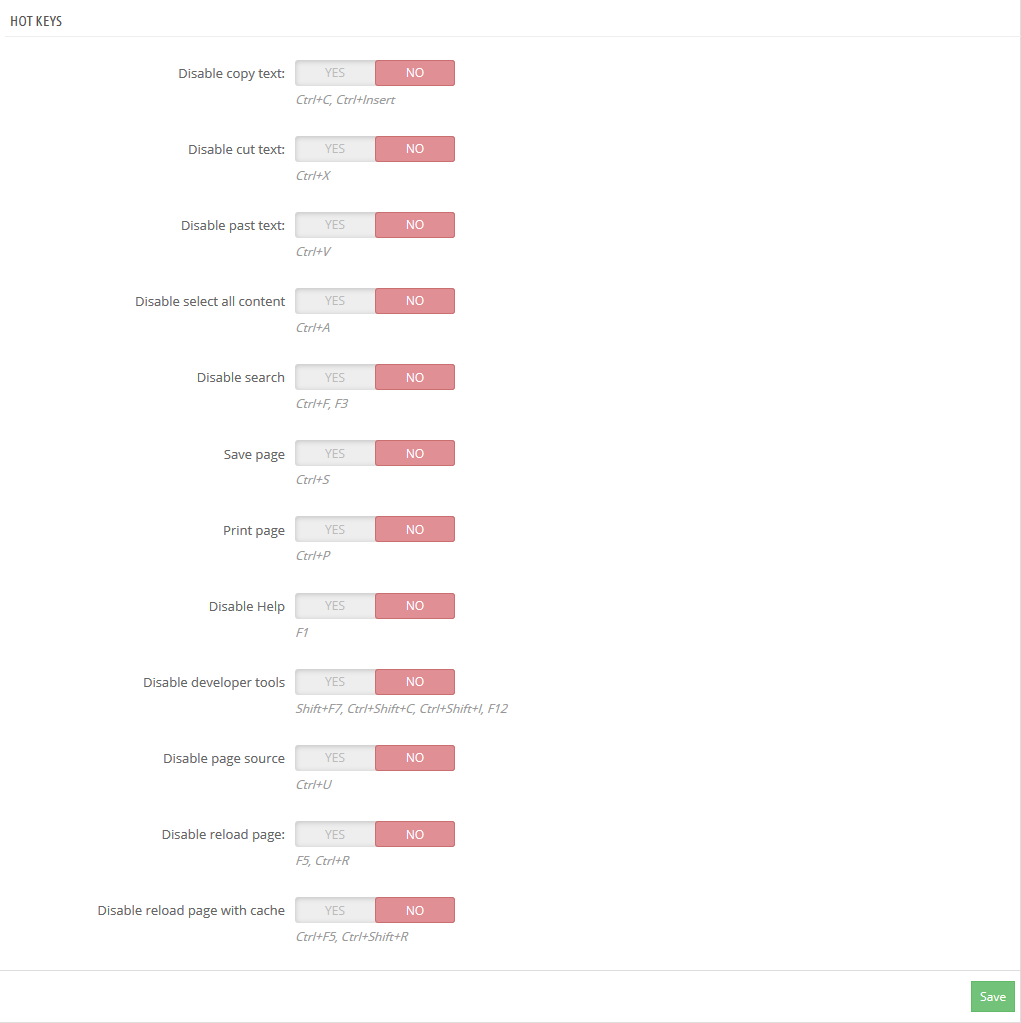
- Disable copy text - allow/prohibit the ability to copy some text using Ctrl+C, Ctrl+Insert hotkeys.
- Disable cut text - allow/prohibit the ability to cut the text using Ctrl+X hotkey.
- Disable past text - allow/prohibit the ability to insert the text using Ctrl+V hotkey.
- Disable select all content - allow/prohibit the ability to select all the content for copying using Ctrl+A hotkey.
- Disable search - enable/disable the search option using Ctrl+F or F3 hotkeys.
- Save page - enable/disable saving page option with the help of Ctrl+S.
- Print page - enable/disable printing page (or calling the print dialog) using Ctrl+P hotkey.
- Disable Help - enable/disable the Windows Help function using the F1 hotkey.
- Disable developer tools - enable/disable developer tools using Shift+F7 to open Style Editor; Ctrl+Shift+C to inspect Element; Ctrl+Shift+I or F12 to open/close toggle Inspector.
- Disable page source - enable/disable the ability to view the HTML code of the current page using Ctrl+U.
- Disable reload page - enable/disable F5 and Ctrl+R hotkeys to be able to refresh the page.
- Disable reload page with cache - enable/disable Ctrl+F5 and Ctrl+Shift+R hotkeys to refresh the page and cleaning cache simultaneously.
Watermark
To add a watermark to images, click the Watermark tab (1) and set the necessary options.
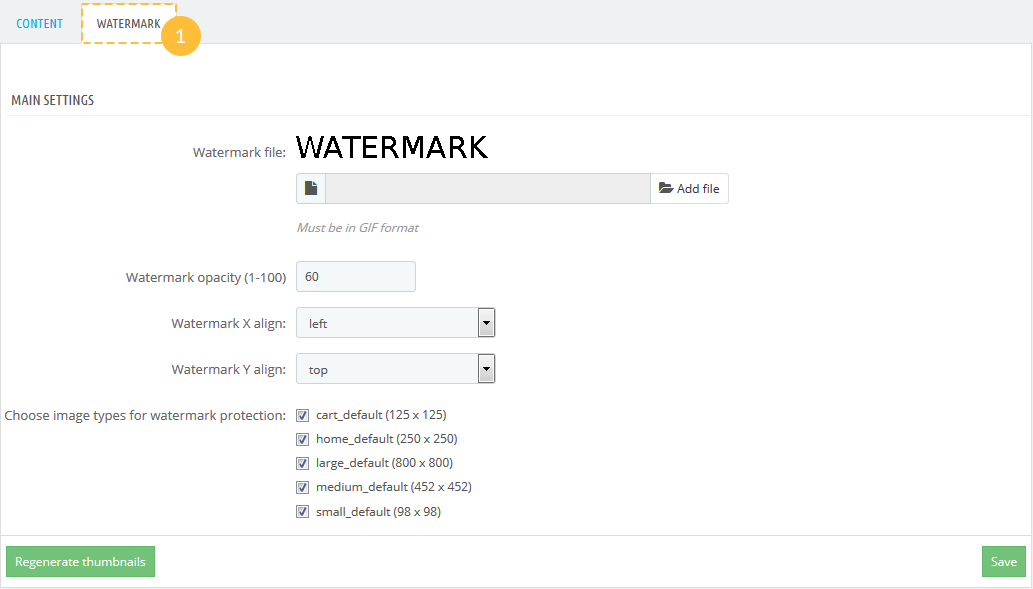
- Watermark file - upload a watermark file from your computer (in GIF format only).
- Watermark opacity (1-100) - the opacity of watermark file. The default setting, 60, is usually a good compromise.
- Watermark X align - select where your watermark should appear on the images, here on the horizontal axis.
- Watermark Y align - select where your watermark should appear on the images, here on the vertical axis.
- Choose image types for watermark protection - you may choose different image types to which the watermark should be applied by ticking them.
Once, you have saved the settings, go to Design -> Image Settings section. There, click the "Regenerate thumbnails" button at the bottom of the page.
Now, your watermark image will appear on the types of pictures that you have selected.
JX Security User
JX Security User module is used to monitor the activity of the users and block them if it is needed.
Installation and Deleting
The module can be installed and deleted like any other PrestaShop module.
Module Configuration
After the module has been installed, the 'Settings' page will appear.
The module includes 6 main tabs: Customers and Visitors online, Login fail, Black list, Ban list, and Settings.
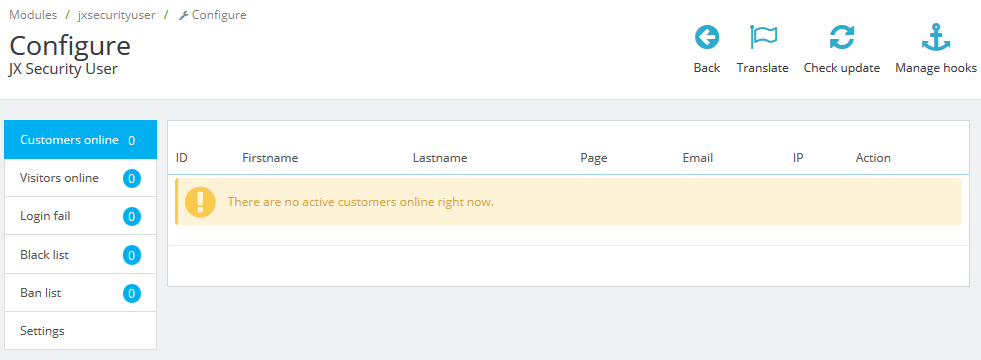
- Customers online - the ability to view the list of all users who are currently registered on your site.
- Visitors online - the ability to see the information about the visitors of your site at the moment.
- Login fail - monitoring of failed login attempts, with the ability to view the user's IP address, the username and the date/time of the failed login attempt.
- Black list - users ban by IP address or range of IP addresses.
- Ban list - the ability to view a list of all blocked users in the table form, with the opportunity to unlock individual IPs or group of IP addresses.
- Settings - additional settings to secure the store:
- Maximum number of attempts before blocking.
- Maximum number of attempts before disconnecting.
- Maximum number of attempts before sending a message to the administrator.

JX Security Watermark
JX Security Watermark module is used to leave watermarks on the pictures in order to increase the level of the store protection.
Installation and Deleting
The module can be installed and deleted like any other PrestaShop module.
Module Configuration
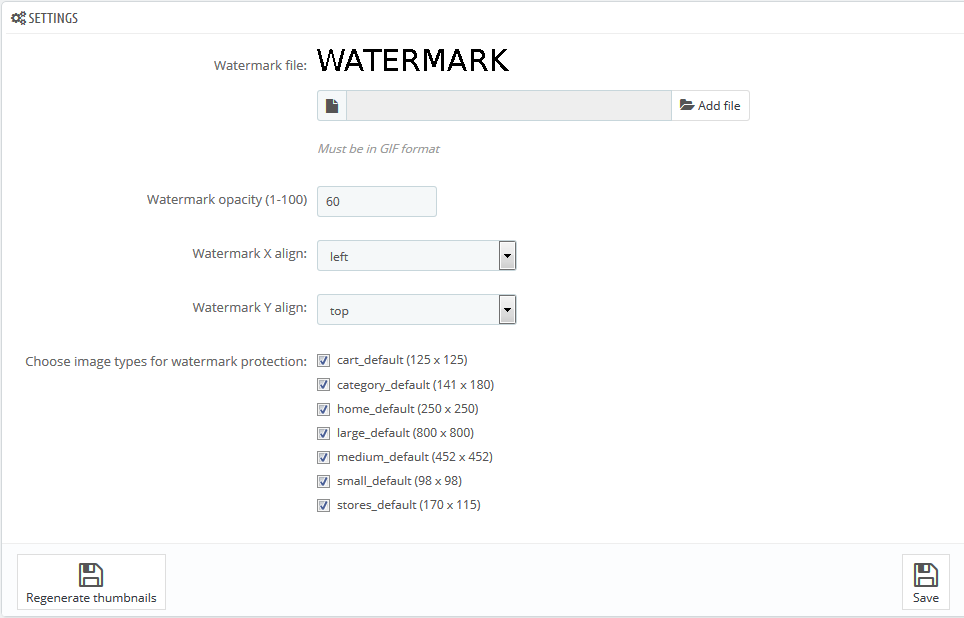
- Watermark file - upload a watermark file from your computer (in GIF format only).
- Watermark opacity (1-100) - the opacity of watermark file. The default setting, 60, is usually a good compromise.
- Watermark X align - select where your watermark should appear on the images, here on the horizontal axis.
- Watermark Y align - select where your watermark should appear on the images, here on the vertical axis.
- Choose image types for watermark protection - you may choose different image types to which the watermark should be applied by ticking them.
Once, you have saved the settings, go to Design -> Image Settings section. There, click the "Regenerate thumbnails" button at the bottom of the page.
Now, your watermark image will appear on the types of pictures that you have selected.
JX Wishlist
JX Wishlist module is created to give the ability to the visitors of online store to add products to wishlists and share these wishlists on Facebook.
The module is compliant with official PrestaShop General Data Protection Regulation (GDPR) module, a new EU legal framework that governs how users' personal data is used.
Module Installation
То install the module navigate to Admin panel -> Modules -> Modules and Services, find the JX Wishlist module and press 'Install' button (1).
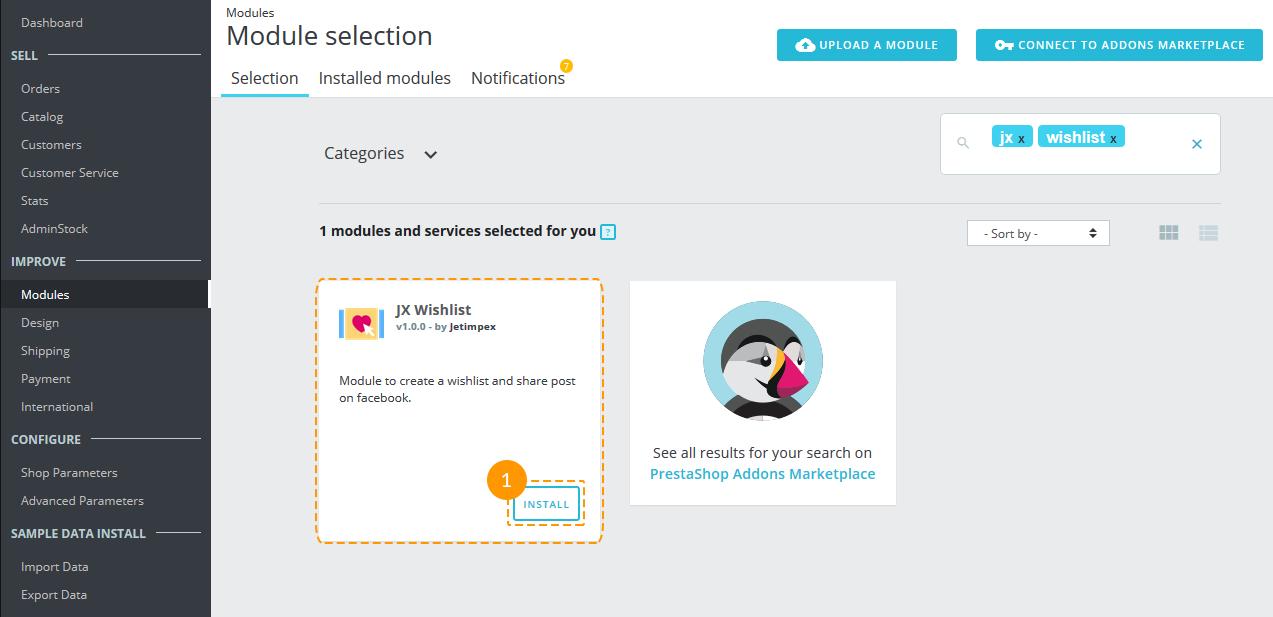
Module Configuration
After the module has been installed, the 'Settings' page will appear.
Add the Facebook App Id to the required field (1) and press 'Save' button (2).
The instruction how to get the Facebook App Id can be found here: Creating an App ID.

Using JX Wishlist Module
Adding product to wishlist
Shop visitors should be logged in to be able to add the items to the wishlists.
-
After the module is installed, the button 'Add to wishlist' appears on each product page. It should look like on the screenshot below (1).

-
After clicking this button a shop visitor will see a notification: 'The product was successfully added to your wishlist.' It can be closed or skipped to wishlists view by clicking 'My wishlists' button (2).
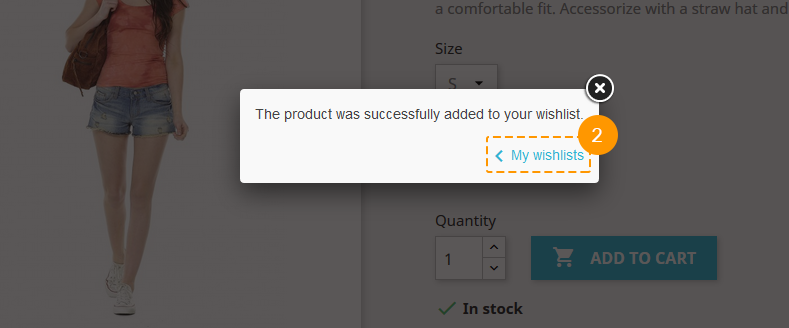
Browsing Wishlists
-
On 'My Wishlists' page a client can add the new wishlist (1) or view the list of created ones (2).
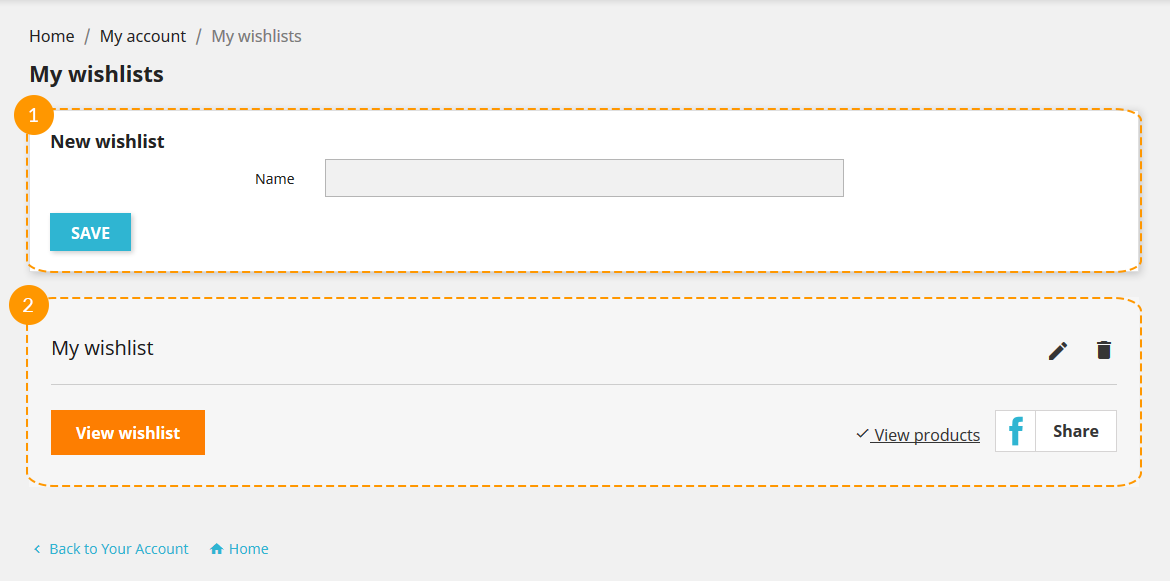
-
Clicking 'View wishlist' button (1) will open the wishlist page, the 'View products' button (2) gives the ability to see the products list of this wishlist on current page.
The title of wishlist can be edited (3) or deleted (4).
To share the wishlist the visitor should press the 'Share' button (5).
-
While looking through the items in wishlist after clicking 'View products' button, each item can be removed from the list (1).
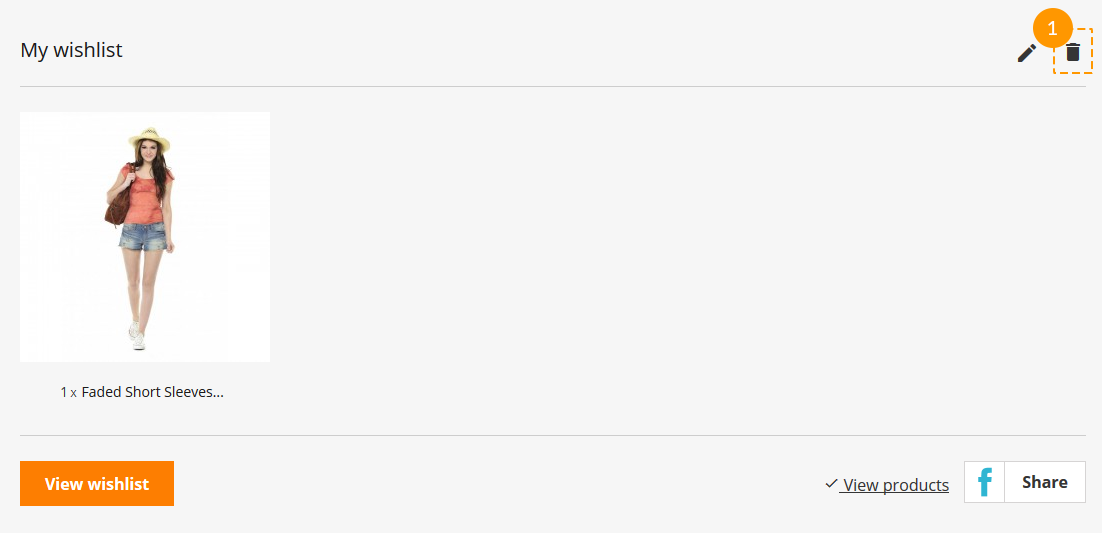
Sharing Wishlists
To share the wishlist the visitor should press the 'Share' button. There will be a few easy steps to follow before posting the wishlist. During each step, there's an ability to go back and change the sharing options.
-
First step is to choose the layout for wishlist that will be posted.
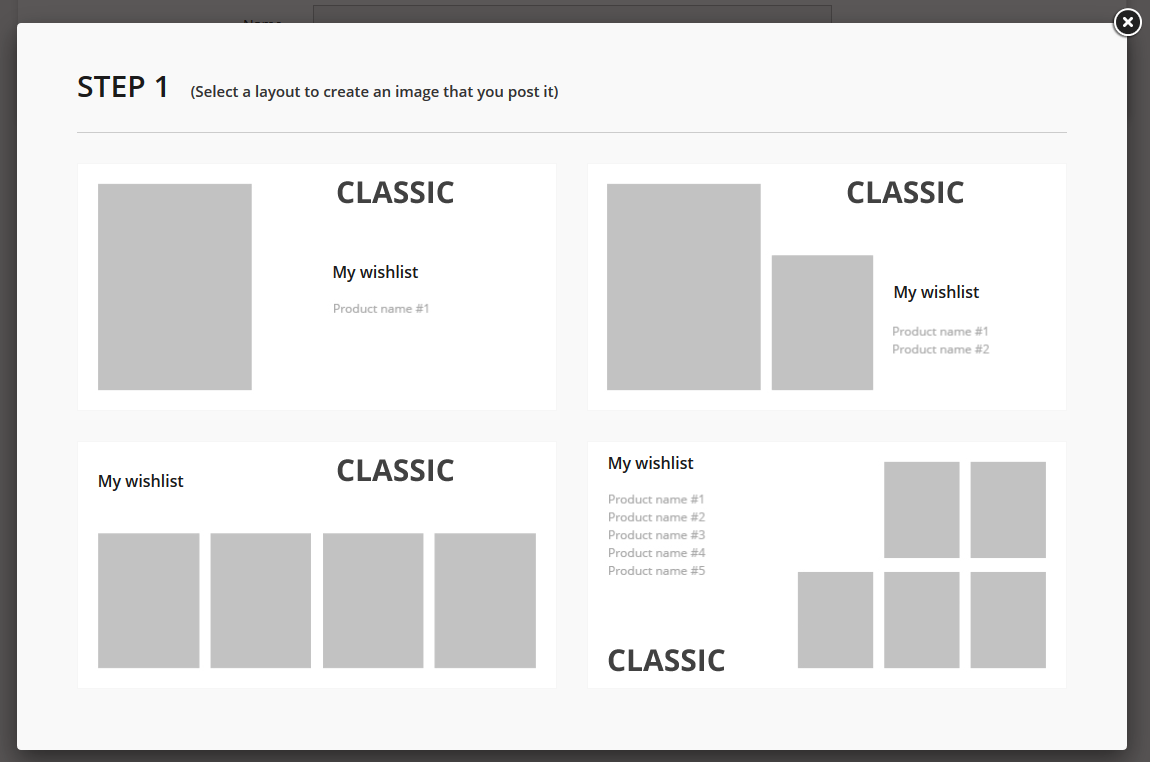
-
Then the products should be added. Each cell with a '+' is a button to add the product image.
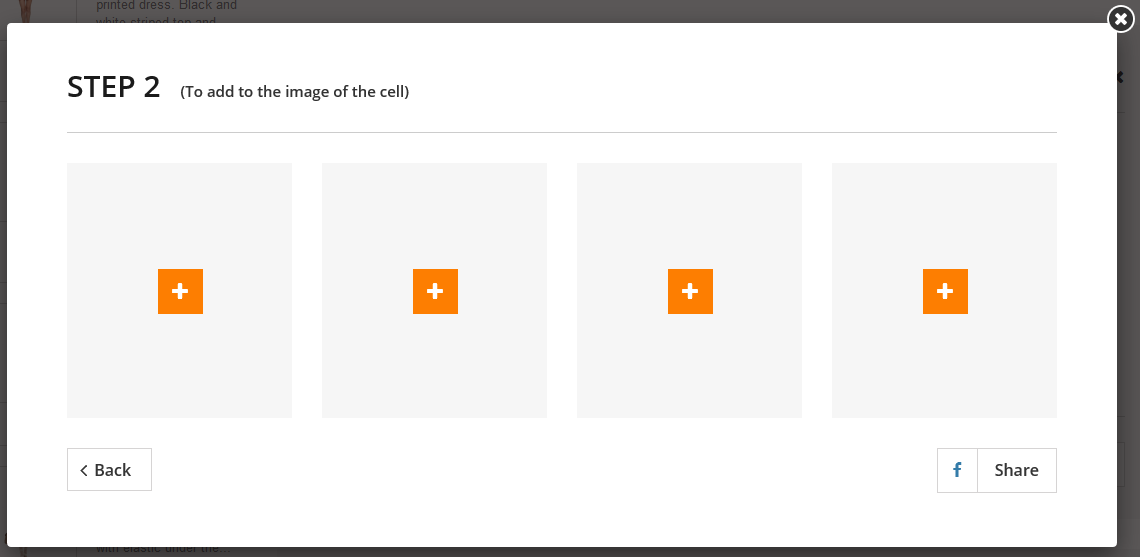
Choosing the images of each product:
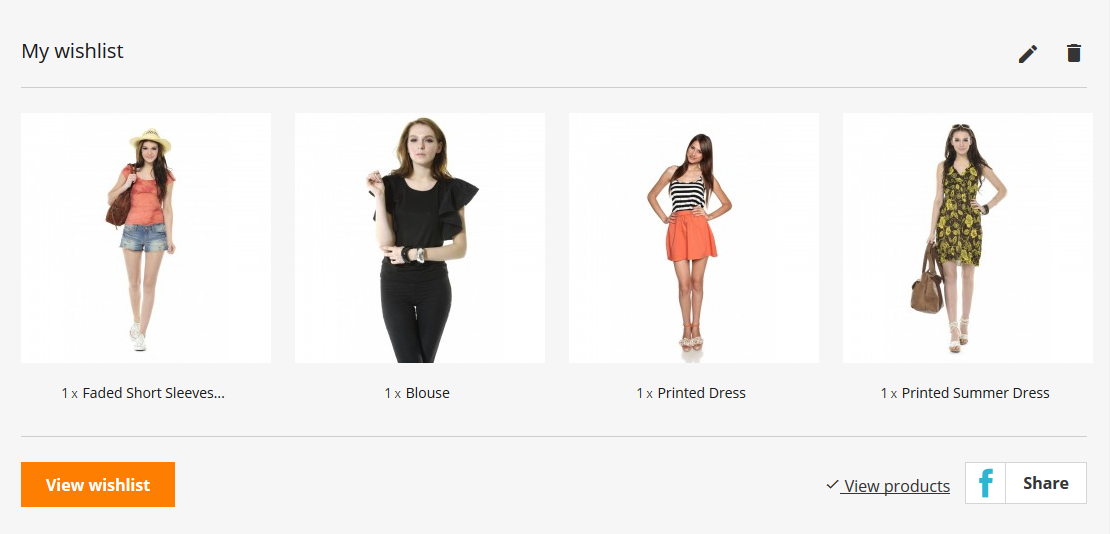
-
When all images are added, the visitor should press the 'Share' button (1).
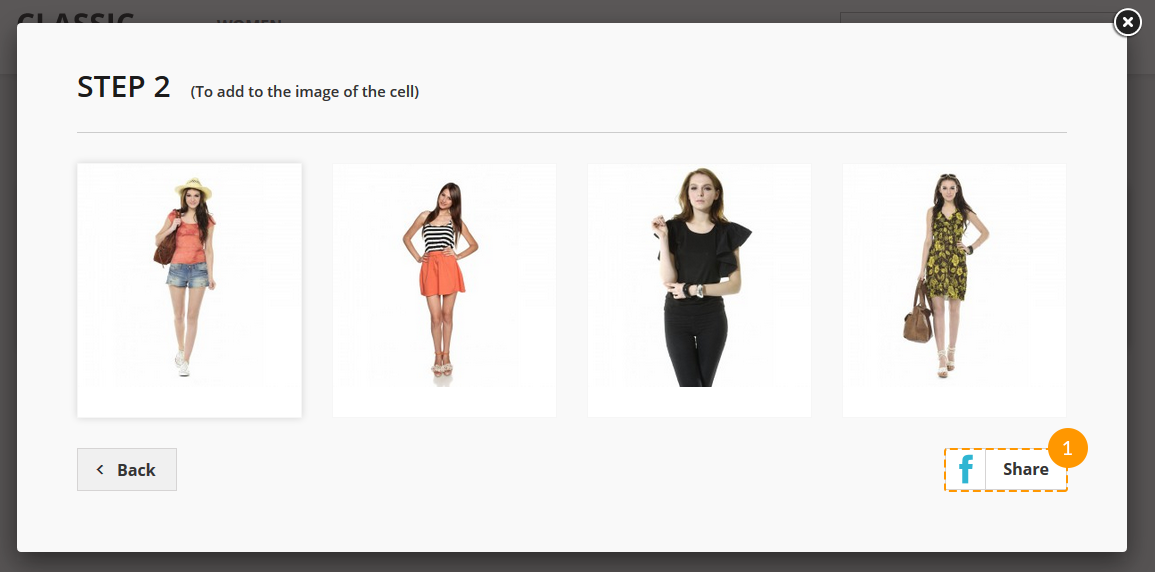
-
In a small window which is then appeared, there will be some standard posting options to choose and the ability to add some text to the post. After clicking 'Post to Facebook' button, the post will be published.
Statistics
Using this module you can also get the statistics collected while the products are added to wishlists. Thus, you
will know which products are currently popular. This information can be very useful for suggesting a discount, for
example.
You can view the statistics navigating to Admin panel -> Stats -> Stats -> JX Wishlist.

- You can select the period for viewing the statistics from the specified time (1).
- In the first column, there's a number of products that were added (2).
- The second column is created for your convenience. You can use it to see how many of added products were sold (3).
